Measurement and Management of Unused Capacity in TDABC System
VerifiedAdded on 2023/06/07
|75
|33738
|363
AI Summary
This paper discusses the measurement and management of unused capacity in a Time Driven Activity Based Costing (TDABC) System. It introduces the concepts of real and compulsory unused capacities per shift and explains how they can enhance the efficiency of the TDABC System. The paper also presents a case study of a hospital in Turkey to demonstrate the suggested solutions to the complexity of unused capacity.
Contribute Materials
Your contribution can guide someone’s learning journey. Share your
documents today.
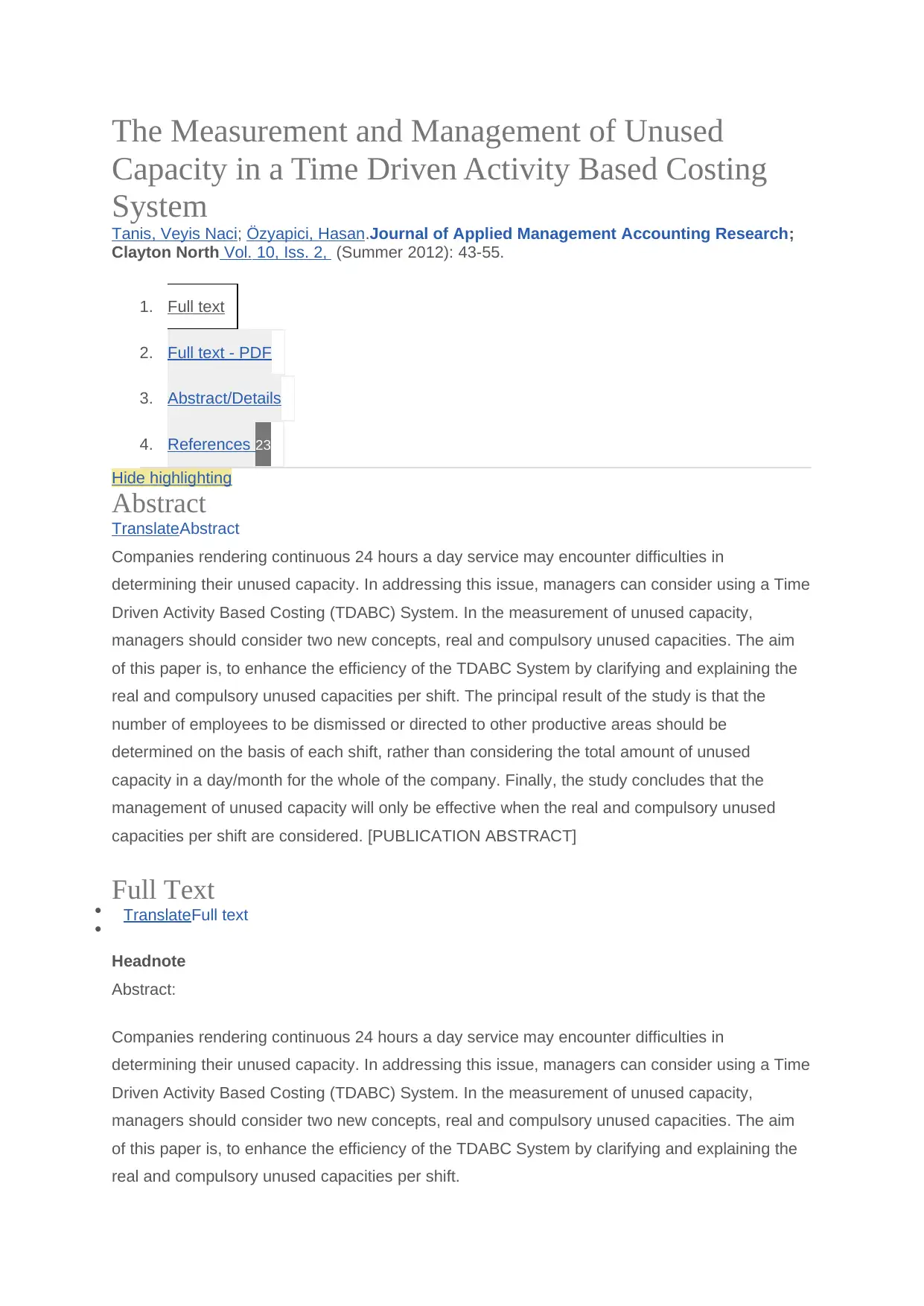
The Measurement and Management of Unused
Capacity in a Time Driven Activity Based Costing
System
Tanis, Veyis Naci; Özyapici, Hasan.Journal of Applied Management Accounting Research;
Clayton North Vol. 10, Iss. 2, (Summer 2012): 43-55.
1. Full text
2. Full text - PDF
3. Abstract/Details
4. References 23
Hide highlighting
Abstract
TranslateAbstract
Companies rendering continuous 24 hours a day service may encounter difficulties in
determining their unused capacity. In addressing this issue, managers can consider using a Time
Driven Activity Based Costing (TDABC) System. In the measurement of unused capacity,
managers should consider two new concepts, real and compulsory unused capacities. The aim
of this paper is, to enhance the efficiency of the TDABC System by clarifying and explaining the
real and compulsory unused capacities per shift. The principal result of the study is that the
number of employees to be dismissed or directed to other productive areas should be
determined on the basis of each shift, rather than considering the total amount of unused
capacity in a day/month for the whole of the company. Finally, the study concludes that the
management of unused capacity will only be effective when the real and compulsory unused
capacities per shift are considered. [PUBLICATION ABSTRACT]
Full Text
TranslateFull text
Headnote
Abstract:
Companies rendering continuous 24 hours a day service may encounter difficulties in
determining their unused capacity. In addressing this issue, managers can consider using a Time
Driven Activity Based Costing (TDABC) System. In the measurement of unused capacity,
managers should consider two new concepts, real and compulsory unused capacities. The aim
of this paper is, to enhance the efficiency of the TDABC System by clarifying and explaining the
real and compulsory unused capacities per shift.
Capacity in a Time Driven Activity Based Costing
System
Tanis, Veyis Naci; Özyapici, Hasan.Journal of Applied Management Accounting Research;
Clayton North Vol. 10, Iss. 2, (Summer 2012): 43-55.
1. Full text
2. Full text - PDF
3. Abstract/Details
4. References 23
Hide highlighting
Abstract
TranslateAbstract
Companies rendering continuous 24 hours a day service may encounter difficulties in
determining their unused capacity. In addressing this issue, managers can consider using a Time
Driven Activity Based Costing (TDABC) System. In the measurement of unused capacity,
managers should consider two new concepts, real and compulsory unused capacities. The aim
of this paper is, to enhance the efficiency of the TDABC System by clarifying and explaining the
real and compulsory unused capacities per shift. The principal result of the study is that the
number of employees to be dismissed or directed to other productive areas should be
determined on the basis of each shift, rather than considering the total amount of unused
capacity in a day/month for the whole of the company. Finally, the study concludes that the
management of unused capacity will only be effective when the real and compulsory unused
capacities per shift are considered. [PUBLICATION ABSTRACT]
Full Text
TranslateFull text
Headnote
Abstract:
Companies rendering continuous 24 hours a day service may encounter difficulties in
determining their unused capacity. In addressing this issue, managers can consider using a Time
Driven Activity Based Costing (TDABC) System. In the measurement of unused capacity,
managers should consider two new concepts, real and compulsory unused capacities. The aim
of this paper is, to enhance the efficiency of the TDABC System by clarifying and explaining the
real and compulsory unused capacities per shift.
Secure Best Marks with AI Grader
Need help grading? Try our AI Grader for instant feedback on your assignments.
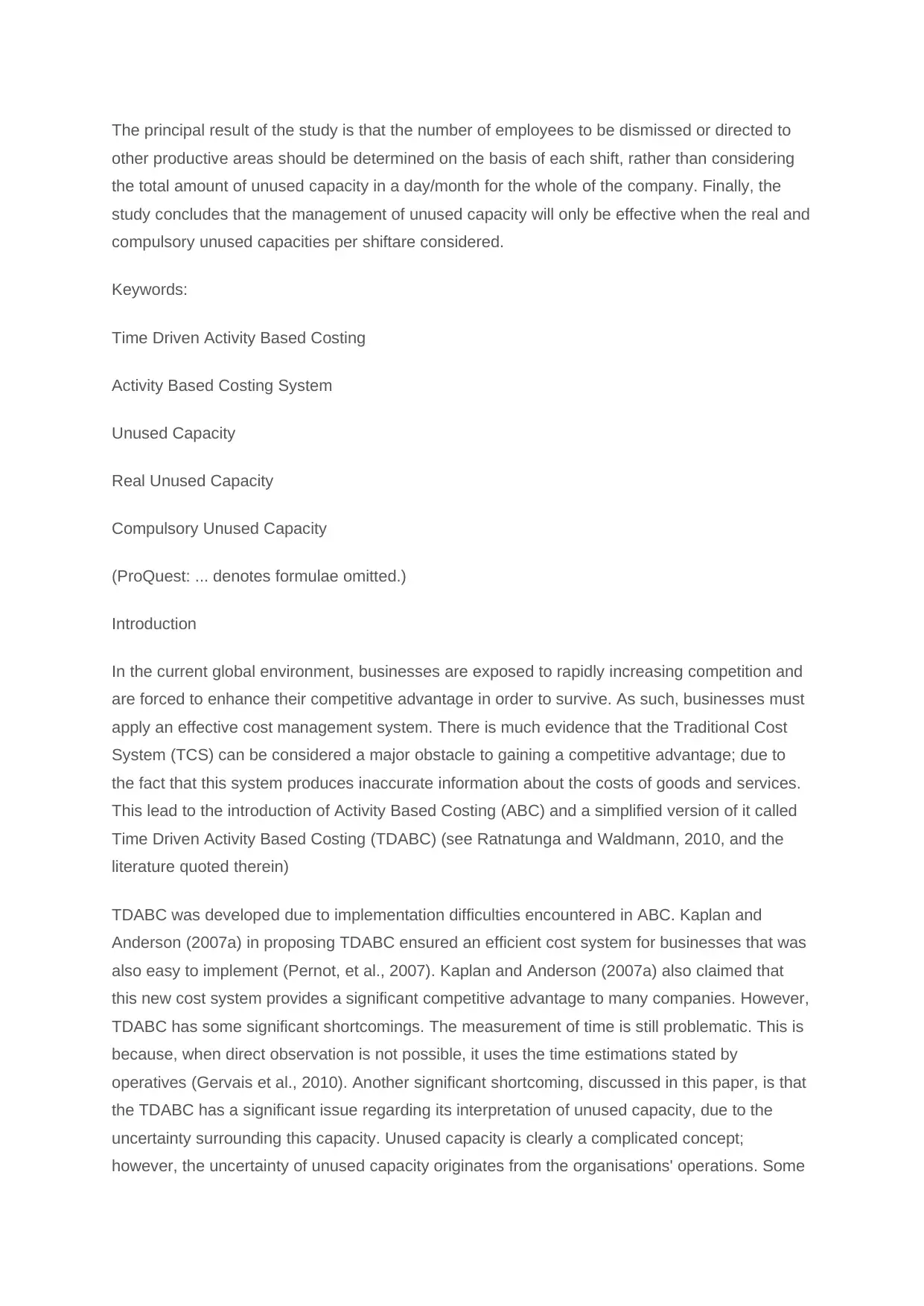
The principal result of the study is that the number of employees to be dismissed or directed to
other productive areas should be determined on the basis of each shift, rather than considering
the total amount of unused capacity in a day/month for the whole of the company. Finally, the
study concludes that the management of unused capacity will only be effective when the real and
compulsory unused capacities per shiftare considered.
Keywords:
Time Driven Activity Based Costing
Activity Based Costing System
Unused Capacity
Real Unused Capacity
Compulsory Unused Capacity
(ProQuest: ... denotes formulae omitted.)
Introduction
In the current global environment, businesses are exposed to rapidly increasing competition and
are forced to enhance their competitive advantage in order to survive. As such, businesses must
apply an effective cost management system. There is much evidence that the Traditional Cost
System (TCS) can be considered a major obstacle to gaining a competitive advantage; due to
the fact that this system produces inaccurate information about the costs of goods and services.
This lead to the introduction of Activity Based Costing (ABC) and a simplified version of it called
Time Driven Activity Based Costing (TDABC) (see Ratnatunga and Waldmann, 2010, and the
literature quoted therein)
TDABC was developed due to implementation difficulties encountered in ABC. Kaplan and
Anderson (2007a) in proposing TDABC ensured an efficient cost system for businesses that was
also easy to implement (Pernot, et al., 2007). Kaplan and Anderson (2007a) also claimed that
this new cost system provides a significant competitive advantage to many companies. However,
TDABC has some significant shortcomings. The measurement of time is still problematic. This is
because, when direct observation is not possible, it uses the time estimations stated by
operatives (Gervais et al., 2010). Another significant shortcoming, discussed in this paper, is that
the TDABC has a significant issue regarding its interpretation of unused capacity, due to the
uncertainty surrounding this capacity. Unused capacity is clearly a complicated concept;
however, the uncertainty of unused capacity originates from the organisations' operations. Some
other productive areas should be determined on the basis of each shift, rather than considering
the total amount of unused capacity in a day/month for the whole of the company. Finally, the
study concludes that the management of unused capacity will only be effective when the real and
compulsory unused capacities per shiftare considered.
Keywords:
Time Driven Activity Based Costing
Activity Based Costing System
Unused Capacity
Real Unused Capacity
Compulsory Unused Capacity
(ProQuest: ... denotes formulae omitted.)
Introduction
In the current global environment, businesses are exposed to rapidly increasing competition and
are forced to enhance their competitive advantage in order to survive. As such, businesses must
apply an effective cost management system. There is much evidence that the Traditional Cost
System (TCS) can be considered a major obstacle to gaining a competitive advantage; due to
the fact that this system produces inaccurate information about the costs of goods and services.
This lead to the introduction of Activity Based Costing (ABC) and a simplified version of it called
Time Driven Activity Based Costing (TDABC) (see Ratnatunga and Waldmann, 2010, and the
literature quoted therein)
TDABC was developed due to implementation difficulties encountered in ABC. Kaplan and
Anderson (2007a) in proposing TDABC ensured an efficient cost system for businesses that was
also easy to implement (Pernot, et al., 2007). Kaplan and Anderson (2007a) also claimed that
this new cost system provides a significant competitive advantage to many companies. However,
TDABC has some significant shortcomings. The measurement of time is still problematic. This is
because, when direct observation is not possible, it uses the time estimations stated by
operatives (Gervais et al., 2010). Another significant shortcoming, discussed in this paper, is that
the TDABC has a significant issue regarding its interpretation of unused capacity, due to the
uncertainty surrounding this capacity. Unused capacity is clearly a complicated concept;
however, the uncertainty of unused capacity originates from the organisations' operations. Some
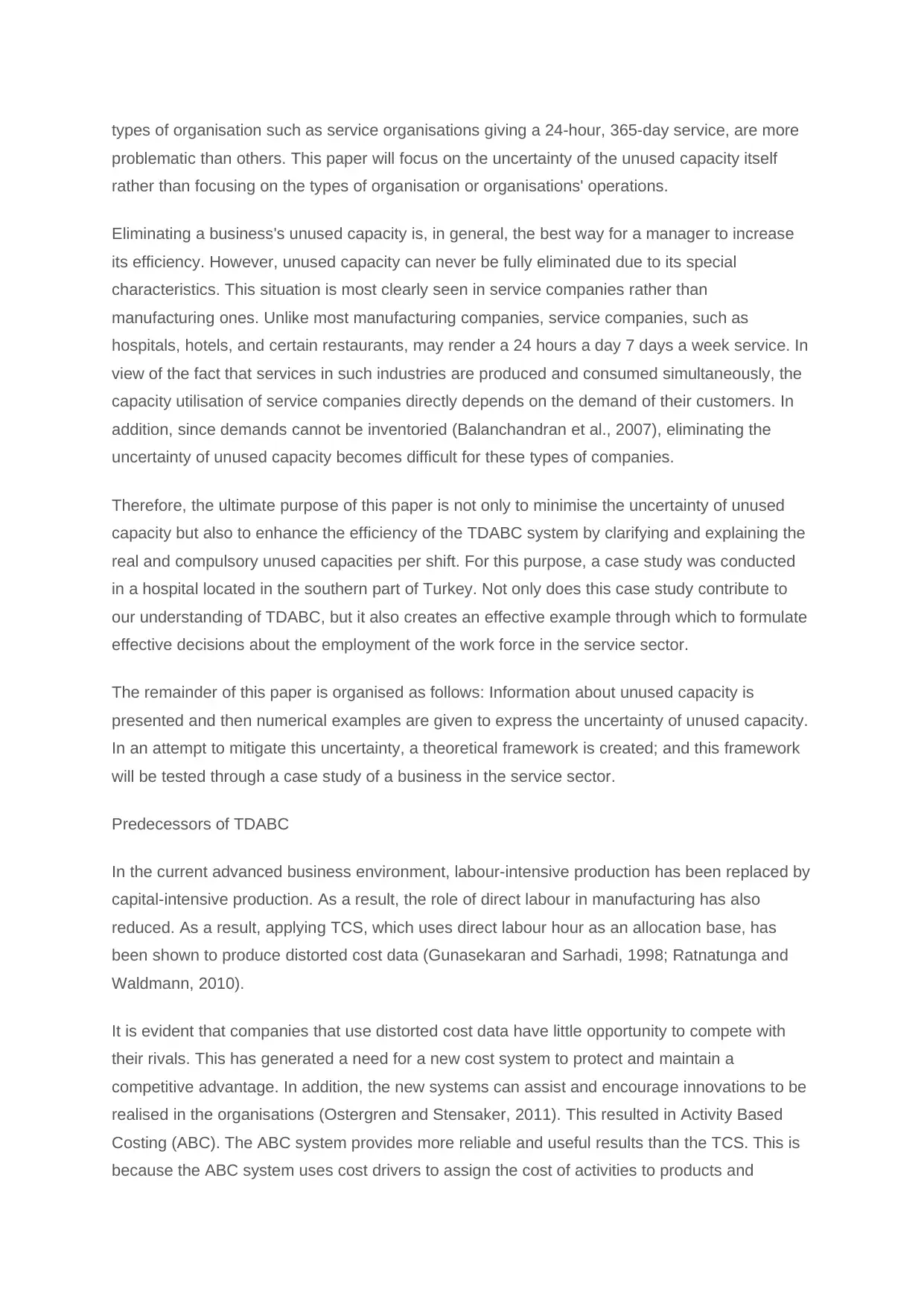
types of organisation such as service organisations giving a 24-hour, 365-day service, are more
problematic than others. This paper will focus on the uncertainty of the unused capacity itself
rather than focusing on the types of organisation or organisations' operations.
Eliminating a business's unused capacity is, in general, the best way for a manager to increase
its efficiency. However, unused capacity can never be fully eliminated due to its special
characteristics. This situation is most clearly seen in service companies rather than
manufacturing ones. Unlike most manufacturing companies, service companies, such as
hospitals, hotels, and certain restaurants, may render a 24 hours a day 7 days a week service. In
view of the fact that services in such industries are produced and consumed simultaneously, the
capacity utilisation of service companies directly depends on the demand of their customers. In
addition, since demands cannot be inventoried (Balanchandran et al., 2007), eliminating the
uncertainty of unused capacity becomes difficult for these types of companies.
Therefore, the ultimate purpose of this paper is not only to minimise the uncertainty of unused
capacity but also to enhance the efficiency of the TDABC system by clarifying and explaining the
real and compulsory unused capacities per shift. For this purpose, a case study was conducted
in a hospital located in the southern part of Turkey. Not only does this case study contribute to
our understanding of TDABC, but it also creates an effective example through which to formulate
effective decisions about the employment of the work force in the service sector.
The remainder of this paper is organised as follows: Information about unused capacity is
presented and then numerical examples are given to express the uncertainty of unused capacity.
In an attempt to mitigate this uncertainty, a theoretical framework is created; and this framework
will be tested through a case study of a business in the service sector.
Predecessors of TDABC
In the current advanced business environment, labour-intensive production has been replaced by
capital-intensive production. As a result, the role of direct labour in manufacturing has also
reduced. As a result, applying TCS, which uses direct labour hour as an allocation base, has
been shown to produce distorted cost data (Gunasekaran and Sarhadi, 1998; Ratnatunga and
Waldmann, 2010).
It is evident that companies that use distorted cost data have little opportunity to compete with
their rivals. This has generated a need for a new cost system to protect and maintain a
competitive advantage. In addition, the new systems can assist and encourage innovations to be
realised in the organisations (Ostergren and Stensaker, 2011). This resulted in Activity Based
Costing (ABC). The ABC system provides more reliable and useful results than the TCS. This is
because the ABC system uses cost drivers to assign the cost of activities to products and
problematic than others. This paper will focus on the uncertainty of the unused capacity itself
rather than focusing on the types of organisation or organisations' operations.
Eliminating a business's unused capacity is, in general, the best way for a manager to increase
its efficiency. However, unused capacity can never be fully eliminated due to its special
characteristics. This situation is most clearly seen in service companies rather than
manufacturing ones. Unlike most manufacturing companies, service companies, such as
hospitals, hotels, and certain restaurants, may render a 24 hours a day 7 days a week service. In
view of the fact that services in such industries are produced and consumed simultaneously, the
capacity utilisation of service companies directly depends on the demand of their customers. In
addition, since demands cannot be inventoried (Balanchandran et al., 2007), eliminating the
uncertainty of unused capacity becomes difficult for these types of companies.
Therefore, the ultimate purpose of this paper is not only to minimise the uncertainty of unused
capacity but also to enhance the efficiency of the TDABC system by clarifying and explaining the
real and compulsory unused capacities per shift. For this purpose, a case study was conducted
in a hospital located in the southern part of Turkey. Not only does this case study contribute to
our understanding of TDABC, but it also creates an effective example through which to formulate
effective decisions about the employment of the work force in the service sector.
The remainder of this paper is organised as follows: Information about unused capacity is
presented and then numerical examples are given to express the uncertainty of unused capacity.
In an attempt to mitigate this uncertainty, a theoretical framework is created; and this framework
will be tested through a case study of a business in the service sector.
Predecessors of TDABC
In the current advanced business environment, labour-intensive production has been replaced by
capital-intensive production. As a result, the role of direct labour in manufacturing has also
reduced. As a result, applying TCS, which uses direct labour hour as an allocation base, has
been shown to produce distorted cost data (Gunasekaran and Sarhadi, 1998; Ratnatunga and
Waldmann, 2010).
It is evident that companies that use distorted cost data have little opportunity to compete with
their rivals. This has generated a need for a new cost system to protect and maintain a
competitive advantage. In addition, the new systems can assist and encourage innovations to be
realised in the organisations (Ostergren and Stensaker, 2011). This resulted in Activity Based
Costing (ABC). The ABC system provides more reliable and useful results than the TCS. This is
because the ABC system uses cost drivers to assign the cost of activities to products and
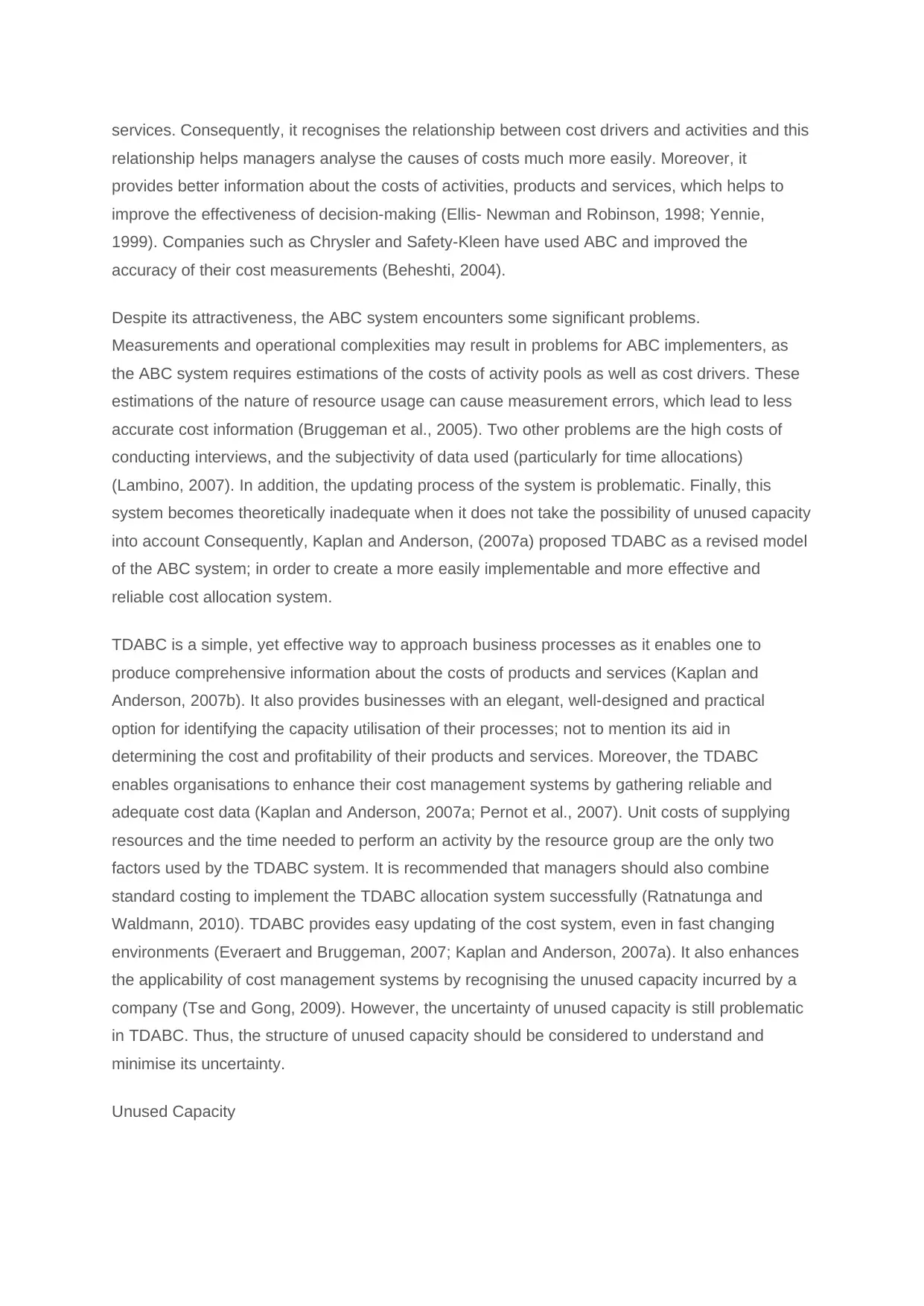
services. Consequently, it recognises the relationship between cost drivers and activities and this
relationship helps managers analyse the causes of costs much more easily. Moreover, it
provides better information about the costs of activities, products and services, which helps to
improve the effectiveness of decision-making (Ellis- Newman and Robinson, 1998; Yennie,
1999). Companies such as Chrysler and Safety-Kleen have used ABC and improved the
accuracy of their cost measurements (Beheshti, 2004).
Despite its attractiveness, the ABC system encounters some significant problems.
Measurements and operational complexities may result in problems for ABC implementers, as
the ABC system requires estimations of the costs of activity pools as well as cost drivers. These
estimations of the nature of resource usage can cause measurement errors, which lead to less
accurate cost information (Bruggeman et al., 2005). Two other problems are the high costs of
conducting interviews, and the subjectivity of data used (particularly for time allocations)
(Lambino, 2007). In addition, the updating process of the system is problematic. Finally, this
system becomes theoretically inadequate when it does not take the possibility of unused capacity
into account Consequently, Kaplan and Anderson, (2007a) proposed TDABC as a revised model
of the ABC system; in order to create a more easily implementable and more effective and
reliable cost allocation system.
TDABC is a simple, yet effective way to approach business processes as it enables one to
produce comprehensive information about the costs of products and services (Kaplan and
Anderson, 2007b). It also provides businesses with an elegant, well-designed and practical
option for identifying the capacity utilisation of their processes; not to mention its aid in
determining the cost and profitability of their products and services. Moreover, the TDABC
enables organisations to enhance their cost management systems by gathering reliable and
adequate cost data (Kaplan and Anderson, 2007a; Pernot et al., 2007). Unit costs of supplying
resources and the time needed to perform an activity by the resource group are the only two
factors used by the TDABC system. It is recommended that managers should also combine
standard costing to implement the TDABC allocation system successfully (Ratnatunga and
Waldmann, 2010). TDABC provides easy updating of the cost system, even in fast changing
environments (Everaert and Bruggeman, 2007; Kaplan and Anderson, 2007a). It also enhances
the applicability of cost management systems by recognising the unused capacity incurred by a
company (Tse and Gong, 2009). However, the uncertainty of unused capacity is still problematic
in TDABC. Thus, the structure of unused capacity should be considered to understand and
minimise its uncertainty.
Unused Capacity
relationship helps managers analyse the causes of costs much more easily. Moreover, it
provides better information about the costs of activities, products and services, which helps to
improve the effectiveness of decision-making (Ellis- Newman and Robinson, 1998; Yennie,
1999). Companies such as Chrysler and Safety-Kleen have used ABC and improved the
accuracy of their cost measurements (Beheshti, 2004).
Despite its attractiveness, the ABC system encounters some significant problems.
Measurements and operational complexities may result in problems for ABC implementers, as
the ABC system requires estimations of the costs of activity pools as well as cost drivers. These
estimations of the nature of resource usage can cause measurement errors, which lead to less
accurate cost information (Bruggeman et al., 2005). Two other problems are the high costs of
conducting interviews, and the subjectivity of data used (particularly for time allocations)
(Lambino, 2007). In addition, the updating process of the system is problematic. Finally, this
system becomes theoretically inadequate when it does not take the possibility of unused capacity
into account Consequently, Kaplan and Anderson, (2007a) proposed TDABC as a revised model
of the ABC system; in order to create a more easily implementable and more effective and
reliable cost allocation system.
TDABC is a simple, yet effective way to approach business processes as it enables one to
produce comprehensive information about the costs of products and services (Kaplan and
Anderson, 2007b). It also provides businesses with an elegant, well-designed and practical
option for identifying the capacity utilisation of their processes; not to mention its aid in
determining the cost and profitability of their products and services. Moreover, the TDABC
enables organisations to enhance their cost management systems by gathering reliable and
adequate cost data (Kaplan and Anderson, 2007a; Pernot et al., 2007). Unit costs of supplying
resources and the time needed to perform an activity by the resource group are the only two
factors used by the TDABC system. It is recommended that managers should also combine
standard costing to implement the TDABC allocation system successfully (Ratnatunga and
Waldmann, 2010). TDABC provides easy updating of the cost system, even in fast changing
environments (Everaert and Bruggeman, 2007; Kaplan and Anderson, 2007a). It also enhances
the applicability of cost management systems by recognising the unused capacity incurred by a
company (Tse and Gong, 2009). However, the uncertainty of unused capacity is still problematic
in TDABC. Thus, the structure of unused capacity should be considered to understand and
minimise its uncertainty.
Unused Capacity
Secure Best Marks with AI Grader
Need help grading? Try our AI Grader for instant feedback on your assignments.

Companies often minimise their limitations in an effort to increase efficiency. It is important to
note that recognising limitations may become very difficult for managers since it requires a
comprehensive investigation of all aspects, sections and processes of the company.
One of the major limitations of companies is unused capacity, which can be defined as the
difference between available resources and consumed resources (Tse and Gong, 2009). In other
words, unused capacity is the amount of capacity that is not employed in the primary activity of
the business (White, 2009). It is also important to note that unused capacity could be found, as
stated by Cooper and Kaplan (1992), by subtracting the 'activity usage' from the 'activity
availability'. Therefore, it provides the relationship between the costs of resources used and the
costs of resources supplied. The researchers will also emphasise that practical capacity is more
appropriate than theoretical capacity; therefore, practical capacity should be used in the
calculations of unused capacity. Nevertheless, the practical capacity concept is not
comprehensive enough to be used alone to minimise or eliminate the complexity of unused
capacity. This is because it does not indicate how many employees should be dismissed or
directed to other productive areas.
As well as disclosing other efficiency and effectiveness limitations, cost systems can be used to
expose a company's unused capacity.
This is because cost systems enable managers to recognise their existing situation as they
provide comprehensive information about the company. In this regard, a truly resource based
system helps companies to shape their strategies (Barsky and Marchant, 2000).
Unlike TDABC, the TCS is unable to identify the unused capacity, because the predetermined
overhead rates used in this system are calculated by dividing estimated or budgeted overhead
costs by the estimated total cost driver capacity such as direct labour hours. This practice results
in inefficient outcomes since the cost of unused capacity is assigned to products or services.
Similarly, the ABC system does not reveal the unused capacity since it assumes that employees
and other resources all work at full capacity (Kaplan and Anderson, 2007a).
An accurate system could be used to show capacity utilisation, which provides the basis for the
planning and control activities (Bamford and Chatziaslan, 2009). Unlike TCS and ABC, the
TDABC system provides valuable information by disclosing the unused capacity. However, all
data gained through the TDABC system must be analysed in a more detailed way as certain
company policies, such as total daily service duration, may go unnoticed by the implementers of
the TDABC system. This is because the unused capacity is not separated into subdivisions by
this system. As a result, it becomes difficult for managers to thoroughly analyse unused capacity
in the interpretation process.
note that recognising limitations may become very difficult for managers since it requires a
comprehensive investigation of all aspects, sections and processes of the company.
One of the major limitations of companies is unused capacity, which can be defined as the
difference between available resources and consumed resources (Tse and Gong, 2009). In other
words, unused capacity is the amount of capacity that is not employed in the primary activity of
the business (White, 2009). It is also important to note that unused capacity could be found, as
stated by Cooper and Kaplan (1992), by subtracting the 'activity usage' from the 'activity
availability'. Therefore, it provides the relationship between the costs of resources used and the
costs of resources supplied. The researchers will also emphasise that practical capacity is more
appropriate than theoretical capacity; therefore, practical capacity should be used in the
calculations of unused capacity. Nevertheless, the practical capacity concept is not
comprehensive enough to be used alone to minimise or eliminate the complexity of unused
capacity. This is because it does not indicate how many employees should be dismissed or
directed to other productive areas.
As well as disclosing other efficiency and effectiveness limitations, cost systems can be used to
expose a company's unused capacity.
This is because cost systems enable managers to recognise their existing situation as they
provide comprehensive information about the company. In this regard, a truly resource based
system helps companies to shape their strategies (Barsky and Marchant, 2000).
Unlike TDABC, the TCS is unable to identify the unused capacity, because the predetermined
overhead rates used in this system are calculated by dividing estimated or budgeted overhead
costs by the estimated total cost driver capacity such as direct labour hours. This practice results
in inefficient outcomes since the cost of unused capacity is assigned to products or services.
Similarly, the ABC system does not reveal the unused capacity since it assumes that employees
and other resources all work at full capacity (Kaplan and Anderson, 2007a).
An accurate system could be used to show capacity utilisation, which provides the basis for the
planning and control activities (Bamford and Chatziaslan, 2009). Unlike TCS and ABC, the
TDABC system provides valuable information by disclosing the unused capacity. However, all
data gained through the TDABC system must be analysed in a more detailed way as certain
company policies, such as total daily service duration, may go unnoticed by the implementers of
the TDABC system. This is because the unused capacity is not separated into subdivisions by
this system. As a result, it becomes difficult for managers to thoroughly analyse unused capacity
in the interpretation process.
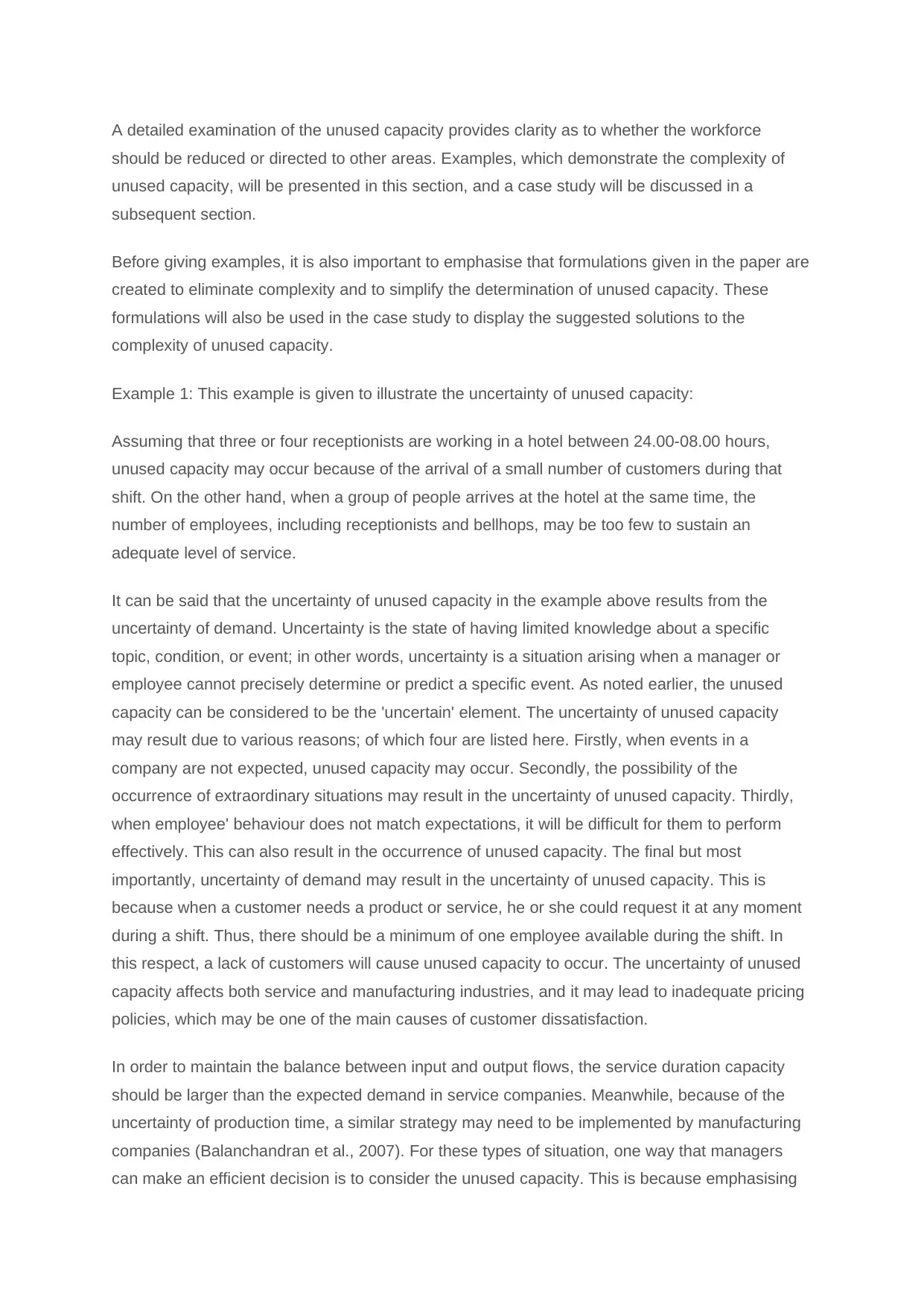
A detailed examination of the unused capacity provides clarity as to whether the workforce
should be reduced or directed to other areas. Examples, which demonstrate the complexity of
unused capacity, will be presented in this section, and a case study will be discussed in a
subsequent section.
Before giving examples, it is also important to emphasise that formulations given in the paper are
created to eliminate complexity and to simplify the determination of unused capacity. These
formulations will also be used in the case study to display the suggested solutions to the
complexity of unused capacity.
Example 1: This example is given to illustrate the uncertainty of unused capacity:
Assuming that three or four receptionists are working in a hotel between 24.00-08.00 hours,
unused capacity may occur because of the arrival of a small number of customers during that
shift. On the other hand, when a group of people arrives at the hotel at the same time, the
number of employees, including receptionists and bellhops, may be too few to sustain an
adequate level of service.
It can be said that the uncertainty of unused capacity in the example above results from the
uncertainty of demand. Uncertainty is the state of having limited knowledge about a specific
topic, condition, or event; in other words, uncertainty is a situation arising when a manager or
employee cannot precisely determine or predict a specific event. As noted earlier, the unused
capacity can be considered to be the 'uncertain' element. The uncertainty of unused capacity
may result due to various reasons; of which four are listed here. Firstly, when events in a
company are not expected, unused capacity may occur. Secondly, the possibility of the
occurrence of extraordinary situations may result in the uncertainty of unused capacity. Thirdly,
when employee' behaviour does not match expectations, it will be difficult for them to perform
effectively. This can also result in the occurrence of unused capacity. The final but most
importantly, uncertainty of demand may result in the uncertainty of unused capacity. This is
because when a customer needs a product or service, he or she could request it at any moment
during a shift. Thus, there should be a minimum of one employee available during the shift. In
this respect, a lack of customers will cause unused capacity to occur. The uncertainty of unused
capacity affects both service and manufacturing industries, and it may lead to inadequate pricing
policies, which may be one of the main causes of customer dissatisfaction.
In order to maintain the balance between input and output flows, the service duration capacity
should be larger than the expected demand in service companies. Meanwhile, because of the
uncertainty of production time, a similar strategy may need to be implemented by manufacturing
companies (Balanchandran et al., 2007). For these types of situation, one way that managers
can make an efficient decision is to consider the unused capacity. This is because emphasising
should be reduced or directed to other areas. Examples, which demonstrate the complexity of
unused capacity, will be presented in this section, and a case study will be discussed in a
subsequent section.
Before giving examples, it is also important to emphasise that formulations given in the paper are
created to eliminate complexity and to simplify the determination of unused capacity. These
formulations will also be used in the case study to display the suggested solutions to the
complexity of unused capacity.
Example 1: This example is given to illustrate the uncertainty of unused capacity:
Assuming that three or four receptionists are working in a hotel between 24.00-08.00 hours,
unused capacity may occur because of the arrival of a small number of customers during that
shift. On the other hand, when a group of people arrives at the hotel at the same time, the
number of employees, including receptionists and bellhops, may be too few to sustain an
adequate level of service.
It can be said that the uncertainty of unused capacity in the example above results from the
uncertainty of demand. Uncertainty is the state of having limited knowledge about a specific
topic, condition, or event; in other words, uncertainty is a situation arising when a manager or
employee cannot precisely determine or predict a specific event. As noted earlier, the unused
capacity can be considered to be the 'uncertain' element. The uncertainty of unused capacity
may result due to various reasons; of which four are listed here. Firstly, when events in a
company are not expected, unused capacity may occur. Secondly, the possibility of the
occurrence of extraordinary situations may result in the uncertainty of unused capacity. Thirdly,
when employee' behaviour does not match expectations, it will be difficult for them to perform
effectively. This can also result in the occurrence of unused capacity. The final but most
importantly, uncertainty of demand may result in the uncertainty of unused capacity. This is
because when a customer needs a product or service, he or she could request it at any moment
during a shift. Thus, there should be a minimum of one employee available during the shift. In
this respect, a lack of customers will cause unused capacity to occur. The uncertainty of unused
capacity affects both service and manufacturing industries, and it may lead to inadequate pricing
policies, which may be one of the main causes of customer dissatisfaction.
In order to maintain the balance between input and output flows, the service duration capacity
should be larger than the expected demand in service companies. Meanwhile, because of the
uncertainty of production time, a similar strategy may need to be implemented by manufacturing
companies (Balanchandran et al., 2007). For these types of situation, one way that managers
can make an efficient decision is to consider the unused capacity. This is because emphasising
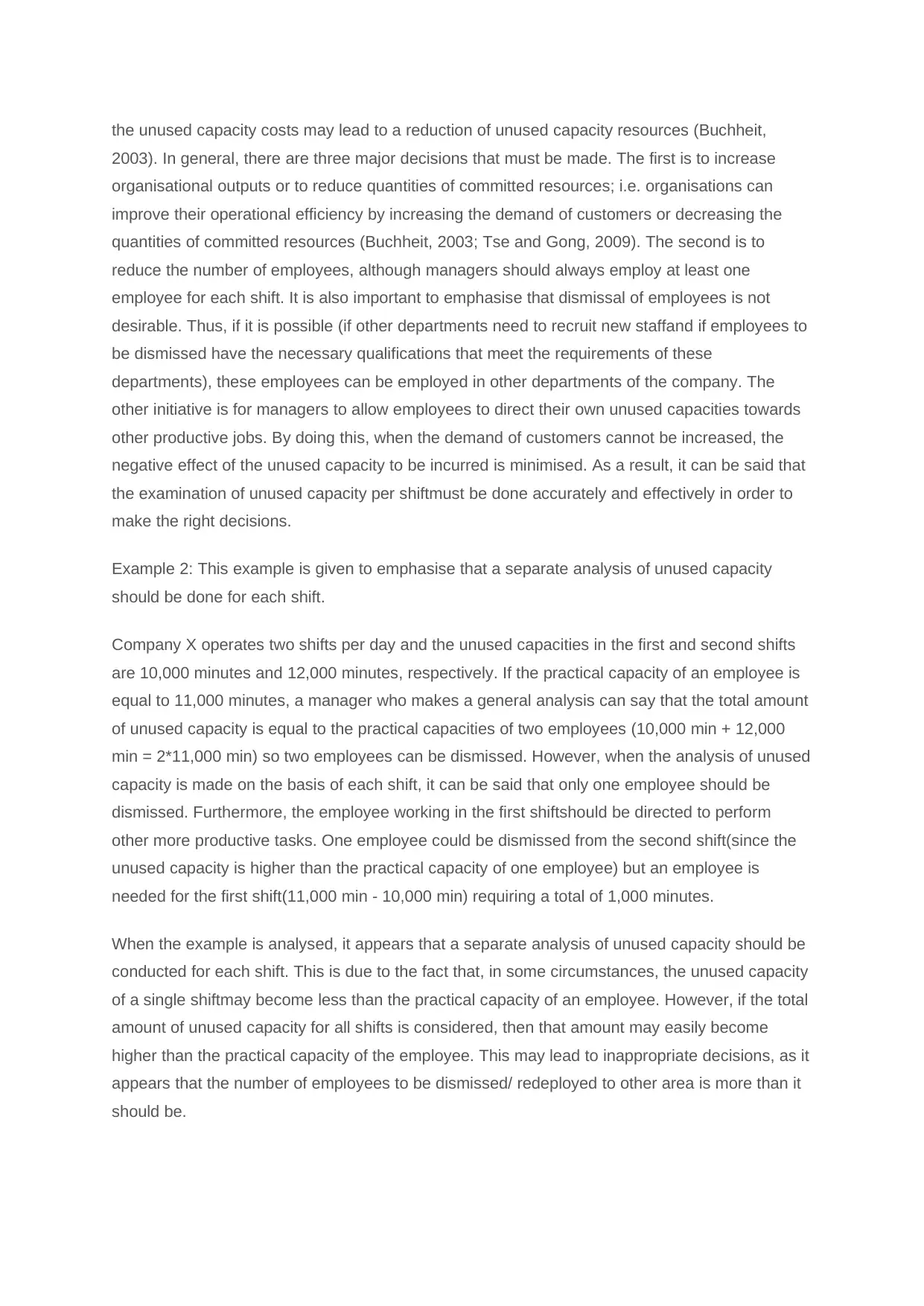
the unused capacity costs may lead to a reduction of unused capacity resources (Buchheit,
2003). In general, there are three major decisions that must be made. The first is to increase
organisational outputs or to reduce quantities of committed resources; i.e. organisations can
improve their operational efficiency by increasing the demand of customers or decreasing the
quantities of committed resources (Buchheit, 2003; Tse and Gong, 2009). The second is to
reduce the number of employees, although managers should always employ at least one
employee for each shift. It is also important to emphasise that dismissal of employees is not
desirable. Thus, if it is possible (if other departments need to recruit new staffand if employees to
be dismissed have the necessary qualifications that meet the requirements of these
departments), these employees can be employed in other departments of the company. The
other initiative is for managers to allow employees to direct their own unused capacities towards
other productive jobs. By doing this, when the demand of customers cannot be increased, the
negative effect of the unused capacity to be incurred is minimised. As a result, it can be said that
the examination of unused capacity per shiftmust be done accurately and effectively in order to
make the right decisions.
Example 2: This example is given to emphasise that a separate analysis of unused capacity
should be done for each shift.
Company X operates two shifts per day and the unused capacities in the first and second shifts
are 10,000 minutes and 12,000 minutes, respectively. If the practical capacity of an employee is
equal to 11,000 minutes, a manager who makes a general analysis can say that the total amount
of unused capacity is equal to the practical capacities of two employees (10,000 min + 12,000
min = 2*11,000 min) so two employees can be dismissed. However, when the analysis of unused
capacity is made on the basis of each shift, it can be said that only one employee should be
dismissed. Furthermore, the employee working in the first shiftshould be directed to perform
other more productive tasks. One employee could be dismissed from the second shift(since the
unused capacity is higher than the practical capacity of one employee) but an employee is
needed for the first shift(11,000 min - 10,000 min) requiring a total of 1,000 minutes.
When the example is analysed, it appears that a separate analysis of unused capacity should be
conducted for each shift. This is due to the fact that, in some circumstances, the unused capacity
of a single shiftmay become less than the practical capacity of an employee. However, if the total
amount of unused capacity for all shifts is considered, then that amount may easily become
higher than the practical capacity of the employee. This may lead to inappropriate decisions, as it
appears that the number of employees to be dismissed/ redeployed to other area is more than it
should be.
2003). In general, there are three major decisions that must be made. The first is to increase
organisational outputs or to reduce quantities of committed resources; i.e. organisations can
improve their operational efficiency by increasing the demand of customers or decreasing the
quantities of committed resources (Buchheit, 2003; Tse and Gong, 2009). The second is to
reduce the number of employees, although managers should always employ at least one
employee for each shift. It is also important to emphasise that dismissal of employees is not
desirable. Thus, if it is possible (if other departments need to recruit new staffand if employees to
be dismissed have the necessary qualifications that meet the requirements of these
departments), these employees can be employed in other departments of the company. The
other initiative is for managers to allow employees to direct their own unused capacities towards
other productive jobs. By doing this, when the demand of customers cannot be increased, the
negative effect of the unused capacity to be incurred is minimised. As a result, it can be said that
the examination of unused capacity per shiftmust be done accurately and effectively in order to
make the right decisions.
Example 2: This example is given to emphasise that a separate analysis of unused capacity
should be done for each shift.
Company X operates two shifts per day and the unused capacities in the first and second shifts
are 10,000 minutes and 12,000 minutes, respectively. If the practical capacity of an employee is
equal to 11,000 minutes, a manager who makes a general analysis can say that the total amount
of unused capacity is equal to the practical capacities of two employees (10,000 min + 12,000
min = 2*11,000 min) so two employees can be dismissed. However, when the analysis of unused
capacity is made on the basis of each shift, it can be said that only one employee should be
dismissed. Furthermore, the employee working in the first shiftshould be directed to perform
other more productive tasks. One employee could be dismissed from the second shift(since the
unused capacity is higher than the practical capacity of one employee) but an employee is
needed for the first shift(11,000 min - 10,000 min) requiring a total of 1,000 minutes.
When the example is analysed, it appears that a separate analysis of unused capacity should be
conducted for each shift. This is due to the fact that, in some circumstances, the unused capacity
of a single shiftmay become less than the practical capacity of an employee. However, if the total
amount of unused capacity for all shifts is considered, then that amount may easily become
higher than the practical capacity of the employee. This may lead to inappropriate decisions, as it
appears that the number of employees to be dismissed/ redeployed to other area is more than it
should be.
Paraphrase This Document
Need a fresh take? Get an instant paraphrase of this document with our AI Paraphraser
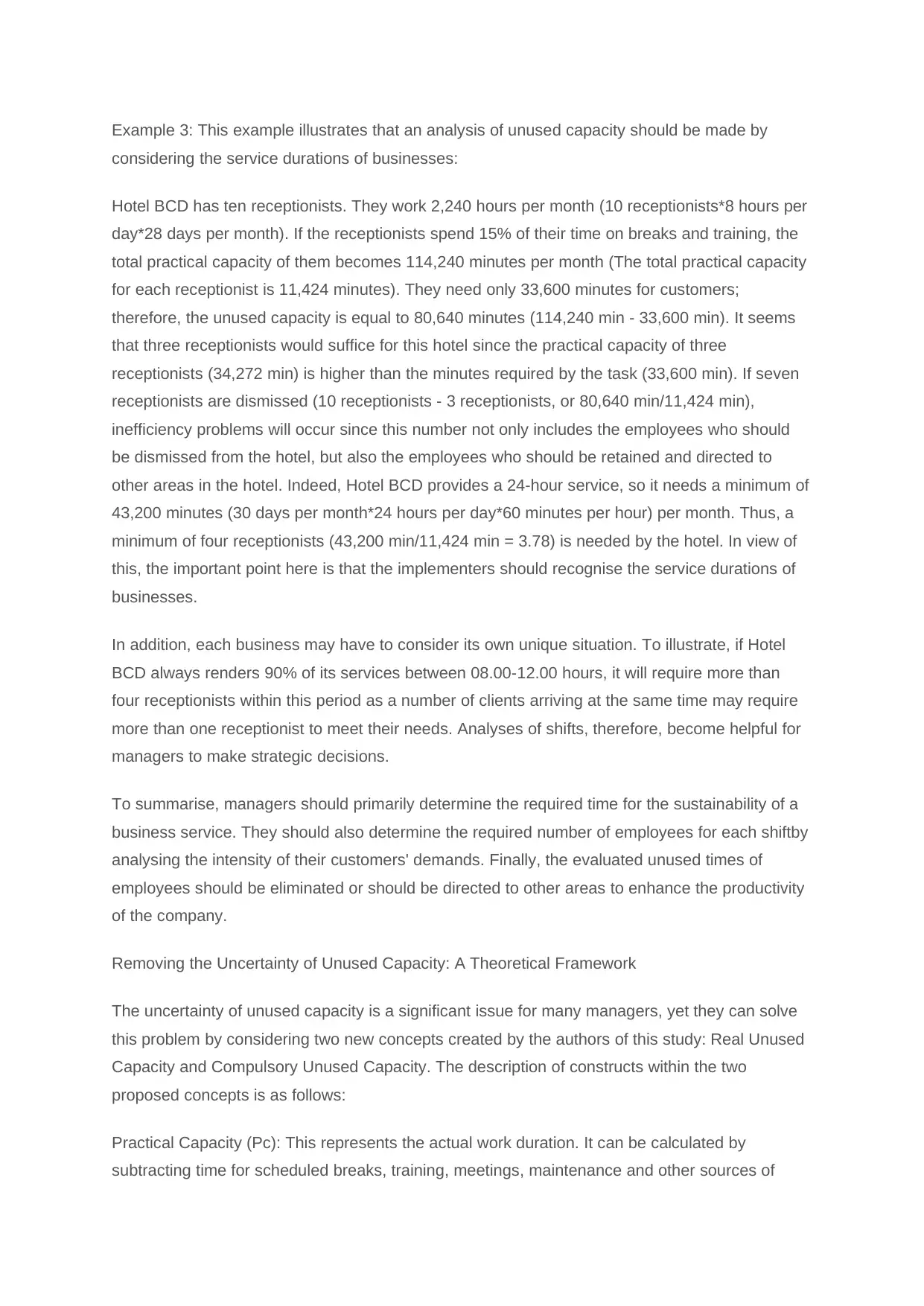
Example 3: This example illustrates that an analysis of unused capacity should be made by
considering the service durations of businesses:
Hotel BCD has ten receptionists. They work 2,240 hours per month (10 receptionists*8 hours per
day*28 days per month). If the receptionists spend 15% of their time on breaks and training, the
total practical capacity of them becomes 114,240 minutes per month (The total practical capacity
for each receptionist is 11,424 minutes). They need only 33,600 minutes for customers;
therefore, the unused capacity is equal to 80,640 minutes (114,240 min - 33,600 min). It seems
that three receptionists would suffice for this hotel since the practical capacity of three
receptionists (34,272 min) is higher than the minutes required by the task (33,600 min). If seven
receptionists are dismissed (10 receptionists - 3 receptionists, or 80,640 min/11,424 min),
inefficiency problems will occur since this number not only includes the employees who should
be dismissed from the hotel, but also the employees who should be retained and directed to
other areas in the hotel. Indeed, Hotel BCD provides a 24-hour service, so it needs a minimum of
43,200 minutes (30 days per month*24 hours per day*60 minutes per hour) per month. Thus, a
minimum of four receptionists (43,200 min/11,424 min = 3.78) is needed by the hotel. In view of
this, the important point here is that the implementers should recognise the service durations of
businesses.
In addition, each business may have to consider its own unique situation. To illustrate, if Hotel
BCD always renders 90% of its services between 08.00-12.00 hours, it will require more than
four receptionists within this period as a number of clients arriving at the same time may require
more than one receptionist to meet their needs. Analyses of shifts, therefore, become helpful for
managers to make strategic decisions.
To summarise, managers should primarily determine the required time for the sustainability of a
business service. They should also determine the required number of employees for each shiftby
analysing the intensity of their customers' demands. Finally, the evaluated unused times of
employees should be eliminated or should be directed to other areas to enhance the productivity
of the company.
Removing the Uncertainty of Unused Capacity: A Theoretical Framework
The uncertainty of unused capacity is a significant issue for many managers, yet they can solve
this problem by considering two new concepts created by the authors of this study: Real Unused
Capacity and Compulsory Unused Capacity. The description of constructs within the two
proposed concepts is as follows:
Practical Capacity (Pc): This represents the actual work duration. It can be calculated by
subtracting time for scheduled breaks, training, meetings, maintenance and other sources of
considering the service durations of businesses:
Hotel BCD has ten receptionists. They work 2,240 hours per month (10 receptionists*8 hours per
day*28 days per month). If the receptionists spend 15% of their time on breaks and training, the
total practical capacity of them becomes 114,240 minutes per month (The total practical capacity
for each receptionist is 11,424 minutes). They need only 33,600 minutes for customers;
therefore, the unused capacity is equal to 80,640 minutes (114,240 min - 33,600 min). It seems
that three receptionists would suffice for this hotel since the practical capacity of three
receptionists (34,272 min) is higher than the minutes required by the task (33,600 min). If seven
receptionists are dismissed (10 receptionists - 3 receptionists, or 80,640 min/11,424 min),
inefficiency problems will occur since this number not only includes the employees who should
be dismissed from the hotel, but also the employees who should be retained and directed to
other areas in the hotel. Indeed, Hotel BCD provides a 24-hour service, so it needs a minimum of
43,200 minutes (30 days per month*24 hours per day*60 minutes per hour) per month. Thus, a
minimum of four receptionists (43,200 min/11,424 min = 3.78) is needed by the hotel. In view of
this, the important point here is that the implementers should recognise the service durations of
businesses.
In addition, each business may have to consider its own unique situation. To illustrate, if Hotel
BCD always renders 90% of its services between 08.00-12.00 hours, it will require more than
four receptionists within this period as a number of clients arriving at the same time may require
more than one receptionist to meet their needs. Analyses of shifts, therefore, become helpful for
managers to make strategic decisions.
To summarise, managers should primarily determine the required time for the sustainability of a
business service. They should also determine the required number of employees for each shiftby
analysing the intensity of their customers' demands. Finally, the evaluated unused times of
employees should be eliminated or should be directed to other areas to enhance the productivity
of the company.
Removing the Uncertainty of Unused Capacity: A Theoretical Framework
The uncertainty of unused capacity is a significant issue for many managers, yet they can solve
this problem by considering two new concepts created by the authors of this study: Real Unused
Capacity and Compulsory Unused Capacity. The description of constructs within the two
proposed concepts is as follows:
Practical Capacity (Pc): This represents the actual work duration. It can be calculated by
subtracting time for scheduled breaks, training, meetings, maintenance and other sources of
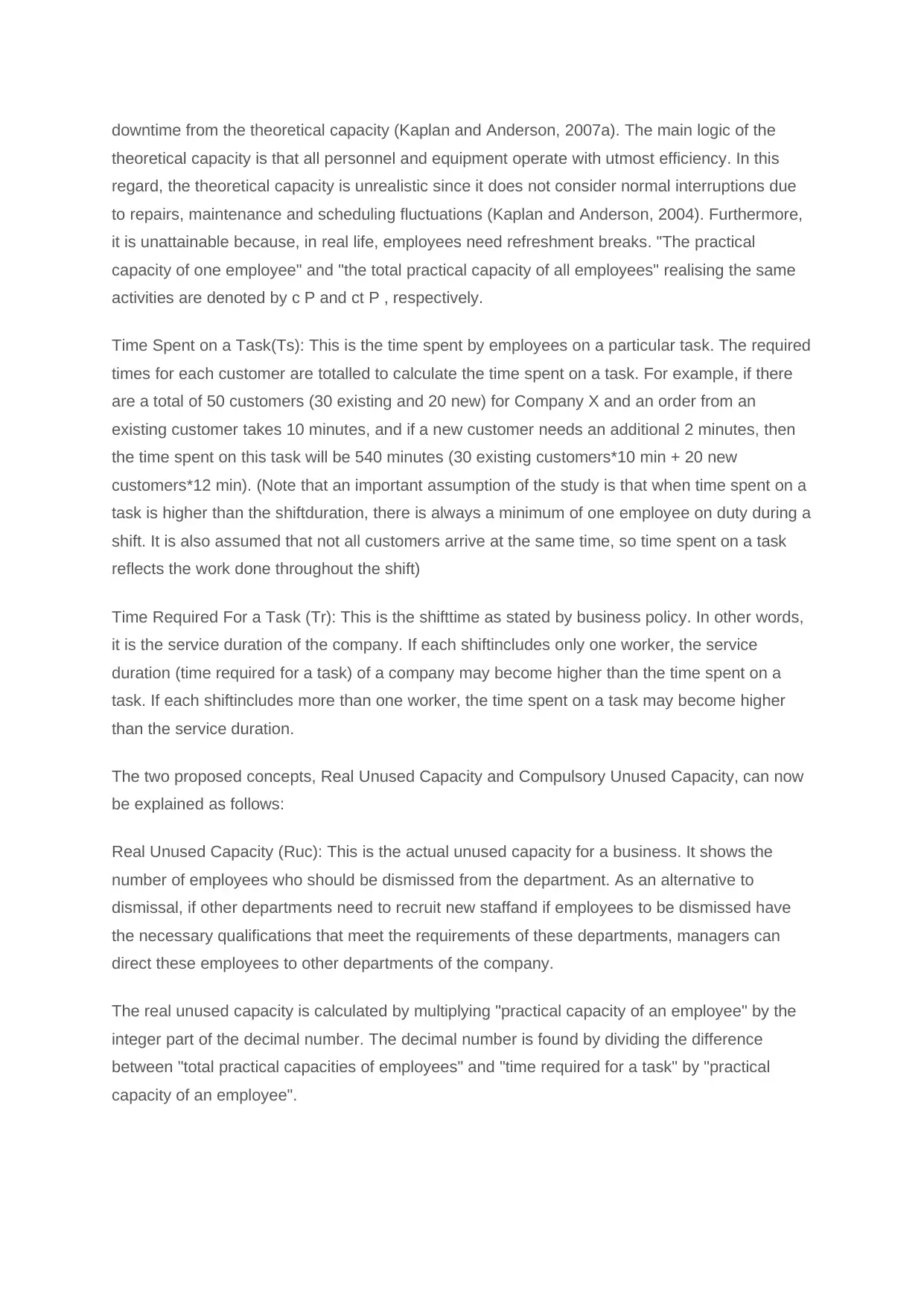
downtime from the theoretical capacity (Kaplan and Anderson, 2007a). The main logic of the
theoretical capacity is that all personnel and equipment operate with utmost efficiency. In this
regard, the theoretical capacity is unrealistic since it does not consider normal interruptions due
to repairs, maintenance and scheduling fluctuations (Kaplan and Anderson, 2004). Furthermore,
it is unattainable because, in real life, employees need refreshment breaks. "The practical
capacity of one employee" and "the total practical capacity of all employees" realising the same
activities are denoted by c P and ct P , respectively.
Time Spent on a Task(Ts): This is the time spent by employees on a particular task. The required
times for each customer are totalled to calculate the time spent on a task. For example, if there
are a total of 50 customers (30 existing and 20 new) for Company X and an order from an
existing customer takes 10 minutes, and if a new customer needs an additional 2 minutes, then
the time spent on this task will be 540 minutes (30 existing customers*10 min + 20 new
customers*12 min). (Note that an important assumption of the study is that when time spent on a
task is higher than the shiftduration, there is always a minimum of one employee on duty during a
shift. It is also assumed that not all customers arrive at the same time, so time spent on a task
reflects the work done throughout the shift)
Time Required For a Task (Tr): This is the shifttime as stated by business policy. In other words,
it is the service duration of the company. If each shiftincludes only one worker, the service
duration (time required for a task) of a company may become higher than the time spent on a
task. If each shiftincludes more than one worker, the time spent on a task may become higher
than the service duration.
The two proposed concepts, Real Unused Capacity and Compulsory Unused Capacity, can now
be explained as follows:
Real Unused Capacity (Ruc): This is the actual unused capacity for a business. It shows the
number of employees who should be dismissed from the department. As an alternative to
dismissal, if other departments need to recruit new staffand if employees to be dismissed have
the necessary qualifications that meet the requirements of these departments, managers can
direct these employees to other departments of the company.
The real unused capacity is calculated by multiplying "practical capacity of an employee" by the
integer part of the decimal number. The decimal number is found by dividing the difference
between "total practical capacities of employees" and "time required for a task" by "practical
capacity of an employee".
theoretical capacity is that all personnel and equipment operate with utmost efficiency. In this
regard, the theoretical capacity is unrealistic since it does not consider normal interruptions due
to repairs, maintenance and scheduling fluctuations (Kaplan and Anderson, 2004). Furthermore,
it is unattainable because, in real life, employees need refreshment breaks. "The practical
capacity of one employee" and "the total practical capacity of all employees" realising the same
activities are denoted by c P and ct P , respectively.
Time Spent on a Task(Ts): This is the time spent by employees on a particular task. The required
times for each customer are totalled to calculate the time spent on a task. For example, if there
are a total of 50 customers (30 existing and 20 new) for Company X and an order from an
existing customer takes 10 minutes, and if a new customer needs an additional 2 minutes, then
the time spent on this task will be 540 minutes (30 existing customers*10 min + 20 new
customers*12 min). (Note that an important assumption of the study is that when time spent on a
task is higher than the shiftduration, there is always a minimum of one employee on duty during a
shift. It is also assumed that not all customers arrive at the same time, so time spent on a task
reflects the work done throughout the shift)
Time Required For a Task (Tr): This is the shifttime as stated by business policy. In other words,
it is the service duration of the company. If each shiftincludes only one worker, the service
duration (time required for a task) of a company may become higher than the time spent on a
task. If each shiftincludes more than one worker, the time spent on a task may become higher
than the service duration.
The two proposed concepts, Real Unused Capacity and Compulsory Unused Capacity, can now
be explained as follows:
Real Unused Capacity (Ruc): This is the actual unused capacity for a business. It shows the
number of employees who should be dismissed from the department. As an alternative to
dismissal, if other departments need to recruit new staffand if employees to be dismissed have
the necessary qualifications that meet the requirements of these departments, managers can
direct these employees to other departments of the company.
The real unused capacity is calculated by multiplying "practical capacity of an employee" by the
integer part of the decimal number. The decimal number is found by dividing the difference
between "total practical capacities of employees" and "time required for a task" by "practical
capacity of an employee".

However, "time required for a task" is changed with "time spent on a task" in the formulae when
the "time spent on a task" is higher than the "time required for a task". Real unused capacity can
take only integer values. It is always equal to multiples of the practical capacity of an employee.
Compulsory Unused Capacity (Cuc): This is mandatory unused capacity, and it is necessary for
the continuity of a business. Unlike real unused capacity, it shows the number of employees who
should be directed to other productive areas such as sending e-mails to customers regarding
reservation dates, informing customers about promotions, or any other job that is not listed in
their job descriptions.
Each business has its own policy on sales, promotion and distribution. One of the most important
policies of a business is the service duration policy. Regarding service duration, in general, many
businesses are divided into three different groups; businesses rendering 8, 16, or 24 hour
services. It is also important to emphasise that the service duration (capacity) should be larger
than the expected demand due to the uncertainty of demand (Balanchandran et al., 2007).
The compulsory unused capacity is calculated by multiplying "practical capacity of an employee"
by the decimal place of the decimal number. In addition, when the "time required for a task"
becomes higher than the "time spent on a task", the difference should be added to the value
found by multiplying "practical capacity of an employee" by the decimal place of the decimal
number. As is explained above, the decimal number is found by dividing the difference between
"total practical capacities of employees" and "time required for a task" by "practical capacity of an
employee". However, the "time required for a task" is changed with the "time spent on a task" in
the formulae when the "time spent on a task" is higher than the "time required for a task".
The Real and Compulsory Unused Capacities can be expressed in formulae as follows:
Assuming that Ts < Tr, then
Ruc = X* Pc
Where "Ruc" is the real unused capacity, "Pc" is the practical capacity of an employee, "X" is the
integer part of the decimal number. Consider a decimal number as X.abc where X is an integer
part and abc is a decimal place including the first three terms of the decimal number.
The decimal number can be found as:
...
the "time spent on a task" is higher than the "time required for a task". Real unused capacity can
take only integer values. It is always equal to multiples of the practical capacity of an employee.
Compulsory Unused Capacity (Cuc): This is mandatory unused capacity, and it is necessary for
the continuity of a business. Unlike real unused capacity, it shows the number of employees who
should be directed to other productive areas such as sending e-mails to customers regarding
reservation dates, informing customers about promotions, or any other job that is not listed in
their job descriptions.
Each business has its own policy on sales, promotion and distribution. One of the most important
policies of a business is the service duration policy. Regarding service duration, in general, many
businesses are divided into three different groups; businesses rendering 8, 16, or 24 hour
services. It is also important to emphasise that the service duration (capacity) should be larger
than the expected demand due to the uncertainty of demand (Balanchandran et al., 2007).
The compulsory unused capacity is calculated by multiplying "practical capacity of an employee"
by the decimal place of the decimal number. In addition, when the "time required for a task"
becomes higher than the "time spent on a task", the difference should be added to the value
found by multiplying "practical capacity of an employee" by the decimal place of the decimal
number. As is explained above, the decimal number is found by dividing the difference between
"total practical capacities of employees" and "time required for a task" by "practical capacity of an
employee". However, the "time required for a task" is changed with the "time spent on a task" in
the formulae when the "time spent on a task" is higher than the "time required for a task".
The Real and Compulsory Unused Capacities can be expressed in formulae as follows:
Assuming that Ts < Tr, then
Ruc = X* Pc
Where "Ruc" is the real unused capacity, "Pc" is the practical capacity of an employee, "X" is the
integer part of the decimal number. Consider a decimal number as X.abc where X is an integer
part and abc is a decimal place including the first three terms of the decimal number.
The decimal number can be found as:
...
Secure Best Marks with AI Grader
Need help grading? Try our AI Grader for instant feedback on your assignments.
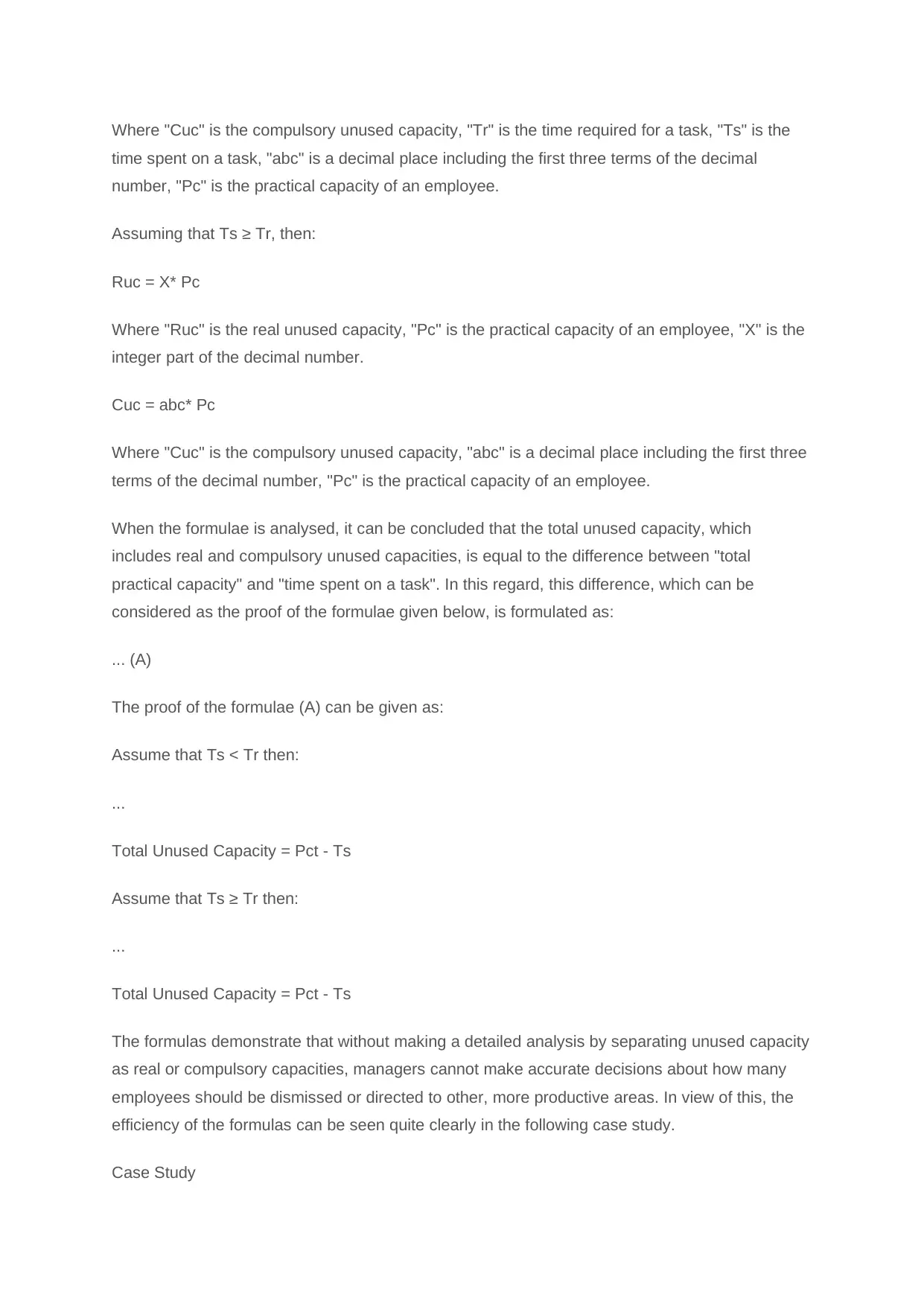
Where "Cuc" is the compulsory unused capacity, "Tr" is the time required for a task, "Ts" is the
time spent on a task, "abc" is a decimal place including the first three terms of the decimal
number, "Pc" is the practical capacity of an employee.
Assuming that Ts ≥ Tr, then:
Ruc = X* Pc
Where "Ruc" is the real unused capacity, "Pc" is the practical capacity of an employee, "X" is the
integer part of the decimal number.
Cuc = abc* Pc
Where "Cuc" is the compulsory unused capacity, "abc" is a decimal place including the first three
terms of the decimal number, "Pc" is the practical capacity of an employee.
When the formulae is analysed, it can be concluded that the total unused capacity, which
includes real and compulsory unused capacities, is equal to the difference between "total
practical capacity" and "time spent on a task". In this regard, this difference, which can be
considered as the proof of the formulae given below, is formulated as:
... (A)
The proof of the formulae (A) can be given as:
Assume that Ts < Tr then:
...
Total Unused Capacity = Pct - Ts
Assume that Ts ≥ Tr then:
...
Total Unused Capacity = Pct - Ts
The formulas demonstrate that without making a detailed analysis by separating unused capacity
as real or compulsory capacities, managers cannot make accurate decisions about how many
employees should be dismissed or directed to other, more productive areas. In view of this, the
efficiency of the formulas can be seen quite clearly in the following case study.
Case Study
time spent on a task, "abc" is a decimal place including the first three terms of the decimal
number, "Pc" is the practical capacity of an employee.
Assuming that Ts ≥ Tr, then:
Ruc = X* Pc
Where "Ruc" is the real unused capacity, "Pc" is the practical capacity of an employee, "X" is the
integer part of the decimal number.
Cuc = abc* Pc
Where "Cuc" is the compulsory unused capacity, "abc" is a decimal place including the first three
terms of the decimal number, "Pc" is the practical capacity of an employee.
When the formulae is analysed, it can be concluded that the total unused capacity, which
includes real and compulsory unused capacities, is equal to the difference between "total
practical capacity" and "time spent on a task". In this regard, this difference, which can be
considered as the proof of the formulae given below, is formulated as:
... (A)
The proof of the formulae (A) can be given as:
Assume that Ts < Tr then:
...
Total Unused Capacity = Pct - Ts
Assume that Ts ≥ Tr then:
...
Total Unused Capacity = Pct - Ts
The formulas demonstrate that without making a detailed analysis by separating unused capacity
as real or compulsory capacities, managers cannot make accurate decisions about how many
employees should be dismissed or directed to other, more productive areas. In view of this, the
efficiency of the formulas can be seen quite clearly in the following case study.
Case Study

As mentioned in the previous sections, unused capacity determination and employee
coordination become much more difficult in complex organisations. This complexity will be
clarified in a case study in combination with a theoretical framework. Firstly, the research method
will be summarised; following this, the case study will be presented.
Research Method
The method used in this study is a "Case Study". This method has been selected as it provides a
wide perspective for the research. The 24-hour service policy of hospitals helps to reveal the
importance of unused capacity examination; hence, a hospital was selected in order to increase
the validity of the study.
In this regard, a descriptive case study was first carried out to identify the current situation of the
hospital. Following this, an exploratory case study was conducted to evaluate the applicability of
the proposed concepts, where the aim is to minimise the uncertainty of the unused capacity of
secretaries in the hospital.
The researchers visited the hospital regularly to investigate the current working environment of
the secretaries. Thus, in this study, face-toface interviews with the hospital management and
secretaries were carried out, and comprehensive direct observations as well as documentation
collection were used as data collection methods. Accordingly, the daily practices of secretaries in
the hospital were analysed at least three times per month during the year 2010.
In addition to the observations and face-toface interviews, researchers were able to obtain a
significant amount of data through telephone calls with both the management and the
secretaries. The data collected were analysed as follows.
The Case Study Company
The Hospital Alfa (The management of the hospital asked the researcher not to use its real
name), where the case study was conducted, is a well-equipped private hospital which provides
a 24-hour emergency service for patients. It is located in Adana, which is a province in the
southern part of Turkey.
This study analyses the time spent by secretaries working in the General Surgery Department
only. An analysis of capacity costs at departmental level provides insights into whether or not
departmental managers are reacting effectively in response to market conditions (Yahya-Zadeh,
2011). Therefore, this study will facilitate the capacity management of the secretaries of the
General Surgery Department.
coordination become much more difficult in complex organisations. This complexity will be
clarified in a case study in combination with a theoretical framework. Firstly, the research method
will be summarised; following this, the case study will be presented.
Research Method
The method used in this study is a "Case Study". This method has been selected as it provides a
wide perspective for the research. The 24-hour service policy of hospitals helps to reveal the
importance of unused capacity examination; hence, a hospital was selected in order to increase
the validity of the study.
In this regard, a descriptive case study was first carried out to identify the current situation of the
hospital. Following this, an exploratory case study was conducted to evaluate the applicability of
the proposed concepts, where the aim is to minimise the uncertainty of the unused capacity of
secretaries in the hospital.
The researchers visited the hospital regularly to investigate the current working environment of
the secretaries. Thus, in this study, face-toface interviews with the hospital management and
secretaries were carried out, and comprehensive direct observations as well as documentation
collection were used as data collection methods. Accordingly, the daily practices of secretaries in
the hospital were analysed at least three times per month during the year 2010.
In addition to the observations and face-toface interviews, researchers were able to obtain a
significant amount of data through telephone calls with both the management and the
secretaries. The data collected were analysed as follows.
The Case Study Company
The Hospital Alfa (The management of the hospital asked the researcher not to use its real
name), where the case study was conducted, is a well-equipped private hospital which provides
a 24-hour emergency service for patients. It is located in Adana, which is a province in the
southern part of Turkey.
This study analyses the time spent by secretaries working in the General Surgery Department
only. An analysis of capacity costs at departmental level provides insights into whether or not
departmental managers are reacting effectively in response to market conditions (Yahya-Zadeh,
2011). Therefore, this study will facilitate the capacity management of the secretaries of the
General Surgery Department.
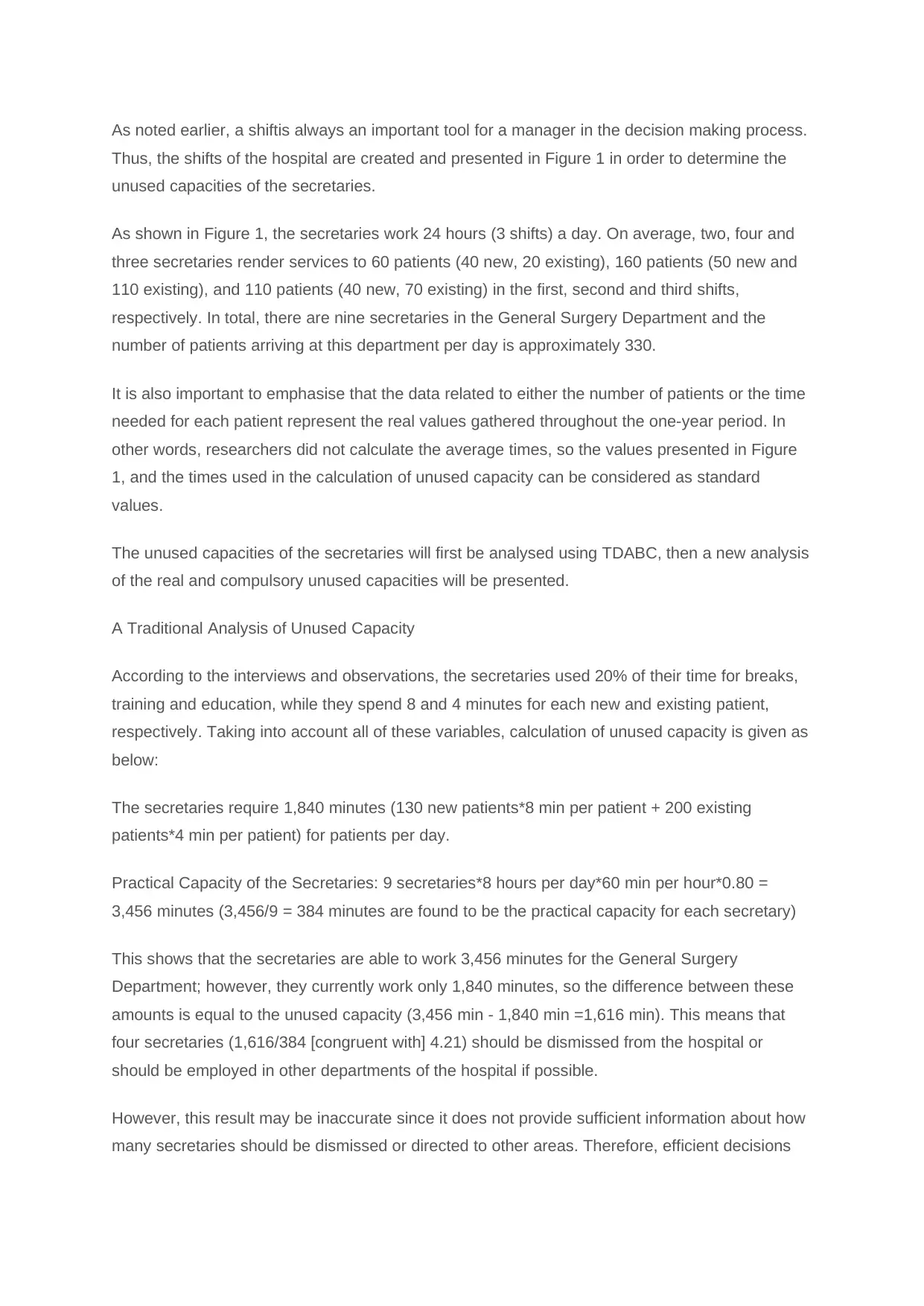
As noted earlier, a shiftis always an important tool for a manager in the decision making process.
Thus, the shifts of the hospital are created and presented in Figure 1 in order to determine the
unused capacities of the secretaries.
As shown in Figure 1, the secretaries work 24 hours (3 shifts) a day. On average, two, four and
three secretaries render services to 60 patients (40 new, 20 existing), 160 patients (50 new and
110 existing), and 110 patients (40 new, 70 existing) in the first, second and third shifts,
respectively. In total, there are nine secretaries in the General Surgery Department and the
number of patients arriving at this department per day is approximately 330.
It is also important to emphasise that the data related to either the number of patients or the time
needed for each patient represent the real values gathered throughout the one-year period. In
other words, researchers did not calculate the average times, so the values presented in Figure
1, and the times used in the calculation of unused capacity can be considered as standard
values.
The unused capacities of the secretaries will first be analysed using TDABC, then a new analysis
of the real and compulsory unused capacities will be presented.
A Traditional Analysis of Unused Capacity
According to the interviews and observations, the secretaries used 20% of their time for breaks,
training and education, while they spend 8 and 4 minutes for each new and existing patient,
respectively. Taking into account all of these variables, calculation of unused capacity is given as
below:
The secretaries require 1,840 minutes (130 new patients*8 min per patient + 200 existing
patients*4 min per patient) for patients per day.
Practical Capacity of the Secretaries: 9 secretaries*8 hours per day*60 min per hour*0.80 =
3,456 minutes (3,456/9 = 384 minutes are found to be the practical capacity for each secretary)
This shows that the secretaries are able to work 3,456 minutes for the General Surgery
Department; however, they currently work only 1,840 minutes, so the difference between these
amounts is equal to the unused capacity (3,456 min - 1,840 min =1,616 min). This means that
four secretaries (1,616/384 [congruent with] 4.21) should be dismissed from the hospital or
should be employed in other departments of the hospital if possible.
However, this result may be inaccurate since it does not provide sufficient information about how
many secretaries should be dismissed or directed to other areas. Therefore, efficient decisions
Thus, the shifts of the hospital are created and presented in Figure 1 in order to determine the
unused capacities of the secretaries.
As shown in Figure 1, the secretaries work 24 hours (3 shifts) a day. On average, two, four and
three secretaries render services to 60 patients (40 new, 20 existing), 160 patients (50 new and
110 existing), and 110 patients (40 new, 70 existing) in the first, second and third shifts,
respectively. In total, there are nine secretaries in the General Surgery Department and the
number of patients arriving at this department per day is approximately 330.
It is also important to emphasise that the data related to either the number of patients or the time
needed for each patient represent the real values gathered throughout the one-year period. In
other words, researchers did not calculate the average times, so the values presented in Figure
1, and the times used in the calculation of unused capacity can be considered as standard
values.
The unused capacities of the secretaries will first be analysed using TDABC, then a new analysis
of the real and compulsory unused capacities will be presented.
A Traditional Analysis of Unused Capacity
According to the interviews and observations, the secretaries used 20% of their time for breaks,
training and education, while they spend 8 and 4 minutes for each new and existing patient,
respectively. Taking into account all of these variables, calculation of unused capacity is given as
below:
The secretaries require 1,840 minutes (130 new patients*8 min per patient + 200 existing
patients*4 min per patient) for patients per day.
Practical Capacity of the Secretaries: 9 secretaries*8 hours per day*60 min per hour*0.80 =
3,456 minutes (3,456/9 = 384 minutes are found to be the practical capacity for each secretary)
This shows that the secretaries are able to work 3,456 minutes for the General Surgery
Department; however, they currently work only 1,840 minutes, so the difference between these
amounts is equal to the unused capacity (3,456 min - 1,840 min =1,616 min). This means that
four secretaries (1,616/384 [congruent with] 4.21) should be dismissed from the hospital or
should be employed in other departments of the hospital if possible.
However, this result may be inaccurate since it does not provide sufficient information about how
many secretaries should be dismissed or directed to other areas. Therefore, efficient decisions
Paraphrase This Document
Need a fresh take? Get an instant paraphrase of this document with our AI Paraphraser
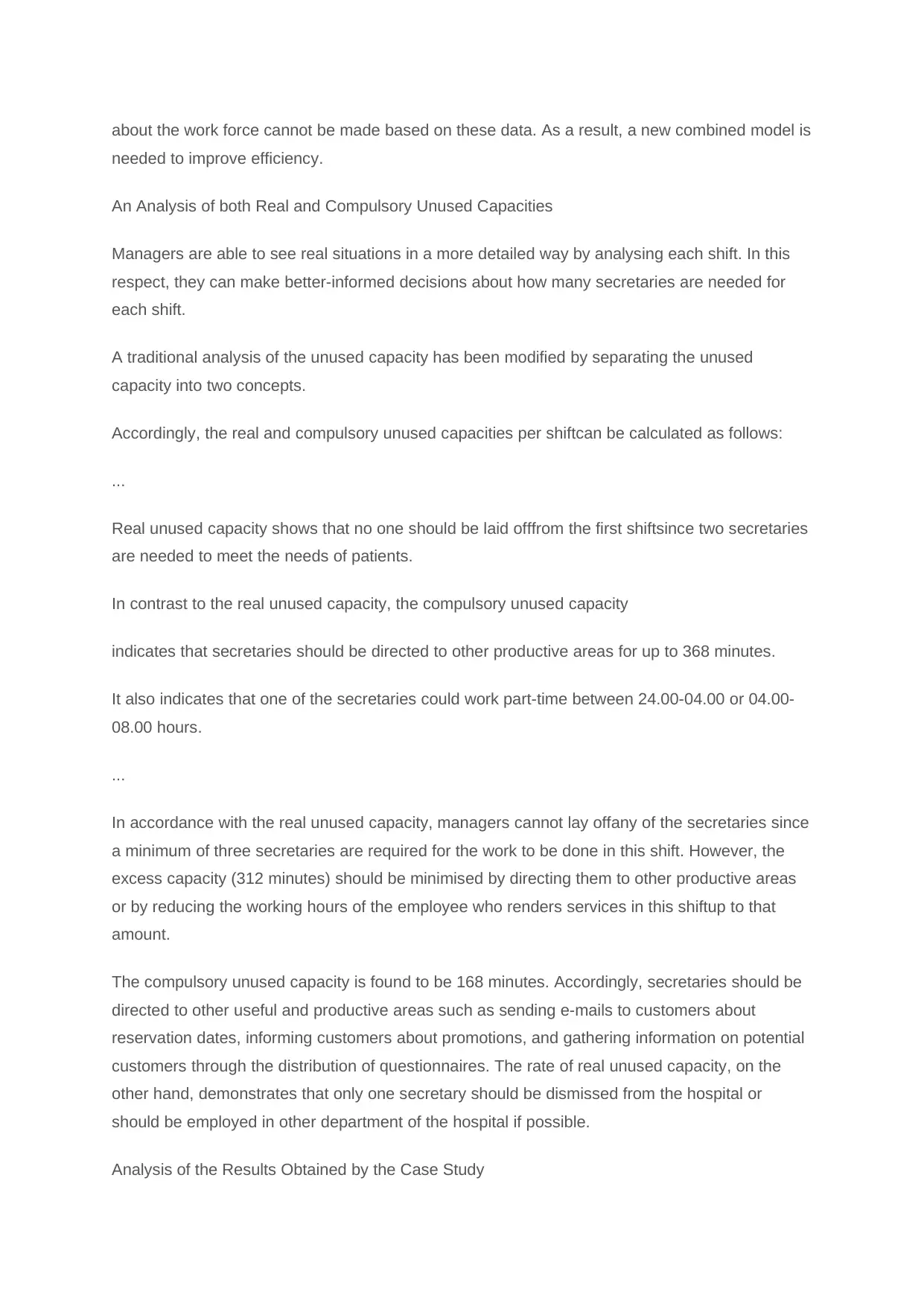
about the work force cannot be made based on these data. As a result, a new combined model is
needed to improve efficiency.
An Analysis of both Real and Compulsory Unused Capacities
Managers are able to see real situations in a more detailed way by analysing each shift. In this
respect, they can make better-informed decisions about how many secretaries are needed for
each shift.
A traditional analysis of the unused capacity has been modified by separating the unused
capacity into two concepts.
Accordingly, the real and compulsory unused capacities per shiftcan be calculated as follows:
...
Real unused capacity shows that no one should be laid offfrom the first shiftsince two secretaries
are needed to meet the needs of patients.
In contrast to the real unused capacity, the compulsory unused capacity
indicates that secretaries should be directed to other productive areas for up to 368 minutes.
It also indicates that one of the secretaries could work part-time between 24.00-04.00 or 04.00-
08.00 hours.
...
In accordance with the real unused capacity, managers cannot lay offany of the secretaries since
a minimum of three secretaries are required for the work to be done in this shift. However, the
excess capacity (312 minutes) should be minimised by directing them to other productive areas
or by reducing the working hours of the employee who renders services in this shiftup to that
amount.
The compulsory unused capacity is found to be 168 minutes. Accordingly, secretaries should be
directed to other useful and productive areas such as sending e-mails to customers about
reservation dates, informing customers about promotions, and gathering information on potential
customers through the distribution of questionnaires. The rate of real unused capacity, on the
other hand, demonstrates that only one secretary should be dismissed from the hospital or
should be employed in other department of the hospital if possible.
Analysis of the Results Obtained by the Case Study
needed to improve efficiency.
An Analysis of both Real and Compulsory Unused Capacities
Managers are able to see real situations in a more detailed way by analysing each shift. In this
respect, they can make better-informed decisions about how many secretaries are needed for
each shift.
A traditional analysis of the unused capacity has been modified by separating the unused
capacity into two concepts.
Accordingly, the real and compulsory unused capacities per shiftcan be calculated as follows:
...
Real unused capacity shows that no one should be laid offfrom the first shiftsince two secretaries
are needed to meet the needs of patients.
In contrast to the real unused capacity, the compulsory unused capacity
indicates that secretaries should be directed to other productive areas for up to 368 minutes.
It also indicates that one of the secretaries could work part-time between 24.00-04.00 or 04.00-
08.00 hours.
...
In accordance with the real unused capacity, managers cannot lay offany of the secretaries since
a minimum of three secretaries are required for the work to be done in this shift. However, the
excess capacity (312 minutes) should be minimised by directing them to other productive areas
or by reducing the working hours of the employee who renders services in this shiftup to that
amount.
The compulsory unused capacity is found to be 168 minutes. Accordingly, secretaries should be
directed to other useful and productive areas such as sending e-mails to customers about
reservation dates, informing customers about promotions, and gathering information on potential
customers through the distribution of questionnaires. The rate of real unused capacity, on the
other hand, demonstrates that only one secretary should be dismissed from the hospital or
should be employed in other department of the hospital if possible.
Analysis of the Results Obtained by the Case Study
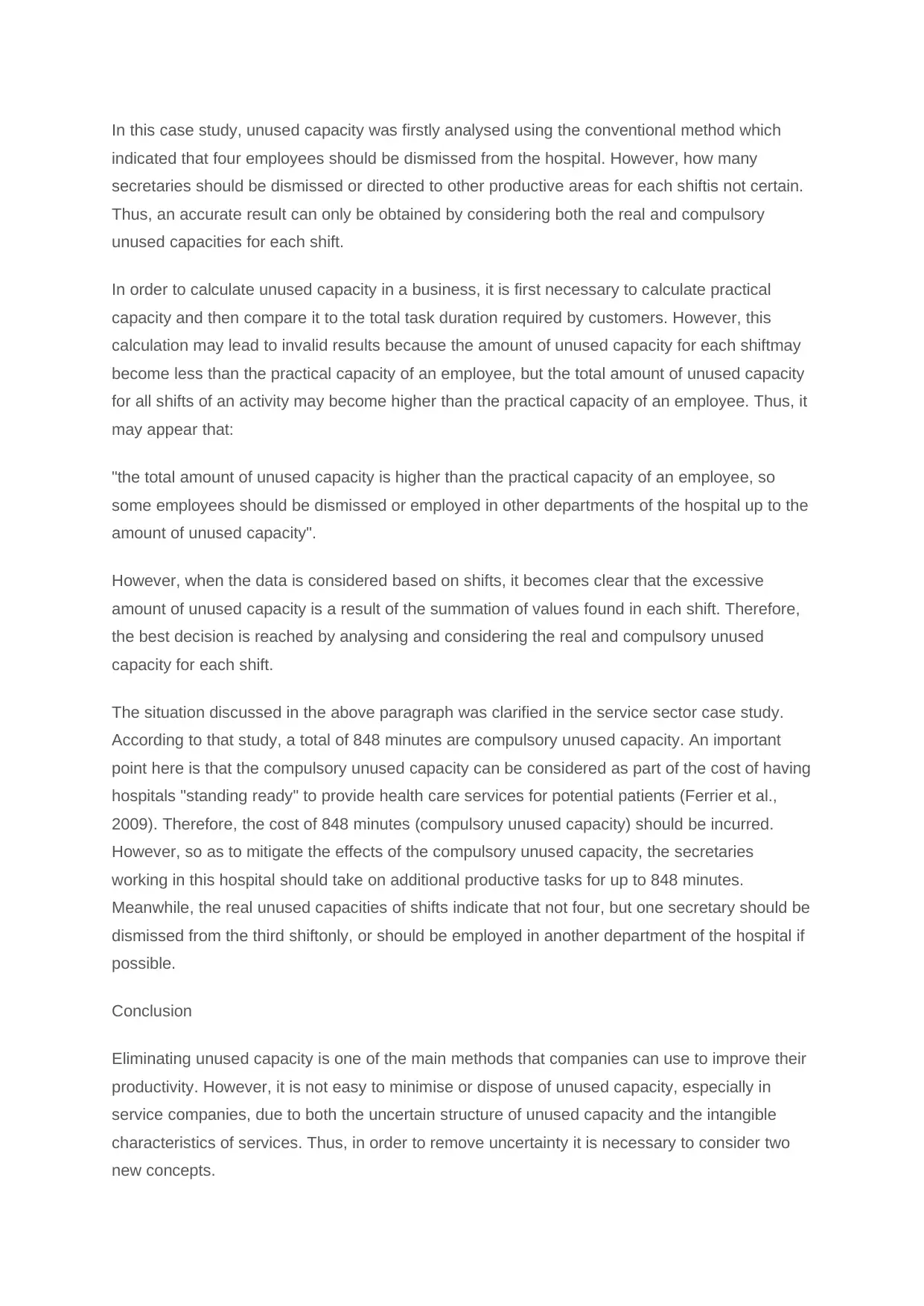
In this case study, unused capacity was firstly analysed using the conventional method which
indicated that four employees should be dismissed from the hospital. However, how many
secretaries should be dismissed or directed to other productive areas for each shiftis not certain.
Thus, an accurate result can only be obtained by considering both the real and compulsory
unused capacities for each shift.
In order to calculate unused capacity in a business, it is first necessary to calculate practical
capacity and then compare it to the total task duration required by customers. However, this
calculation may lead to invalid results because the amount of unused capacity for each shiftmay
become less than the practical capacity of an employee, but the total amount of unused capacity
for all shifts of an activity may become higher than the practical capacity of an employee. Thus, it
may appear that:
"the total amount of unused capacity is higher than the practical capacity of an employee, so
some employees should be dismissed or employed in other departments of the hospital up to the
amount of unused capacity".
However, when the data is considered based on shifts, it becomes clear that the excessive
amount of unused capacity is a result of the summation of values found in each shift. Therefore,
the best decision is reached by analysing and considering the real and compulsory unused
capacity for each shift.
The situation discussed in the above paragraph was clarified in the service sector case study.
According to that study, a total of 848 minutes are compulsory unused capacity. An important
point here is that the compulsory unused capacity can be considered as part of the cost of having
hospitals "standing ready" to provide health care services for potential patients (Ferrier et al.,
2009). Therefore, the cost of 848 minutes (compulsory unused capacity) should be incurred.
However, so as to mitigate the effects of the compulsory unused capacity, the secretaries
working in this hospital should take on additional productive tasks for up to 848 minutes.
Meanwhile, the real unused capacities of shifts indicate that not four, but one secretary should be
dismissed from the third shiftonly, or should be employed in another department of the hospital if
possible.
Conclusion
Eliminating unused capacity is one of the main methods that companies can use to improve their
productivity. However, it is not easy to minimise or dispose of unused capacity, especially in
service companies, due to both the uncertain structure of unused capacity and the intangible
characteristics of services. Thus, in order to remove uncertainty it is necessary to consider two
new concepts.
indicated that four employees should be dismissed from the hospital. However, how many
secretaries should be dismissed or directed to other productive areas for each shiftis not certain.
Thus, an accurate result can only be obtained by considering both the real and compulsory
unused capacities for each shift.
In order to calculate unused capacity in a business, it is first necessary to calculate practical
capacity and then compare it to the total task duration required by customers. However, this
calculation may lead to invalid results because the amount of unused capacity for each shiftmay
become less than the practical capacity of an employee, but the total amount of unused capacity
for all shifts of an activity may become higher than the practical capacity of an employee. Thus, it
may appear that:
"the total amount of unused capacity is higher than the practical capacity of an employee, so
some employees should be dismissed or employed in other departments of the hospital up to the
amount of unused capacity".
However, when the data is considered based on shifts, it becomes clear that the excessive
amount of unused capacity is a result of the summation of values found in each shift. Therefore,
the best decision is reached by analysing and considering the real and compulsory unused
capacity for each shift.
The situation discussed in the above paragraph was clarified in the service sector case study.
According to that study, a total of 848 minutes are compulsory unused capacity. An important
point here is that the compulsory unused capacity can be considered as part of the cost of having
hospitals "standing ready" to provide health care services for potential patients (Ferrier et al.,
2009). Therefore, the cost of 848 minutes (compulsory unused capacity) should be incurred.
However, so as to mitigate the effects of the compulsory unused capacity, the secretaries
working in this hospital should take on additional productive tasks for up to 848 minutes.
Meanwhile, the real unused capacities of shifts indicate that not four, but one secretary should be
dismissed from the third shiftonly, or should be employed in another department of the hospital if
possible.
Conclusion
Eliminating unused capacity is one of the main methods that companies can use to improve their
productivity. However, it is not easy to minimise or dispose of unused capacity, especially in
service companies, due to both the uncertain structure of unused capacity and the intangible
characteristics of services. Thus, in order to remove uncertainty it is necessary to consider two
new concepts.
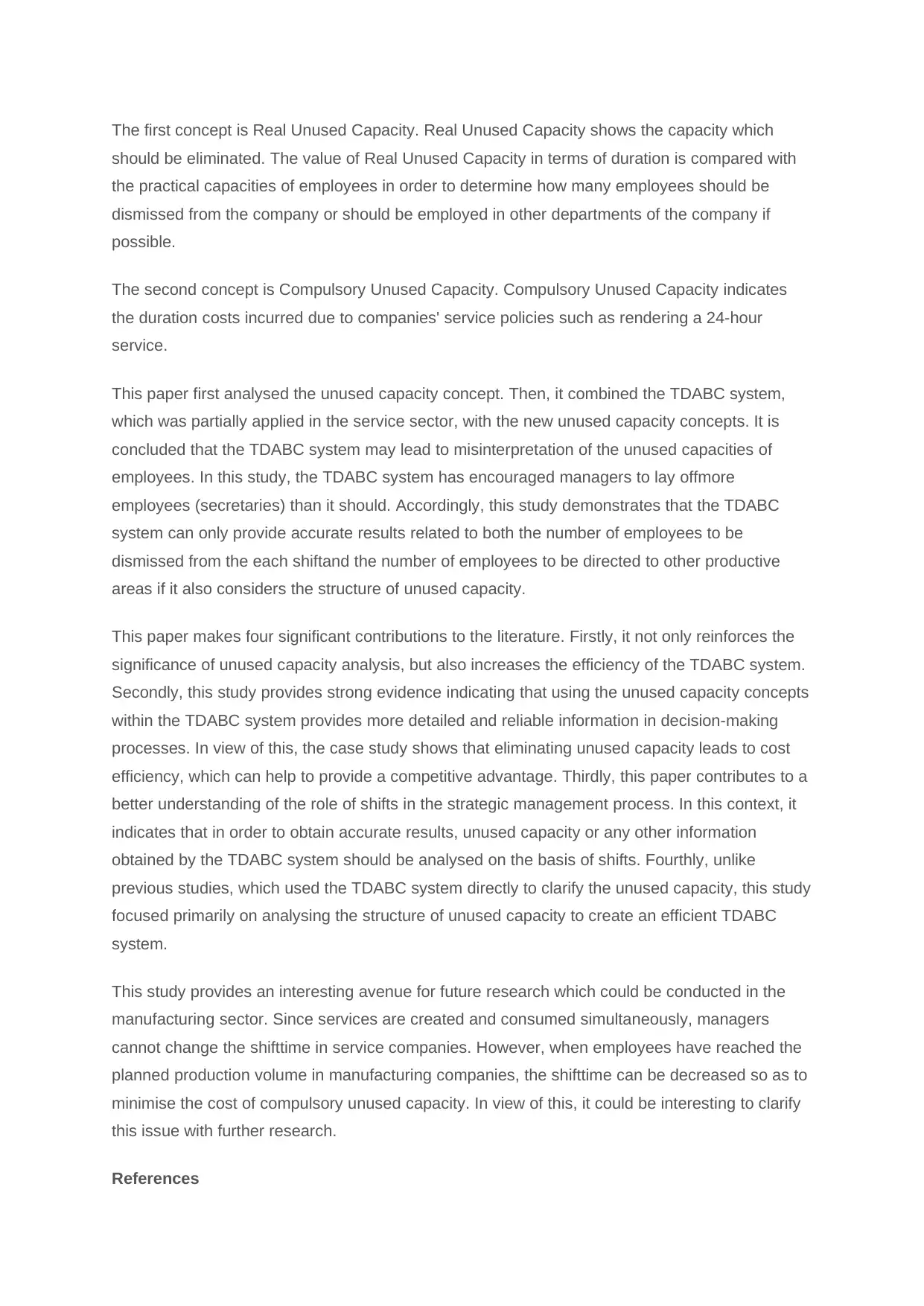
The first concept is Real Unused Capacity. Real Unused Capacity shows the capacity which
should be eliminated. The value of Real Unused Capacity in terms of duration is compared with
the practical capacities of employees in order to determine how many employees should be
dismissed from the company or should be employed in other departments of the company if
possible.
The second concept is Compulsory Unused Capacity. Compulsory Unused Capacity indicates
the duration costs incurred due to companies' service policies such as rendering a 24-hour
service.
This paper first analysed the unused capacity concept. Then, it combined the TDABC system,
which was partially applied in the service sector, with the new unused capacity concepts. It is
concluded that the TDABC system may lead to misinterpretation of the unused capacities of
employees. In this study, the TDABC system has encouraged managers to lay offmore
employees (secretaries) than it should. Accordingly, this study demonstrates that the TDABC
system can only provide accurate results related to both the number of employees to be
dismissed from the each shiftand the number of employees to be directed to other productive
areas if it also considers the structure of unused capacity.
This paper makes four significant contributions to the literature. Firstly, it not only reinforces the
significance of unused capacity analysis, but also increases the efficiency of the TDABC system.
Secondly, this study provides strong evidence indicating that using the unused capacity concepts
within the TDABC system provides more detailed and reliable information in decision-making
processes. In view of this, the case study shows that eliminating unused capacity leads to cost
efficiency, which can help to provide a competitive advantage. Thirdly, this paper contributes to a
better understanding of the role of shifts in the strategic management process. In this context, it
indicates that in order to obtain accurate results, unused capacity or any other information
obtained by the TDABC system should be analysed on the basis of shifts. Fourthly, unlike
previous studies, which used the TDABC system directly to clarify the unused capacity, this study
focused primarily on analysing the structure of unused capacity to create an efficient TDABC
system.
This study provides an interesting avenue for future research which could be conducted in the
manufacturing sector. Since services are created and consumed simultaneously, managers
cannot change the shifttime in service companies. However, when employees have reached the
planned production volume in manufacturing companies, the shifttime can be decreased so as to
minimise the cost of compulsory unused capacity. In view of this, it could be interesting to clarify
this issue with further research.
References
should be eliminated. The value of Real Unused Capacity in terms of duration is compared with
the practical capacities of employees in order to determine how many employees should be
dismissed from the company or should be employed in other departments of the company if
possible.
The second concept is Compulsory Unused Capacity. Compulsory Unused Capacity indicates
the duration costs incurred due to companies' service policies such as rendering a 24-hour
service.
This paper first analysed the unused capacity concept. Then, it combined the TDABC system,
which was partially applied in the service sector, with the new unused capacity concepts. It is
concluded that the TDABC system may lead to misinterpretation of the unused capacities of
employees. In this study, the TDABC system has encouraged managers to lay offmore
employees (secretaries) than it should. Accordingly, this study demonstrates that the TDABC
system can only provide accurate results related to both the number of employees to be
dismissed from the each shiftand the number of employees to be directed to other productive
areas if it also considers the structure of unused capacity.
This paper makes four significant contributions to the literature. Firstly, it not only reinforces the
significance of unused capacity analysis, but also increases the efficiency of the TDABC system.
Secondly, this study provides strong evidence indicating that using the unused capacity concepts
within the TDABC system provides more detailed and reliable information in decision-making
processes. In view of this, the case study shows that eliminating unused capacity leads to cost
efficiency, which can help to provide a competitive advantage. Thirdly, this paper contributes to a
better understanding of the role of shifts in the strategic management process. In this context, it
indicates that in order to obtain accurate results, unused capacity or any other information
obtained by the TDABC system should be analysed on the basis of shifts. Fourthly, unlike
previous studies, which used the TDABC system directly to clarify the unused capacity, this study
focused primarily on analysing the structure of unused capacity to create an efficient TDABC
system.
This study provides an interesting avenue for future research which could be conducted in the
manufacturing sector. Since services are created and consumed simultaneously, managers
cannot change the shifttime in service companies. However, when employees have reached the
planned production volume in manufacturing companies, the shifttime can be decreased so as to
minimise the cost of compulsory unused capacity. In view of this, it could be interesting to clarify
this issue with further research.
References
Secure Best Marks with AI Grader
Need help grading? Try our AI Grader for instant feedback on your assignments.
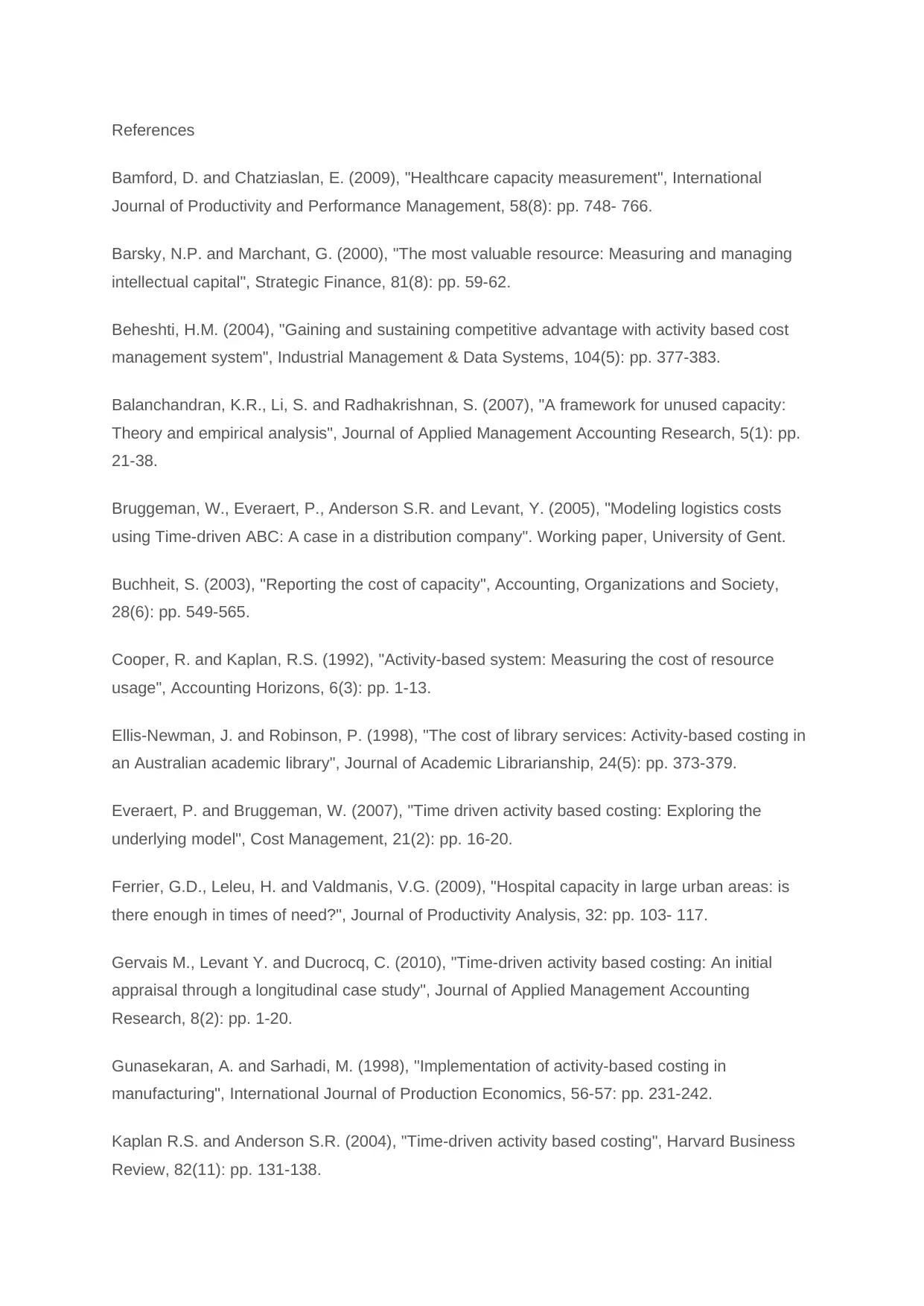
References
Bamford, D. and Chatziaslan, E. (2009), "Healthcare capacity measurement", International
Journal of Productivity and Performance Management, 58(8): pp. 748- 766.
Barsky, N.P. and Marchant, G. (2000), "The most valuable resource: Measuring and managing
intellectual capital", Strategic Finance, 81(8): pp. 59-62.
Beheshti, H.M. (2004), "Gaining and sustaining competitive advantage with activity based cost
management system", Industrial Management & Data Systems, 104(5): pp. 377-383.
Balanchandran, K.R., Li, S. and Radhakrishnan, S. (2007), "A framework for unused capacity:
Theory and empirical analysis", Journal of Applied Management Accounting Research, 5(1): pp.
21-38.
Bruggeman, W., Everaert, P., Anderson S.R. and Levant, Y. (2005), "Modeling logistics costs
using Time-driven ABC: A case in a distribution company". Working paper, University of Gent.
Buchheit, S. (2003), "Reporting the cost of capacity", Accounting, Organizations and Society,
28(6): pp. 549-565.
Cooper, R. and Kaplan, R.S. (1992), "Activity-based system: Measuring the cost of resource
usage", Accounting Horizons, 6(3): pp. 1-13.
Ellis-Newman, J. and Robinson, P. (1998), "The cost of library services: Activity-based costing in
an Australian academic library", Journal of Academic Librarianship, 24(5): pp. 373-379.
Everaert, P. and Bruggeman, W. (2007), "Time driven activity based costing: Exploring the
underlying model", Cost Management, 21(2): pp. 16-20.
Ferrier, G.D., Leleu, H. and Valdmanis, V.G. (2009), "Hospital capacity in large urban areas: is
there enough in times of need?", Journal of Productivity Analysis, 32: pp. 103- 117.
Gervais M., Levant Y. and Ducrocq, C. (2010), "Time-driven activity based costing: An initial
appraisal through a longitudinal case study", Journal of Applied Management Accounting
Research, 8(2): pp. 1-20.
Gunasekaran, A. and Sarhadi, M. (1998), "Implementation of activity-based costing in
manufacturing", International Journal of Production Economics, 56-57: pp. 231-242.
Kaplan R.S. and Anderson S.R. (2004), "Time-driven activity based costing", Harvard Business
Review, 82(11): pp. 131-138.
Bamford, D. and Chatziaslan, E. (2009), "Healthcare capacity measurement", International
Journal of Productivity and Performance Management, 58(8): pp. 748- 766.
Barsky, N.P. and Marchant, G. (2000), "The most valuable resource: Measuring and managing
intellectual capital", Strategic Finance, 81(8): pp. 59-62.
Beheshti, H.M. (2004), "Gaining and sustaining competitive advantage with activity based cost
management system", Industrial Management & Data Systems, 104(5): pp. 377-383.
Balanchandran, K.R., Li, S. and Radhakrishnan, S. (2007), "A framework for unused capacity:
Theory and empirical analysis", Journal of Applied Management Accounting Research, 5(1): pp.
21-38.
Bruggeman, W., Everaert, P., Anderson S.R. and Levant, Y. (2005), "Modeling logistics costs
using Time-driven ABC: A case in a distribution company". Working paper, University of Gent.
Buchheit, S. (2003), "Reporting the cost of capacity", Accounting, Organizations and Society,
28(6): pp. 549-565.
Cooper, R. and Kaplan, R.S. (1992), "Activity-based system: Measuring the cost of resource
usage", Accounting Horizons, 6(3): pp. 1-13.
Ellis-Newman, J. and Robinson, P. (1998), "The cost of library services: Activity-based costing in
an Australian academic library", Journal of Academic Librarianship, 24(5): pp. 373-379.
Everaert, P. and Bruggeman, W. (2007), "Time driven activity based costing: Exploring the
underlying model", Cost Management, 21(2): pp. 16-20.
Ferrier, G.D., Leleu, H. and Valdmanis, V.G. (2009), "Hospital capacity in large urban areas: is
there enough in times of need?", Journal of Productivity Analysis, 32: pp. 103- 117.
Gervais M., Levant Y. and Ducrocq, C. (2010), "Time-driven activity based costing: An initial
appraisal through a longitudinal case study", Journal of Applied Management Accounting
Research, 8(2): pp. 1-20.
Gunasekaran, A. and Sarhadi, M. (1998), "Implementation of activity-based costing in
manufacturing", International Journal of Production Economics, 56-57: pp. 231-242.
Kaplan R.S. and Anderson S.R. (2004), "Time-driven activity based costing", Harvard Business
Review, 82(11): pp. 131-138.
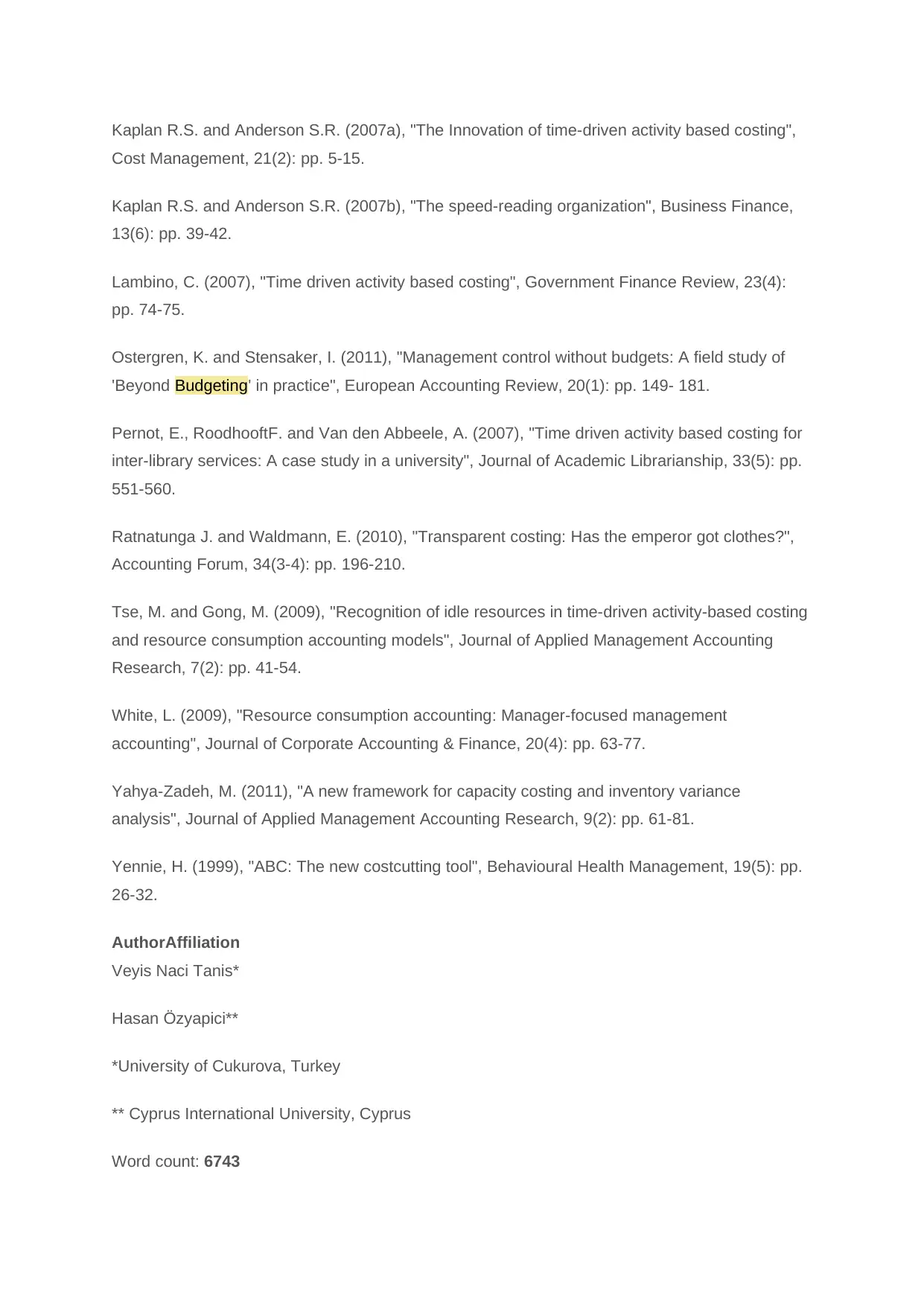
Kaplan R.S. and Anderson S.R. (2007a), "The Innovation of time-driven activity based costing",
Cost Management, 21(2): pp. 5-15.
Kaplan R.S. and Anderson S.R. (2007b), "The speed-reading organization", Business Finance,
13(6): pp. 39-42.
Lambino, C. (2007), "Time driven activity based costing", Government Finance Review, 23(4):
pp. 74-75.
Ostergren, K. and Stensaker, I. (2011), "Management control without budgets: A field study of
'Beyond Budgeting' in practice", European Accounting Review, 20(1): pp. 149- 181.
Pernot, E., RoodhooftF. and Van den Abbeele, A. (2007), "Time driven activity based costing for
inter-library services: A case study in a university", Journal of Academic Librarianship, 33(5): pp.
551-560.
Ratnatunga J. and Waldmann, E. (2010), "Transparent costing: Has the emperor got clothes?",
Accounting Forum, 34(3-4): pp. 196-210.
Tse, M. and Gong, M. (2009), "Recognition of idle resources in time-driven activity-based costing
and resource consumption accounting models", Journal of Applied Management Accounting
Research, 7(2): pp. 41-54.
White, L. (2009), "Resource consumption accounting: Manager-focused management
accounting", Journal of Corporate Accounting & Finance, 20(4): pp. 63-77.
Yahya-Zadeh, M. (2011), "A new framework for capacity costing and inventory variance
analysis", Journal of Applied Management Accounting Research, 9(2): pp. 61-81.
Yennie, H. (1999), "ABC: The new costcutting tool", Behavioural Health Management, 19(5): pp.
26-32.
AuthorAffiliation
Veyis Naci Tanis*
Hasan Özyapici**
*University of Cukurova, Turkey
** Cyprus International University, Cyprus
Word count: 6743
Cost Management, 21(2): pp. 5-15.
Kaplan R.S. and Anderson S.R. (2007b), "The speed-reading organization", Business Finance,
13(6): pp. 39-42.
Lambino, C. (2007), "Time driven activity based costing", Government Finance Review, 23(4):
pp. 74-75.
Ostergren, K. and Stensaker, I. (2011), "Management control without budgets: A field study of
'Beyond Budgeting' in practice", European Accounting Review, 20(1): pp. 149- 181.
Pernot, E., RoodhooftF. and Van den Abbeele, A. (2007), "Time driven activity based costing for
inter-library services: A case study in a university", Journal of Academic Librarianship, 33(5): pp.
551-560.
Ratnatunga J. and Waldmann, E. (2010), "Transparent costing: Has the emperor got clothes?",
Accounting Forum, 34(3-4): pp. 196-210.
Tse, M. and Gong, M. (2009), "Recognition of idle resources in time-driven activity-based costing
and resource consumption accounting models", Journal of Applied Management Accounting
Research, 7(2): pp. 41-54.
White, L. (2009), "Resource consumption accounting: Manager-focused management
accounting", Journal of Corporate Accounting & Finance, 20(4): pp. 63-77.
Yahya-Zadeh, M. (2011), "A new framework for capacity costing and inventory variance
analysis", Journal of Applied Management Accounting Research, 9(2): pp. 61-81.
Yennie, H. (1999), "ABC: The new costcutting tool", Behavioural Health Management, 19(5): pp.
26-32.
AuthorAffiliation
Veyis Naci Tanis*
Hasan Özyapici**
*University of Cukurova, Turkey
** Cyprus International University, Cyprus
Word count: 6743
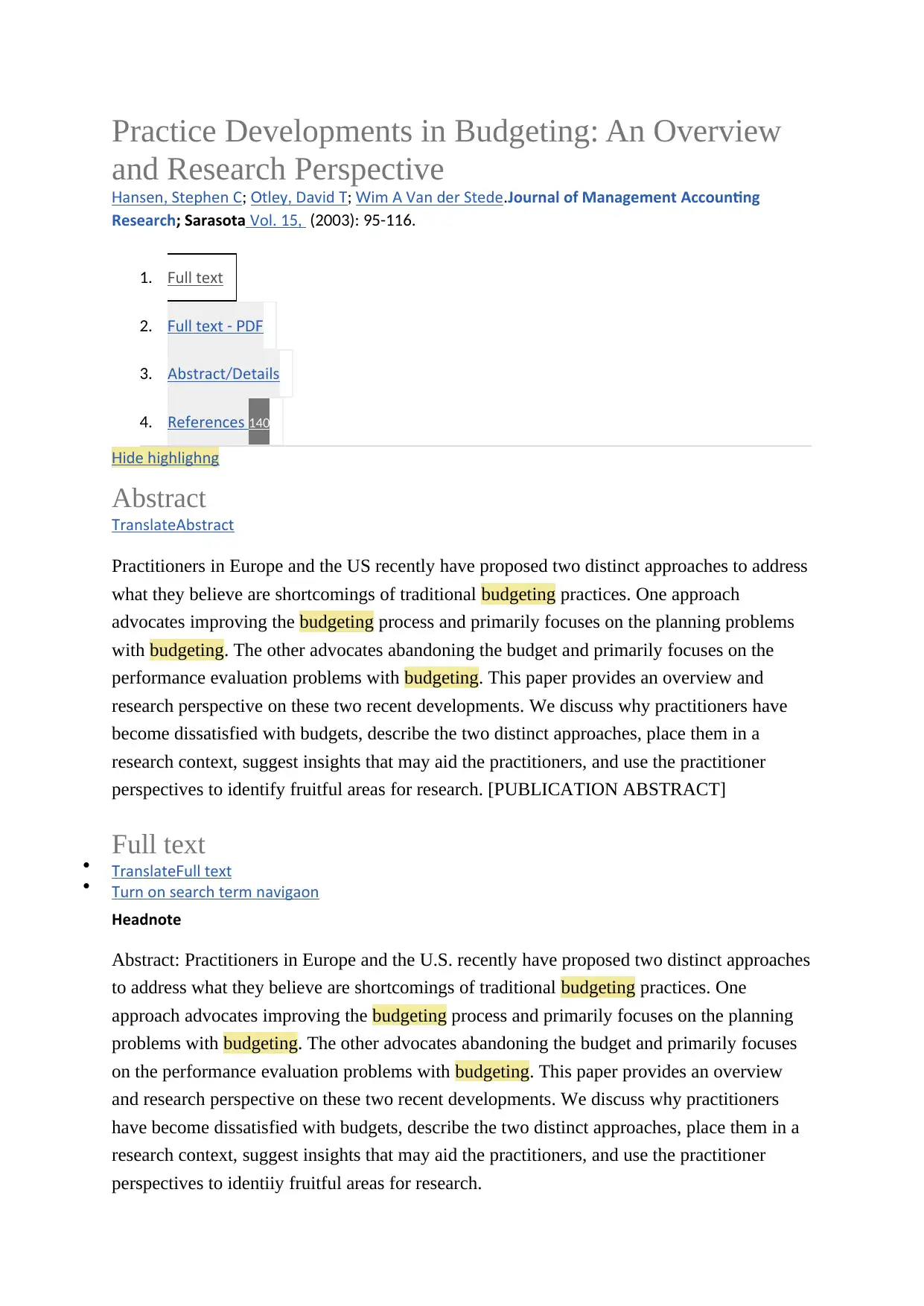
Practice Developments in Budgeting: An Overview
and Research Perspective
ansen Stephen CH , ; tley DavidO , T; im A Van der StedeW .Journal of Management Accounting
Research; Sarasota Vol. 15, (2003): 95-116.
1. ull te tF x
2. ull te t DF x - P F
3. Abstract Details/
4. References 140
ide highlightingH
Abstract
ranslateT Abstract
Practitioners in Europe and the US recently have proposed two distinct approaches to address
what they believe are shortcomings of traditional budgeting practices. One approach
advocates improving the budgeting process and primarily focuses on the planning problems
with budgeting. The other advocates abandoning the budget and primarily focuses on the
performance evaluation problems with budgeting. This paper provides an overview and
research perspective on these two recent developments. We discuss why practitioners have
become dissatisfied with budgets, describe the two distinct approaches, place them in a
research context, suggest insights that may aid the practitioners, and use the practitioner
perspectives to identify fruitful areas for research. [PUBLICATION ABSTRACT]
Full text
ranslateT ull te tF x
urn on search term navigationT
Headnote
Abstract: Practitioners in Europe and the U.S. recently have proposed two distinct approaches
to address what they believe are shortcomings of traditional budgeting practices. One
approach advocates improving the budgeting process and primarily focuses on the planning
problems with budgeting. The other advocates abandoning the budget and primarily focuses
on the performance evaluation problems with budgeting. This paper provides an overview
and research perspective on these two recent developments. We discuss why practitioners
have become dissatisfied with budgets, describe the two distinct approaches, place them in a
research context, suggest insights that may aid the practitioners, and use the practitioner
perspectives to identiiy fruitful areas for research.
and Research Perspective
ansen Stephen CH , ; tley DavidO , T; im A Van der StedeW .Journal of Management Accounting
Research; Sarasota Vol. 15, (2003): 95-116.
1. ull te tF x
2. ull te t DF x - P F
3. Abstract Details/
4. References 140
ide highlightingH
Abstract
ranslateT Abstract
Practitioners in Europe and the US recently have proposed two distinct approaches to address
what they believe are shortcomings of traditional budgeting practices. One approach
advocates improving the budgeting process and primarily focuses on the planning problems
with budgeting. The other advocates abandoning the budget and primarily focuses on the
performance evaluation problems with budgeting. This paper provides an overview and
research perspective on these two recent developments. We discuss why practitioners have
become dissatisfied with budgets, describe the two distinct approaches, place them in a
research context, suggest insights that may aid the practitioners, and use the practitioner
perspectives to identify fruitful areas for research. [PUBLICATION ABSTRACT]
Full text
ranslateT ull te tF x
urn on search term navigationT
Headnote
Abstract: Practitioners in Europe and the U.S. recently have proposed two distinct approaches
to address what they believe are shortcomings of traditional budgeting practices. One
approach advocates improving the budgeting process and primarily focuses on the planning
problems with budgeting. The other advocates abandoning the budget and primarily focuses
on the performance evaluation problems with budgeting. This paper provides an overview
and research perspective on these two recent developments. We discuss why practitioners
have become dissatisfied with budgets, describe the two distinct approaches, place them in a
research context, suggest insights that may aid the practitioners, and use the practitioner
perspectives to identiiy fruitful areas for research.
Paraphrase This Document
Need a fresh take? Get an instant paraphrase of this document with our AI Paraphraser
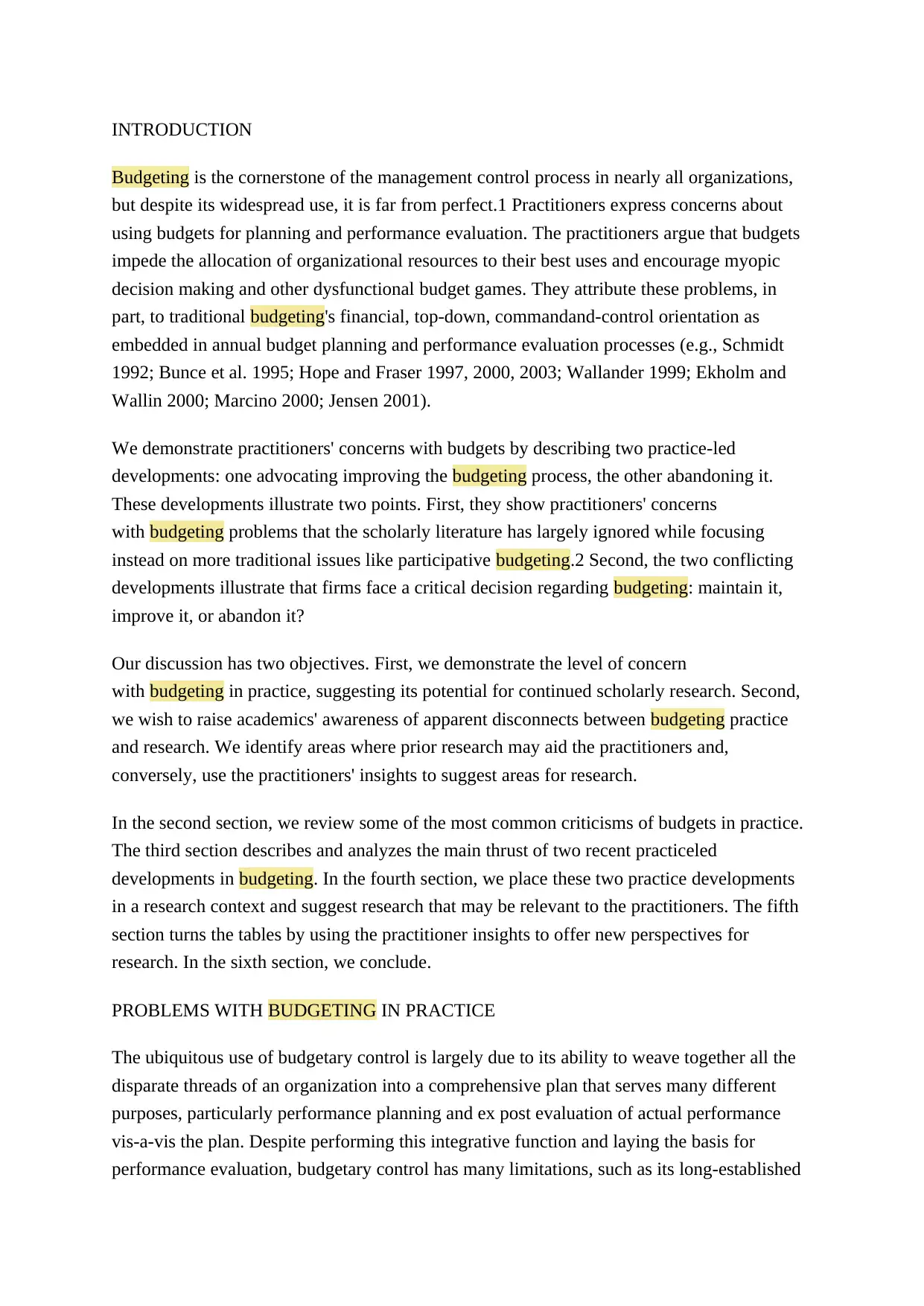
INTRODUCTION
Budgeting is the cornerstone of the management control process in nearly all organizations,
but despite its widespread use, it is far from perfect.1 Practitioners express concerns about
using budgets for planning and performance evaluation. The practitioners argue that budgets
impede the allocation of organizational resources to their best uses and encourage myopic
decision making and other dysfunctional budget games. They attribute these problems, in
part, to traditional budgeting's financial, top-down, commandand-control orientation as
embedded in annual budget planning and performance evaluation processes (e.g., Schmidt
1992; Bunce et al. 1995; Hope and Fraser 1997, 2000, 2003; Wallander 1999; Ekholm and
Wallin 2000; Marcino 2000; Jensen 2001).
We demonstrate practitioners' concerns with budgets by describing two practice-led
developments: one advocating improving the budgeting process, the other abandoning it.
These developments illustrate two points. First, they show practitioners' concerns
with budgeting problems that the scholarly literature has largely ignored while focusing
instead on more traditional issues like participative budgeting.2 Second, the two conflicting
developments illustrate that firms face a critical decision regarding budgeting: maintain it,
improve it, or abandon it?
Our discussion has two objectives. First, we demonstrate the level of concern
with budgeting in practice, suggesting its potential for continued scholarly research. Second,
we wish to raise academics' awareness of apparent disconnects between budgeting practice
and research. We identify areas where prior research may aid the practitioners and,
conversely, use the practitioners' insights to suggest areas for research.
In the second section, we review some of the most common criticisms of budgets in practice.
The third section describes and analyzes the main thrust of two recent practiceled
developments in budgeting. In the fourth section, we place these two practice developments
in a research context and suggest research that may be relevant to the practitioners. The fifth
section turns the tables by using the practitioner insights to offer new perspectives for
research. In the sixth section, we conclude.
PROBLEMS WITH BUDGETING IN PRACTICE
The ubiquitous use of budgetary control is largely due to its ability to weave together all the
disparate threads of an organization into a comprehensive plan that serves many different
purposes, particularly performance planning and ex post evaluation of actual performance
vis-a-vis the plan. Despite performing this integrative function and laying the basis for
performance evaluation, budgetary control has many limitations, such as its long-established
Budgeting is the cornerstone of the management control process in nearly all organizations,
but despite its widespread use, it is far from perfect.1 Practitioners express concerns about
using budgets for planning and performance evaluation. The practitioners argue that budgets
impede the allocation of organizational resources to their best uses and encourage myopic
decision making and other dysfunctional budget games. They attribute these problems, in
part, to traditional budgeting's financial, top-down, commandand-control orientation as
embedded in annual budget planning and performance evaluation processes (e.g., Schmidt
1992; Bunce et al. 1995; Hope and Fraser 1997, 2000, 2003; Wallander 1999; Ekholm and
Wallin 2000; Marcino 2000; Jensen 2001).
We demonstrate practitioners' concerns with budgets by describing two practice-led
developments: one advocating improving the budgeting process, the other abandoning it.
These developments illustrate two points. First, they show practitioners' concerns
with budgeting problems that the scholarly literature has largely ignored while focusing
instead on more traditional issues like participative budgeting.2 Second, the two conflicting
developments illustrate that firms face a critical decision regarding budgeting: maintain it,
improve it, or abandon it?
Our discussion has two objectives. First, we demonstrate the level of concern
with budgeting in practice, suggesting its potential for continued scholarly research. Second,
we wish to raise academics' awareness of apparent disconnects between budgeting practice
and research. We identify areas where prior research may aid the practitioners and,
conversely, use the practitioners' insights to suggest areas for research.
In the second section, we review some of the most common criticisms of budgets in practice.
The third section describes and analyzes the main thrust of two recent practiceled
developments in budgeting. In the fourth section, we place these two practice developments
in a research context and suggest research that may be relevant to the practitioners. The fifth
section turns the tables by using the practitioner insights to offer new perspectives for
research. In the sixth section, we conclude.
PROBLEMS WITH BUDGETING IN PRACTICE
The ubiquitous use of budgetary control is largely due to its ability to weave together all the
disparate threads of an organization into a comprehensive plan that serves many different
purposes, particularly performance planning and ex post evaluation of actual performance
vis-a-vis the plan. Despite performing this integrative function and laying the basis for
performance evaluation, budgetary control has many limitations, such as its long-established

and oft-researched susceptibility to induce budget games or dysfunctional behaviors
(Hofstede 1967; Onsi 1973; Merchant 1985b; Lukka 1988).
A recent report by Neely et al. (2001), drawn primarily from the practitioner literature, lists
the 12 most cited weaknesses of budgetary control as:
1. Budgets are time-consuming to put together;
2. Budgets constrain responsiveness and are often a barrier to change;
3. Budgets are rarely strategically focused and often contradictory;
4. Budgets add little value, especially given the time required to prepare them;
5. Budgets concentrate on cost reduction and not value creation;
6. Budgets strengthen vertical command-and-control;
7. Budgets do not reflect the emerging network structures that organizations are adopting;
8. Budgets encourage gaming and perverse behaviors;
9. Budgets are developed and updated too infrequently, usually annually;
10. Budgets are based on unsupported assumptions and guesswork;
11. Budgets reinforce departmental barriers rather than encourage knowledge sharing; and
12. Budgets make people feel undervalued.
While not all would agree with these criticisms, other recent critiques (e.g., Schmidt 1992;
Hope and Fraser 1997, 2000, 2003; Ekholm and Wallin 2000; Marcino 2000; Jensen 2001)
also support the perception of widespread dissatisfaction with budgeting in practice. We
synthesize the sources of dissatisfaction as follows.
Claims 1, 4, 9, and 10 relate to the recurring criticism that by the time budgets are used, their
assumptions are typically outdated, reducing the value of the budgeting process. A more
radical version of this criticism is that conventional budgets can never be valid because they
cannot capture the uncertainty involved in rapidly changing environments (Wallender 1999).
In more conceptual terms, the operation of a useful budgetary control system requires two
related elements. First, there must be a high degree of operational stability so that the budget
provides a valid plan for a reasonable period of time (typically the next year). Second,
managers must have good predictive models so that the budget provides a reasonable
(Hofstede 1967; Onsi 1973; Merchant 1985b; Lukka 1988).
A recent report by Neely et al. (2001), drawn primarily from the practitioner literature, lists
the 12 most cited weaknesses of budgetary control as:
1. Budgets are time-consuming to put together;
2. Budgets constrain responsiveness and are often a barrier to change;
3. Budgets are rarely strategically focused and often contradictory;
4. Budgets add little value, especially given the time required to prepare them;
5. Budgets concentrate on cost reduction and not value creation;
6. Budgets strengthen vertical command-and-control;
7. Budgets do not reflect the emerging network structures that organizations are adopting;
8. Budgets encourage gaming and perverse behaviors;
9. Budgets are developed and updated too infrequently, usually annually;
10. Budgets are based on unsupported assumptions and guesswork;
11. Budgets reinforce departmental barriers rather than encourage knowledge sharing; and
12. Budgets make people feel undervalued.
While not all would agree with these criticisms, other recent critiques (e.g., Schmidt 1992;
Hope and Fraser 1997, 2000, 2003; Ekholm and Wallin 2000; Marcino 2000; Jensen 2001)
also support the perception of widespread dissatisfaction with budgeting in practice. We
synthesize the sources of dissatisfaction as follows.
Claims 1, 4, 9, and 10 relate to the recurring criticism that by the time budgets are used, their
assumptions are typically outdated, reducing the value of the budgeting process. A more
radical version of this criticism is that conventional budgets can never be valid because they
cannot capture the uncertainty involved in rapidly changing environments (Wallender 1999).
In more conceptual terms, the operation of a useful budgetary control system requires two
related elements. First, there must be a high degree of operational stability so that the budget
provides a valid plan for a reasonable period of time (typically the next year). Second,
managers must have good predictive models so that the budget provides a reasonable
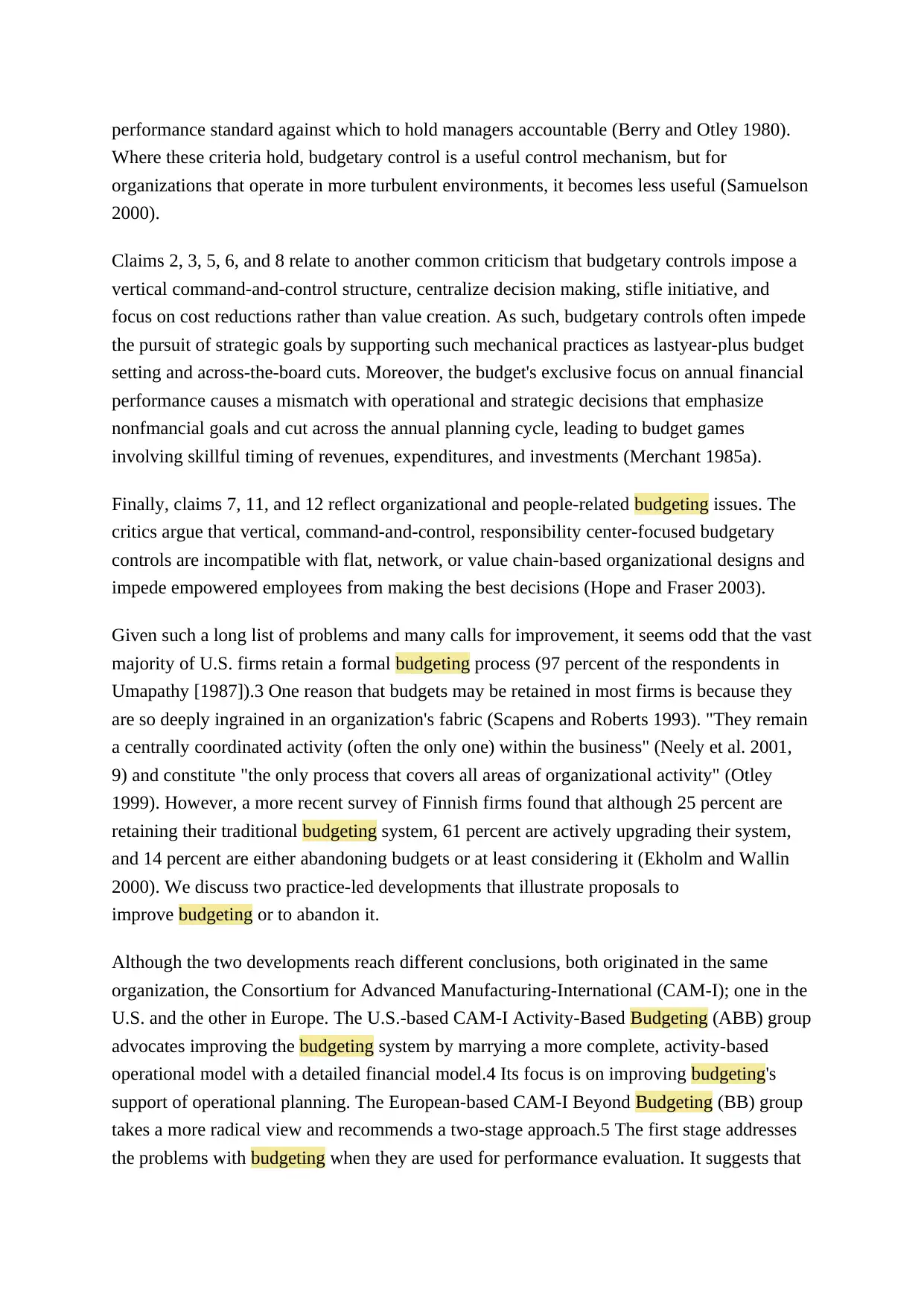
performance standard against which to hold managers accountable (Berry and Otley 1980).
Where these criteria hold, budgetary control is a useful control mechanism, but for
organizations that operate in more turbulent environments, it becomes less useful (Samuelson
2000).
Claims 2, 3, 5, 6, and 8 relate to another common criticism that budgetary controls impose a
vertical command-and-control structure, centralize decision making, stifle initiative, and
focus on cost reductions rather than value creation. As such, budgetary controls often impede
the pursuit of strategic goals by supporting such mechanical practices as lastyear-plus budget
setting and across-the-board cuts. Moreover, the budget's exclusive focus on annual financial
performance causes a mismatch with operational and strategic decisions that emphasize
nonfmancial goals and cut across the annual planning cycle, leading to budget games
involving skillful timing of revenues, expenditures, and investments (Merchant 1985a).
Finally, claims 7, 11, and 12 reflect organizational and people-related budgeting issues. The
critics argue that vertical, command-and-control, responsibility center-focused budgetary
controls are incompatible with flat, network, or value chain-based organizational designs and
impede empowered employees from making the best decisions (Hope and Fraser 2003).
Given such a long list of problems and many calls for improvement, it seems odd that the vast
majority of U.S. firms retain a formal budgeting process (97 percent of the respondents in
Umapathy [1987]).3 One reason that budgets may be retained in most firms is because they
are so deeply ingrained in an organization's fabric (Scapens and Roberts 1993). "They remain
a centrally coordinated activity (often the only one) within the business" (Neely et al. 2001,
9) and constitute "the only process that covers all areas of organizational activity" (Otley
1999). However, a more recent survey of Finnish firms found that although 25 percent are
retaining their traditional budgeting system, 61 percent are actively upgrading their system,
and 14 percent are either abandoning budgets or at least considering it (Ekholm and Wallin
2000). We discuss two practice-led developments that illustrate proposals to
improve budgeting or to abandon it.
Although the two developments reach different conclusions, both originated in the same
organization, the Consortium for Advanced Manufacturing-International (CAM-I); one in the
U.S. and the other in Europe. The U.S.-based CAM-I Activity-Based Budgeting (ABB) group
advocates improving the budgeting system by marrying a more complete, activity-based
operational model with a detailed financial model.4 Its focus is on improving budgeting's
support of operational planning. The European-based CAM-I Beyond Budgeting (BB) group
takes a more radical view and recommends a two-stage approach.5 The first stage addresses
the problems with budgeting when they are used for performance evaluation. It suggests that
Where these criteria hold, budgetary control is a useful control mechanism, but for
organizations that operate in more turbulent environments, it becomes less useful (Samuelson
2000).
Claims 2, 3, 5, 6, and 8 relate to another common criticism that budgetary controls impose a
vertical command-and-control structure, centralize decision making, stifle initiative, and
focus on cost reductions rather than value creation. As such, budgetary controls often impede
the pursuit of strategic goals by supporting such mechanical practices as lastyear-plus budget
setting and across-the-board cuts. Moreover, the budget's exclusive focus on annual financial
performance causes a mismatch with operational and strategic decisions that emphasize
nonfmancial goals and cut across the annual planning cycle, leading to budget games
involving skillful timing of revenues, expenditures, and investments (Merchant 1985a).
Finally, claims 7, 11, and 12 reflect organizational and people-related budgeting issues. The
critics argue that vertical, command-and-control, responsibility center-focused budgetary
controls are incompatible with flat, network, or value chain-based organizational designs and
impede empowered employees from making the best decisions (Hope and Fraser 2003).
Given such a long list of problems and many calls for improvement, it seems odd that the vast
majority of U.S. firms retain a formal budgeting process (97 percent of the respondents in
Umapathy [1987]).3 One reason that budgets may be retained in most firms is because they
are so deeply ingrained in an organization's fabric (Scapens and Roberts 1993). "They remain
a centrally coordinated activity (often the only one) within the business" (Neely et al. 2001,
9) and constitute "the only process that covers all areas of organizational activity" (Otley
1999). However, a more recent survey of Finnish firms found that although 25 percent are
retaining their traditional budgeting system, 61 percent are actively upgrading their system,
and 14 percent are either abandoning budgets or at least considering it (Ekholm and Wallin
2000). We discuss two practice-led developments that illustrate proposals to
improve budgeting or to abandon it.
Although the two developments reach different conclusions, both originated in the same
organization, the Consortium for Advanced Manufacturing-International (CAM-I); one in the
U.S. and the other in Europe. The U.S.-based CAM-I Activity-Based Budgeting (ABB) group
advocates improving the budgeting system by marrying a more complete, activity-based
operational model with a detailed financial model.4 Its focus is on improving budgeting's
support of operational planning. The European-based CAM-I Beyond Budgeting (BB) group
takes a more radical view and recommends a two-stage approach.5 The first stage addresses
the problems with budgeting when they are used for performance evaluation. It suggests that
Secure Best Marks with AI Grader
Need help grading? Try our AI Grader for instant feedback on your assignments.
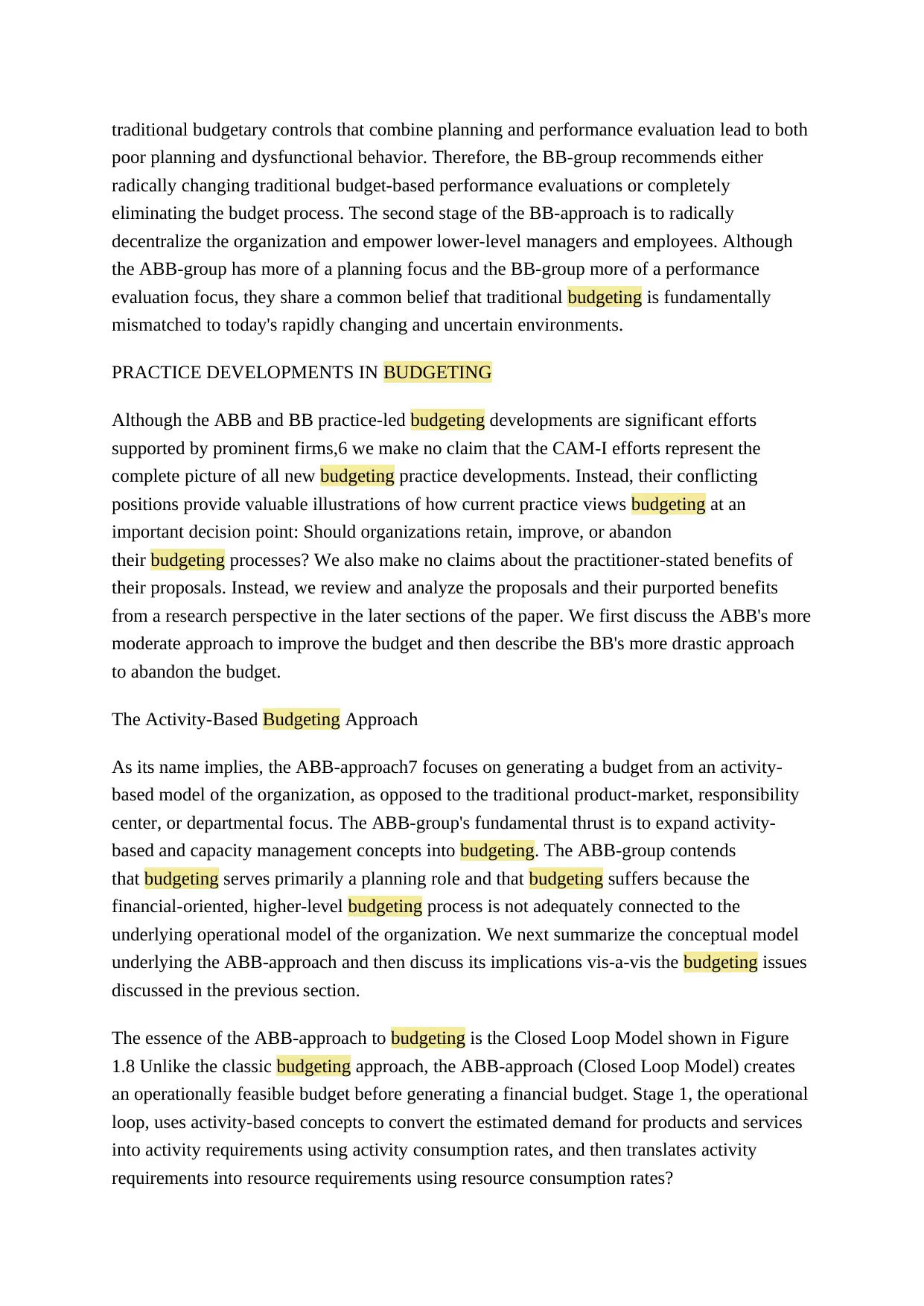
traditional budgetary controls that combine planning and performance evaluation lead to both
poor planning and dysfunctional behavior. Therefore, the BB-group recommends either
radically changing traditional budget-based performance evaluations or completely
eliminating the budget process. The second stage of the BB-approach is to radically
decentralize the organization and empower lower-level managers and employees. Although
the ABB-group has more of a planning focus and the BB-group more of a performance
evaluation focus, they share a common belief that traditional budgeting is fundamentally
mismatched to today's rapidly changing and uncertain environments.
PRACTICE DEVELOPMENTS IN BUDGETING
Although the ABB and BB practice-led budgeting developments are significant efforts
supported by prominent firms,6 we make no claim that the CAM-I efforts represent the
complete picture of all new budgeting practice developments. Instead, their conflicting
positions provide valuable illustrations of how current practice views budgeting at an
important decision point: Should organizations retain, improve, or abandon
their budgeting processes? We also make no claims about the practitioner-stated benefits of
their proposals. Instead, we review and analyze the proposals and their purported benefits
from a research perspective in the later sections of the paper. We first discuss the ABB's more
moderate approach to improve the budget and then describe the BB's more drastic approach
to abandon the budget.
The Activity-Based Budgeting Approach
As its name implies, the ABB-approach7 focuses on generating a budget from an activity-
based model of the organization, as opposed to the traditional product-market, responsibility
center, or departmental focus. The ABB-group's fundamental thrust is to expand activity-
based and capacity management concepts into budgeting. The ABB-group contends
that budgeting serves primarily a planning role and that budgeting suffers because the
financial-oriented, higher-level budgeting process is not adequately connected to the
underlying operational model of the organization. We next summarize the conceptual model
underlying the ABB-approach and then discuss its implications vis-a-vis the budgeting issues
discussed in the previous section.
The essence of the ABB-approach to budgeting is the Closed Loop Model shown in Figure
1.8 Unlike the classic budgeting approach, the ABB-approach (Closed Loop Model) creates
an operationally feasible budget before generating a financial budget. Stage 1, the operational
loop, uses activity-based concepts to convert the estimated demand for products and services
into activity requirements using activity consumption rates, and then translates activity
requirements into resource requirements using resource consumption rates?
poor planning and dysfunctional behavior. Therefore, the BB-group recommends either
radically changing traditional budget-based performance evaluations or completely
eliminating the budget process. The second stage of the BB-approach is to radically
decentralize the organization and empower lower-level managers and employees. Although
the ABB-group has more of a planning focus and the BB-group more of a performance
evaluation focus, they share a common belief that traditional budgeting is fundamentally
mismatched to today's rapidly changing and uncertain environments.
PRACTICE DEVELOPMENTS IN BUDGETING
Although the ABB and BB practice-led budgeting developments are significant efforts
supported by prominent firms,6 we make no claim that the CAM-I efforts represent the
complete picture of all new budgeting practice developments. Instead, their conflicting
positions provide valuable illustrations of how current practice views budgeting at an
important decision point: Should organizations retain, improve, or abandon
their budgeting processes? We also make no claims about the practitioner-stated benefits of
their proposals. Instead, we review and analyze the proposals and their purported benefits
from a research perspective in the later sections of the paper. We first discuss the ABB's more
moderate approach to improve the budget and then describe the BB's more drastic approach
to abandon the budget.
The Activity-Based Budgeting Approach
As its name implies, the ABB-approach7 focuses on generating a budget from an activity-
based model of the organization, as opposed to the traditional product-market, responsibility
center, or departmental focus. The ABB-group's fundamental thrust is to expand activity-
based and capacity management concepts into budgeting. The ABB-group contends
that budgeting serves primarily a planning role and that budgeting suffers because the
financial-oriented, higher-level budgeting process is not adequately connected to the
underlying operational model of the organization. We next summarize the conceptual model
underlying the ABB-approach and then discuss its implications vis-a-vis the budgeting issues
discussed in the previous section.
The essence of the ABB-approach to budgeting is the Closed Loop Model shown in Figure
1.8 Unlike the classic budgeting approach, the ABB-approach (Closed Loop Model) creates
an operationally feasible budget before generating a financial budget. Stage 1, the operational
loop, uses activity-based concepts to convert the estimated demand for products and services
into activity requirements using activity consumption rates, and then translates activity
requirements into resource requirements using resource consumption rates?
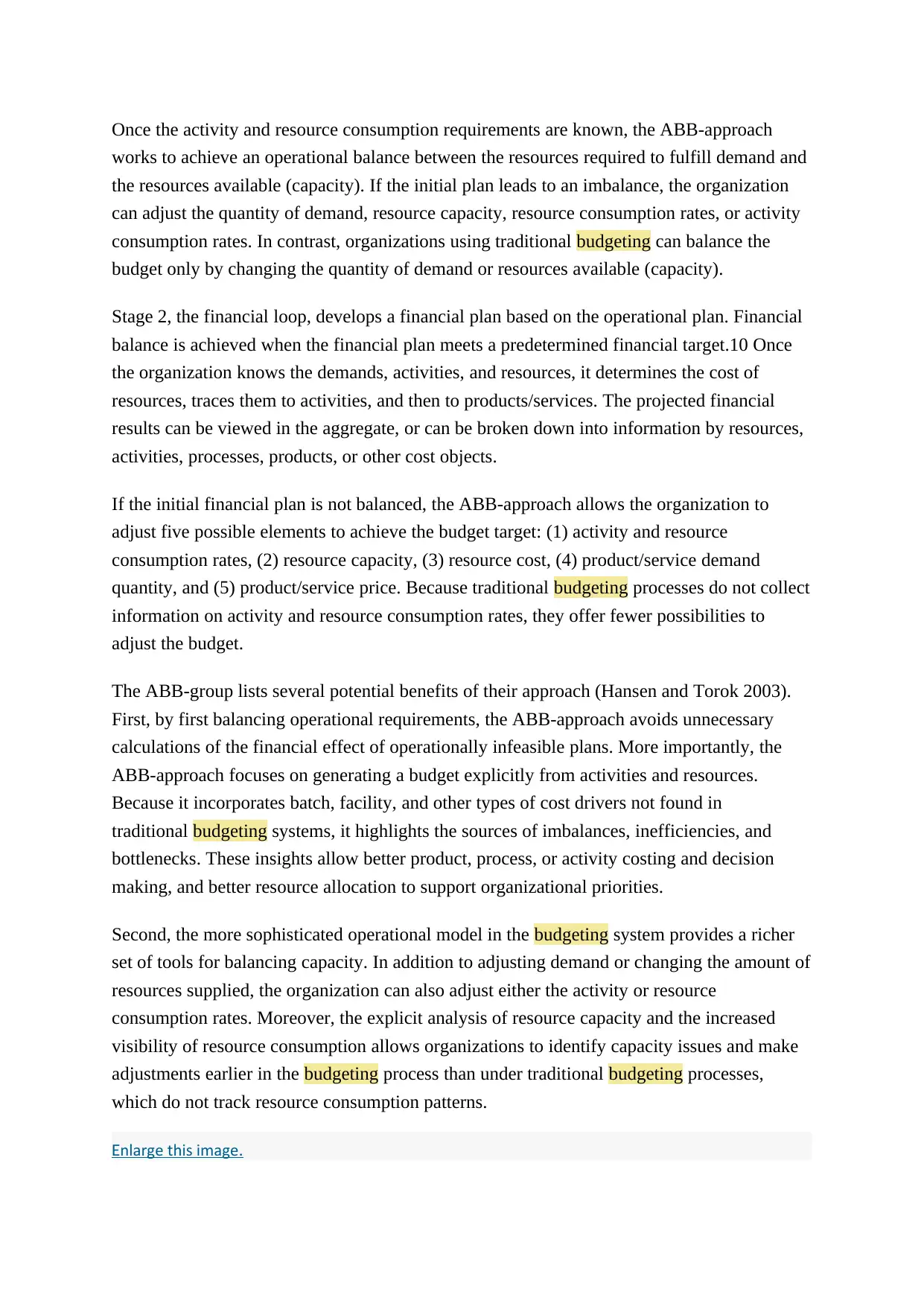
Once the activity and resource consumption requirements are known, the ABB-approach
works to achieve an operational balance between the resources required to fulfill demand and
the resources available (capacity). If the initial plan leads to an imbalance, the organization
can adjust the quantity of demand, resource capacity, resource consumption rates, or activity
consumption rates. In contrast, organizations using traditional budgeting can balance the
budget only by changing the quantity of demand or resources available (capacity).
Stage 2, the financial loop, develops a financial plan based on the operational plan. Financial
balance is achieved when the financial plan meets a predetermined financial target.10 Once
the organization knows the demands, activities, and resources, it determines the cost of
resources, traces them to activities, and then to products/services. The projected financial
results can be viewed in the aggregate, or can be broken down into information by resources,
activities, processes, products, or other cost objects.
If the initial financial plan is not balanced, the ABB-approach allows the organization to
adjust five possible elements to achieve the budget target: (1) activity and resource
consumption rates, (2) resource capacity, (3) resource cost, (4) product/service demand
quantity, and (5) product/service price. Because traditional budgeting processes do not collect
information on activity and resource consumption rates, they offer fewer possibilities to
adjust the budget.
The ABB-group lists several potential benefits of their approach (Hansen and Torok 2003).
First, by first balancing operational requirements, the ABB-approach avoids unnecessary
calculations of the financial effect of operationally infeasible plans. More importantly, the
ABB-approach focuses on generating a budget explicitly from activities and resources.
Because it incorporates batch, facility, and other types of cost drivers not found in
traditional budgeting systems, it highlights the sources of imbalances, inefficiencies, and
bottlenecks. These insights allow better product, process, or activity costing and decision
making, and better resource allocation to support organizational priorities.
Second, the more sophisticated operational model in the budgeting system provides a richer
set of tools for balancing capacity. In addition to adjusting demand or changing the amount of
resources supplied, the organization can also adjust either the activity or resource
consumption rates. Moreover, the explicit analysis of resource capacity and the increased
visibility of resource consumption allows organizations to identify capacity issues and make
adjustments earlier in the budgeting process than under traditional budgeting processes,
which do not track resource consumption patterns.
nlarge this imageE .
works to achieve an operational balance between the resources required to fulfill demand and
the resources available (capacity). If the initial plan leads to an imbalance, the organization
can adjust the quantity of demand, resource capacity, resource consumption rates, or activity
consumption rates. In contrast, organizations using traditional budgeting can balance the
budget only by changing the quantity of demand or resources available (capacity).
Stage 2, the financial loop, develops a financial plan based on the operational plan. Financial
balance is achieved when the financial plan meets a predetermined financial target.10 Once
the organization knows the demands, activities, and resources, it determines the cost of
resources, traces them to activities, and then to products/services. The projected financial
results can be viewed in the aggregate, or can be broken down into information by resources,
activities, processes, products, or other cost objects.
If the initial financial plan is not balanced, the ABB-approach allows the organization to
adjust five possible elements to achieve the budget target: (1) activity and resource
consumption rates, (2) resource capacity, (3) resource cost, (4) product/service demand
quantity, and (5) product/service price. Because traditional budgeting processes do not collect
information on activity and resource consumption rates, they offer fewer possibilities to
adjust the budget.
The ABB-group lists several potential benefits of their approach (Hansen and Torok 2003).
First, by first balancing operational requirements, the ABB-approach avoids unnecessary
calculations of the financial effect of operationally infeasible plans. More importantly, the
ABB-approach focuses on generating a budget explicitly from activities and resources.
Because it incorporates batch, facility, and other types of cost drivers not found in
traditional budgeting systems, it highlights the sources of imbalances, inefficiencies, and
bottlenecks. These insights allow better product, process, or activity costing and decision
making, and better resource allocation to support organizational priorities.
Second, the more sophisticated operational model in the budgeting system provides a richer
set of tools for balancing capacity. In addition to adjusting demand or changing the amount of
resources supplied, the organization can also adjust either the activity or resource
consumption rates. Moreover, the explicit analysis of resource capacity and the increased
visibility of resource consumption allows organizations to identify capacity issues and make
adjustments earlier in the budgeting process than under traditional budgeting processes,
which do not track resource consumption patterns.
nlarge this imageE .
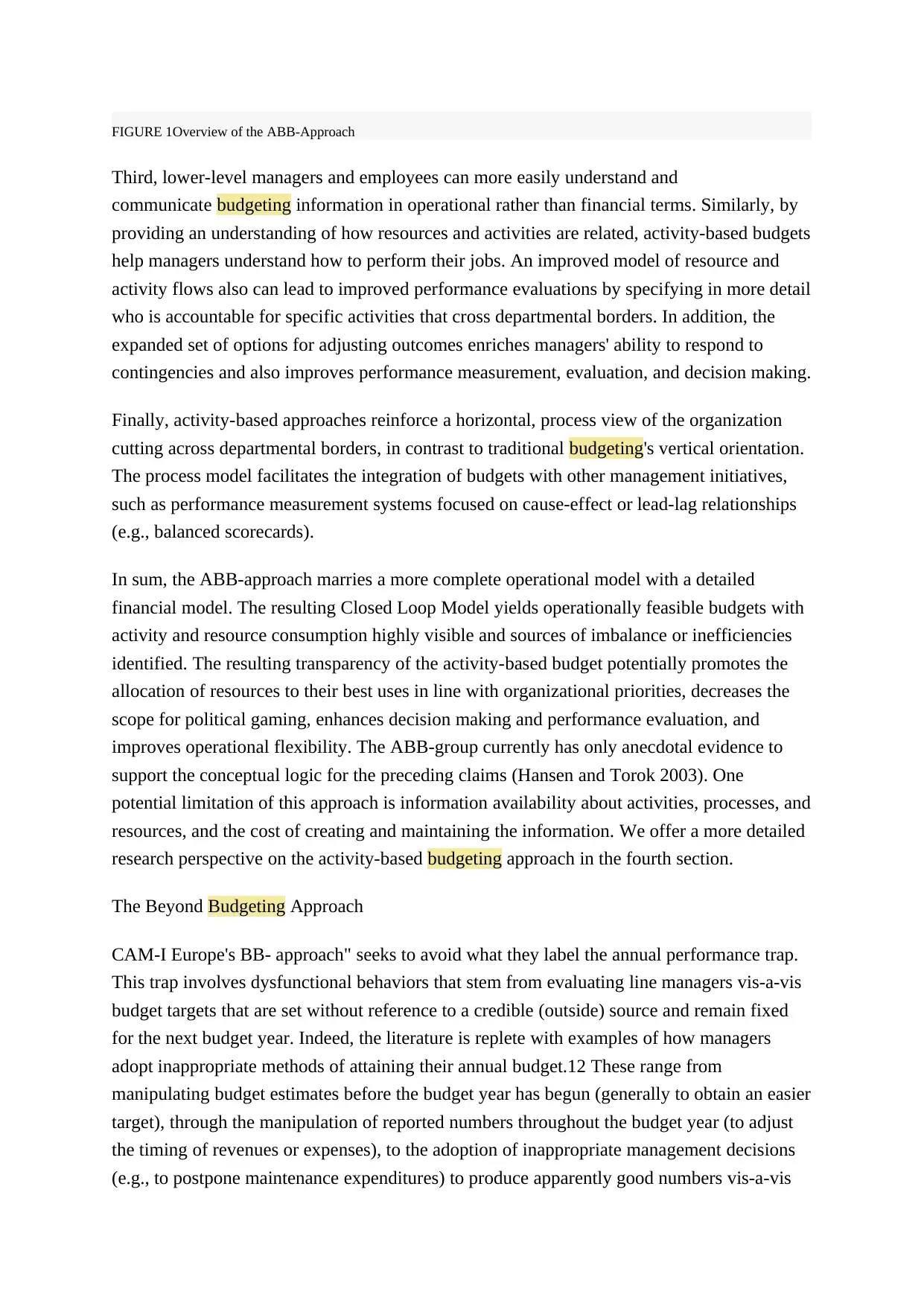
FIGURE 1Overview of the ABB-Approach
Third, lower-level managers and employees can more easily understand and
communicate budgeting information in operational rather than financial terms. Similarly, by
providing an understanding of how resources and activities are related, activity-based budgets
help managers understand how to perform their jobs. An improved model of resource and
activity flows also can lead to improved performance evaluations by specifying in more detail
who is accountable for specific activities that cross departmental borders. In addition, the
expanded set of options for adjusting outcomes enriches managers' ability to respond to
contingencies and also improves performance measurement, evaluation, and decision making.
Finally, activity-based approaches reinforce a horizontal, process view of the organization
cutting across departmental borders, in contrast to traditional budgeting's vertical orientation.
The process model facilitates the integration of budgets with other management initiatives,
such as performance measurement systems focused on cause-effect or lead-lag relationships
(e.g., balanced scorecards).
In sum, the ABB-approach marries a more complete operational model with a detailed
financial model. The resulting Closed Loop Model yields operationally feasible budgets with
activity and resource consumption highly visible and sources of imbalance or inefficiencies
identified. The resulting transparency of the activity-based budget potentially promotes the
allocation of resources to their best uses in line with organizational priorities, decreases the
scope for political gaming, enhances decision making and performance evaluation, and
improves operational flexibility. The ABB-group currently has only anecdotal evidence to
support the conceptual logic for the preceding claims (Hansen and Torok 2003). One
potential limitation of this approach is information availability about activities, processes, and
resources, and the cost of creating and maintaining the information. We offer a more detailed
research perspective on the activity-based budgeting approach in the fourth section.
The Beyond Budgeting Approach
CAM-I Europe's BB- approach" seeks to avoid what they label the annual performance trap.
This trap involves dysfunctional behaviors that stem from evaluating line managers vis-a-vis
budget targets that are set without reference to a credible (outside) source and remain fixed
for the next budget year. Indeed, the literature is replete with examples of how managers
adopt inappropriate methods of attaining their annual budget.12 These range from
manipulating budget estimates before the budget year has begun (generally to obtain an easier
target), through the manipulation of reported numbers throughout the budget year (to adjust
the timing of revenues or expenses), to the adoption of inappropriate management decisions
(e.g., to postpone maintenance expenditures) to produce apparently good numbers vis-a-vis
Third, lower-level managers and employees can more easily understand and
communicate budgeting information in operational rather than financial terms. Similarly, by
providing an understanding of how resources and activities are related, activity-based budgets
help managers understand how to perform their jobs. An improved model of resource and
activity flows also can lead to improved performance evaluations by specifying in more detail
who is accountable for specific activities that cross departmental borders. In addition, the
expanded set of options for adjusting outcomes enriches managers' ability to respond to
contingencies and also improves performance measurement, evaluation, and decision making.
Finally, activity-based approaches reinforce a horizontal, process view of the organization
cutting across departmental borders, in contrast to traditional budgeting's vertical orientation.
The process model facilitates the integration of budgets with other management initiatives,
such as performance measurement systems focused on cause-effect or lead-lag relationships
(e.g., balanced scorecards).
In sum, the ABB-approach marries a more complete operational model with a detailed
financial model. The resulting Closed Loop Model yields operationally feasible budgets with
activity and resource consumption highly visible and sources of imbalance or inefficiencies
identified. The resulting transparency of the activity-based budget potentially promotes the
allocation of resources to their best uses in line with organizational priorities, decreases the
scope for political gaming, enhances decision making and performance evaluation, and
improves operational flexibility. The ABB-group currently has only anecdotal evidence to
support the conceptual logic for the preceding claims (Hansen and Torok 2003). One
potential limitation of this approach is information availability about activities, processes, and
resources, and the cost of creating and maintaining the information. We offer a more detailed
research perspective on the activity-based budgeting approach in the fourth section.
The Beyond Budgeting Approach
CAM-I Europe's BB- approach" seeks to avoid what they label the annual performance trap.
This trap involves dysfunctional behaviors that stem from evaluating line managers vis-a-vis
budget targets that are set without reference to a credible (outside) source and remain fixed
for the next budget year. Indeed, the literature is replete with examples of how managers
adopt inappropriate methods of attaining their annual budget.12 These range from
manipulating budget estimates before the budget year has begun (generally to obtain an easier
target), through the manipulation of reported numbers throughout the budget year (to adjust
the timing of revenues or expenses), to the adoption of inappropriate management decisions
(e.g., to postpone maintenance expenditures) to produce apparently good numbers vis-a-vis
Paraphrase This Document
Need a fresh take? Get an instant paraphrase of this document with our AI Paraphraser
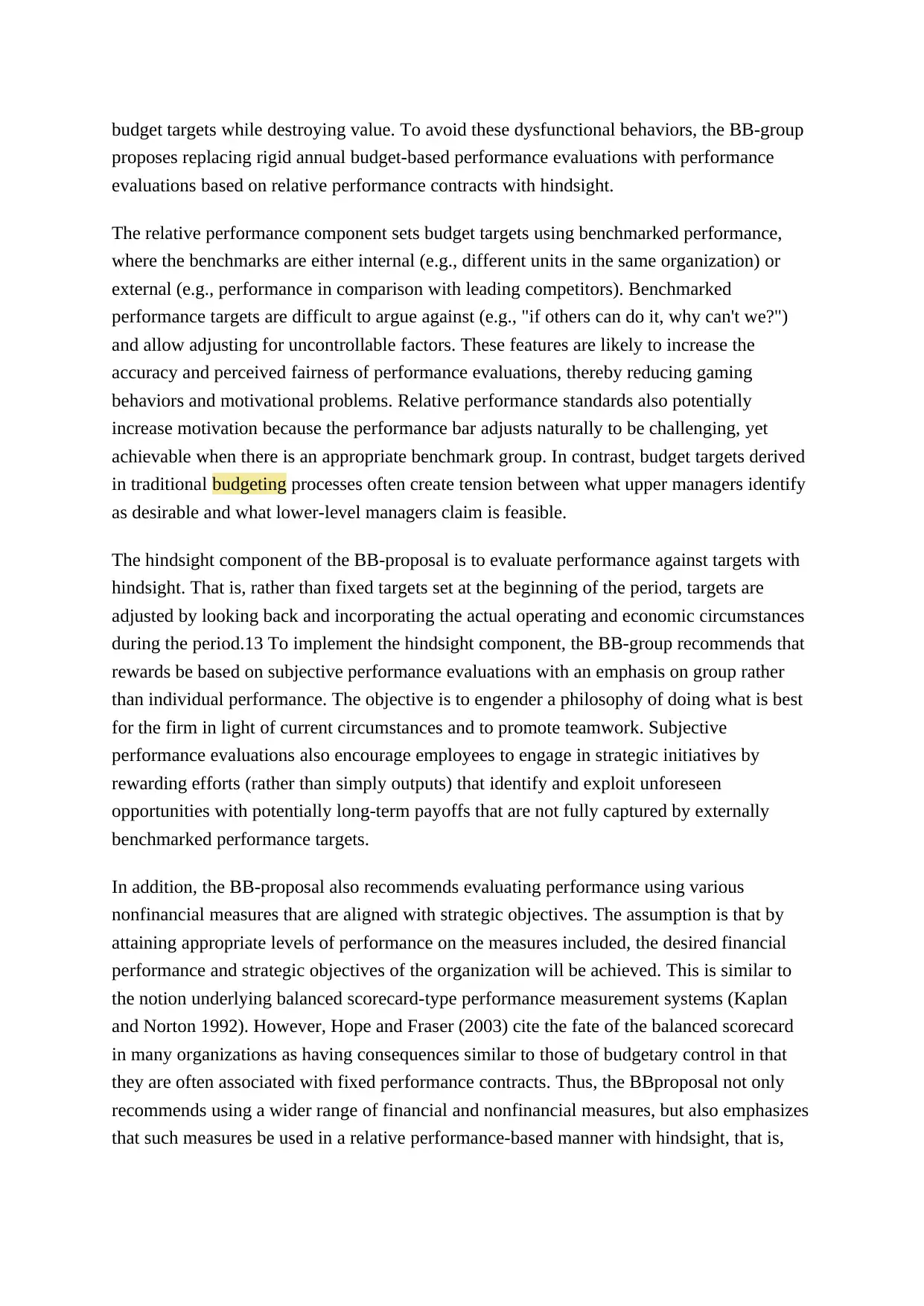
budget targets while destroying value. To avoid these dysfunctional behaviors, the BB-group
proposes replacing rigid annual budget-based performance evaluations with performance
evaluations based on relative performance contracts with hindsight.
The relative performance component sets budget targets using benchmarked performance,
where the benchmarks are either internal (e.g., different units in the same organization) or
external (e.g., performance in comparison with leading competitors). Benchmarked
performance targets are difficult to argue against (e.g., "if others can do it, why can't we?")
and allow adjusting for uncontrollable factors. These features are likely to increase the
accuracy and perceived fairness of performance evaluations, thereby reducing gaming
behaviors and motivational problems. Relative performance standards also potentially
increase motivation because the performance bar adjusts naturally to be challenging, yet
achievable when there is an appropriate benchmark group. In contrast, budget targets derived
in traditional budgeting processes often create tension between what upper managers identify
as desirable and what lower-level managers claim is feasible.
The hindsight component of the BB-proposal is to evaluate performance against targets with
hindsight. That is, rather than fixed targets set at the beginning of the period, targets are
adjusted by looking back and incorporating the actual operating and economic circumstances
during the period.13 To implement the hindsight component, the BB-group recommends that
rewards be based on subjective performance evaluations with an emphasis on group rather
than individual performance. The objective is to engender a philosophy of doing what is best
for the firm in light of current circumstances and to promote teamwork. Subjective
performance evaluations also encourage employees to engage in strategic initiatives by
rewarding efforts (rather than simply outputs) that identify and exploit unforeseen
opportunities with potentially long-term payoffs that are not fully captured by externally
benchmarked performance targets.
In addition, the BB-proposal also recommends evaluating performance using various
nonfinancial measures that are aligned with strategic objectives. The assumption is that by
attaining appropriate levels of performance on the measures included, the desired financial
performance and strategic objectives of the organization will be achieved. This is similar to
the notion underlying balanced scorecard-type performance measurement systems (Kaplan
and Norton 1992). However, Hope and Fraser (2003) cite the fate of the balanced scorecard
in many organizations as having consequences similar to those of budgetary control in that
they are often associated with fixed performance contracts. Thus, the BBproposal not only
recommends using a wider range of financial and nonfinancial measures, but also emphasizes
that such measures be used in a relative performance-based manner with hindsight, that is,
proposes replacing rigid annual budget-based performance evaluations with performance
evaluations based on relative performance contracts with hindsight.
The relative performance component sets budget targets using benchmarked performance,
where the benchmarks are either internal (e.g., different units in the same organization) or
external (e.g., performance in comparison with leading competitors). Benchmarked
performance targets are difficult to argue against (e.g., "if others can do it, why can't we?")
and allow adjusting for uncontrollable factors. These features are likely to increase the
accuracy and perceived fairness of performance evaluations, thereby reducing gaming
behaviors and motivational problems. Relative performance standards also potentially
increase motivation because the performance bar adjusts naturally to be challenging, yet
achievable when there is an appropriate benchmark group. In contrast, budget targets derived
in traditional budgeting processes often create tension between what upper managers identify
as desirable and what lower-level managers claim is feasible.
The hindsight component of the BB-proposal is to evaluate performance against targets with
hindsight. That is, rather than fixed targets set at the beginning of the period, targets are
adjusted by looking back and incorporating the actual operating and economic circumstances
during the period.13 To implement the hindsight component, the BB-group recommends that
rewards be based on subjective performance evaluations with an emphasis on group rather
than individual performance. The objective is to engender a philosophy of doing what is best
for the firm in light of current circumstances and to promote teamwork. Subjective
performance evaluations also encourage employees to engage in strategic initiatives by
rewarding efforts (rather than simply outputs) that identify and exploit unforeseen
opportunities with potentially long-term payoffs that are not fully captured by externally
benchmarked performance targets.
In addition, the BB-proposal also recommends evaluating performance using various
nonfinancial measures that are aligned with strategic objectives. The assumption is that by
attaining appropriate levels of performance on the measures included, the desired financial
performance and strategic objectives of the organization will be achieved. This is similar to
the notion underlying balanced scorecard-type performance measurement systems (Kaplan
and Norton 1992). However, Hope and Fraser (2003) cite the fate of the balanced scorecard
in many organizations as having consequences similar to those of budgetary control in that
they are often associated with fixed performance contracts. Thus, the BBproposal not only
recommends using a wider range of financial and nonfinancial measures, but also emphasizes
that such measures be used in a relative performance-based manner with hindsight, that is,

with goals either internally or externally benchmarked and performance evaluated
subjectively.
It is important to emphasize that in the BB-proposal, financial managers will continue to
construct budgets to serve the organization's financial planning needs, but they will not be
issued to managers to act as targets for performance evaluation. The BB-group's claim is that
by freeing planning from budget-based performance evaluations, planning will become more
accurate and useful because it can be adapted to changing circumstances instead of
continuing to direct organizational effort and decision making toward preset targets even
though they have become obsolete.
Although abandoning budget-based performance evaluations provides a first stage of
improvement, the BB-group views it only as a starting point toward more radical
decentralization, which offers an even greater potential (see also Wallander 2003). This stage
of the BB-approach speaks more pertinently to the failure of traditional budgetary controls to
empower people to make decisions that are congruent with strategic goals. The essence of the
argument is that effective devolution and empowerment is virtually incompatible with the use
of traditional budgetary controls. First, traditional budgetary controls fail to create a high
performance climate based on competitive success because a fixed target is the definitive
measure of success. Second, they fail to make people accountable for satisfied customers
because financial performance measures predominate. Third, they fail to empower people to
act by providing them with resource capabilities because resources have been committed for
the budgeting period. The BB-approach's version of decentralization does not fully budget
resources in advance, but rather resources are made available at short notice to those areas
that have the greatest current need. But how then can the organization be assured that
resources will be employed effectively (instead of, for example, for local empire building)!
The BB-group claims that empowerment will be effective when it is accompanied by a shift
from results control, the cornerstone of traditional budgetary controls, to controls based on
employee selection, corporate visions and values, codes of conduct, training, etc. This relates
to the control mechanisms that Simons (1995) and Ouchi (1979, 1980) defined as the
visioning lever-of-control or clan controls. Thus, rather than using a plethora of performance
measures, as might be implied by the first BB-stage, the focus of the control system is moved
toward the more diffuse areas of mission, vision, and organizational culture. We evaluate this
position in more detail in the fourth section.
The common thread across both the ABB and BB approaches is that the inability to do
adequate planning in uncertain environments makes the budget less useful. Based on this
observation, the ABB-group proposes a more sophisticated, activity-based model to improve
planning, but it does not take a position on how the performance evaluation system should be
subjectively.
It is important to emphasize that in the BB-proposal, financial managers will continue to
construct budgets to serve the organization's financial planning needs, but they will not be
issued to managers to act as targets for performance evaluation. The BB-group's claim is that
by freeing planning from budget-based performance evaluations, planning will become more
accurate and useful because it can be adapted to changing circumstances instead of
continuing to direct organizational effort and decision making toward preset targets even
though they have become obsolete.
Although abandoning budget-based performance evaluations provides a first stage of
improvement, the BB-group views it only as a starting point toward more radical
decentralization, which offers an even greater potential (see also Wallander 2003). This stage
of the BB-approach speaks more pertinently to the failure of traditional budgetary controls to
empower people to make decisions that are congruent with strategic goals. The essence of the
argument is that effective devolution and empowerment is virtually incompatible with the use
of traditional budgetary controls. First, traditional budgetary controls fail to create a high
performance climate based on competitive success because a fixed target is the definitive
measure of success. Second, they fail to make people accountable for satisfied customers
because financial performance measures predominate. Third, they fail to empower people to
act by providing them with resource capabilities because resources have been committed for
the budgeting period. The BB-approach's version of decentralization does not fully budget
resources in advance, but rather resources are made available at short notice to those areas
that have the greatest current need. But how then can the organization be assured that
resources will be employed effectively (instead of, for example, for local empire building)!
The BB-group claims that empowerment will be effective when it is accompanied by a shift
from results control, the cornerstone of traditional budgetary controls, to controls based on
employee selection, corporate visions and values, codes of conduct, training, etc. This relates
to the control mechanisms that Simons (1995) and Ouchi (1979, 1980) defined as the
visioning lever-of-control or clan controls. Thus, rather than using a plethora of performance
measures, as might be implied by the first BB-stage, the focus of the control system is moved
toward the more diffuse areas of mission, vision, and organizational culture. We evaluate this
position in more detail in the fourth section.
The common thread across both the ABB and BB approaches is that the inability to do
adequate planning in uncertain environments makes the budget less useful. Based on this
observation, the ABB-group proposes a more sophisticated, activity-based model to improve
planning, but it does not take a position on how the performance evaluation system should be
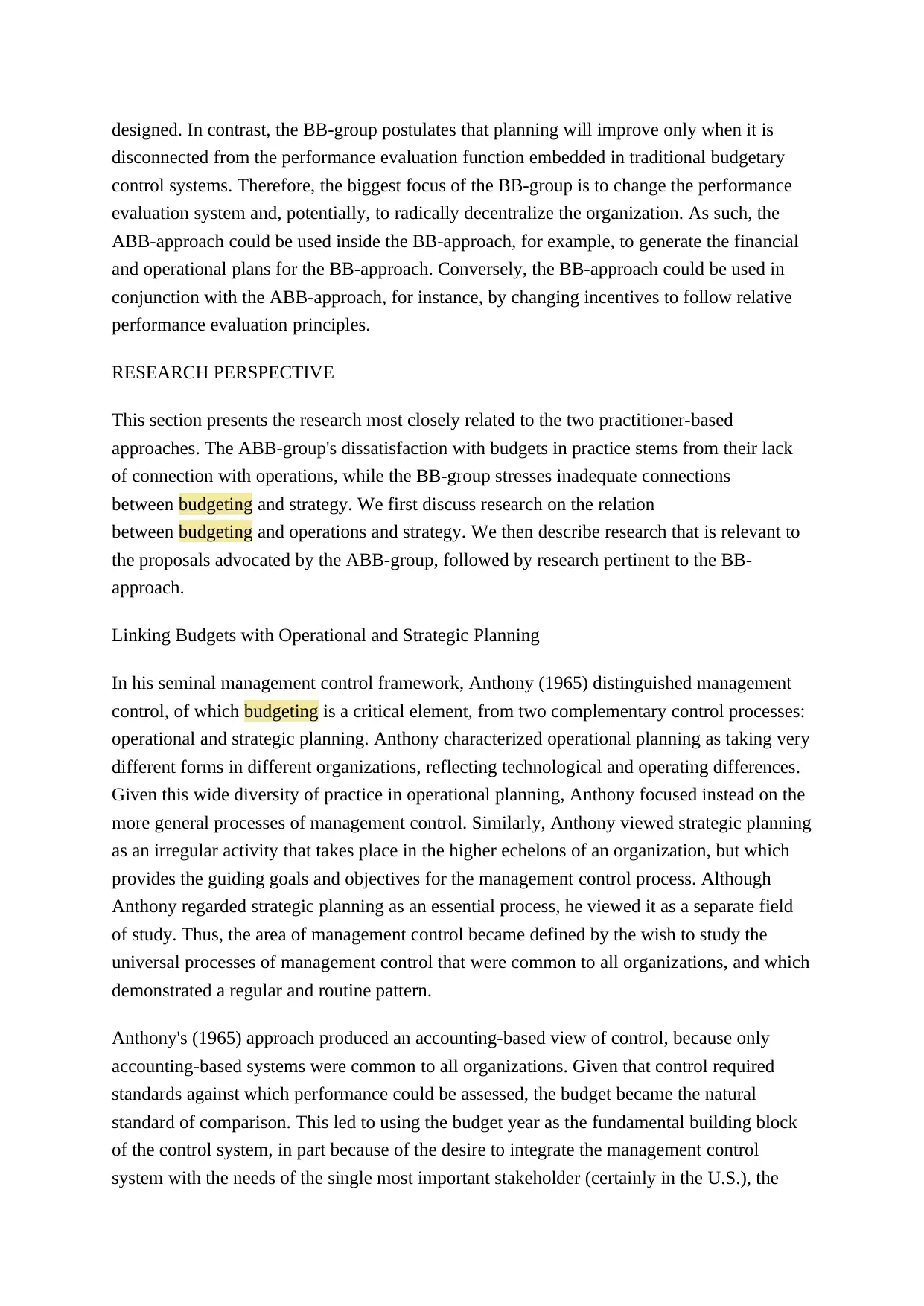
designed. In contrast, the BB-group postulates that planning will improve only when it is
disconnected from the performance evaluation function embedded in traditional budgetary
control systems. Therefore, the biggest focus of the BB-group is to change the performance
evaluation system and, potentially, to radically decentralize the organization. As such, the
ABB-approach could be used inside the BB-approach, for example, to generate the financial
and operational plans for the BB-approach. Conversely, the BB-approach could be used in
conjunction with the ABB-approach, for instance, by changing incentives to follow relative
performance evaluation principles.
RESEARCH PERSPECTIVE
This section presents the research most closely related to the two practitioner-based
approaches. The ABB-group's dissatisfaction with budgets in practice stems from their lack
of connection with operations, while the BB-group stresses inadequate connections
between budgeting and strategy. We first discuss research on the relation
between budgeting and operations and strategy. We then describe research that is relevant to
the proposals advocated by the ABB-group, followed by research pertinent to the BB-
approach.
Linking Budgets with Operational and Strategic Planning
In his seminal management control framework, Anthony (1965) distinguished management
control, of which budgeting is a critical element, from two complementary control processes:
operational and strategic planning. Anthony characterized operational planning as taking very
different forms in different organizations, reflecting technological and operating differences.
Given this wide diversity of practice in operational planning, Anthony focused instead on the
more general processes of management control. Similarly, Anthony viewed strategic planning
as an irregular activity that takes place in the higher echelons of an organization, but which
provides the guiding goals and objectives for the management control process. Although
Anthony regarded strategic planning as an essential process, he viewed it as a separate field
of study. Thus, the area of management control became defined by the wish to study the
universal processes of management control that were common to all organizations, and which
demonstrated a regular and routine pattern.
Anthony's (1965) approach produced an accounting-based view of control, because only
accounting-based systems were common to all organizations. Given that control required
standards against which performance could be assessed, the budget became the natural
standard of comparison. This led to using the budget year as the fundamental building block
of the control system, in part because of the desire to integrate the management control
system with the needs of the single most important stakeholder (certainly in the U.S.), the
disconnected from the performance evaluation function embedded in traditional budgetary
control systems. Therefore, the biggest focus of the BB-group is to change the performance
evaluation system and, potentially, to radically decentralize the organization. As such, the
ABB-approach could be used inside the BB-approach, for example, to generate the financial
and operational plans for the BB-approach. Conversely, the BB-approach could be used in
conjunction with the ABB-approach, for instance, by changing incentives to follow relative
performance evaluation principles.
RESEARCH PERSPECTIVE
This section presents the research most closely related to the two practitioner-based
approaches. The ABB-group's dissatisfaction with budgets in practice stems from their lack
of connection with operations, while the BB-group stresses inadequate connections
between budgeting and strategy. We first discuss research on the relation
between budgeting and operations and strategy. We then describe research that is relevant to
the proposals advocated by the ABB-group, followed by research pertinent to the BB-
approach.
Linking Budgets with Operational and Strategic Planning
In his seminal management control framework, Anthony (1965) distinguished management
control, of which budgeting is a critical element, from two complementary control processes:
operational and strategic planning. Anthony characterized operational planning as taking very
different forms in different organizations, reflecting technological and operating differences.
Given this wide diversity of practice in operational planning, Anthony focused instead on the
more general processes of management control. Similarly, Anthony viewed strategic planning
as an irregular activity that takes place in the higher echelons of an organization, but which
provides the guiding goals and objectives for the management control process. Although
Anthony regarded strategic planning as an essential process, he viewed it as a separate field
of study. Thus, the area of management control became defined by the wish to study the
universal processes of management control that were common to all organizations, and which
demonstrated a regular and routine pattern.
Anthony's (1965) approach produced an accounting-based view of control, because only
accounting-based systems were common to all organizations. Given that control required
standards against which performance could be assessed, the budget became the natural
standard of comparison. This led to using the budget year as the fundamental building block
of the control system, in part because of the desire to integrate the management control
system with the needs of the single most important stakeholder (certainly in the U.S.), the
Secure Best Marks with AI Grader
Need help grading? Try our AI Grader for instant feedback on your assignments.
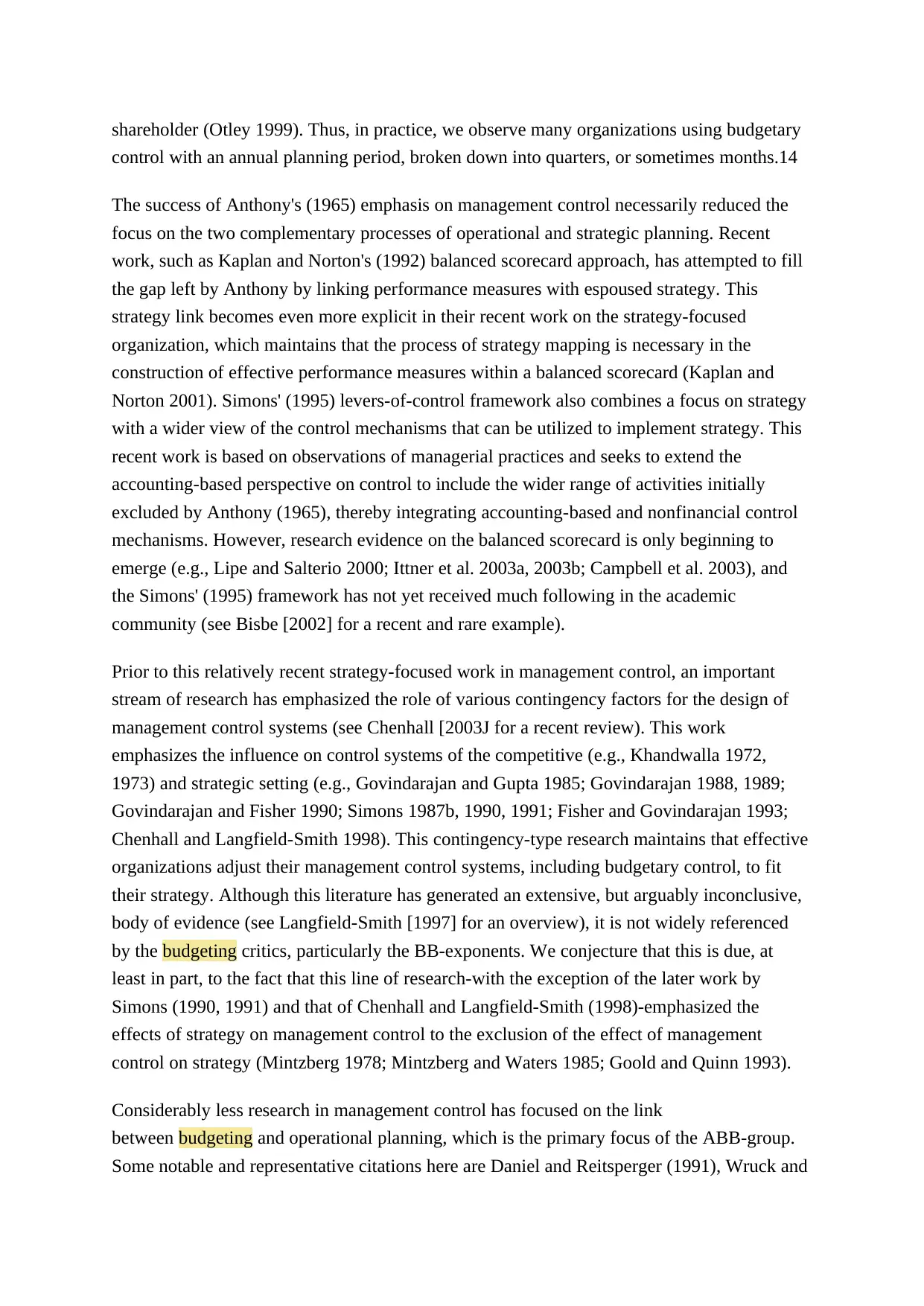
shareholder (Otley 1999). Thus, in practice, we observe many organizations using budgetary
control with an annual planning period, broken down into quarters, or sometimes months.14
The success of Anthony's (1965) emphasis on management control necessarily reduced the
focus on the two complementary processes of operational and strategic planning. Recent
work, such as Kaplan and Norton's (1992) balanced scorecard approach, has attempted to fill
the gap left by Anthony by linking performance measures with espoused strategy. This
strategy link becomes even more explicit in their recent work on the strategy-focused
organization, which maintains that the process of strategy mapping is necessary in the
construction of effective performance measures within a balanced scorecard (Kaplan and
Norton 2001). Simons' (1995) levers-of-control framework also combines a focus on strategy
with a wider view of the control mechanisms that can be utilized to implement strategy. This
recent work is based on observations of managerial practices and seeks to extend the
accounting-based perspective on control to include the wider range of activities initially
excluded by Anthony (1965), thereby integrating accounting-based and nonfinancial control
mechanisms. However, research evidence on the balanced scorecard is only beginning to
emerge (e.g., Lipe and Salterio 2000; Ittner et al. 2003a, 2003b; Campbell et al. 2003), and
the Simons' (1995) framework has not yet received much following in the academic
community (see Bisbe [2002] for a recent and rare example).
Prior to this relatively recent strategy-focused work in management control, an important
stream of research has emphasized the role of various contingency factors for the design of
management control systems (see Chenhall [2003J for a recent review). This work
emphasizes the influence on control systems of the competitive (e.g., Khandwalla 1972,
1973) and strategic setting (e.g., Govindarajan and Gupta 1985; Govindarajan 1988, 1989;
Govindarajan and Fisher 1990; Simons 1987b, 1990, 1991; Fisher and Govindarajan 1993;
Chenhall and Langfield-Smith 1998). This contingency-type research maintains that effective
organizations adjust their management control systems, including budgetary control, to fit
their strategy. Although this literature has generated an extensive, but arguably inconclusive,
body of evidence (see Langfield-Smith [1997] for an overview), it is not widely referenced
by the budgeting critics, particularly the BB-exponents. We conjecture that this is due, at
least in part, to the fact that this line of research-with the exception of the later work by
Simons (1990, 1991) and that of Chenhall and Langfield-Smith (1998)-emphasized the
effects of strategy on management control to the exclusion of the effect of management
control on strategy (Mintzberg 1978; Mintzberg and Waters 1985; Goold and Quinn 1993).
Considerably less research in management control has focused on the link
between budgeting and operational planning, which is the primary focus of the ABB-group.
Some notable and representative citations here are Daniel and Reitsperger (1991), Wruck and
control with an annual planning period, broken down into quarters, or sometimes months.14
The success of Anthony's (1965) emphasis on management control necessarily reduced the
focus on the two complementary processes of operational and strategic planning. Recent
work, such as Kaplan and Norton's (1992) balanced scorecard approach, has attempted to fill
the gap left by Anthony by linking performance measures with espoused strategy. This
strategy link becomes even more explicit in their recent work on the strategy-focused
organization, which maintains that the process of strategy mapping is necessary in the
construction of effective performance measures within a balanced scorecard (Kaplan and
Norton 2001). Simons' (1995) levers-of-control framework also combines a focus on strategy
with a wider view of the control mechanisms that can be utilized to implement strategy. This
recent work is based on observations of managerial practices and seeks to extend the
accounting-based perspective on control to include the wider range of activities initially
excluded by Anthony (1965), thereby integrating accounting-based and nonfinancial control
mechanisms. However, research evidence on the balanced scorecard is only beginning to
emerge (e.g., Lipe and Salterio 2000; Ittner et al. 2003a, 2003b; Campbell et al. 2003), and
the Simons' (1995) framework has not yet received much following in the academic
community (see Bisbe [2002] for a recent and rare example).
Prior to this relatively recent strategy-focused work in management control, an important
stream of research has emphasized the role of various contingency factors for the design of
management control systems (see Chenhall [2003J for a recent review). This work
emphasizes the influence on control systems of the competitive (e.g., Khandwalla 1972,
1973) and strategic setting (e.g., Govindarajan and Gupta 1985; Govindarajan 1988, 1989;
Govindarajan and Fisher 1990; Simons 1987b, 1990, 1991; Fisher and Govindarajan 1993;
Chenhall and Langfield-Smith 1998). This contingency-type research maintains that effective
organizations adjust their management control systems, including budgetary control, to fit
their strategy. Although this literature has generated an extensive, but arguably inconclusive,
body of evidence (see Langfield-Smith [1997] for an overview), it is not widely referenced
by the budgeting critics, particularly the BB-exponents. We conjecture that this is due, at
least in part, to the fact that this line of research-with the exception of the later work by
Simons (1990, 1991) and that of Chenhall and Langfield-Smith (1998)-emphasized the
effects of strategy on management control to the exclusion of the effect of management
control on strategy (Mintzberg 1978; Mintzberg and Waters 1985; Goold and Quinn 1993).
Considerably less research in management control has focused on the link
between budgeting and operational planning, which is the primary focus of the ABB-group.
Some notable and representative citations here are Daniel and Reitsperger (1991), Wruck and
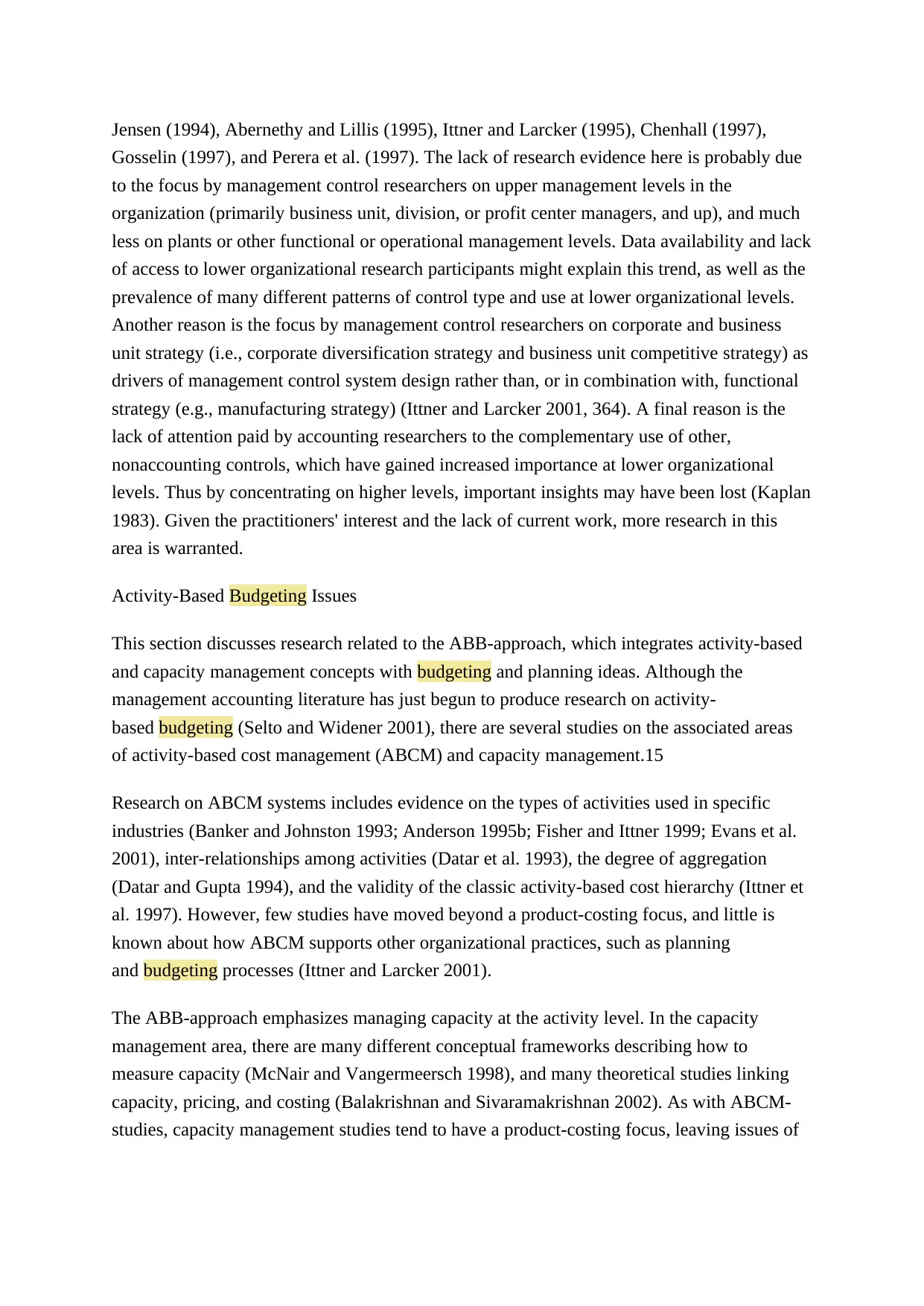
Jensen (1994), Abernethy and Lillis (1995), Ittner and Larcker (1995), Chenhall (1997),
Gosselin (1997), and Perera et al. (1997). The lack of research evidence here is probably due
to the focus by management control researchers on upper management levels in the
organization (primarily business unit, division, or profit center managers, and up), and much
less on plants or other functional or operational management levels. Data availability and lack
of access to lower organizational research participants might explain this trend, as well as the
prevalence of many different patterns of control type and use at lower organizational levels.
Another reason is the focus by management control researchers on corporate and business
unit strategy (i.e., corporate diversification strategy and business unit competitive strategy) as
drivers of management control system design rather than, or in combination with, functional
strategy (e.g., manufacturing strategy) (Ittner and Larcker 2001, 364). A final reason is the
lack of attention paid by accounting researchers to the complementary use of other,
nonaccounting controls, which have gained increased importance at lower organizational
levels. Thus by concentrating on higher levels, important insights may have been lost (Kaplan
1983). Given the practitioners' interest and the lack of current work, more research in this
area is warranted.
Activity-Based Budgeting Issues
This section discusses research related to the ABB-approach, which integrates activity-based
and capacity management concepts with budgeting and planning ideas. Although the
management accounting literature has just begun to produce research on activity-
based budgeting (Selto and Widener 2001), there are several studies on the associated areas
of activity-based cost management (ABCM) and capacity management.15
Research on ABCM systems includes evidence on the types of activities used in specific
industries (Banker and Johnston 1993; Anderson 1995b; Fisher and Ittner 1999; Evans et al.
2001), inter-relationships among activities (Datar et al. 1993), the degree of aggregation
(Datar and Gupta 1994), and the validity of the classic activity-based cost hierarchy (Ittner et
al. 1997). However, few studies have moved beyond a product-costing focus, and little is
known about how ABCM supports other organizational practices, such as planning
and budgeting processes (Ittner and Larcker 2001).
The ABB-approach emphasizes managing capacity at the activity level. In the capacity
management area, there are many different conceptual frameworks describing how to
measure capacity (McNair and Vangermeersch 1998), and many theoretical studies linking
capacity, pricing, and costing (Balakrishnan and Sivaramakrishnan 2002). As with ABCM-
studies, capacity management studies tend to have a product-costing focus, leaving issues of
Gosselin (1997), and Perera et al. (1997). The lack of research evidence here is probably due
to the focus by management control researchers on upper management levels in the
organization (primarily business unit, division, or profit center managers, and up), and much
less on plants or other functional or operational management levels. Data availability and lack
of access to lower organizational research participants might explain this trend, as well as the
prevalence of many different patterns of control type and use at lower organizational levels.
Another reason is the focus by management control researchers on corporate and business
unit strategy (i.e., corporate diversification strategy and business unit competitive strategy) as
drivers of management control system design rather than, or in combination with, functional
strategy (e.g., manufacturing strategy) (Ittner and Larcker 2001, 364). A final reason is the
lack of attention paid by accounting researchers to the complementary use of other,
nonaccounting controls, which have gained increased importance at lower organizational
levels. Thus by concentrating on higher levels, important insights may have been lost (Kaplan
1983). Given the practitioners' interest and the lack of current work, more research in this
area is warranted.
Activity-Based Budgeting Issues
This section discusses research related to the ABB-approach, which integrates activity-based
and capacity management concepts with budgeting and planning ideas. Although the
management accounting literature has just begun to produce research on activity-
based budgeting (Selto and Widener 2001), there are several studies on the associated areas
of activity-based cost management (ABCM) and capacity management.15
Research on ABCM systems includes evidence on the types of activities used in specific
industries (Banker and Johnston 1993; Anderson 1995b; Fisher and Ittner 1999; Evans et al.
2001), inter-relationships among activities (Datar et al. 1993), the degree of aggregation
(Datar and Gupta 1994), and the validity of the classic activity-based cost hierarchy (Ittner et
al. 1997). However, few studies have moved beyond a product-costing focus, and little is
known about how ABCM supports other organizational practices, such as planning
and budgeting processes (Ittner and Larcker 2001).
The ABB-approach emphasizes managing capacity at the activity level. In the capacity
management area, there are many different conceptual frameworks describing how to
measure capacity (McNair and Vangermeersch 1998), and many theoretical studies linking
capacity, pricing, and costing (Balakrishnan and Sivaramakrishnan 2002). As with ABCM-
studies, capacity management studies tend to have a product-costing focus, leaving issues of
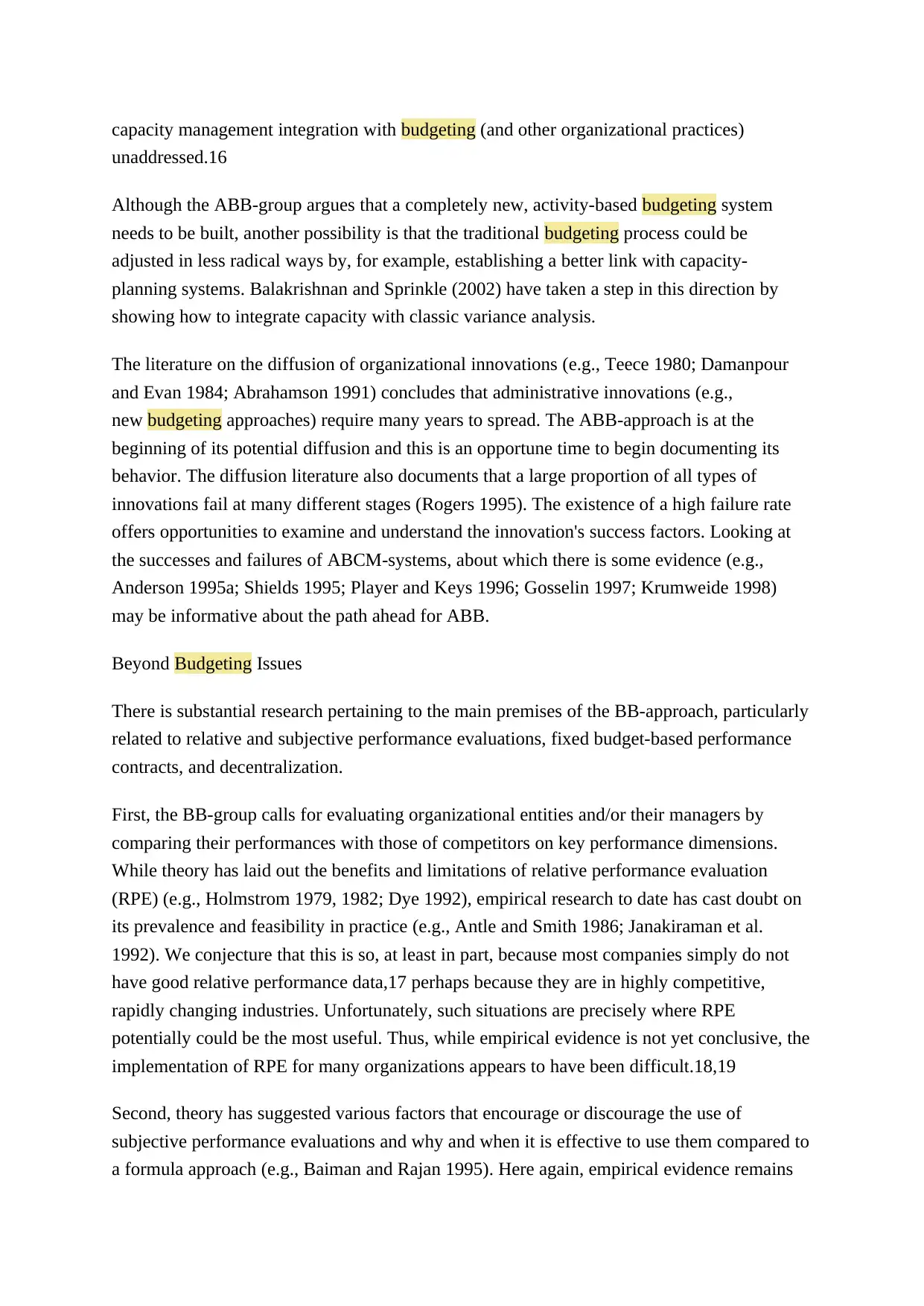
capacity management integration with budgeting (and other organizational practices)
unaddressed.16
Although the ABB-group argues that a completely new, activity-based budgeting system
needs to be built, another possibility is that the traditional budgeting process could be
adjusted in less radical ways by, for example, establishing a better link with capacity-
planning systems. Balakrishnan and Sprinkle (2002) have taken a step in this direction by
showing how to integrate capacity with classic variance analysis.
The literature on the diffusion of organizational innovations (e.g., Teece 1980; Damanpour
and Evan 1984; Abrahamson 1991) concludes that administrative innovations (e.g.,
new budgeting approaches) require many years to spread. The ABB-approach is at the
beginning of its potential diffusion and this is an opportune time to begin documenting its
behavior. The diffusion literature also documents that a large proportion of all types of
innovations fail at many different stages (Rogers 1995). The existence of a high failure rate
offers opportunities to examine and understand the innovation's success factors. Looking at
the successes and failures of ABCM-systems, about which there is some evidence (e.g.,
Anderson 1995a; Shields 1995; Player and Keys 1996; Gosselin 1997; Krumweide 1998)
may be informative about the path ahead for ABB.
Beyond Budgeting Issues
There is substantial research pertaining to the main premises of the BB-approach, particularly
related to relative and subjective performance evaluations, fixed budget-based performance
contracts, and decentralization.
First, the BB-group calls for evaluating organizational entities and/or their managers by
comparing their performances with those of competitors on key performance dimensions.
While theory has laid out the benefits and limitations of relative performance evaluation
(RPE) (e.g., Holmstrom 1979, 1982; Dye 1992), empirical research to date has cast doubt on
its prevalence and feasibility in practice (e.g., Antle and Smith 1986; Janakiraman et al.
1992). We conjecture that this is so, at least in part, because most companies simply do not
have good relative performance data,17 perhaps because they are in highly competitive,
rapidly changing industries. Unfortunately, such situations are precisely where RPE
potentially could be the most useful. Thus, while empirical evidence is not yet conclusive, the
implementation of RPE for many organizations appears to have been difficult.18,19
Second, theory has suggested various factors that encourage or discourage the use of
subjective performance evaluations and why and when it is effective to use them compared to
a formula approach (e.g., Baiman and Rajan 1995). Here again, empirical evidence remains
unaddressed.16
Although the ABB-group argues that a completely new, activity-based budgeting system
needs to be built, another possibility is that the traditional budgeting process could be
adjusted in less radical ways by, for example, establishing a better link with capacity-
planning systems. Balakrishnan and Sprinkle (2002) have taken a step in this direction by
showing how to integrate capacity with classic variance analysis.
The literature on the diffusion of organizational innovations (e.g., Teece 1980; Damanpour
and Evan 1984; Abrahamson 1991) concludes that administrative innovations (e.g.,
new budgeting approaches) require many years to spread. The ABB-approach is at the
beginning of its potential diffusion and this is an opportune time to begin documenting its
behavior. The diffusion literature also documents that a large proportion of all types of
innovations fail at many different stages (Rogers 1995). The existence of a high failure rate
offers opportunities to examine and understand the innovation's success factors. Looking at
the successes and failures of ABCM-systems, about which there is some evidence (e.g.,
Anderson 1995a; Shields 1995; Player and Keys 1996; Gosselin 1997; Krumweide 1998)
may be informative about the path ahead for ABB.
Beyond Budgeting Issues
There is substantial research pertaining to the main premises of the BB-approach, particularly
related to relative and subjective performance evaluations, fixed budget-based performance
contracts, and decentralization.
First, the BB-group calls for evaluating organizational entities and/or their managers by
comparing their performances with those of competitors on key performance dimensions.
While theory has laid out the benefits and limitations of relative performance evaluation
(RPE) (e.g., Holmstrom 1979, 1982; Dye 1992), empirical research to date has cast doubt on
its prevalence and feasibility in practice (e.g., Antle and Smith 1986; Janakiraman et al.
1992). We conjecture that this is so, at least in part, because most companies simply do not
have good relative performance data,17 perhaps because they are in highly competitive,
rapidly changing industries. Unfortunately, such situations are precisely where RPE
potentially could be the most useful. Thus, while empirical evidence is not yet conclusive, the
implementation of RPE for many organizations appears to have been difficult.18,19
Second, theory has suggested various factors that encourage or discourage the use of
subjective performance evaluations and why and when it is effective to use them compared to
a formula approach (e.g., Baiman and Rajan 1995). Here again, empirical evidence remains
Paraphrase This Document
Need a fresh take? Get an instant paraphrase of this document with our AI Paraphraser
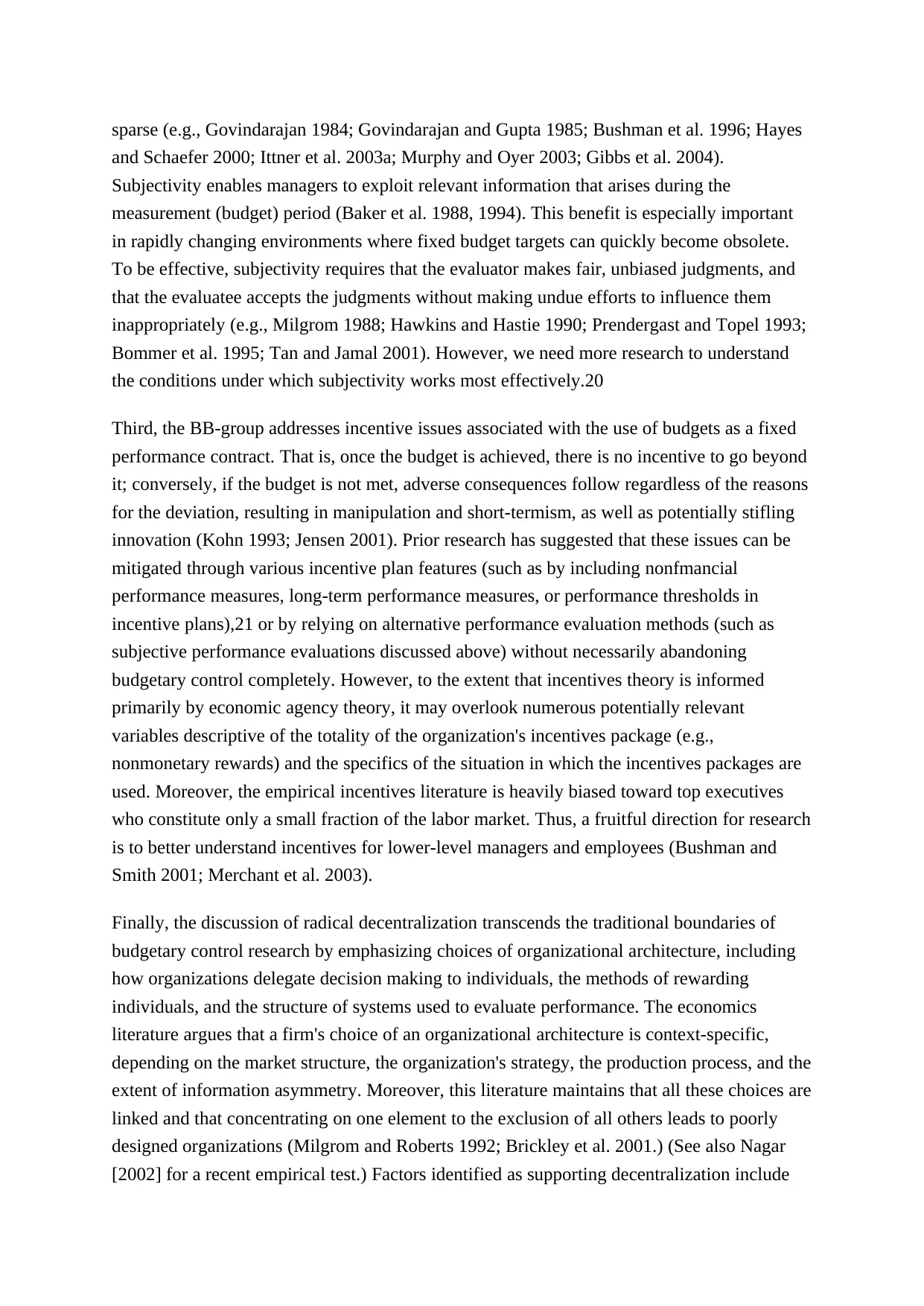
sparse (e.g., Govindarajan 1984; Govindarajan and Gupta 1985; Bushman et al. 1996; Hayes
and Schaefer 2000; Ittner et al. 2003a; Murphy and Oyer 2003; Gibbs et al. 2004).
Subjectivity enables managers to exploit relevant information that arises during the
measurement (budget) period (Baker et al. 1988, 1994). This benefit is especially important
in rapidly changing environments where fixed budget targets can quickly become obsolete.
To be effective, subjectivity requires that the evaluator makes fair, unbiased judgments, and
that the evaluatee accepts the judgments without making undue efforts to influence them
inappropriately (e.g., Milgrom 1988; Hawkins and Hastie 1990; Prendergast and Topel 1993;
Bommer et al. 1995; Tan and Jamal 2001). However, we need more research to understand
the conditions under which subjectivity works most effectively.20
Third, the BB-group addresses incentive issues associated with the use of budgets as a fixed
performance contract. That is, once the budget is achieved, there is no incentive to go beyond
it; conversely, if the budget is not met, adverse consequences follow regardless of the reasons
for the deviation, resulting in manipulation and short-termism, as well as potentially stifling
innovation (Kohn 1993; Jensen 2001). Prior research has suggested that these issues can be
mitigated through various incentive plan features (such as by including nonfmancial
performance measures, long-term performance measures, or performance thresholds in
incentive plans),21 or by relying on alternative performance evaluation methods (such as
subjective performance evaluations discussed above) without necessarily abandoning
budgetary control completely. However, to the extent that incentives theory is informed
primarily by economic agency theory, it may overlook numerous potentially relevant
variables descriptive of the totality of the organization's incentives package (e.g.,
nonmonetary rewards) and the specifics of the situation in which the incentives packages are
used. Moreover, the empirical incentives literature is heavily biased toward top executives
who constitute only a small fraction of the labor market. Thus, a fruitful direction for research
is to better understand incentives for lower-level managers and employees (Bushman and
Smith 2001; Merchant et al. 2003).
Finally, the discussion of radical decentralization transcends the traditional boundaries of
budgetary control research by emphasizing choices of organizational architecture, including
how organizations delegate decision making to individuals, the methods of rewarding
individuals, and the structure of systems used to evaluate performance. The economics
literature argues that a firm's choice of an organizational architecture is context-specific,
depending on the market structure, the organization's strategy, the production process, and the
extent of information asymmetry. Moreover, this literature maintains that all these choices are
linked and that concentrating on one element to the exclusion of all others leads to poorly
designed organizations (Milgrom and Roberts 1992; Brickley et al. 2001.) (See also Nagar
[2002] for a recent empirical test.) Factors identified as supporting decentralization include
and Schaefer 2000; Ittner et al. 2003a; Murphy and Oyer 2003; Gibbs et al. 2004).
Subjectivity enables managers to exploit relevant information that arises during the
measurement (budget) period (Baker et al. 1988, 1994). This benefit is especially important
in rapidly changing environments where fixed budget targets can quickly become obsolete.
To be effective, subjectivity requires that the evaluator makes fair, unbiased judgments, and
that the evaluatee accepts the judgments without making undue efforts to influence them
inappropriately (e.g., Milgrom 1988; Hawkins and Hastie 1990; Prendergast and Topel 1993;
Bommer et al. 1995; Tan and Jamal 2001). However, we need more research to understand
the conditions under which subjectivity works most effectively.20
Third, the BB-group addresses incentive issues associated with the use of budgets as a fixed
performance contract. That is, once the budget is achieved, there is no incentive to go beyond
it; conversely, if the budget is not met, adverse consequences follow regardless of the reasons
for the deviation, resulting in manipulation and short-termism, as well as potentially stifling
innovation (Kohn 1993; Jensen 2001). Prior research has suggested that these issues can be
mitigated through various incentive plan features (such as by including nonfmancial
performance measures, long-term performance measures, or performance thresholds in
incentive plans),21 or by relying on alternative performance evaluation methods (such as
subjective performance evaluations discussed above) without necessarily abandoning
budgetary control completely. However, to the extent that incentives theory is informed
primarily by economic agency theory, it may overlook numerous potentially relevant
variables descriptive of the totality of the organization's incentives package (e.g.,
nonmonetary rewards) and the specifics of the situation in which the incentives packages are
used. Moreover, the empirical incentives literature is heavily biased toward top executives
who constitute only a small fraction of the labor market. Thus, a fruitful direction for research
is to better understand incentives for lower-level managers and employees (Bushman and
Smith 2001; Merchant et al. 2003).
Finally, the discussion of radical decentralization transcends the traditional boundaries of
budgetary control research by emphasizing choices of organizational architecture, including
how organizations delegate decision making to individuals, the methods of rewarding
individuals, and the structure of systems used to evaluate performance. The economics
literature argues that a firm's choice of an organizational architecture is context-specific,
depending on the market structure, the organization's strategy, the production process, and the
extent of information asymmetry. Moreover, this literature maintains that all these choices are
linked and that concentrating on one element to the exclusion of all others leads to poorly
designed organizations (Milgrom and Roberts 1992; Brickley et al. 2001.) (See also Nagar
[2002] for a recent empirical test.) Factors identified as supporting decentralization include
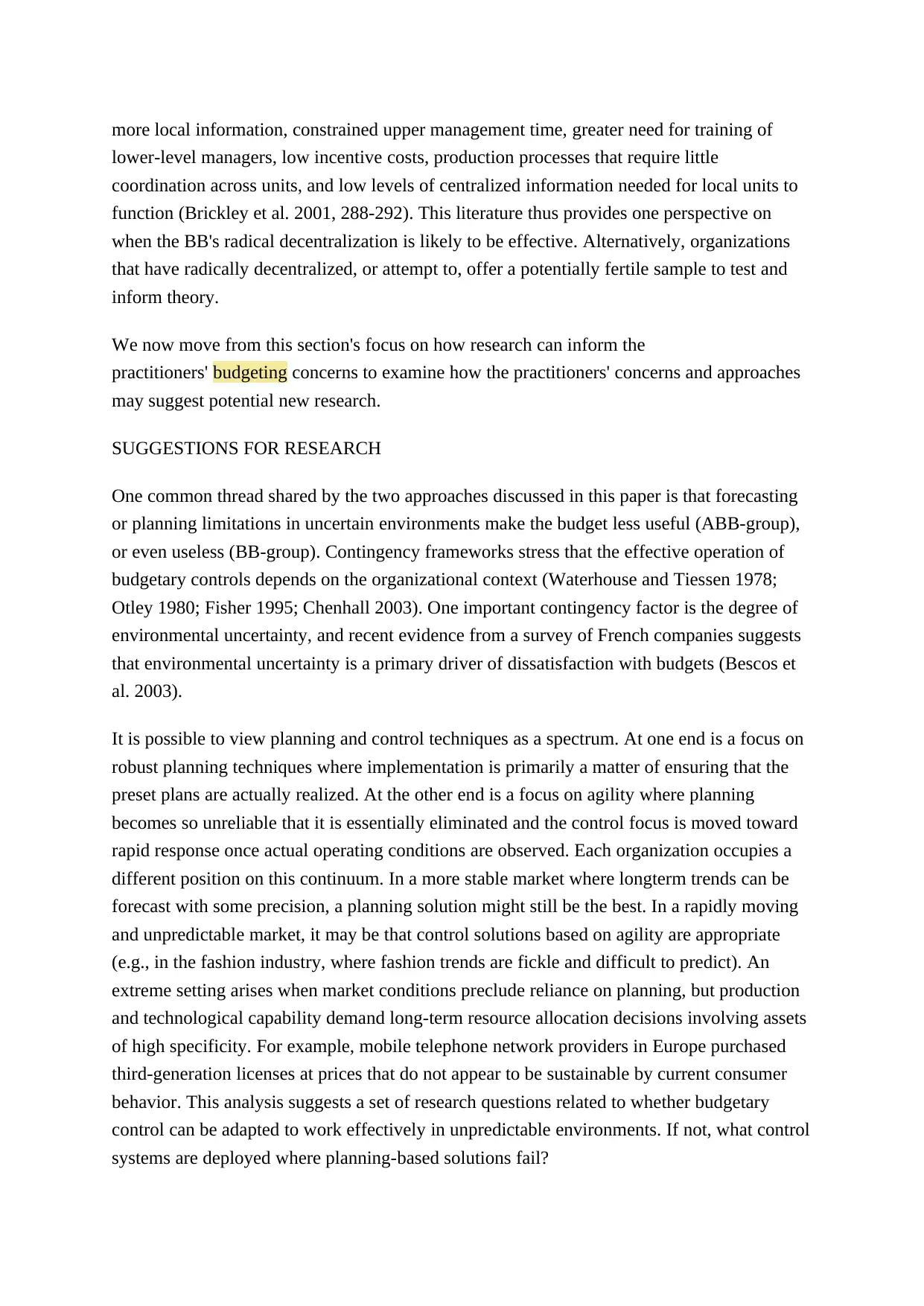
more local information, constrained upper management time, greater need for training of
lower-level managers, low incentive costs, production processes that require little
coordination across units, and low levels of centralized information needed for local units to
function (Brickley et al. 2001, 288-292). This literature thus provides one perspective on
when the BB's radical decentralization is likely to be effective. Alternatively, organizations
that have radically decentralized, or attempt to, offer a potentially fertile sample to test and
inform theory.
We now move from this section's focus on how research can inform the
practitioners' budgeting concerns to examine how the practitioners' concerns and approaches
may suggest potential new research.
SUGGESTIONS FOR RESEARCH
One common thread shared by the two approaches discussed in this paper is that forecasting
or planning limitations in uncertain environments make the budget less useful (ABB-group),
or even useless (BB-group). Contingency frameworks stress that the effective operation of
budgetary controls depends on the organizational context (Waterhouse and Tiessen 1978;
Otley 1980; Fisher 1995; Chenhall 2003). One important contingency factor is the degree of
environmental uncertainty, and recent evidence from a survey of French companies suggests
that environmental uncertainty is a primary driver of dissatisfaction with budgets (Bescos et
al. 2003).
It is possible to view planning and control techniques as a spectrum. At one end is a focus on
robust planning techniques where implementation is primarily a matter of ensuring that the
preset plans are actually realized. At the other end is a focus on agility where planning
becomes so unreliable that it is essentially eliminated and the control focus is moved toward
rapid response once actual operating conditions are observed. Each organization occupies a
different position on this continuum. In a more stable market where longterm trends can be
forecast with some precision, a planning solution might still be the best. In a rapidly moving
and unpredictable market, it may be that control solutions based on agility are appropriate
(e.g., in the fashion industry, where fashion trends are fickle and difficult to predict). An
extreme setting arises when market conditions preclude reliance on planning, but production
and technological capability demand long-term resource allocation decisions involving assets
of high specificity. For example, mobile telephone network providers in Europe purchased
third-generation licenses at prices that do not appear to be sustainable by current consumer
behavior. This analysis suggests a set of research questions related to whether budgetary
control can be adapted to work effectively in unpredictable environments. If not, what control
systems are deployed where planning-based solutions fail?
lower-level managers, low incentive costs, production processes that require little
coordination across units, and low levels of centralized information needed for local units to
function (Brickley et al. 2001, 288-292). This literature thus provides one perspective on
when the BB's radical decentralization is likely to be effective. Alternatively, organizations
that have radically decentralized, or attempt to, offer a potentially fertile sample to test and
inform theory.
We now move from this section's focus on how research can inform the
practitioners' budgeting concerns to examine how the practitioners' concerns and approaches
may suggest potential new research.
SUGGESTIONS FOR RESEARCH
One common thread shared by the two approaches discussed in this paper is that forecasting
or planning limitations in uncertain environments make the budget less useful (ABB-group),
or even useless (BB-group). Contingency frameworks stress that the effective operation of
budgetary controls depends on the organizational context (Waterhouse and Tiessen 1978;
Otley 1980; Fisher 1995; Chenhall 2003). One important contingency factor is the degree of
environmental uncertainty, and recent evidence from a survey of French companies suggests
that environmental uncertainty is a primary driver of dissatisfaction with budgets (Bescos et
al. 2003).
It is possible to view planning and control techniques as a spectrum. At one end is a focus on
robust planning techniques where implementation is primarily a matter of ensuring that the
preset plans are actually realized. At the other end is a focus on agility where planning
becomes so unreliable that it is essentially eliminated and the control focus is moved toward
rapid response once actual operating conditions are observed. Each organization occupies a
different position on this continuum. In a more stable market where longterm trends can be
forecast with some precision, a planning solution might still be the best. In a rapidly moving
and unpredictable market, it may be that control solutions based on agility are appropriate
(e.g., in the fashion industry, where fashion trends are fickle and difficult to predict). An
extreme setting arises when market conditions preclude reliance on planning, but production
and technological capability demand long-term resource allocation decisions involving assets
of high specificity. For example, mobile telephone network providers in Europe purchased
third-generation licenses at prices that do not appear to be sustainable by current consumer
behavior. This analysis suggests a set of research questions related to whether budgetary
control can be adapted to work effectively in unpredictable environments. If not, what control
systems are deployed where planning-based solutions fail?
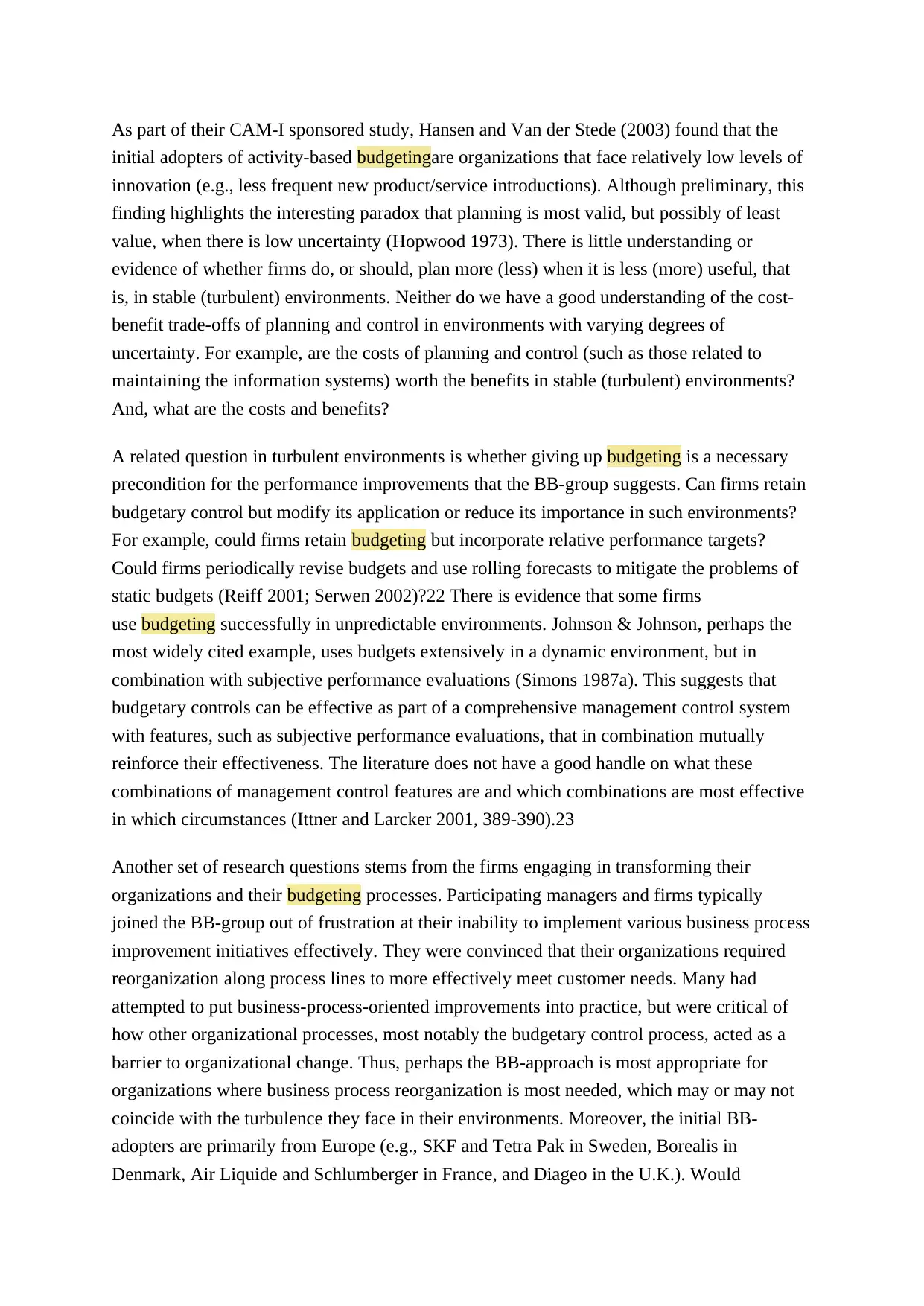
As part of their CAM-I sponsored study, Hansen and Van der Stede (2003) found that the
initial adopters of activity-based budgetingare organizations that face relatively low levels of
innovation (e.g., less frequent new product/service introductions). Although preliminary, this
finding highlights the interesting paradox that planning is most valid, but possibly of least
value, when there is low uncertainty (Hopwood 1973). There is little understanding or
evidence of whether firms do, or should, plan more (less) when it is less (more) useful, that
is, in stable (turbulent) environments. Neither do we have a good understanding of the cost-
benefit trade-offs of planning and control in environments with varying degrees of
uncertainty. For example, are the costs of planning and control (such as those related to
maintaining the information systems) worth the benefits in stable (turbulent) environments?
And, what are the costs and benefits?
A related question in turbulent environments is whether giving up budgeting is a necessary
precondition for the performance improvements that the BB-group suggests. Can firms retain
budgetary control but modify its application or reduce its importance in such environments?
For example, could firms retain budgeting but incorporate relative performance targets?
Could firms periodically revise budgets and use rolling forecasts to mitigate the problems of
static budgets (Reiff 2001; Serwen 2002)?22 There is evidence that some firms
use budgeting successfully in unpredictable environments. Johnson & Johnson, perhaps the
most widely cited example, uses budgets extensively in a dynamic environment, but in
combination with subjective performance evaluations (Simons 1987a). This suggests that
budgetary controls can be effective as part of a comprehensive management control system
with features, such as subjective performance evaluations, that in combination mutually
reinforce their effectiveness. The literature does not have a good handle on what these
combinations of management control features are and which combinations are most effective
in which circumstances (Ittner and Larcker 2001, 389-390).23
Another set of research questions stems from the firms engaging in transforming their
organizations and their budgeting processes. Participating managers and firms typically
joined the BB-group out of frustration at their inability to implement various business process
improvement initiatives effectively. They were convinced that their organizations required
reorganization along process lines to more effectively meet customer needs. Many had
attempted to put business-process-oriented improvements into practice, but were critical of
how other organizational processes, most notably the budgetary control process, acted as a
barrier to organizational change. Thus, perhaps the BB-approach is most appropriate for
organizations where business process reorganization is most needed, which may or may not
coincide with the turbulence they face in their environments. Moreover, the initial BB-
adopters are primarily from Europe (e.g., SKF and Tetra Pak in Sweden, Borealis in
Denmark, Air Liquide and Schlumberger in France, and Diageo in the U.K.). Would
initial adopters of activity-based budgetingare organizations that face relatively low levels of
innovation (e.g., less frequent new product/service introductions). Although preliminary, this
finding highlights the interesting paradox that planning is most valid, but possibly of least
value, when there is low uncertainty (Hopwood 1973). There is little understanding or
evidence of whether firms do, or should, plan more (less) when it is less (more) useful, that
is, in stable (turbulent) environments. Neither do we have a good understanding of the cost-
benefit trade-offs of planning and control in environments with varying degrees of
uncertainty. For example, are the costs of planning and control (such as those related to
maintaining the information systems) worth the benefits in stable (turbulent) environments?
And, what are the costs and benefits?
A related question in turbulent environments is whether giving up budgeting is a necessary
precondition for the performance improvements that the BB-group suggests. Can firms retain
budgetary control but modify its application or reduce its importance in such environments?
For example, could firms retain budgeting but incorporate relative performance targets?
Could firms periodically revise budgets and use rolling forecasts to mitigate the problems of
static budgets (Reiff 2001; Serwen 2002)?22 There is evidence that some firms
use budgeting successfully in unpredictable environments. Johnson & Johnson, perhaps the
most widely cited example, uses budgets extensively in a dynamic environment, but in
combination with subjective performance evaluations (Simons 1987a). This suggests that
budgetary controls can be effective as part of a comprehensive management control system
with features, such as subjective performance evaluations, that in combination mutually
reinforce their effectiveness. The literature does not have a good handle on what these
combinations of management control features are and which combinations are most effective
in which circumstances (Ittner and Larcker 2001, 389-390).23
Another set of research questions stems from the firms engaging in transforming their
organizations and their budgeting processes. Participating managers and firms typically
joined the BB-group out of frustration at their inability to implement various business process
improvement initiatives effectively. They were convinced that their organizations required
reorganization along process lines to more effectively meet customer needs. Many had
attempted to put business-process-oriented improvements into practice, but were critical of
how other organizational processes, most notably the budgetary control process, acted as a
barrier to organizational change. Thus, perhaps the BB-approach is most appropriate for
organizations where business process reorganization is most needed, which may or may not
coincide with the turbulence they face in their environments. Moreover, the initial BB-
adopters are primarily from Europe (e.g., SKF and Tetra Pak in Sweden, Borealis in
Denmark, Air Liquide and Schlumberger in France, and Diageo in the U.K.). Would
Secure Best Marks with AI Grader
Need help grading? Try our AI Grader for instant feedback on your assignments.

crosscountry research suggest that the BB-approach might work worse or better in North
America?
Both approaches also noted that the spread of new management techniques (e.g., activity-
based costing in case of the ABB-group, and balanced scorecards in case of the BB-group)
was leading to, or could contribute to, more effective budgeting practices or budget
replacements. However, most management accounting research is still taking place in
isolation of such new developments, such as activity-based costing systems, balanced
scorecards, economic resource planning systems, and other developments with potentially
broad organizational impacts, including impacts on budgeting (Ittner and Larcker 2001, 350).
At the operational level, the foundation of the ABB-approach is that the link
between budgeting and operational planning needs strengthening. Although prior research
has explored the links between budgeting and strategic planning (see above), the link with
operational planning remains largely unaddressed in the management accounting literature.
For example, is budgeting for a job shop different from that for a continuous flow
manufacturing process? Are certain types of production processes more prevalent in stable or
turbulent environments, and if so, how do they (jointly) affect budgeting? This research will
involve the study of budget use by middle and lower management, a level of analysis that has
traditionally been underresearched in the budgetary control literature.
Finally, there is an issue of research methods. The study of budgetary control systems
inevitably involves observing a variety of types and uses of controls. Field studies can help
ground research in practice and help study budgeting in connection with other management
(control) practices that surround it in the organization. Accounting researchers, especially in
Europe, have deployed such methods, but they are still not seen as mainstream in the U.S.
(Otley 2001). Such studies are often more time-consuming than conventional deductive
hypothesis-testing studies, and their results are often more difficult to interpret. Nevertheless,
they can enrich our understanding of budgeting practices in context and provide the
groundwork for subsequent deductive methods, such as experiments, archival studies, or
surveys. Hence, inductive research methods have their place alongside deductive
hypothesistesting methods, especially in new, relatively underresearched, complex
organizational areas, such as the ones discussed in this paper.24
CONCLUSION
In the last few years, critics have charged that planning and budgeting systems are rife with
politics and gameplaying; generate only incremental changes vis-a-vis prior period plans and
budgets; are not responsive to rapidly changing environments; impose a vertical command-
and-control structure, centralize decision making, and stifle initiative; focus on cost
America?
Both approaches also noted that the spread of new management techniques (e.g., activity-
based costing in case of the ABB-group, and balanced scorecards in case of the BB-group)
was leading to, or could contribute to, more effective budgeting practices or budget
replacements. However, most management accounting research is still taking place in
isolation of such new developments, such as activity-based costing systems, balanced
scorecards, economic resource planning systems, and other developments with potentially
broad organizational impacts, including impacts on budgeting (Ittner and Larcker 2001, 350).
At the operational level, the foundation of the ABB-approach is that the link
between budgeting and operational planning needs strengthening. Although prior research
has explored the links between budgeting and strategic planning (see above), the link with
operational planning remains largely unaddressed in the management accounting literature.
For example, is budgeting for a job shop different from that for a continuous flow
manufacturing process? Are certain types of production processes more prevalent in stable or
turbulent environments, and if so, how do they (jointly) affect budgeting? This research will
involve the study of budget use by middle and lower management, a level of analysis that has
traditionally been underresearched in the budgetary control literature.
Finally, there is an issue of research methods. The study of budgetary control systems
inevitably involves observing a variety of types and uses of controls. Field studies can help
ground research in practice and help study budgeting in connection with other management
(control) practices that surround it in the organization. Accounting researchers, especially in
Europe, have deployed such methods, but they are still not seen as mainstream in the U.S.
(Otley 2001). Such studies are often more time-consuming than conventional deductive
hypothesis-testing studies, and their results are often more difficult to interpret. Nevertheless,
they can enrich our understanding of budgeting practices in context and provide the
groundwork for subsequent deductive methods, such as experiments, archival studies, or
surveys. Hence, inductive research methods have their place alongside deductive
hypothesistesting methods, especially in new, relatively underresearched, complex
organizational areas, such as the ones discussed in this paper.24
CONCLUSION
In the last few years, critics have charged that planning and budgeting systems are rife with
politics and gameplaying; generate only incremental changes vis-a-vis prior period plans and
budgets; are not responsive to rapidly changing environments; impose a vertical command-
and-control structure, centralize decision making, and stifle initiative; focus on cost

reductions rather than value creation; and are too costly for the few benefits they produce.
Among the proposals for improvement, smaller changes tweak the process slightly, such as
updating plans more frequently by using rolling budgets. A somewhat larger change involves
using relative performance standards rather than fixed budget standards to evaluate
performance and provide incentives, as in the first stage of the BB-approach. The next step
involves a complete rebuilding of the budgeting process on a more sophisticated basis,
possibly using an activity-based budgeting methodology as proposed by the ABB-group. The
most radical change is to abandon traditional budgetary controls and radically decentralize
the organization, as recommended in the second stage of the BB-approach.
The practice-led literature, and the two proposals for change reviewed here, suggest that there
is a considerable level of concern with budgeting in practice, indicating its potential for
continued scholarly research. Although the two practice approaches that we described suggest
their own unique research opportunities, their common themes perhaps represent the most
compelling areas for research. For example, both stress the importance of environmental
turbulence as a dominant factor in budget design and use; both suggest that budgeting does
not operate in isolation of many other organizational practices, and thus, should be studied as
part of an organizational package; and both emphasize the importance of
expanding budgeting research to incorporate the behavior of middle and lower-level
managers. These are underresearched areas and deserving of more attention.
Our paper has attempted to bridge the gap between practice and research by providing
practitioners with research that may aid the development of their techniques, and by
suggesting to researchers areas that are of practical importance. We believe that the synergy
between practice and research will create management accounting approaches that are
superior to those developed by each group independently.
Sidebar
We acknowledge the many helpful suggestions by the reviewers, Bjorn Jorgensen, Murray
Lindsay, Ken Merchant, and Mark Young.
Footnote
1 For example, Comsharc (2000) surveyed financial executives about their current experience
with their organizations' budgetingprocesses. One hundred thirty of the 154 participants (84
percent) identified 332 frustrations with their organizations' budgetingprocesses, an average
of 2.6 frustrations per person.
2 For example, in their review of nearly 2,000 research and professional articles in
management accounting in the 1996-2000 period, Selto and Widener (2001) document
Among the proposals for improvement, smaller changes tweak the process slightly, such as
updating plans more frequently by using rolling budgets. A somewhat larger change involves
using relative performance standards rather than fixed budget standards to evaluate
performance and provide incentives, as in the first stage of the BB-approach. The next step
involves a complete rebuilding of the budgeting process on a more sophisticated basis,
possibly using an activity-based budgeting methodology as proposed by the ABB-group. The
most radical change is to abandon traditional budgetary controls and radically decentralize
the organization, as recommended in the second stage of the BB-approach.
The practice-led literature, and the two proposals for change reviewed here, suggest that there
is a considerable level of concern with budgeting in practice, indicating its potential for
continued scholarly research. Although the two practice approaches that we described suggest
their own unique research opportunities, their common themes perhaps represent the most
compelling areas for research. For example, both stress the importance of environmental
turbulence as a dominant factor in budget design and use; both suggest that budgeting does
not operate in isolation of many other organizational practices, and thus, should be studied as
part of an organizational package; and both emphasize the importance of
expanding budgeting research to incorporate the behavior of middle and lower-level
managers. These are underresearched areas and deserving of more attention.
Our paper has attempted to bridge the gap between practice and research by providing
practitioners with research that may aid the development of their techniques, and by
suggesting to researchers areas that are of practical importance. We believe that the synergy
between practice and research will create management accounting approaches that are
superior to those developed by each group independently.
Sidebar
We acknowledge the many helpful suggestions by the reviewers, Bjorn Jorgensen, Murray
Lindsay, Ken Merchant, and Mark Young.
Footnote
1 For example, Comsharc (2000) surveyed financial executives about their current experience
with their organizations' budgetingprocesses. One hundred thirty of the 154 participants (84
percent) identified 332 frustrations with their organizations' budgetingprocesses, an average
of 2.6 frustrations per person.
2 For example, in their review of nearly 2,000 research and professional articles in
management accounting in the 1996-2000 period, Selto and Widener (2001) document
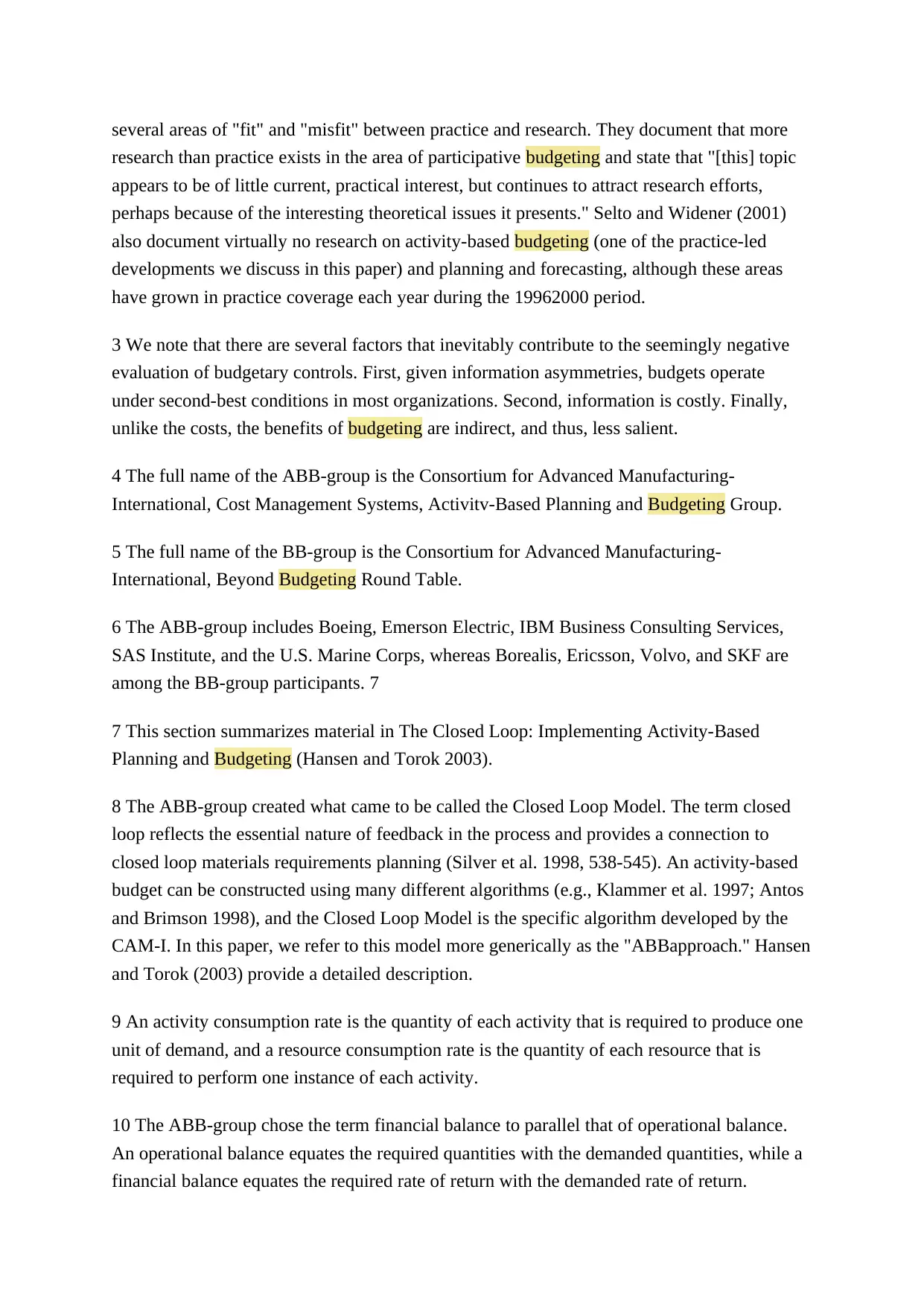
several areas of "fit" and "misfit" between practice and research. They document that more
research than practice exists in the area of participative budgeting and state that "[this] topic
appears to be of little current, practical interest, but continues to attract research efforts,
perhaps because of the interesting theoretical issues it presents." Selto and Widener (2001)
also document virtually no research on activity-based budgeting (one of the practice-led
developments we discuss in this paper) and planning and forecasting, although these areas
have grown in practice coverage each year during the 19962000 period.
3 We note that there are several factors that inevitably contribute to the seemingly negative
evaluation of budgetary controls. First, given information asymmetries, budgets operate
under second-best conditions in most organizations. Second, information is costly. Finally,
unlike the costs, the benefits of budgeting are indirect, and thus, less salient.
4 The full name of the ABB-group is the Consortium for Advanced Manufacturing-
International, Cost Management Systems, Activitv-Based Planning and Budgeting Group.
5 The full name of the BB-group is the Consortium for Advanced Manufacturing-
International, Beyond Budgeting Round Table.
6 The ABB-group includes Boeing, Emerson Electric, IBM Business Consulting Services,
SAS Institute, and the U.S. Marine Corps, whereas Borealis, Ericsson, Volvo, and SKF are
among the BB-group participants. 7
7 This section summarizes material in The Closed Loop: Implementing Activity-Based
Planning and Budgeting (Hansen and Torok 2003).
8 The ABB-group created what came to be called the Closed Loop Model. The term closed
loop reflects the essential nature of feedback in the process and provides a connection to
closed loop materials requirements planning (Silver et al. 1998, 538-545). An activity-based
budget can be constructed using many different algorithms (e.g., Klammer et al. 1997; Antos
and Brimson 1998), and the Closed Loop Model is the specific algorithm developed by the
CAM-I. In this paper, we refer to this model more generically as the "ABBapproach." Hansen
and Torok (2003) provide a detailed description.
9 An activity consumption rate is the quantity of each activity that is required to produce one
unit of demand, and a resource consumption rate is the quantity of each resource that is
required to perform one instance of each activity.
10 The ABB-group chose the term financial balance to parallel that of operational balance.
An operational balance equates the required quantities with the demanded quantities, while a
financial balance equates the required rate of return with the demanded rate of return.
research than practice exists in the area of participative budgeting and state that "[this] topic
appears to be of little current, practical interest, but continues to attract research efforts,
perhaps because of the interesting theoretical issues it presents." Selto and Widener (2001)
also document virtually no research on activity-based budgeting (one of the practice-led
developments we discuss in this paper) and planning and forecasting, although these areas
have grown in practice coverage each year during the 19962000 period.
3 We note that there are several factors that inevitably contribute to the seemingly negative
evaluation of budgetary controls. First, given information asymmetries, budgets operate
under second-best conditions in most organizations. Second, information is costly. Finally,
unlike the costs, the benefits of budgeting are indirect, and thus, less salient.
4 The full name of the ABB-group is the Consortium for Advanced Manufacturing-
International, Cost Management Systems, Activitv-Based Planning and Budgeting Group.
5 The full name of the BB-group is the Consortium for Advanced Manufacturing-
International, Beyond Budgeting Round Table.
6 The ABB-group includes Boeing, Emerson Electric, IBM Business Consulting Services,
SAS Institute, and the U.S. Marine Corps, whereas Borealis, Ericsson, Volvo, and SKF are
among the BB-group participants. 7
7 This section summarizes material in The Closed Loop: Implementing Activity-Based
Planning and Budgeting (Hansen and Torok 2003).
8 The ABB-group created what came to be called the Closed Loop Model. The term closed
loop reflects the essential nature of feedback in the process and provides a connection to
closed loop materials requirements planning (Silver et al. 1998, 538-545). An activity-based
budget can be constructed using many different algorithms (e.g., Klammer et al. 1997; Antos
and Brimson 1998), and the Closed Loop Model is the specific algorithm developed by the
CAM-I. In this paper, we refer to this model more generically as the "ABBapproach." Hansen
and Torok (2003) provide a detailed description.
9 An activity consumption rate is the quantity of each activity that is required to produce one
unit of demand, and a resource consumption rate is the quantity of each resource that is
required to perform one instance of each activity.
10 The ABB-group chose the term financial balance to parallel that of operational balance.
An operational balance equates the required quantities with the demanded quantities, while a
financial balance equates the required rate of return with the demanded rate of return.
Paraphrase This Document
Need a fresh take? Get an instant paraphrase of this document with our AI Paraphraser

11 This section is based on Beyond Budgeting: How Managers Can Break Free from the
Annual Performance Trap (Hope and Fraser 2003).
12 Willi the publication of The Impact of liudgels on People in 1952, Argyris was one of the
first to document dysfunctional behavioral effects of using budgets to measure and evaluate
performance. His book motivated a stream of work referred to as the reliance on accounting
performance measures (RAPM) literature. Representative papers in this area are Hopwood
(1972), Otley (1978), Hirst (1983), and Merchant (1985a, 1990). For an overview, see
Hartmann (2000).
13 The BB's hindsight component is different from flexible budgeting (or even variance
analysis) as a process of adjusting the budget for realized volume. The BB emphasizes
exploiting all relevant information, not just realized volume, that becomes available by the
end of the period, including subjective assessments. For example, flexible budgeting does not
lead to an adjustment when realized volume equals budgeted volume, but given the actual
circumstances faced, realized volume may not represent desired performance (especially
given competitors' achievements). However, the BB's hindsight idea is conceptually similar
to what Demski (1967) called ex post budgeting. The essence of an ex post budget is to revise
the original budget on the basis of additional information acquired during the budget period.
An ex post budget allows comparing three sets of results: budgeted (ex ante), realized
(observed), and revised (ex post) (Demski 1967, 702). Traditional variance analysis captures
the difference between the ex ante and observed results. Hindsight pertains to the difference
between the ex post and observed result, i.e., the' difference between what the firm should
have accomplished in light of actual events and what it did accomplish. The difference
between the ex ante and ex post result, i.e., the difference between what the firm planned to
do and what it should have planned to do, is an indicator of the firm's forecasting ability.
Although ex post budgets require certain subjective assessments (e.g., to determine the extent
to which deviations during the budget period were avoidable/controllable), they can
potentially contribute to improved liinclsifiht performance evaluations and better forecasting
and budgeting in future periods.
14 One survey of practice shows that 91 percent of the participating firms that use budgets
report that their budget was for a one-year period; 3 percent for a six-month period; and 1
percent for a three-month period (Umapathy 1987).
15 There is also a large operations management literature on capacity, planning, and
forecasting. (See Silver et al. 1998 for additional references.)
16 One recent study that examines the behavioral effects of reporting unused capacity on the
income statement takes a step in the direction of considering some organizational impacts of
Annual Performance Trap (Hope and Fraser 2003).
12 Willi the publication of The Impact of liudgels on People in 1952, Argyris was one of the
first to document dysfunctional behavioral effects of using budgets to measure and evaluate
performance. His book motivated a stream of work referred to as the reliance on accounting
performance measures (RAPM) literature. Representative papers in this area are Hopwood
(1972), Otley (1978), Hirst (1983), and Merchant (1985a, 1990). For an overview, see
Hartmann (2000).
13 The BB's hindsight component is different from flexible budgeting (or even variance
analysis) as a process of adjusting the budget for realized volume. The BB emphasizes
exploiting all relevant information, not just realized volume, that becomes available by the
end of the period, including subjective assessments. For example, flexible budgeting does not
lead to an adjustment when realized volume equals budgeted volume, but given the actual
circumstances faced, realized volume may not represent desired performance (especially
given competitors' achievements). However, the BB's hindsight idea is conceptually similar
to what Demski (1967) called ex post budgeting. The essence of an ex post budget is to revise
the original budget on the basis of additional information acquired during the budget period.
An ex post budget allows comparing three sets of results: budgeted (ex ante), realized
(observed), and revised (ex post) (Demski 1967, 702). Traditional variance analysis captures
the difference between the ex ante and observed results. Hindsight pertains to the difference
between the ex post and observed result, i.e., the' difference between what the firm should
have accomplished in light of actual events and what it did accomplish. The difference
between the ex ante and ex post result, i.e., the difference between what the firm planned to
do and what it should have planned to do, is an indicator of the firm's forecasting ability.
Although ex post budgets require certain subjective assessments (e.g., to determine the extent
to which deviations during the budget period were avoidable/controllable), they can
potentially contribute to improved liinclsifiht performance evaluations and better forecasting
and budgeting in future periods.
14 One survey of practice shows that 91 percent of the participating firms that use budgets
report that their budget was for a one-year period; 3 percent for a six-month period; and 1
percent for a three-month period (Umapathy 1987).
15 There is also a large operations management literature on capacity, planning, and
forecasting. (See Silver et al. 1998 for additional references.)
16 One recent study that examines the behavioral effects of reporting unused capacity on the
income statement takes a step in the direction of considering some organizational impacts of
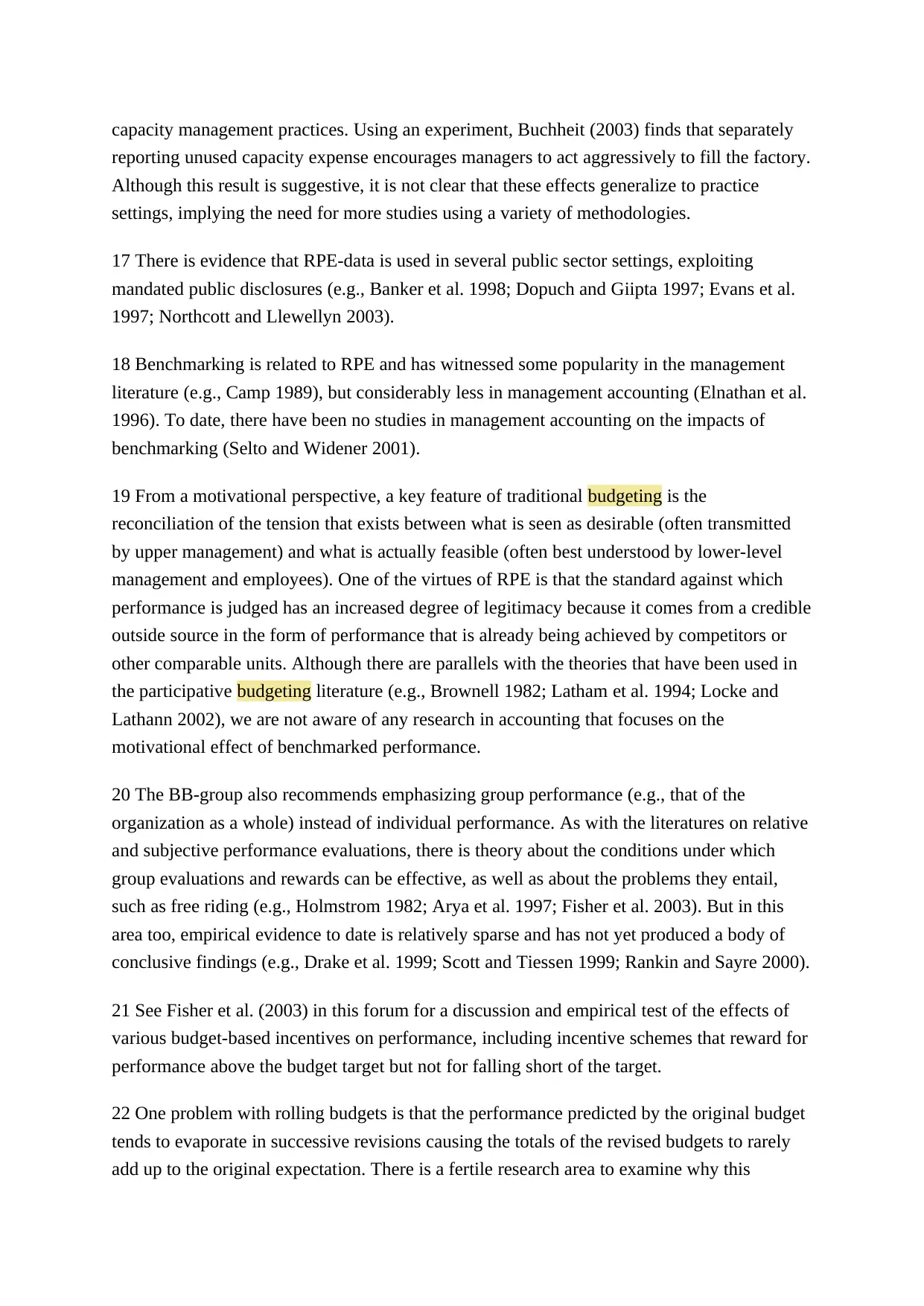
capacity management practices. Using an experiment, Buchheit (2003) finds that separately
reporting unused capacity expense encourages managers to act aggressively to fill the factory.
Although this result is suggestive, it is not clear that these effects generalize to practice
settings, implying the need for more studies using a variety of methodologies.
17 There is evidence that RPE-data is used in several public sector settings, exploiting
mandated public disclosures (e.g., Banker et al. 1998; Dopuch and Giipta 1997; Evans et al.
1997; Northcott and Llewellyn 2003).
18 Benchmarking is related to RPE and has witnessed some popularity in the management
literature (e.g., Camp 1989), but considerably less in management accounting (Elnathan et al.
1996). To date, there have been no studies in management accounting on the impacts of
benchmarking (Selto and Widener 2001).
19 From a motivational perspective, a key feature of traditional budgeting is the
reconciliation of the tension that exists between what is seen as desirable (often transmitted
by upper management) and what is actually feasible (often best understood by lower-level
management and employees). One of the virtues of RPE is that the standard against which
performance is judged has an increased degree of legitimacy because it comes from a credible
outside source in the form of performance that is already being achieved by competitors or
other comparable units. Although there are parallels with the theories that have been used in
the participative budgeting literature (e.g., Brownell 1982; Latham et al. 1994; Locke and
Lathann 2002), we are not aware of any research in accounting that focuses on the
motivational effect of benchmarked performance.
20 The BB-group also recommends emphasizing group performance (e.g., that of the
organization as a whole) instead of individual performance. As with the literatures on relative
and subjective performance evaluations, there is theory about the conditions under which
group evaluations and rewards can be effective, as well as about the problems they entail,
such as free riding (e.g., Holmstrom 1982; Arya et al. 1997; Fisher et al. 2003). But in this
area too, empirical evidence to date is relatively sparse and has not yet produced a body of
conclusive findings (e.g., Drake et al. 1999; Scott and Tiessen 1999; Rankin and Sayre 2000).
21 See Fisher et al. (2003) in this forum for a discussion and empirical test of the effects of
various budget-based incentives on performance, including incentive schemes that reward for
performance above the budget target but not for falling short of the target.
22 One problem with rolling budgets is that the performance predicted by the original budget
tends to evaporate in successive revisions causing the totals of the revised budgets to rarely
add up to the original expectation. There is a fertile research area to examine why this
reporting unused capacity expense encourages managers to act aggressively to fill the factory.
Although this result is suggestive, it is not clear that these effects generalize to practice
settings, implying the need for more studies using a variety of methodologies.
17 There is evidence that RPE-data is used in several public sector settings, exploiting
mandated public disclosures (e.g., Banker et al. 1998; Dopuch and Giipta 1997; Evans et al.
1997; Northcott and Llewellyn 2003).
18 Benchmarking is related to RPE and has witnessed some popularity in the management
literature (e.g., Camp 1989), but considerably less in management accounting (Elnathan et al.
1996). To date, there have been no studies in management accounting on the impacts of
benchmarking (Selto and Widener 2001).
19 From a motivational perspective, a key feature of traditional budgeting is the
reconciliation of the tension that exists between what is seen as desirable (often transmitted
by upper management) and what is actually feasible (often best understood by lower-level
management and employees). One of the virtues of RPE is that the standard against which
performance is judged has an increased degree of legitimacy because it comes from a credible
outside source in the form of performance that is already being achieved by competitors or
other comparable units. Although there are parallels with the theories that have been used in
the participative budgeting literature (e.g., Brownell 1982; Latham et al. 1994; Locke and
Lathann 2002), we are not aware of any research in accounting that focuses on the
motivational effect of benchmarked performance.
20 The BB-group also recommends emphasizing group performance (e.g., that of the
organization as a whole) instead of individual performance. As with the literatures on relative
and subjective performance evaluations, there is theory about the conditions under which
group evaluations and rewards can be effective, as well as about the problems they entail,
such as free riding (e.g., Holmstrom 1982; Arya et al. 1997; Fisher et al. 2003). But in this
area too, empirical evidence to date is relatively sparse and has not yet produced a body of
conclusive findings (e.g., Drake et al. 1999; Scott and Tiessen 1999; Rankin and Sayre 2000).
21 See Fisher et al. (2003) in this forum for a discussion and empirical test of the effects of
various budget-based incentives on performance, including incentive schemes that reward for
performance above the budget target but not for falling short of the target.
22 One problem with rolling budgets is that the performance predicted by the original budget
tends to evaporate in successive revisions causing the totals of the revised budgets to rarely
add up to the original expectation. There is a fertile research area to examine why this

happens and the circumstances where the feasibility of accurate budgets (e.g., for planning
purposes) is more important than the desirability of fixed budget targets that managers
commit to achieve despite changing conditions (e.g., as the basis for performance evaluation).
More research is also needed to understand how both purposes can be reconciled or
combined, as discussed in Merchant and Manzoni (1989) and Epstein and Manzoni (2001).
23 There is a parallel with Hopwood's (1972) distinction between budget-constrained and
profit-conscious evaluation styles, where the latter caused far less dysfunctional behavior
than the former. In particular, the relative emphasis on meeting fixed, short-term performance
targets in a rigidly enforced manner, compared with a more flexible style of evaluation,
where some subjective judgment is exercised and long-term effectiveness sought (strategic
concerns), is an important distinction that could contribute to understanding the claims made
by the budget critics. Prior work in this area (see Hartmann [2000] for an overview) has not
concentrated on exploring the rich variety of ways in which managers make use
of budgeting (and other, accounting and nonaccounting) information in performance
evaluation, motivation, and control. Rather, it has tended to use the instrument developed by
Hopwood (1972), which reflected the situation he observed in his research site, in a
mechanistic manner and imposed it through a questionnaire on managers who may have been
working in very different situations.
24 See Covaleski et al. (2003) in this forum for a discussion of how theories from economics,
psychology, and sociology, not just research methods, can be integrated to provide important
bases to enrich budgeting theory and research.
References
REFERENCES
Abernethy, M. A., and A. M. Lilis. 1995. The impact of manufacturing flexibility on
management control system design. Accounting, Organizations and Society 20 (4): 241-258.
Abrahamson, E. 1991. Managerial fads and fashions: The diffusion and rejection of
innovations. Academy of Management Review 16 (3): 586-612.
Anderson, S. W. 1995a. A framework for assessing cost management system changes: The
case of activity-based costing implementation at General Motors 1986-1993. Journal of
Management Accounting Research 7: 1-51.
____. 1995b. Measuring the impact of product mix heterogeneity on manufacturing overhead
cost. The Accounting Review 70 (3): 363-387.
purposes) is more important than the desirability of fixed budget targets that managers
commit to achieve despite changing conditions (e.g., as the basis for performance evaluation).
More research is also needed to understand how both purposes can be reconciled or
combined, as discussed in Merchant and Manzoni (1989) and Epstein and Manzoni (2001).
23 There is a parallel with Hopwood's (1972) distinction between budget-constrained and
profit-conscious evaluation styles, where the latter caused far less dysfunctional behavior
than the former. In particular, the relative emphasis on meeting fixed, short-term performance
targets in a rigidly enforced manner, compared with a more flexible style of evaluation,
where some subjective judgment is exercised and long-term effectiveness sought (strategic
concerns), is an important distinction that could contribute to understanding the claims made
by the budget critics. Prior work in this area (see Hartmann [2000] for an overview) has not
concentrated on exploring the rich variety of ways in which managers make use
of budgeting (and other, accounting and nonaccounting) information in performance
evaluation, motivation, and control. Rather, it has tended to use the instrument developed by
Hopwood (1972), which reflected the situation he observed in his research site, in a
mechanistic manner and imposed it through a questionnaire on managers who may have been
working in very different situations.
24 See Covaleski et al. (2003) in this forum for a discussion of how theories from economics,
psychology, and sociology, not just research methods, can be integrated to provide important
bases to enrich budgeting theory and research.
References
REFERENCES
Abernethy, M. A., and A. M. Lilis. 1995. The impact of manufacturing flexibility on
management control system design. Accounting, Organizations and Society 20 (4): 241-258.
Abrahamson, E. 1991. Managerial fads and fashions: The diffusion and rejection of
innovations. Academy of Management Review 16 (3): 586-612.
Anderson, S. W. 1995a. A framework for assessing cost management system changes: The
case of activity-based costing implementation at General Motors 1986-1993. Journal of
Management Accounting Research 7: 1-51.
____. 1995b. Measuring the impact of product mix heterogeneity on manufacturing overhead
cost. The Accounting Review 70 (3): 363-387.
Secure Best Marks with AI Grader
Need help grading? Try our AI Grader for instant feedback on your assignments.
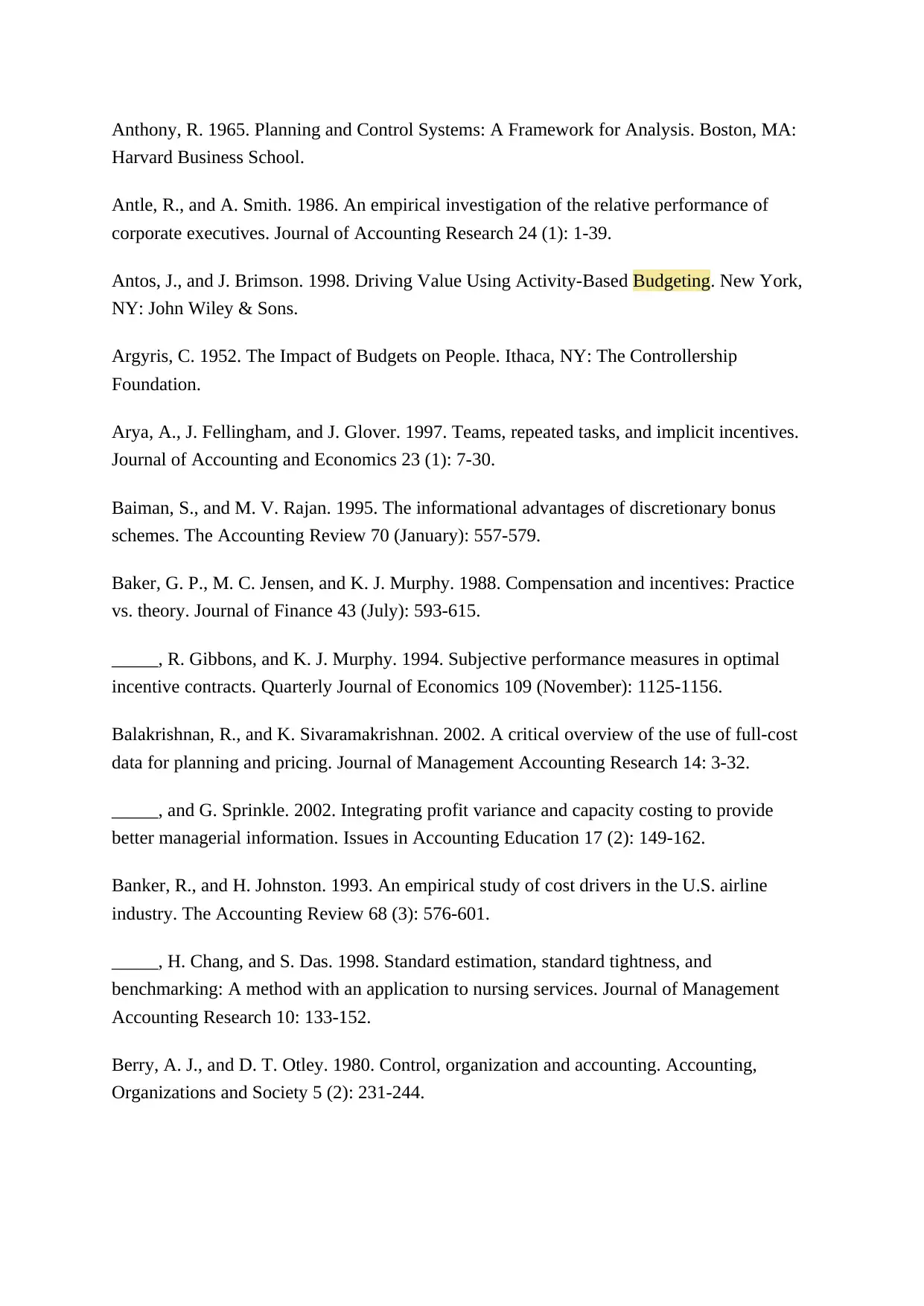
Anthony, R. 1965. Planning and Control Systems: A Framework for Analysis. Boston, MA:
Harvard Business School.
Antle, R., and A. Smith. 1986. An empirical investigation of the relative performance of
corporate executives. Journal of Accounting Research 24 (1): 1-39.
Antos, J., and J. Brimson. 1998. Driving Value Using Activity-Based Budgeting. New York,
NY: John Wiley & Sons.
Argyris, C. 1952. The Impact of Budgets on People. Ithaca, NY: The Controllership
Foundation.
Arya, A., J. Fellingham, and J. Glover. 1997. Teams, repeated tasks, and implicit incentives.
Journal of Accounting and Economics 23 (1): 7-30.
Baiman, S., and M. V. Rajan. 1995. The informational advantages of discretionary bonus
schemes. The Accounting Review 70 (January): 557-579.
Baker, G. P., M. C. Jensen, and K. J. Murphy. 1988. Compensation and incentives: Practice
vs. theory. Journal of Finance 43 (July): 593-615.
_____, R. Gibbons, and K. J. Murphy. 1994. Subjective performance measures in optimal
incentive contracts. Quarterly Journal of Economics 109 (November): 1125-1156.
Balakrishnan, R., and K. Sivaramakrishnan. 2002. A critical overview of the use of full-cost
data for planning and pricing. Journal of Management Accounting Research 14: 3-32.
_____, and G. Sprinkle. 2002. Integrating profit variance and capacity costing to provide
better managerial information. Issues in Accounting Education 17 (2): 149-162.
Banker, R., and H. Johnston. 1993. An empirical study of cost drivers in the U.S. airline
industry. The Accounting Review 68 (3): 576-601.
_____, H. Chang, and S. Das. 1998. Standard estimation, standard tightness, and
benchmarking: A method with an application to nursing services. Journal of Management
Accounting Research 10: 133-152.
Berry, A. J., and D. T. Otley. 1980. Control, organization and accounting. Accounting,
Organizations and Society 5 (2): 231-244.
Harvard Business School.
Antle, R., and A. Smith. 1986. An empirical investigation of the relative performance of
corporate executives. Journal of Accounting Research 24 (1): 1-39.
Antos, J., and J. Brimson. 1998. Driving Value Using Activity-Based Budgeting. New York,
NY: John Wiley & Sons.
Argyris, C. 1952. The Impact of Budgets on People. Ithaca, NY: The Controllership
Foundation.
Arya, A., J. Fellingham, and J. Glover. 1997. Teams, repeated tasks, and implicit incentives.
Journal of Accounting and Economics 23 (1): 7-30.
Baiman, S., and M. V. Rajan. 1995. The informational advantages of discretionary bonus
schemes. The Accounting Review 70 (January): 557-579.
Baker, G. P., M. C. Jensen, and K. J. Murphy. 1988. Compensation and incentives: Practice
vs. theory. Journal of Finance 43 (July): 593-615.
_____, R. Gibbons, and K. J. Murphy. 1994. Subjective performance measures in optimal
incentive contracts. Quarterly Journal of Economics 109 (November): 1125-1156.
Balakrishnan, R., and K. Sivaramakrishnan. 2002. A critical overview of the use of full-cost
data for planning and pricing. Journal of Management Accounting Research 14: 3-32.
_____, and G. Sprinkle. 2002. Integrating profit variance and capacity costing to provide
better managerial information. Issues in Accounting Education 17 (2): 149-162.
Banker, R., and H. Johnston. 1993. An empirical study of cost drivers in the U.S. airline
industry. The Accounting Review 68 (3): 576-601.
_____, H. Chang, and S. Das. 1998. Standard estimation, standard tightness, and
benchmarking: A method with an application to nursing services. Journal of Management
Accounting Research 10: 133-152.
Berry, A. J., and D. T. Otley. 1980. Control, organization and accounting. Accounting,
Organizations and Society 5 (2): 231-244.
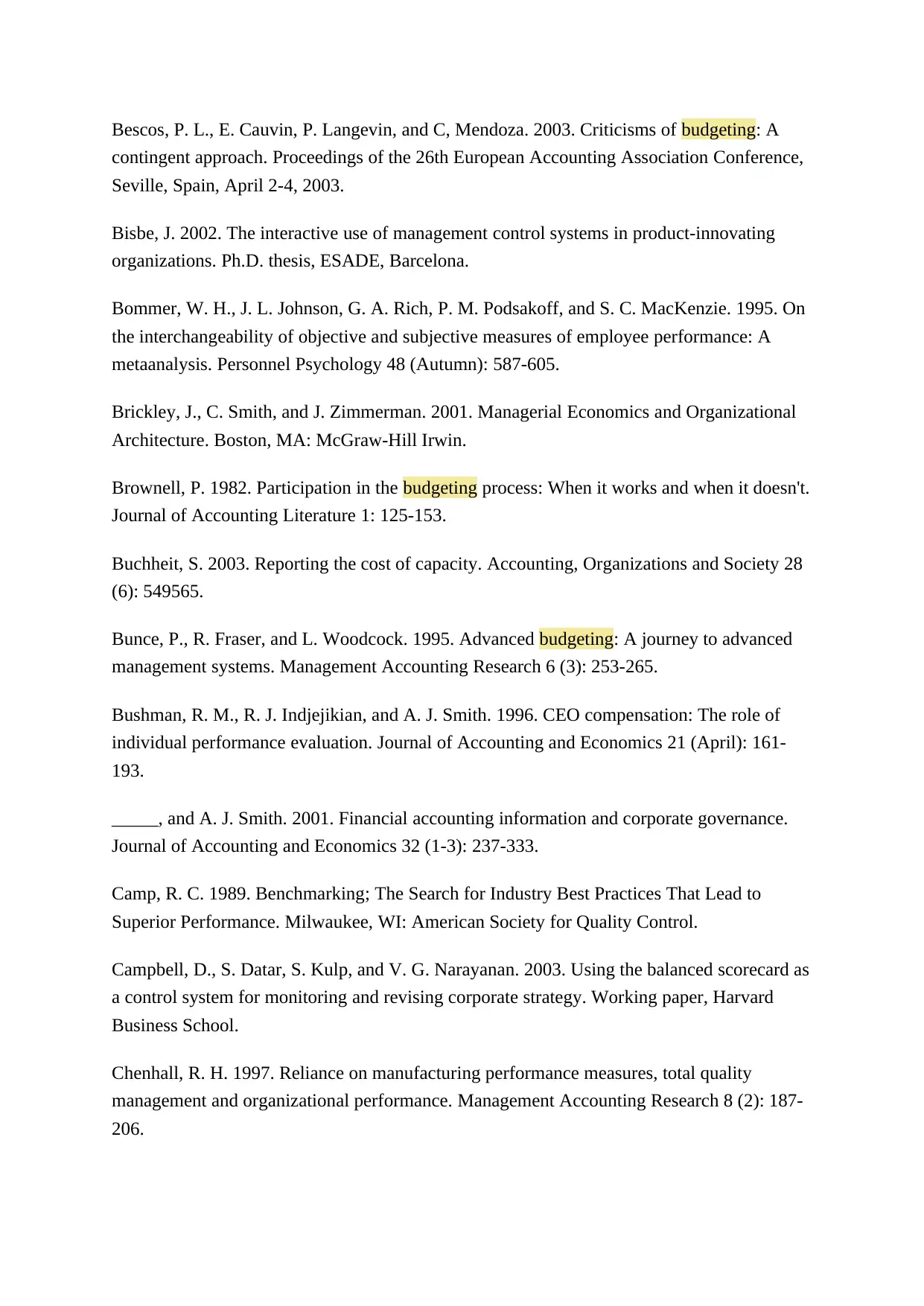
Bescos, P. L., E. Cauvin, P. Langevin, and C, Mendoza. 2003. Criticisms of budgeting: A
contingent approach. Proceedings of the 26th European Accounting Association Conference,
Seville, Spain, April 2-4, 2003.
Bisbe, J. 2002. The interactive use of management control systems in product-innovating
organizations. Ph.D. thesis, ESADE, Barcelona.
Bommer, W. H., J. L. Johnson, G. A. Rich, P. M. Podsakoff, and S. C. MacKenzie. 1995. On
the interchangeability of objective and subjective measures of employee performance: A
metaanalysis. Personnel Psychology 48 (Autumn): 587-605.
Brickley, J., C. Smith, and J. Zimmerman. 2001. Managerial Economics and Organizational
Architecture. Boston, MA: McGraw-Hill Irwin.
Brownell, P. 1982. Participation in the budgeting process: When it works and when it doesn't.
Journal of Accounting Literature 1: 125-153.
Buchheit, S. 2003. Reporting the cost of capacity. Accounting, Organizations and Society 28
(6): 549565.
Bunce, P., R. Fraser, and L. Woodcock. 1995. Advanced budgeting: A journey to advanced
management systems. Management Accounting Research 6 (3): 253-265.
Bushman, R. M., R. J. Indjejikian, and A. J. Smith. 1996. CEO compensation: The role of
individual performance evaluation. Journal of Accounting and Economics 21 (April): 161-
193.
_____, and A. J. Smith. 2001. Financial accounting information and corporate governance.
Journal of Accounting and Economics 32 (1-3): 237-333.
Camp, R. C. 1989. Benchmarking; The Search for Industry Best Practices That Lead to
Superior Performance. Milwaukee, WI: American Society for Quality Control.
Campbell, D., S. Datar, S. Kulp, and V. G. Narayanan. 2003. Using the balanced scorecard as
a control system for monitoring and revising corporate strategy. Working paper, Harvard
Business School.
Chenhall, R. H. 1997. Reliance on manufacturing performance measures, total quality
management and organizational performance. Management Accounting Research 8 (2): 187-
206.
contingent approach. Proceedings of the 26th European Accounting Association Conference,
Seville, Spain, April 2-4, 2003.
Bisbe, J. 2002. The interactive use of management control systems in product-innovating
organizations. Ph.D. thesis, ESADE, Barcelona.
Bommer, W. H., J. L. Johnson, G. A. Rich, P. M. Podsakoff, and S. C. MacKenzie. 1995. On
the interchangeability of objective and subjective measures of employee performance: A
metaanalysis. Personnel Psychology 48 (Autumn): 587-605.
Brickley, J., C. Smith, and J. Zimmerman. 2001. Managerial Economics and Organizational
Architecture. Boston, MA: McGraw-Hill Irwin.
Brownell, P. 1982. Participation in the budgeting process: When it works and when it doesn't.
Journal of Accounting Literature 1: 125-153.
Buchheit, S. 2003. Reporting the cost of capacity. Accounting, Organizations and Society 28
(6): 549565.
Bunce, P., R. Fraser, and L. Woodcock. 1995. Advanced budgeting: A journey to advanced
management systems. Management Accounting Research 6 (3): 253-265.
Bushman, R. M., R. J. Indjejikian, and A. J. Smith. 1996. CEO compensation: The role of
individual performance evaluation. Journal of Accounting and Economics 21 (April): 161-
193.
_____, and A. J. Smith. 2001. Financial accounting information and corporate governance.
Journal of Accounting and Economics 32 (1-3): 237-333.
Camp, R. C. 1989. Benchmarking; The Search for Industry Best Practices That Lead to
Superior Performance. Milwaukee, WI: American Society for Quality Control.
Campbell, D., S. Datar, S. Kulp, and V. G. Narayanan. 2003. Using the balanced scorecard as
a control system for monitoring and revising corporate strategy. Working paper, Harvard
Business School.
Chenhall, R. H. 1997. Reliance on manufacturing performance measures, total quality
management and organizational performance. Management Accounting Research 8 (2): 187-
206.

_____, and K. Langfield-Smith. 1998. The relationship between strategic priorities,
management techniques and management accounting: An empirical investigation using a
systems approach. Accounting, Organizations and Society 23 (3): 243-264.
_____. 2003. Management control systems design within its organizational context: Findings
from contingency-based research and directions for the future. Accounting, Organizations
and Society 28 (2-3): 127-168.
Comshare Survey of Top Financial Executives. 2000. Planning and Budgeting Today.
Available at http://www.comshare.com.
Covaleski, M. A., J. H. Evans, J. Luft, and M. D. Shields. 2003. An integrative perspective on
budgets and budgeting. Journal of Management Accounting Research 15: 3-49.
Damanpour, F, and W. Evan. 1984. Organizational innovation and performance: The problem
of "organizational lag." Administrative Science Quarterly 29: 392-409.
Daniel, S., and W. Reitsperger. 1991. Linking quality strategy with management control
systems: Empirical evidence from Japanese industry. Accounting, Organizations and Society
16 (7): 601 - 618.
Datar, S., S. Kekre, T. Mukhopadhyay, and K. Srinivasan. 1993. Simultaneous estimation of
cost drivers. The Accounting Review 68 (3): 603-614.
_____, and M. Gupta. 1994. Aggregation, specification, and measurement errors in product
costing. The Accounting Review 69 (4): 567-591.
Demski, J. S. 1967. An accounting system structured on a linear programming model. The
Accounting Review 42 (4): 701-712.
Dopuch, N., and M. Gupta. 1997. Estimation of benchmark performance standards: An
application to public school expenditures. Journal of Accounting & Economics 23 (2): 141-
161.
Drake, A. R., S. F. Haka, and S. P. Ravenscroft. 1999. Cost system and incentive structure
effects on innovation, efficiency, and profitability in teams. The Accounting Review 74 (3):
323-345.
Dye, R. A. 1992. Relative performance evaluation and project selection. Journal of
Accounting Research 30 (1): 27-52.
management techniques and management accounting: An empirical investigation using a
systems approach. Accounting, Organizations and Society 23 (3): 243-264.
_____. 2003. Management control systems design within its organizational context: Findings
from contingency-based research and directions for the future. Accounting, Organizations
and Society 28 (2-3): 127-168.
Comshare Survey of Top Financial Executives. 2000. Planning and Budgeting Today.
Available at http://www.comshare.com.
Covaleski, M. A., J. H. Evans, J. Luft, and M. D. Shields. 2003. An integrative perspective on
budgets and budgeting. Journal of Management Accounting Research 15: 3-49.
Damanpour, F, and W. Evan. 1984. Organizational innovation and performance: The problem
of "organizational lag." Administrative Science Quarterly 29: 392-409.
Daniel, S., and W. Reitsperger. 1991. Linking quality strategy with management control
systems: Empirical evidence from Japanese industry. Accounting, Organizations and Society
16 (7): 601 - 618.
Datar, S., S. Kekre, T. Mukhopadhyay, and K. Srinivasan. 1993. Simultaneous estimation of
cost drivers. The Accounting Review 68 (3): 603-614.
_____, and M. Gupta. 1994. Aggregation, specification, and measurement errors in product
costing. The Accounting Review 69 (4): 567-591.
Demski, J. S. 1967. An accounting system structured on a linear programming model. The
Accounting Review 42 (4): 701-712.
Dopuch, N., and M. Gupta. 1997. Estimation of benchmark performance standards: An
application to public school expenditures. Journal of Accounting & Economics 23 (2): 141-
161.
Drake, A. R., S. F. Haka, and S. P. Ravenscroft. 1999. Cost system and incentive structure
effects on innovation, efficiency, and profitability in teams. The Accounting Review 74 (3):
323-345.
Dye, R. A. 1992. Relative performance evaluation and project selection. Journal of
Accounting Research 30 (1): 27-52.
Paraphrase This Document
Need a fresh take? Get an instant paraphrase of this document with our AI Paraphraser
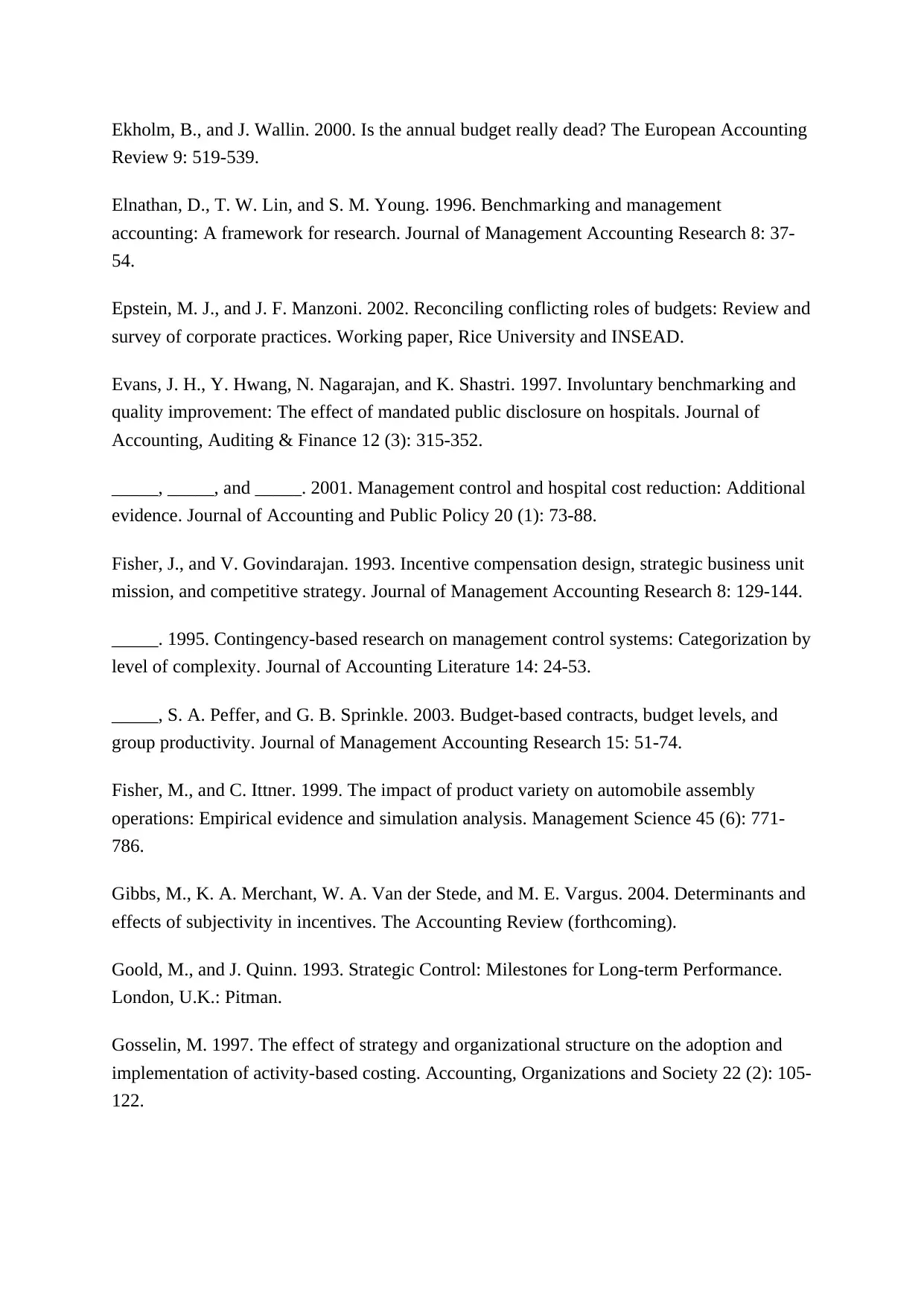
Ekholm, B., and J. Wallin. 2000. Is the annual budget really dead? The European Accounting
Review 9: 519-539.
Elnathan, D., T. W. Lin, and S. M. Young. 1996. Benchmarking and management
accounting: A framework for research. Journal of Management Accounting Research 8: 37-
54.
Epstein, M. J., and J. F. Manzoni. 2002. Reconciling conflicting roles of budgets: Review and
survey of corporate practices. Working paper, Rice University and INSEAD.
Evans, J. H., Y. Hwang, N. Nagarajan, and K. Shastri. 1997. Involuntary benchmarking and
quality improvement: The effect of mandated public disclosure on hospitals. Journal of
Accounting, Auditing & Finance 12 (3): 315-352.
_____, _____, and _____. 2001. Management control and hospital cost reduction: Additional
evidence. Journal of Accounting and Public Policy 20 (1): 73-88.
Fisher, J., and V. Govindarajan. 1993. Incentive compensation design, strategic business unit
mission, and competitive strategy. Journal of Management Accounting Research 8: 129-144.
_____. 1995. Contingency-based research on management control systems: Categorization by
level of complexity. Journal of Accounting Literature 14: 24-53.
_____, S. A. Peffer, and G. B. Sprinkle. 2003. Budget-based contracts, budget levels, and
group productivity. Journal of Management Accounting Research 15: 51-74.
Fisher, M., and C. Ittner. 1999. The impact of product variety on automobile assembly
operations: Empirical evidence and simulation analysis. Management Science 45 (6): 771-
786.
Gibbs, M., K. A. Merchant, W. A. Van der Stede, and M. E. Vargus. 2004. Determinants and
effects of subjectivity in incentives. The Accounting Review (forthcoming).
Goold, M., and J. Quinn. 1993. Strategic Control: Milestones for Long-term Performance.
London, U.K.: Pitman.
Gosselin, M. 1997. The effect of strategy and organizational structure on the adoption and
implementation of activity-based costing. Accounting, Organizations and Society 22 (2): 105-
122.
Review 9: 519-539.
Elnathan, D., T. W. Lin, and S. M. Young. 1996. Benchmarking and management
accounting: A framework for research. Journal of Management Accounting Research 8: 37-
54.
Epstein, M. J., and J. F. Manzoni. 2002. Reconciling conflicting roles of budgets: Review and
survey of corporate practices. Working paper, Rice University and INSEAD.
Evans, J. H., Y. Hwang, N. Nagarajan, and K. Shastri. 1997. Involuntary benchmarking and
quality improvement: The effect of mandated public disclosure on hospitals. Journal of
Accounting, Auditing & Finance 12 (3): 315-352.
_____, _____, and _____. 2001. Management control and hospital cost reduction: Additional
evidence. Journal of Accounting and Public Policy 20 (1): 73-88.
Fisher, J., and V. Govindarajan. 1993. Incentive compensation design, strategic business unit
mission, and competitive strategy. Journal of Management Accounting Research 8: 129-144.
_____. 1995. Contingency-based research on management control systems: Categorization by
level of complexity. Journal of Accounting Literature 14: 24-53.
_____, S. A. Peffer, and G. B. Sprinkle. 2003. Budget-based contracts, budget levels, and
group productivity. Journal of Management Accounting Research 15: 51-74.
Fisher, M., and C. Ittner. 1999. The impact of product variety on automobile assembly
operations: Empirical evidence and simulation analysis. Management Science 45 (6): 771-
786.
Gibbs, M., K. A. Merchant, W. A. Van der Stede, and M. E. Vargus. 2004. Determinants and
effects of subjectivity in incentives. The Accounting Review (forthcoming).
Goold, M., and J. Quinn. 1993. Strategic Control: Milestones for Long-term Performance.
London, U.K.: Pitman.
Gosselin, M. 1997. The effect of strategy and organizational structure on the adoption and
implementation of activity-based costing. Accounting, Organizations and Society 22 (2): 105-
122.
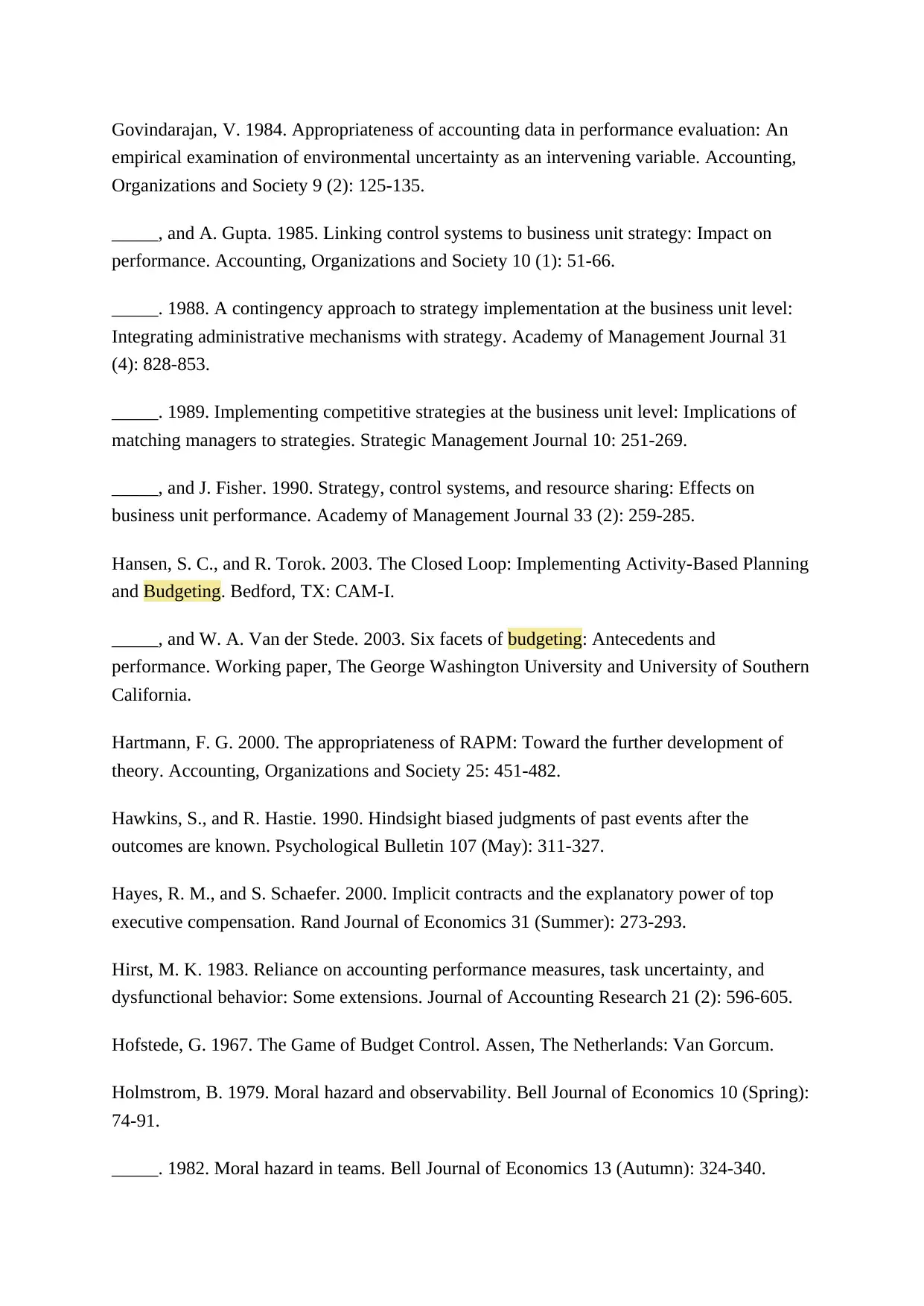
Govindarajan, V. 1984. Appropriateness of accounting data in performance evaluation: An
empirical examination of environmental uncertainty as an intervening variable. Accounting,
Organizations and Society 9 (2): 125-135.
_____, and A. Gupta. 1985. Linking control systems to business unit strategy: Impact on
performance. Accounting, Organizations and Society 10 (1): 51-66.
_____. 1988. A contingency approach to strategy implementation at the business unit level:
Integrating administrative mechanisms with strategy. Academy of Management Journal 31
(4): 828-853.
_____. 1989. Implementing competitive strategies at the business unit level: Implications of
matching managers to strategies. Strategic Management Journal 10: 251-269.
_____, and J. Fisher. 1990. Strategy, control systems, and resource sharing: Effects on
business unit performance. Academy of Management Journal 33 (2): 259-285.
Hansen, S. C., and R. Torok. 2003. The Closed Loop: Implementing Activity-Based Planning
and Budgeting. Bedford, TX: CAM-I.
_____, and W. A. Van der Stede. 2003. Six facets of budgeting: Antecedents and
performance. Working paper, The George Washington University and University of Southern
California.
Hartmann, F. G. 2000. The appropriateness of RAPM: Toward the further development of
theory. Accounting, Organizations and Society 25: 451-482.
Hawkins, S., and R. Hastie. 1990. Hindsight biased judgments of past events after the
outcomes are known. Psychological Bulletin 107 (May): 311-327.
Hayes, R. M., and S. Schaefer. 2000. Implicit contracts and the explanatory power of top
executive compensation. Rand Journal of Economics 31 (Summer): 273-293.
Hirst, M. K. 1983. Reliance on accounting performance measures, task uncertainty, and
dysfunctional behavior: Some extensions. Journal of Accounting Research 21 (2): 596-605.
Hofstede, G. 1967. The Game of Budget Control. Assen, The Netherlands: Van Gorcum.
Holmstrom, B. 1979. Moral hazard and observability. Bell Journal of Economics 10 (Spring):
74-91.
_____. 1982. Moral hazard in teams. Bell Journal of Economics 13 (Autumn): 324-340.
empirical examination of environmental uncertainty as an intervening variable. Accounting,
Organizations and Society 9 (2): 125-135.
_____, and A. Gupta. 1985. Linking control systems to business unit strategy: Impact on
performance. Accounting, Organizations and Society 10 (1): 51-66.
_____. 1988. A contingency approach to strategy implementation at the business unit level:
Integrating administrative mechanisms with strategy. Academy of Management Journal 31
(4): 828-853.
_____. 1989. Implementing competitive strategies at the business unit level: Implications of
matching managers to strategies. Strategic Management Journal 10: 251-269.
_____, and J. Fisher. 1990. Strategy, control systems, and resource sharing: Effects on
business unit performance. Academy of Management Journal 33 (2): 259-285.
Hansen, S. C., and R. Torok. 2003. The Closed Loop: Implementing Activity-Based Planning
and Budgeting. Bedford, TX: CAM-I.
_____, and W. A. Van der Stede. 2003. Six facets of budgeting: Antecedents and
performance. Working paper, The George Washington University and University of Southern
California.
Hartmann, F. G. 2000. The appropriateness of RAPM: Toward the further development of
theory. Accounting, Organizations and Society 25: 451-482.
Hawkins, S., and R. Hastie. 1990. Hindsight biased judgments of past events after the
outcomes are known. Psychological Bulletin 107 (May): 311-327.
Hayes, R. M., and S. Schaefer. 2000. Implicit contracts and the explanatory power of top
executive compensation. Rand Journal of Economics 31 (Summer): 273-293.
Hirst, M. K. 1983. Reliance on accounting performance measures, task uncertainty, and
dysfunctional behavior: Some extensions. Journal of Accounting Research 21 (2): 596-605.
Hofstede, G. 1967. The Game of Budget Control. Assen, The Netherlands: Van Gorcum.
Holmstrom, B. 1979. Moral hazard and observability. Bell Journal of Economics 10 (Spring):
74-91.
_____. 1982. Moral hazard in teams. Bell Journal of Economics 13 (Autumn): 324-340.
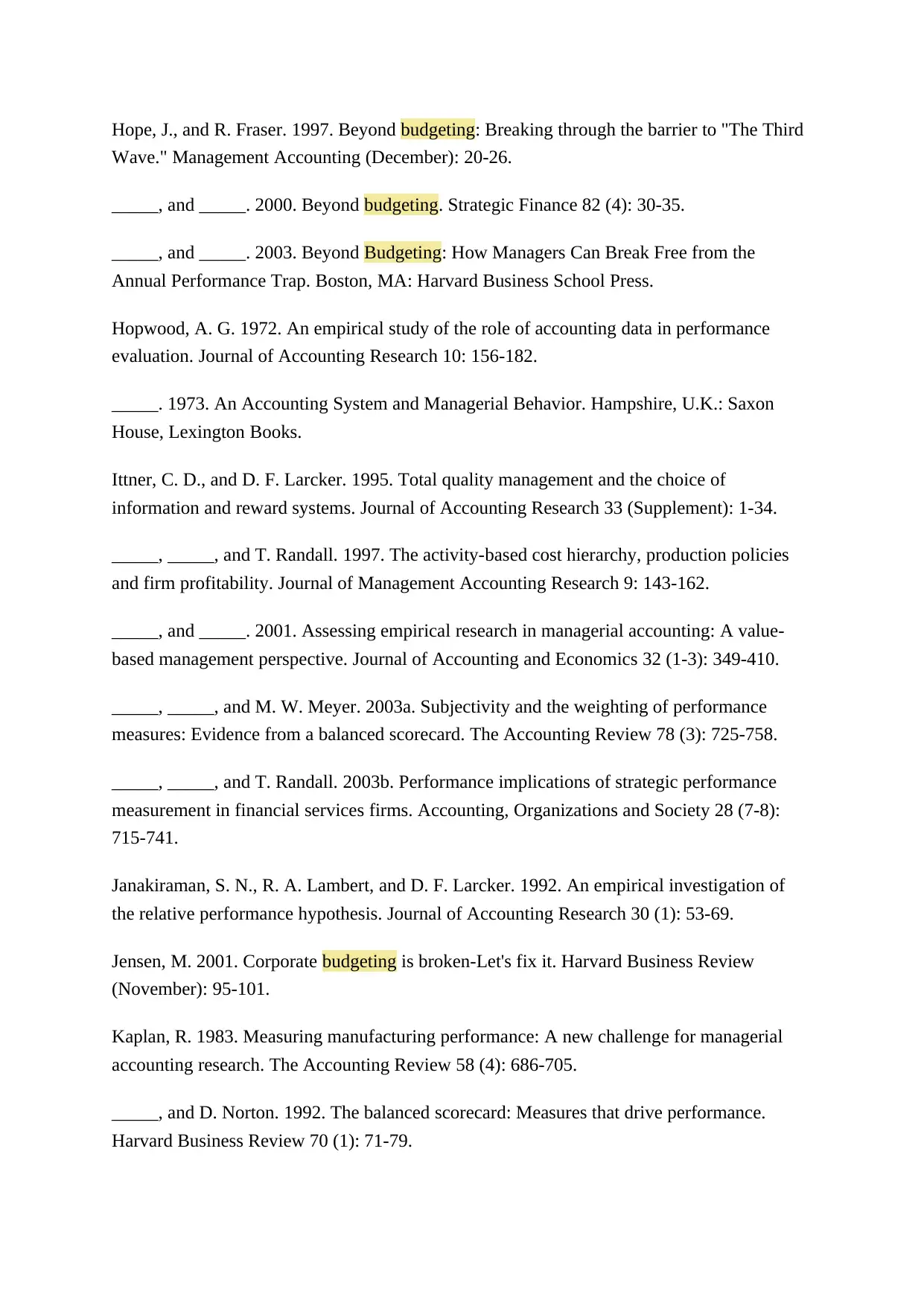
Hope, J., and R. Fraser. 1997. Beyond budgeting: Breaking through the barrier to "The Third
Wave." Management Accounting (December): 20-26.
_____, and _____. 2000. Beyond budgeting. Strategic Finance 82 (4): 30-35.
_____, and _____. 2003. Beyond Budgeting: How Managers Can Break Free from the
Annual Performance Trap. Boston, MA: Harvard Business School Press.
Hopwood, A. G. 1972. An empirical study of the role of accounting data in performance
evaluation. Journal of Accounting Research 10: 156-182.
_____. 1973. An Accounting System and Managerial Behavior. Hampshire, U.K.: Saxon
House, Lexington Books.
Ittner, C. D., and D. F. Larcker. 1995. Total quality management and the choice of
information and reward systems. Journal of Accounting Research 33 (Supplement): 1-34.
_____, _____, and T. Randall. 1997. The activity-based cost hierarchy, production policies
and firm profitability. Journal of Management Accounting Research 9: 143-162.
_____, and _____. 2001. Assessing empirical research in managerial accounting: A value-
based management perspective. Journal of Accounting and Economics 32 (1-3): 349-410.
_____, _____, and M. W. Meyer. 2003a. Subjectivity and the weighting of performance
measures: Evidence from a balanced scorecard. The Accounting Review 78 (3): 725-758.
_____, _____, and T. Randall. 2003b. Performance implications of strategic performance
measurement in financial services firms. Accounting, Organizations and Society 28 (7-8):
715-741.
Janakiraman, S. N., R. A. Lambert, and D. F. Larcker. 1992. An empirical investigation of
the relative performance hypothesis. Journal of Accounting Research 30 (1): 53-69.
Jensen, M. 2001. Corporate budgeting is broken-Let's fix it. Harvard Business Review
(November): 95-101.
Kaplan, R. 1983. Measuring manufacturing performance: A new challenge for managerial
accounting research. The Accounting Review 58 (4): 686-705.
_____, and D. Norton. 1992. The balanced scorecard: Measures that drive performance.
Harvard Business Review 70 (1): 71-79.
Wave." Management Accounting (December): 20-26.
_____, and _____. 2000. Beyond budgeting. Strategic Finance 82 (4): 30-35.
_____, and _____. 2003. Beyond Budgeting: How Managers Can Break Free from the
Annual Performance Trap. Boston, MA: Harvard Business School Press.
Hopwood, A. G. 1972. An empirical study of the role of accounting data in performance
evaluation. Journal of Accounting Research 10: 156-182.
_____. 1973. An Accounting System and Managerial Behavior. Hampshire, U.K.: Saxon
House, Lexington Books.
Ittner, C. D., and D. F. Larcker. 1995. Total quality management and the choice of
information and reward systems. Journal of Accounting Research 33 (Supplement): 1-34.
_____, _____, and T. Randall. 1997. The activity-based cost hierarchy, production policies
and firm profitability. Journal of Management Accounting Research 9: 143-162.
_____, and _____. 2001. Assessing empirical research in managerial accounting: A value-
based management perspective. Journal of Accounting and Economics 32 (1-3): 349-410.
_____, _____, and M. W. Meyer. 2003a. Subjectivity and the weighting of performance
measures: Evidence from a balanced scorecard. The Accounting Review 78 (3): 725-758.
_____, _____, and T. Randall. 2003b. Performance implications of strategic performance
measurement in financial services firms. Accounting, Organizations and Society 28 (7-8):
715-741.
Janakiraman, S. N., R. A. Lambert, and D. F. Larcker. 1992. An empirical investigation of
the relative performance hypothesis. Journal of Accounting Research 30 (1): 53-69.
Jensen, M. 2001. Corporate budgeting is broken-Let's fix it. Harvard Business Review
(November): 95-101.
Kaplan, R. 1983. Measuring manufacturing performance: A new challenge for managerial
accounting research. The Accounting Review 58 (4): 686-705.
_____, and D. Norton. 1992. The balanced scorecard: Measures that drive performance.
Harvard Business Review 70 (1): 71-79.
Secure Best Marks with AI Grader
Need help grading? Try our AI Grader for instant feedback on your assignments.
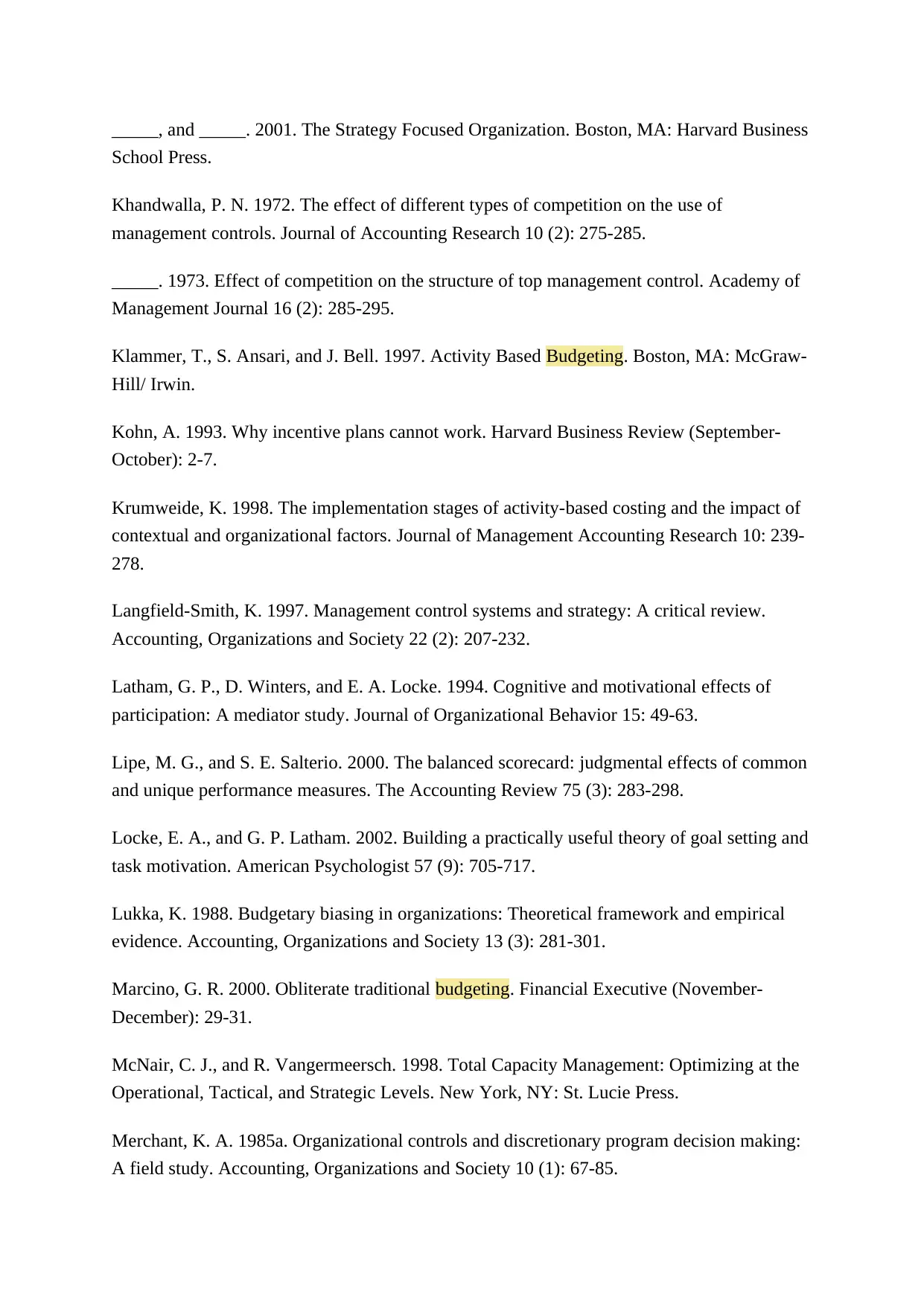
_____, and _____. 2001. The Strategy Focused Organization. Boston, MA: Harvard Business
School Press.
Khandwalla, P. N. 1972. The effect of different types of competition on the use of
management controls. Journal of Accounting Research 10 (2): 275-285.
_____. 1973. Effect of competition on the structure of top management control. Academy of
Management Journal 16 (2): 285-295.
Klammer, T., S. Ansari, and J. Bell. 1997. Activity Based Budgeting. Boston, MA: McGraw-
Hill/ Irwin.
Kohn, A. 1993. Why incentive plans cannot work. Harvard Business Review (September-
October): 2-7.
Krumweide, K. 1998. The implementation stages of activity-based costing and the impact of
contextual and organizational factors. Journal of Management Accounting Research 10: 239-
278.
Langfield-Smith, K. 1997. Management control systems and strategy: A critical review.
Accounting, Organizations and Society 22 (2): 207-232.
Latham, G. P., D. Winters, and E. A. Locke. 1994. Cognitive and motivational effects of
participation: A mediator study. Journal of Organizational Behavior 15: 49-63.
Lipe, M. G., and S. E. Salterio. 2000. The balanced scorecard: judgmental effects of common
and unique performance measures. The Accounting Review 75 (3): 283-298.
Locke, E. A., and G. P. Latham. 2002. Building a practically useful theory of goal setting and
task motivation. American Psychologist 57 (9): 705-717.
Lukka, K. 1988. Budgetary biasing in organizations: Theoretical framework and empirical
evidence. Accounting, Organizations and Society 13 (3): 281-301.
Marcino, G. R. 2000. Obliterate traditional budgeting. Financial Executive (November-
December): 29-31.
McNair, C. J., and R. Vangermeersch. 1998. Total Capacity Management: Optimizing at the
Operational, Tactical, and Strategic Levels. New York, NY: St. Lucie Press.
Merchant, K. A. 1985a. Organizational controls and discretionary program decision making:
A field study. Accounting, Organizations and Society 10 (1): 67-85.
School Press.
Khandwalla, P. N. 1972. The effect of different types of competition on the use of
management controls. Journal of Accounting Research 10 (2): 275-285.
_____. 1973. Effect of competition on the structure of top management control. Academy of
Management Journal 16 (2): 285-295.
Klammer, T., S. Ansari, and J. Bell. 1997. Activity Based Budgeting. Boston, MA: McGraw-
Hill/ Irwin.
Kohn, A. 1993. Why incentive plans cannot work. Harvard Business Review (September-
October): 2-7.
Krumweide, K. 1998. The implementation stages of activity-based costing and the impact of
contextual and organizational factors. Journal of Management Accounting Research 10: 239-
278.
Langfield-Smith, K. 1997. Management control systems and strategy: A critical review.
Accounting, Organizations and Society 22 (2): 207-232.
Latham, G. P., D. Winters, and E. A. Locke. 1994. Cognitive and motivational effects of
participation: A mediator study. Journal of Organizational Behavior 15: 49-63.
Lipe, M. G., and S. E. Salterio. 2000. The balanced scorecard: judgmental effects of common
and unique performance measures. The Accounting Review 75 (3): 283-298.
Locke, E. A., and G. P. Latham. 2002. Building a practically useful theory of goal setting and
task motivation. American Psychologist 57 (9): 705-717.
Lukka, K. 1988. Budgetary biasing in organizations: Theoretical framework and empirical
evidence. Accounting, Organizations and Society 13 (3): 281-301.
Marcino, G. R. 2000. Obliterate traditional budgeting. Financial Executive (November-
December): 29-31.
McNair, C. J., and R. Vangermeersch. 1998. Total Capacity Management: Optimizing at the
Operational, Tactical, and Strategic Levels. New York, NY: St. Lucie Press.
Merchant, K. A. 1985a. Organizational controls and discretionary program decision making:
A field study. Accounting, Organizations and Society 10 (1): 67-85.

_____. 1985b. Budgeting and the propensity to create budgetary slack. Accounting,
Organizations and Society 10 (2): 201-210.
_____, and J. F. Manzoni. 1989. The achievability of budget targets in profit centers: A field
study. The Accounting Review 64 (3): 539-558.
_____. 1990. The effects of financial controls on data manipulation and management myopia.
Accounting, Organizations and Society 15 (4): 297-313.
_____, W. A. Van der Stede, and L. Zheng. 2003. Disciplinary constraints on the
advancement of knowledge: The case of organizational incentive systems. Accounting,
Organizations and Society 28 (2): 251-286.
Milgrom, P. 1988. Employment contracts, influence activities, and efficient organization
design. Journal of Political Economy 96 (February): 42-60.
_____, and J. Roberts. 1992. Economics, Organization and Management. Englewood Cliffs,
NJ: Prentice Hall.
Mintzberg, H. 1978. Patterns in strategy formation. Management Science 24 (9): 934-948.
_____, and J. A. Waters. 1985. Of strategies, deliberate and emergent. Strategic Management
Journal 6: 257-272.
Murphy, K. J., and P. Oyer. 2003. Discretion in executive incentive contracts: Theory and
evidence. Working paper, University of Southern California and Stanford University.
Nagar, V. 2002. Delegation and incentive compensation. The Accounting Review 77 (2):
379-395.
Neely, A., M. R. Sutcliff, and H. R. Heyns. 2001. Driving Value Through Strategic Planning
and Budgeting. New York, NY: Accenture.
Northcott, D., and S. Llewellyn. 2003. The "ladder of success" in healthcare: The U.K.
national reference costing index. Management Accounting Research 14 (1): 51-66.
Onsi, M. 1973. Factor analysis of behavioral variables affecting budgetary slack. The
Accounting Review 48 (3): 535-548.
Otley, D. T. 1978. Budget use and managerial performance. Journal of Accounting Research
16: 122149.
Organizations and Society 10 (2): 201-210.
_____, and J. F. Manzoni. 1989. The achievability of budget targets in profit centers: A field
study. The Accounting Review 64 (3): 539-558.
_____. 1990. The effects of financial controls on data manipulation and management myopia.
Accounting, Organizations and Society 15 (4): 297-313.
_____, W. A. Van der Stede, and L. Zheng. 2003. Disciplinary constraints on the
advancement of knowledge: The case of organizational incentive systems. Accounting,
Organizations and Society 28 (2): 251-286.
Milgrom, P. 1988. Employment contracts, influence activities, and efficient organization
design. Journal of Political Economy 96 (February): 42-60.
_____, and J. Roberts. 1992. Economics, Organization and Management. Englewood Cliffs,
NJ: Prentice Hall.
Mintzberg, H. 1978. Patterns in strategy formation. Management Science 24 (9): 934-948.
_____, and J. A. Waters. 1985. Of strategies, deliberate and emergent. Strategic Management
Journal 6: 257-272.
Murphy, K. J., and P. Oyer. 2003. Discretion in executive incentive contracts: Theory and
evidence. Working paper, University of Southern California and Stanford University.
Nagar, V. 2002. Delegation and incentive compensation. The Accounting Review 77 (2):
379-395.
Neely, A., M. R. Sutcliff, and H. R. Heyns. 2001. Driving Value Through Strategic Planning
and Budgeting. New York, NY: Accenture.
Northcott, D., and S. Llewellyn. 2003. The "ladder of success" in healthcare: The U.K.
national reference costing index. Management Accounting Research 14 (1): 51-66.
Onsi, M. 1973. Factor analysis of behavioral variables affecting budgetary slack. The
Accounting Review 48 (3): 535-548.
Otley, D. T. 1978. Budget use and managerial performance. Journal of Accounting Research
16: 122149.

_____. 1980. The contingency theory of management accounting: Achievement and
prognosis. Ao counting, Organizations and Society 5 (4): 413-428.
_____. 1999. Performance management: A framework for management control systems
research. Management Accounting Research 10: 363-382.
_____. 2001. Extending the boundaries of management accounting research: Developing
systems for performance management. British Accounting Review 33 (3): 243-261.
Ouchi, W. G. 1979. A conceptual framework for the design of organizational control
mechanisms. Management Science 25 (9): 833-848.
_____. 1980. Markets, bureaucracies and clans. Administrative Science Quarterly 25: 129-
141.
Perera, S., G. Harrison, and M. Poole. 1997. Customer-focused manufacturing strategy and
the use of operation-based non-financial performance measures: A research note. Accounting,
Organizations and Society 22 (6): 557-572.
Player, S., and D. Keys. 1996. Activity-Based Management: Arthur Andersen's Lessons from
the ABM Battlefield. New York, NY: MasterMedia, Ltd.
Prendergast, C., and R. Topel. 1993. Discretion and bias in performance evaluation.
European Economic Review 37 (April): 355-365.
Rankin, F. W., and T. L. Sayre. 2000. The effects of performance separability and contract
type on agent effort. Accounting, Organizations and Society 25 (7): 683-695.
Reiff, S. D. 2001. Speeding up planning and budgeting. Financial Executive 17 (6): 44-46.
Rogers, E. 1995. Diffusion of Innovations. New York, NY: The Free Press.
Samuelson, L. 2000. The effects of increasing turbulence on organizational control: Some
reflections. In The Current State of Business Disciplines, Management Volume 5, edited by
S. B. Dahiya, 2017-2090. Rohtak, India: Spellbound.
Scapens, R. W., and J. Roberts. 1993. Accounting and control: A case study of resistance to
accounting change. Management Accounting Research 4 (1): 1-31.
Schmidt, J. A. 1992. Is it time to replace traditional budgeting? Journal of Accountancy
(October): 103-107.
prognosis. Ao counting, Organizations and Society 5 (4): 413-428.
_____. 1999. Performance management: A framework for management control systems
research. Management Accounting Research 10: 363-382.
_____. 2001. Extending the boundaries of management accounting research: Developing
systems for performance management. British Accounting Review 33 (3): 243-261.
Ouchi, W. G. 1979. A conceptual framework for the design of organizational control
mechanisms. Management Science 25 (9): 833-848.
_____. 1980. Markets, bureaucracies and clans. Administrative Science Quarterly 25: 129-
141.
Perera, S., G. Harrison, and M. Poole. 1997. Customer-focused manufacturing strategy and
the use of operation-based non-financial performance measures: A research note. Accounting,
Organizations and Society 22 (6): 557-572.
Player, S., and D. Keys. 1996. Activity-Based Management: Arthur Andersen's Lessons from
the ABM Battlefield. New York, NY: MasterMedia, Ltd.
Prendergast, C., and R. Topel. 1993. Discretion and bias in performance evaluation.
European Economic Review 37 (April): 355-365.
Rankin, F. W., and T. L. Sayre. 2000. The effects of performance separability and contract
type on agent effort. Accounting, Organizations and Society 25 (7): 683-695.
Reiff, S. D. 2001. Speeding up planning and budgeting. Financial Executive 17 (6): 44-46.
Rogers, E. 1995. Diffusion of Innovations. New York, NY: The Free Press.
Samuelson, L. 2000. The effects of increasing turbulence on organizational control: Some
reflections. In The Current State of Business Disciplines, Management Volume 5, edited by
S. B. Dahiya, 2017-2090. Rohtak, India: Spellbound.
Scapens, R. W., and J. Roberts. 1993. Accounting and control: A case study of resistance to
accounting change. Management Accounting Research 4 (1): 1-31.
Schmidt, J. A. 1992. Is it time to replace traditional budgeting? Journal of Accountancy
(October): 103-107.
Paraphrase This Document
Need a fresh take? Get an instant paraphrase of this document with our AI Paraphraser
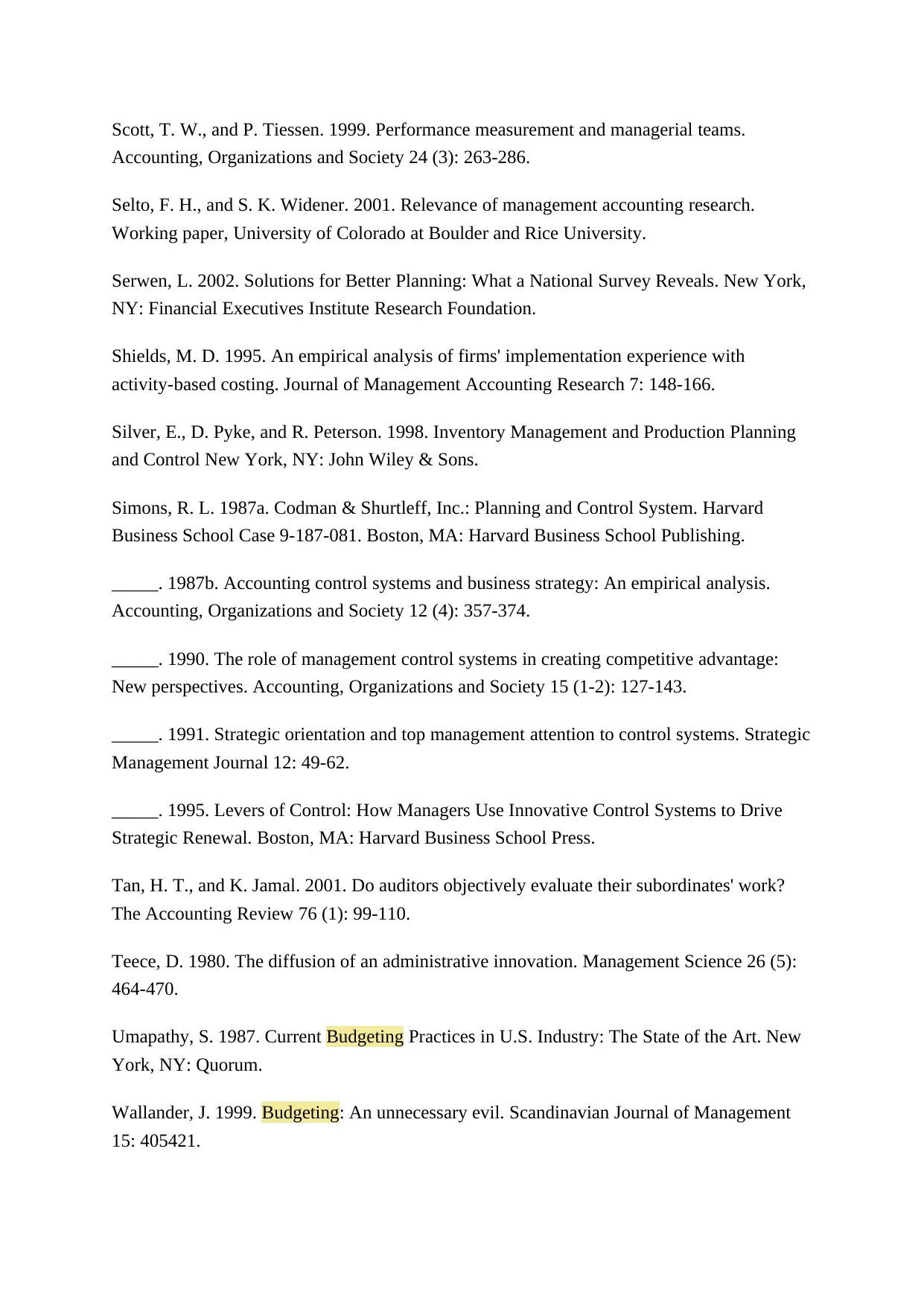
Scott, T. W., and P. Tiessen. 1999. Performance measurement and managerial teams.
Accounting, Organizations and Society 24 (3): 263-286.
Selto, F. H., and S. K. Widener. 2001. Relevance of management accounting research.
Working paper, University of Colorado at Boulder and Rice University.
Serwen, L. 2002. Solutions for Better Planning: What a National Survey Reveals. New York,
NY: Financial Executives Institute Research Foundation.
Shields, M. D. 1995. An empirical analysis of firms' implementation experience with
activity-based costing. Journal of Management Accounting Research 7: 148-166.
Silver, E., D. Pyke, and R. Peterson. 1998. Inventory Management and Production Planning
and Control New York, NY: John Wiley & Sons.
Simons, R. L. 1987a. Codman & Shurtleff, Inc.: Planning and Control System. Harvard
Business School Case 9-187-081. Boston, MA: Harvard Business School Publishing.
_____. 1987b. Accounting control systems and business strategy: An empirical analysis.
Accounting, Organizations and Society 12 (4): 357-374.
_____. 1990. The role of management control systems in creating competitive advantage:
New perspectives. Accounting, Organizations and Society 15 (1-2): 127-143.
_____. 1991. Strategic orientation and top management attention to control systems. Strategic
Management Journal 12: 49-62.
_____. 1995. Levers of Control: How Managers Use Innovative Control Systems to Drive
Strategic Renewal. Boston, MA: Harvard Business School Press.
Tan, H. T., and K. Jamal. 2001. Do auditors objectively evaluate their subordinates' work?
The Accounting Review 76 (1): 99-110.
Teece, D. 1980. The diffusion of an administrative innovation. Management Science 26 (5):
464-470.
Umapathy, S. 1987. Current Budgeting Practices in U.S. Industry: The State of the Art. New
York, NY: Quorum.
Wallander, J. 1999. Budgeting: An unnecessary evil. Scandinavian Journal of Management
15: 405421.
Accounting, Organizations and Society 24 (3): 263-286.
Selto, F. H., and S. K. Widener. 2001. Relevance of management accounting research.
Working paper, University of Colorado at Boulder and Rice University.
Serwen, L. 2002. Solutions for Better Planning: What a National Survey Reveals. New York,
NY: Financial Executives Institute Research Foundation.
Shields, M. D. 1995. An empirical analysis of firms' implementation experience with
activity-based costing. Journal of Management Accounting Research 7: 148-166.
Silver, E., D. Pyke, and R. Peterson. 1998. Inventory Management and Production Planning
and Control New York, NY: John Wiley & Sons.
Simons, R. L. 1987a. Codman & Shurtleff, Inc.: Planning and Control System. Harvard
Business School Case 9-187-081. Boston, MA: Harvard Business School Publishing.
_____. 1987b. Accounting control systems and business strategy: An empirical analysis.
Accounting, Organizations and Society 12 (4): 357-374.
_____. 1990. The role of management control systems in creating competitive advantage:
New perspectives. Accounting, Organizations and Society 15 (1-2): 127-143.
_____. 1991. Strategic orientation and top management attention to control systems. Strategic
Management Journal 12: 49-62.
_____. 1995. Levers of Control: How Managers Use Innovative Control Systems to Drive
Strategic Renewal. Boston, MA: Harvard Business School Press.
Tan, H. T., and K. Jamal. 2001. Do auditors objectively evaluate their subordinates' work?
The Accounting Review 76 (1): 99-110.
Teece, D. 1980. The diffusion of an administrative innovation. Management Science 26 (5):
464-470.
Umapathy, S. 1987. Current Budgeting Practices in U.S. Industry: The State of the Art. New
York, NY: Quorum.
Wallander, J. 1999. Budgeting: An unnecessary evil. Scandinavian Journal of Management
15: 405421.
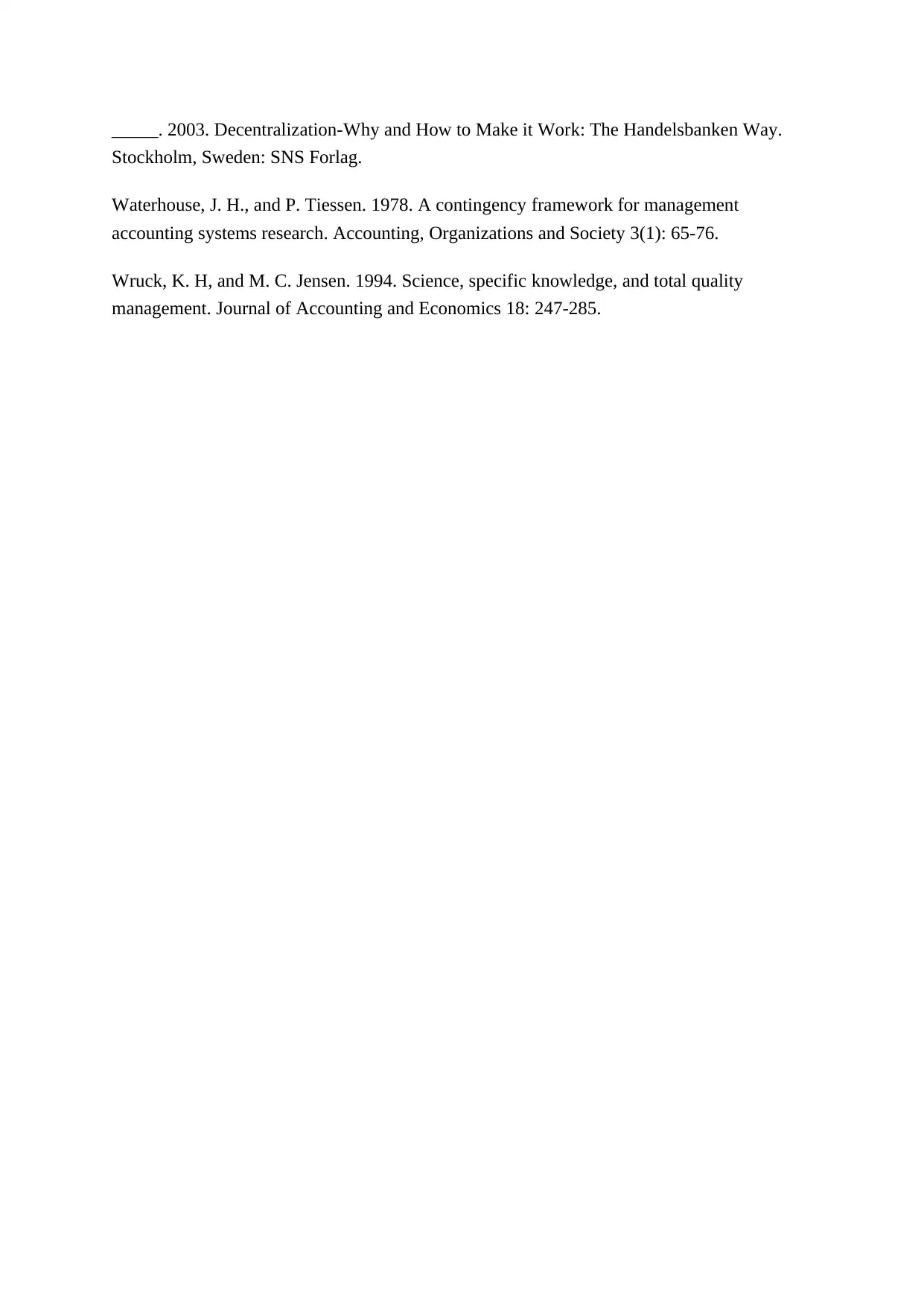
_____. 2003. Decentralization-Why and How to Make it Work: The Handelsbanken Way.
Stockholm, Sweden: SNS Forlag.
Waterhouse, J. H., and P. Tiessen. 1978. A contingency framework for management
accounting systems research. Accounting, Organizations and Society 3(1): 65-76.
Wruck, K. H, and M. C. Jensen. 1994. Science, specific knowledge, and total quality
management. Journal of Accounting and Economics 18: 247-285.
Stockholm, Sweden: SNS Forlag.
Waterhouse, J. H., and P. Tiessen. 1978. A contingency framework for management
accounting systems research. Accounting, Organizations and Society 3(1): 65-76.
Wruck, K. H, and M. C. Jensen. 1994. Science, specific knowledge, and total quality
management. Journal of Accounting and Economics 18: 247-285.
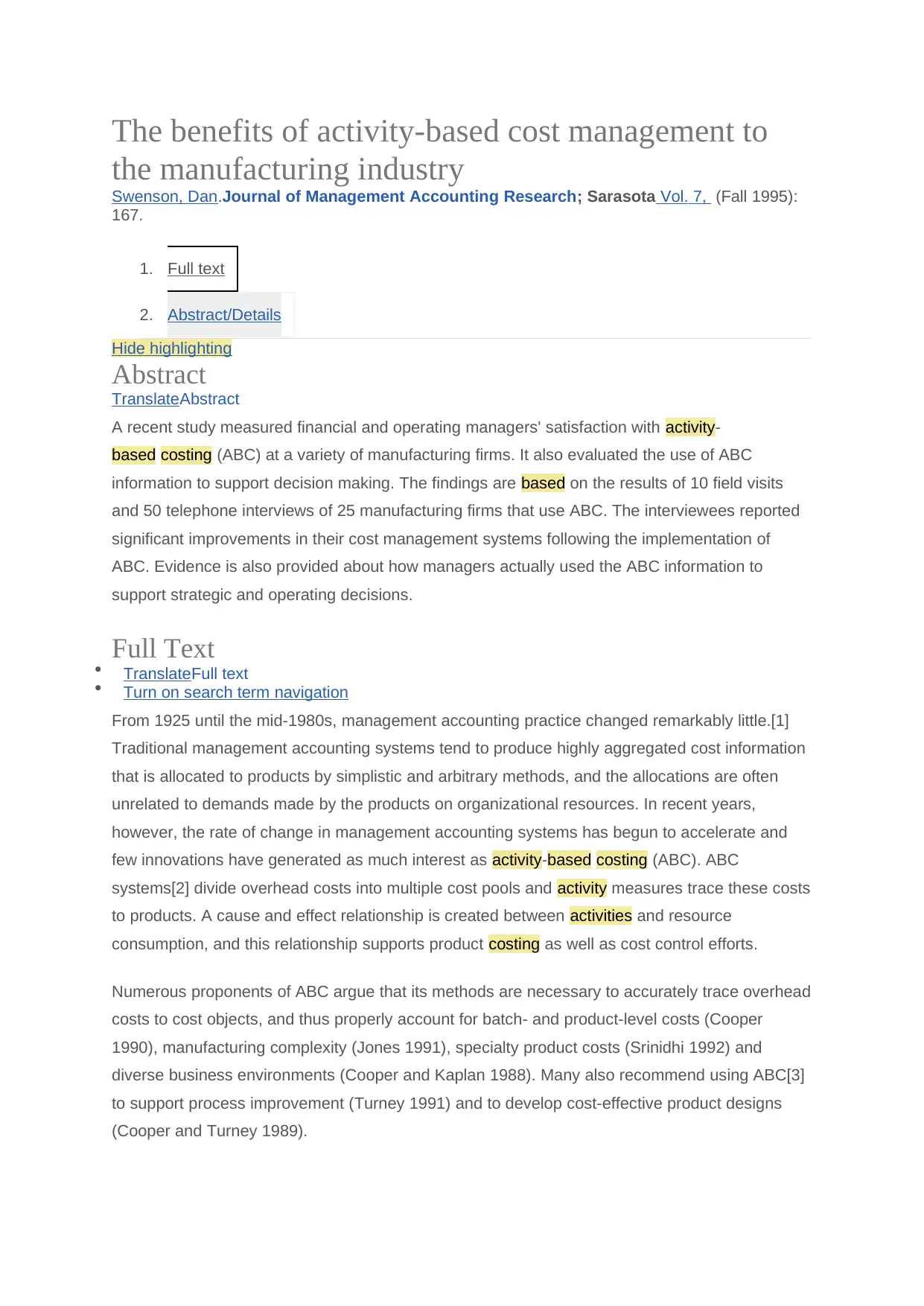
The benefits of activity-based cost management to
the manufacturing industry
Swenson, Dan.Journal of Management Accounting Research; Sarasota Vol. 7, (Fall 1995):
167.
1. Full text
2. Abstract/Details
Hide highlighting
Abstract
TranslateAbstract
A recent study measured financial and operating managers' satisfaction with activity-
based costing (ABC) at a variety of manufacturing firms. It also evaluated the use of ABC
information to support decision making. The findings are based on the results of 10 field visits
and 50 telephone interviews of 25 manufacturing firms that use ABC. The interviewees reported
significant improvements in their cost management systems following the implementation of
ABC. Evidence is also provided about how managers actually used the ABC information to
support strategic and operating decisions.
Full Text
TranslateFull text
Turn on search term navigation
From 1925 until the mid-1980s, management accounting practice changed remarkably little.[1]
Traditional management accounting systems tend to produce highly aggregated cost information
that is allocated to products by simplistic and arbitrary methods, and the allocations are often
unrelated to demands made by the products on organizational resources. In recent years,
however, the rate of change in management accounting systems has begun to accelerate and
few innovations have generated as much interest as activity-based costing (ABC). ABC
systems[2] divide overhead costs into multiple cost pools and activity measures trace these costs
to products. A cause and effect relationship is created between activities and resource
consumption, and this relationship supports product costing as well as cost control efforts.
Numerous proponents of ABC argue that its methods are necessary to accurately trace overhead
costs to cost objects, and thus properly account for batch- and product-level costs (Cooper
1990), manufacturing complexity (Jones 1991), specialty product costs (Srinidhi 1992) and
diverse business environments (Cooper and Kaplan 1988). Many also recommend using ABC[3]
to support process improvement (Turney 1991) and to develop cost-effective product designs
(Cooper and Turney 1989).
the manufacturing industry
Swenson, Dan.Journal of Management Accounting Research; Sarasota Vol. 7, (Fall 1995):
167.
1. Full text
2. Abstract/Details
Hide highlighting
Abstract
TranslateAbstract
A recent study measured financial and operating managers' satisfaction with activity-
based costing (ABC) at a variety of manufacturing firms. It also evaluated the use of ABC
information to support decision making. The findings are based on the results of 10 field visits
and 50 telephone interviews of 25 manufacturing firms that use ABC. The interviewees reported
significant improvements in their cost management systems following the implementation of
ABC. Evidence is also provided about how managers actually used the ABC information to
support strategic and operating decisions.
Full Text
TranslateFull text
Turn on search term navigation
From 1925 until the mid-1980s, management accounting practice changed remarkably little.[1]
Traditional management accounting systems tend to produce highly aggregated cost information
that is allocated to products by simplistic and arbitrary methods, and the allocations are often
unrelated to demands made by the products on organizational resources. In recent years,
however, the rate of change in management accounting systems has begun to accelerate and
few innovations have generated as much interest as activity-based costing (ABC). ABC
systems[2] divide overhead costs into multiple cost pools and activity measures trace these costs
to products. A cause and effect relationship is created between activities and resource
consumption, and this relationship supports product costing as well as cost control efforts.
Numerous proponents of ABC argue that its methods are necessary to accurately trace overhead
costs to cost objects, and thus properly account for batch- and product-level costs (Cooper
1990), manufacturing complexity (Jones 1991), specialty product costs (Srinidhi 1992) and
diverse business environments (Cooper and Kaplan 1988). Many also recommend using ABC[3]
to support process improvement (Turney 1991) and to develop cost-effective product designs
(Cooper and Turney 1989).
Secure Best Marks with AI Grader
Need help grading? Try our AI Grader for instant feedback on your assignments.
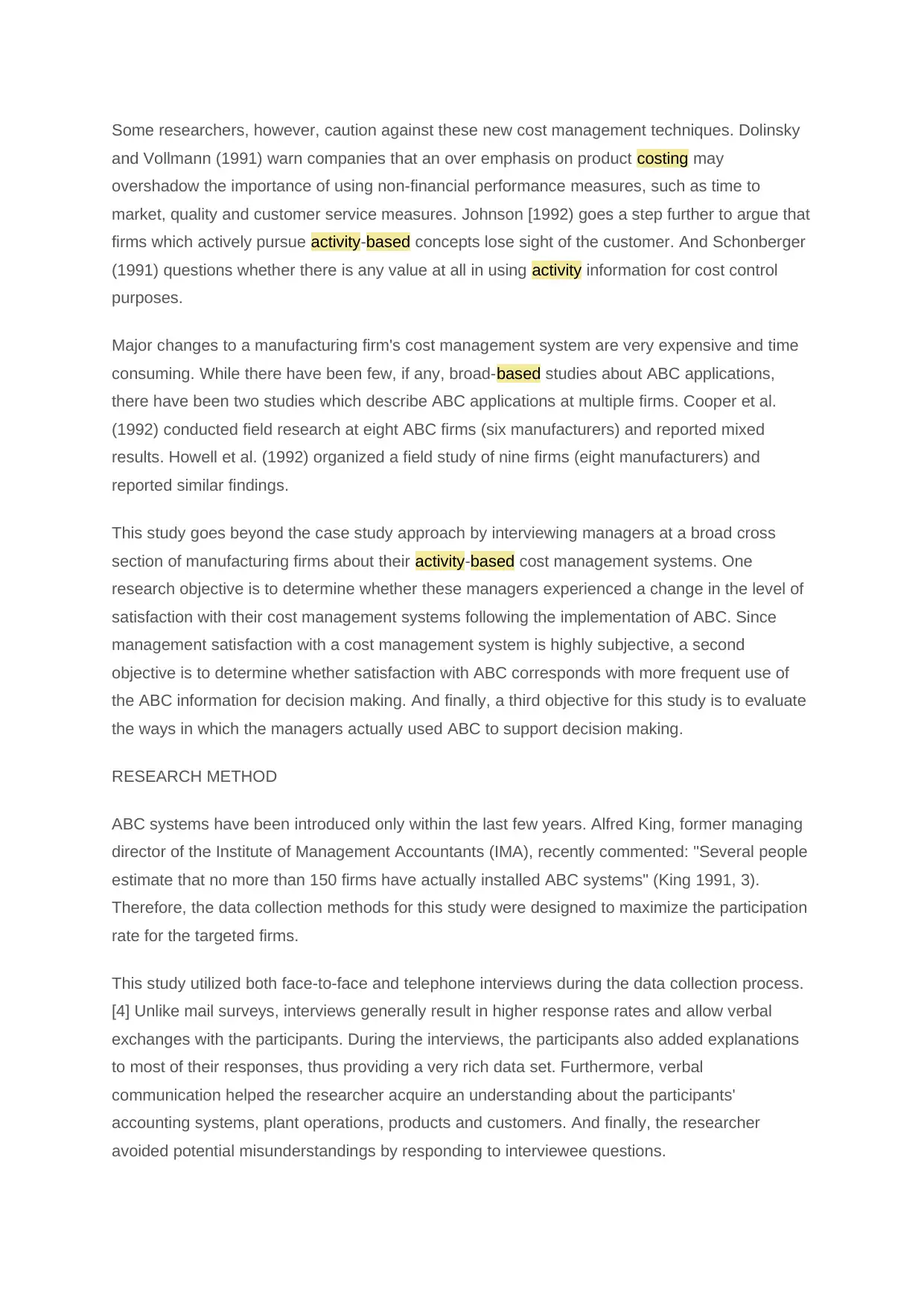
Some researchers, however, caution against these new cost management techniques. Dolinsky
and Vollmann (1991) warn companies that an over emphasis on product costing may
overshadow the importance of using non-financial performance measures, such as time to
market, quality and customer service measures. Johnson [1992) goes a step further to argue that
firms which actively pursue activity-based concepts lose sight of the customer. And Schonberger
(1991) questions whether there is any value at all in using activity information for cost control
purposes.
Major changes to a manufacturing firm's cost management system are very expensive and time
consuming. While there have been few, if any, broad-based studies about ABC applications,
there have been two studies which describe ABC applications at multiple firms. Cooper et al.
(1992) conducted field research at eight ABC firms (six manufacturers) and reported mixed
results. Howell et al. (1992) organized a field study of nine firms (eight manufacturers) and
reported similar findings.
This study goes beyond the case study approach by interviewing managers at a broad cross
section of manufacturing firms about their activity-based cost management systems. One
research objective is to determine whether these managers experienced a change in the level of
satisfaction with their cost management systems following the implementation of ABC. Since
management satisfaction with a cost management system is highly subjective, a second
objective is to determine whether satisfaction with ABC corresponds with more frequent use of
the ABC information for decision making. And finally, a third objective for this study is to evaluate
the ways in which the managers actually used ABC to support decision making.
RESEARCH METHOD
ABC systems have been introduced only within the last few years. Alfred King, former managing
director of the Institute of Management Accountants (IMA), recently commented: "Several people
estimate that no more than 150 firms have actually installed ABC systems" (King 1991, 3).
Therefore, the data collection methods for this study were designed to maximize the participation
rate for the targeted firms.
This study utilized both face-to-face and telephone interviews during the data collection process.
[4] Unlike mail surveys, interviews generally result in higher response rates and allow verbal
exchanges with the participants. During the interviews, the participants also added explanations
to most of their responses, thus providing a very rich data set. Furthermore, verbal
communication helped the researcher acquire an understanding about the participants'
accounting systems, plant operations, products and customers. And finally, the researcher
avoided potential misunderstandings by responding to interviewee questions.
and Vollmann (1991) warn companies that an over emphasis on product costing may
overshadow the importance of using non-financial performance measures, such as time to
market, quality and customer service measures. Johnson [1992) goes a step further to argue that
firms which actively pursue activity-based concepts lose sight of the customer. And Schonberger
(1991) questions whether there is any value at all in using activity information for cost control
purposes.
Major changes to a manufacturing firm's cost management system are very expensive and time
consuming. While there have been few, if any, broad-based studies about ABC applications,
there have been two studies which describe ABC applications at multiple firms. Cooper et al.
(1992) conducted field research at eight ABC firms (six manufacturers) and reported mixed
results. Howell et al. (1992) organized a field study of nine firms (eight manufacturers) and
reported similar findings.
This study goes beyond the case study approach by interviewing managers at a broad cross
section of manufacturing firms about their activity-based cost management systems. One
research objective is to determine whether these managers experienced a change in the level of
satisfaction with their cost management systems following the implementation of ABC. Since
management satisfaction with a cost management system is highly subjective, a second
objective is to determine whether satisfaction with ABC corresponds with more frequent use of
the ABC information for decision making. And finally, a third objective for this study is to evaluate
the ways in which the managers actually used ABC to support decision making.
RESEARCH METHOD
ABC systems have been introduced only within the last few years. Alfred King, former managing
director of the Institute of Management Accountants (IMA), recently commented: "Several people
estimate that no more than 150 firms have actually installed ABC systems" (King 1991, 3).
Therefore, the data collection methods for this study were designed to maximize the participation
rate for the targeted firms.
This study utilized both face-to-face and telephone interviews during the data collection process.
[4] Unlike mail surveys, interviews generally result in higher response rates and allow verbal
exchanges with the participants. During the interviews, the participants also added explanations
to most of their responses, thus providing a very rich data set. Furthermore, verbal
communication helped the researcher acquire an understanding about the participants'
accounting systems, plant operations, products and customers. And finally, the researcher
avoided potential misunderstandings by responding to interviewee questions.
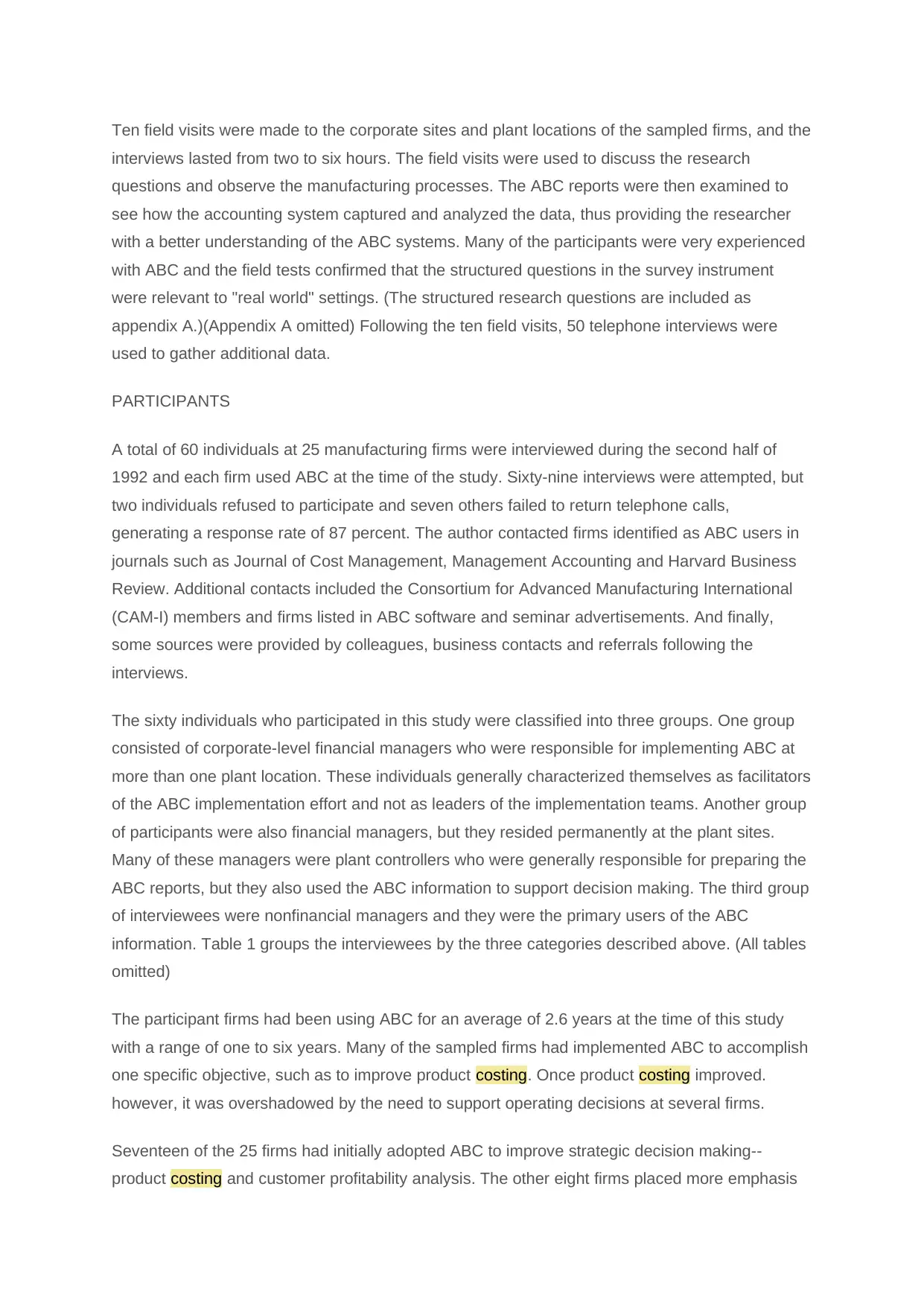
Ten field visits were made to the corporate sites and plant locations of the sampled firms, and the
interviews lasted from two to six hours. The field visits were used to discuss the research
questions and observe the manufacturing processes. The ABC reports were then examined to
see how the accounting system captured and analyzed the data, thus providing the researcher
with a better understanding of the ABC systems. Many of the participants were very experienced
with ABC and the field tests confirmed that the structured questions in the survey instrument
were relevant to "real world" settings. (The structured research questions are included as
appendix A.)(Appendix A omitted) Following the ten field visits, 50 telephone interviews were
used to gather additional data.
PARTICIPANTS
A total of 60 individuals at 25 manufacturing firms were interviewed during the second half of
1992 and each firm used ABC at the time of the study. Sixty-nine interviews were attempted, but
two individuals refused to participate and seven others failed to return telephone calls,
generating a response rate of 87 percent. The author contacted firms identified as ABC users in
journals such as Journal of Cost Management, Management Accounting and Harvard Business
Review. Additional contacts included the Consortium for Advanced Manufacturing International
(CAM-I) members and firms listed in ABC software and seminar advertisements. And finally,
some sources were provided by colleagues, business contacts and referrals following the
interviews.
The sixty individuals who participated in this study were classified into three groups. One group
consisted of corporate-level financial managers who were responsible for implementing ABC at
more than one plant location. These individuals generally characterized themselves as facilitators
of the ABC implementation effort and not as leaders of the implementation teams. Another group
of participants were also financial managers, but they resided permanently at the plant sites.
Many of these managers were plant controllers who were generally responsible for preparing the
ABC reports, but they also used the ABC information to support decision making. The third group
of interviewees were nonfinancial managers and they were the primary users of the ABC
information. Table 1 groups the interviewees by the three categories described above. (All tables
omitted)
The participant firms had been using ABC for an average of 2.6 years at the time of this study
with a range of one to six years. Many of the sampled firms had implemented ABC to accomplish
one specific objective, such as to improve product costing. Once product costing improved.
however, it was overshadowed by the need to support operating decisions at several firms.
Seventeen of the 25 firms had initially adopted ABC to improve strategic decision making--
product costing and customer profitability analysis. The other eight firms placed more emphasis
interviews lasted from two to six hours. The field visits were used to discuss the research
questions and observe the manufacturing processes. The ABC reports were then examined to
see how the accounting system captured and analyzed the data, thus providing the researcher
with a better understanding of the ABC systems. Many of the participants were very experienced
with ABC and the field tests confirmed that the structured questions in the survey instrument
were relevant to "real world" settings. (The structured research questions are included as
appendix A.)(Appendix A omitted) Following the ten field visits, 50 telephone interviews were
used to gather additional data.
PARTICIPANTS
A total of 60 individuals at 25 manufacturing firms were interviewed during the second half of
1992 and each firm used ABC at the time of the study. Sixty-nine interviews were attempted, but
two individuals refused to participate and seven others failed to return telephone calls,
generating a response rate of 87 percent. The author contacted firms identified as ABC users in
journals such as Journal of Cost Management, Management Accounting and Harvard Business
Review. Additional contacts included the Consortium for Advanced Manufacturing International
(CAM-I) members and firms listed in ABC software and seminar advertisements. And finally,
some sources were provided by colleagues, business contacts and referrals following the
interviews.
The sixty individuals who participated in this study were classified into three groups. One group
consisted of corporate-level financial managers who were responsible for implementing ABC at
more than one plant location. These individuals generally characterized themselves as facilitators
of the ABC implementation effort and not as leaders of the implementation teams. Another group
of participants were also financial managers, but they resided permanently at the plant sites.
Many of these managers were plant controllers who were generally responsible for preparing the
ABC reports, but they also used the ABC information to support decision making. The third group
of interviewees were nonfinancial managers and they were the primary users of the ABC
information. Table 1 groups the interviewees by the three categories described above. (All tables
omitted)
The participant firms had been using ABC for an average of 2.6 years at the time of this study
with a range of one to six years. Many of the sampled firms had implemented ABC to accomplish
one specific objective, such as to improve product costing. Once product costing improved.
however, it was overshadowed by the need to support operating decisions at several firms.
Seventeen of the 25 firms had initially adopted ABC to improve strategic decision making--
product costing and customer profitability analysis. The other eight firms placed more emphasis
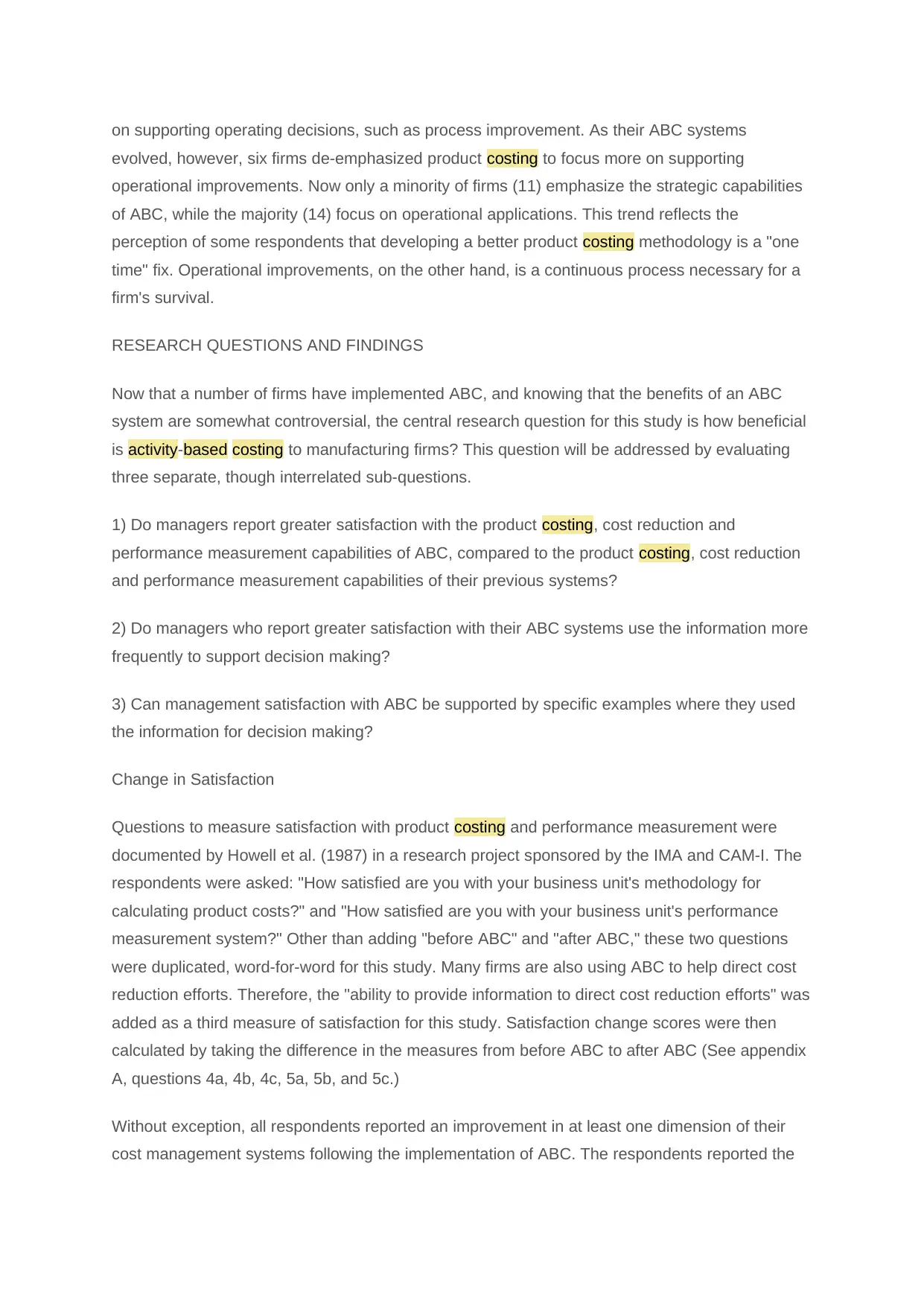
on supporting operating decisions, such as process improvement. As their ABC systems
evolved, however, six firms de-emphasized product costing to focus more on supporting
operational improvements. Now only a minority of firms (11) emphasize the strategic capabilities
of ABC, while the majority (14) focus on operational applications. This trend reflects the
perception of some respondents that developing a better product costing methodology is a "one
time" fix. Operational improvements, on the other hand, is a continuous process necessary for a
firm's survival.
RESEARCH QUESTIONS AND FINDINGS
Now that a number of firms have implemented ABC, and knowing that the benefits of an ABC
system are somewhat controversial, the central research question for this study is how beneficial
is activity-based costing to manufacturing firms? This question will be addressed by evaluating
three separate, though interrelated sub-questions.
1) Do managers report greater satisfaction with the product costing, cost reduction and
performance measurement capabilities of ABC, compared to the product costing, cost reduction
and performance measurement capabilities of their previous systems?
2) Do managers who report greater satisfaction with their ABC systems use the information more
frequently to support decision making?
3) Can management satisfaction with ABC be supported by specific examples where they used
the information for decision making?
Change in Satisfaction
Questions to measure satisfaction with product costing and performance measurement were
documented by Howell et al. (1987) in a research project sponsored by the IMA and CAM-I. The
respondents were asked: "How satisfied are you with your business unit's methodology for
calculating product costs?" and "How satisfied are you with your business unit's performance
measurement system?" Other than adding "before ABC" and "after ABC," these two questions
were duplicated, word-for-word for this study. Many firms are also using ABC to help direct cost
reduction efforts. Therefore, the "ability to provide information to direct cost reduction efforts" was
added as a third measure of satisfaction for this study. Satisfaction change scores were then
calculated by taking the difference in the measures from before ABC to after ABC (See appendix
A, questions 4a, 4b, 4c, 5a, 5b, and 5c.)
Without exception, all respondents reported an improvement in at least one dimension of their
cost management systems following the implementation of ABC. The respondents reported the
evolved, however, six firms de-emphasized product costing to focus more on supporting
operational improvements. Now only a minority of firms (11) emphasize the strategic capabilities
of ABC, while the majority (14) focus on operational applications. This trend reflects the
perception of some respondents that developing a better product costing methodology is a "one
time" fix. Operational improvements, on the other hand, is a continuous process necessary for a
firm's survival.
RESEARCH QUESTIONS AND FINDINGS
Now that a number of firms have implemented ABC, and knowing that the benefits of an ABC
system are somewhat controversial, the central research question for this study is how beneficial
is activity-based costing to manufacturing firms? This question will be addressed by evaluating
three separate, though interrelated sub-questions.
1) Do managers report greater satisfaction with the product costing, cost reduction and
performance measurement capabilities of ABC, compared to the product costing, cost reduction
and performance measurement capabilities of their previous systems?
2) Do managers who report greater satisfaction with their ABC systems use the information more
frequently to support decision making?
3) Can management satisfaction with ABC be supported by specific examples where they used
the information for decision making?
Change in Satisfaction
Questions to measure satisfaction with product costing and performance measurement were
documented by Howell et al. (1987) in a research project sponsored by the IMA and CAM-I. The
respondents were asked: "How satisfied are you with your business unit's methodology for
calculating product costs?" and "How satisfied are you with your business unit's performance
measurement system?" Other than adding "before ABC" and "after ABC," these two questions
were duplicated, word-for-word for this study. Many firms are also using ABC to help direct cost
reduction efforts. Therefore, the "ability to provide information to direct cost reduction efforts" was
added as a third measure of satisfaction for this study. Satisfaction change scores were then
calculated by taking the difference in the measures from before ABC to after ABC (See appendix
A, questions 4a, 4b, 4c, 5a, 5b, and 5c.)
Without exception, all respondents reported an improvement in at least one dimension of their
cost management systems following the implementation of ABC. The respondents reported the
Paraphrase This Document
Need a fresh take? Get an instant paraphrase of this document with our AI Paraphraser

most improvement for product costing and cost control efforts, but they also reported significant
improvements in their performance measurement systems (see table 2).
Table 2 also illustrates that a relatively broad cross section of managers are satisfied with ABC
as their cost management system. While their satisfaction change scores improved significantly
across each functional area, the average scores for the nonfinancial managers have not quite
reached the "seems reasonable" category. The corporate and plant-level financial managers,
however, generally reported a high level of satisfaction with their cost management systems
following the implementation of ABC.
Frequency of Use
The frequency with which the ABC information is used to support decision making is a somewhat
more objective measure of the benefits of an ABC system. Therefore, to answer the second
question the respondents were asked about the extent to which management used the ABC
information to support pricing strategies and product discontinuance decisions (appendix A,
questions 16 and 17). The operating managers were also asked about the extent to which they
used the activity information to support process improvement initiatives (question 21). These
measures were then associated with the satisfaction scores.
A significant positive correlation was found between satisfaction with ABC for
product costing and the extent of ABC information use for pricing and product mix decisions (r
= .50, p < .01). A significant positive correlation was also found between satisfaction with ABC for
cost reduction efforts and the extent of ABC information use by operating managers (r = .45, p
< .011. This implies that the managers who are more satisfied with their ABC systems are also
more likely to take action and actually use the ABC information to affect decision making.
Examples of Use
The respondents were also asked to "discuss how the [ABC] information is used for decision
making" (question 21). To some degree, examples of use provide additional evidence to evaluate
the benefits of ABC systems. This question was triggered, in part, by the Cooper et al. (1992)
study, which found that many companies had performed extensive activity analysis, but this was
followed by very little action. This present study, however, provides specific examples[5] of how
managers used the ABC information to support strategic and operating decisions. These
examples are illustrated in the following section and tables 3 and 4 summarize the ABC
applications employed by all firms in the sample.
Strategic Decisions
improvements in their performance measurement systems (see table 2).
Table 2 also illustrates that a relatively broad cross section of managers are satisfied with ABC
as their cost management system. While their satisfaction change scores improved significantly
across each functional area, the average scores for the nonfinancial managers have not quite
reached the "seems reasonable" category. The corporate and plant-level financial managers,
however, generally reported a high level of satisfaction with their cost management systems
following the implementation of ABC.
Frequency of Use
The frequency with which the ABC information is used to support decision making is a somewhat
more objective measure of the benefits of an ABC system. Therefore, to answer the second
question the respondents were asked about the extent to which management used the ABC
information to support pricing strategies and product discontinuance decisions (appendix A,
questions 16 and 17). The operating managers were also asked about the extent to which they
used the activity information to support process improvement initiatives (question 21). These
measures were then associated with the satisfaction scores.
A significant positive correlation was found between satisfaction with ABC for
product costing and the extent of ABC information use for pricing and product mix decisions (r
= .50, p < .01). A significant positive correlation was also found between satisfaction with ABC for
cost reduction efforts and the extent of ABC information use by operating managers (r = .45, p
< .011. This implies that the managers who are more satisfied with their ABC systems are also
more likely to take action and actually use the ABC information to affect decision making.
Examples of Use
The respondents were also asked to "discuss how the [ABC] information is used for decision
making" (question 21). To some degree, examples of use provide additional evidence to evaluate
the benefits of ABC systems. This question was triggered, in part, by the Cooper et al. (1992)
study, which found that many companies had performed extensive activity analysis, but this was
followed by very little action. This present study, however, provides specific examples[5] of how
managers used the ABC information to support strategic and operating decisions. These
examples are illustrated in the following section and tables 3 and 4 summarize the ABC
applications employed by all firms in the sample.
Strategic Decisions
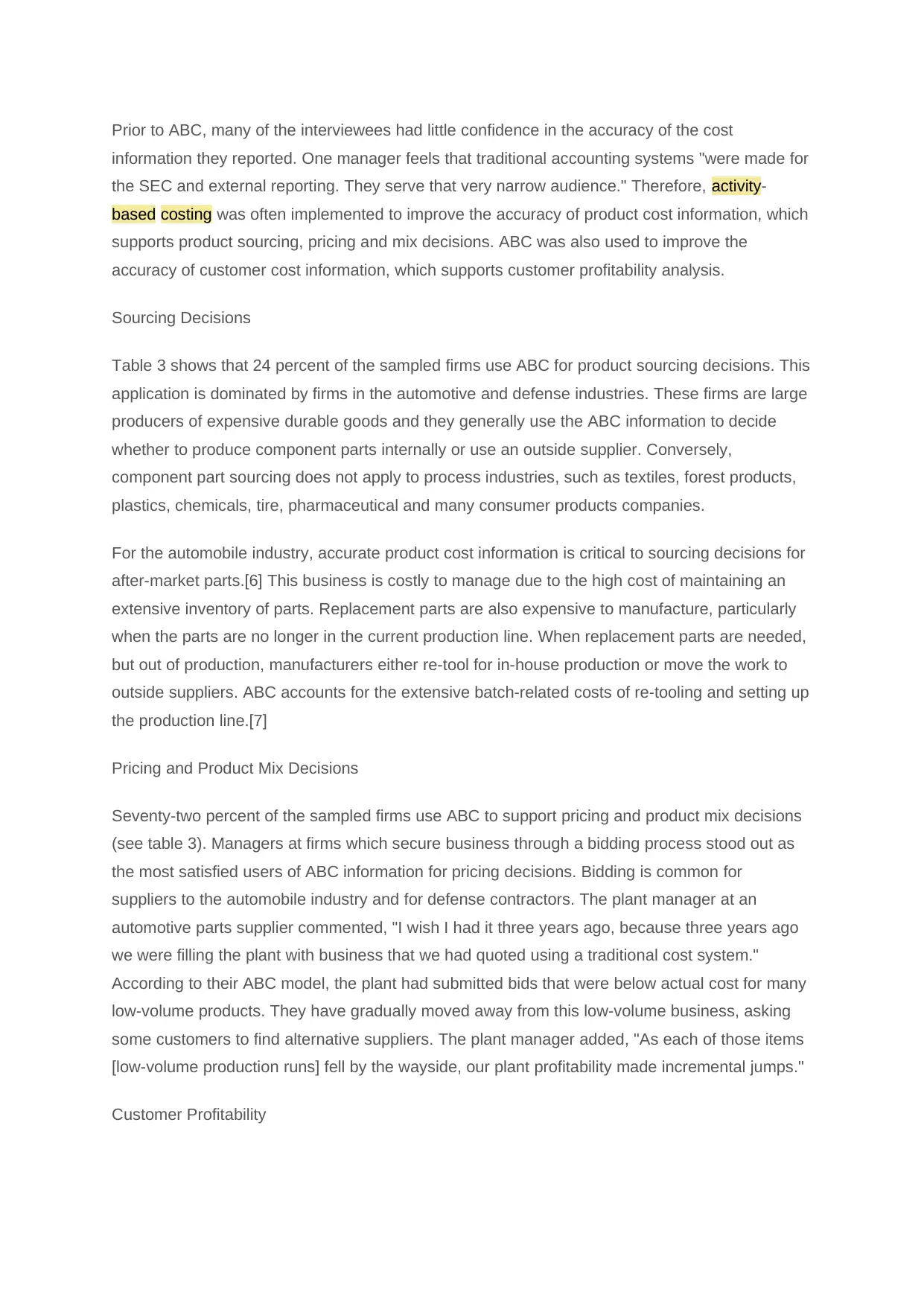
Prior to ABC, many of the interviewees had little confidence in the accuracy of the cost
information they reported. One manager feels that traditional accounting systems "were made for
the SEC and external reporting. They serve that very narrow audience." Therefore, activity-
based costing was often implemented to improve the accuracy of product cost information, which
supports product sourcing, pricing and mix decisions. ABC was also used to improve the
accuracy of customer cost information, which supports customer profitability analysis.
Sourcing Decisions
Table 3 shows that 24 percent of the sampled firms use ABC for product sourcing decisions. This
application is dominated by firms in the automotive and defense industries. These firms are large
producers of expensive durable goods and they generally use the ABC information to decide
whether to produce component parts internally or use an outside supplier. Conversely,
component part sourcing does not apply to process industries, such as textiles, forest products,
plastics, chemicals, tire, pharmaceutical and many consumer products companies.
For the automobile industry, accurate product cost information is critical to sourcing decisions for
after-market parts.[6] This business is costly to manage due to the high cost of maintaining an
extensive inventory of parts. Replacement parts are also expensive to manufacture, particularly
when the parts are no longer in the current production line. When replacement parts are needed,
but out of production, manufacturers either re-tool for in-house production or move the work to
outside suppliers. ABC accounts for the extensive batch-related costs of re-tooling and setting up
the production line.[7]
Pricing and Product Mix Decisions
Seventy-two percent of the sampled firms use ABC to support pricing and product mix decisions
(see table 3). Managers at firms which secure business through a bidding process stood out as
the most satisfied users of ABC information for pricing decisions. Bidding is common for
suppliers to the automobile industry and for defense contractors. The plant manager at an
automotive parts supplier commented, "I wish I had it three years ago, because three years ago
we were filling the plant with business that we had quoted using a traditional cost system."
According to their ABC model, the plant had submitted bids that were below actual cost for many
low-volume products. They have gradually moved away from this low-volume business, asking
some customers to find alternative suppliers. The plant manager added, "As each of those items
[low-volume production runs] fell by the wayside, our plant profitability made incremental jumps."
Customer Profitability
information they reported. One manager feels that traditional accounting systems "were made for
the SEC and external reporting. They serve that very narrow audience." Therefore, activity-
based costing was often implemented to improve the accuracy of product cost information, which
supports product sourcing, pricing and mix decisions. ABC was also used to improve the
accuracy of customer cost information, which supports customer profitability analysis.
Sourcing Decisions
Table 3 shows that 24 percent of the sampled firms use ABC for product sourcing decisions. This
application is dominated by firms in the automotive and defense industries. These firms are large
producers of expensive durable goods and they generally use the ABC information to decide
whether to produce component parts internally or use an outside supplier. Conversely,
component part sourcing does not apply to process industries, such as textiles, forest products,
plastics, chemicals, tire, pharmaceutical and many consumer products companies.
For the automobile industry, accurate product cost information is critical to sourcing decisions for
after-market parts.[6] This business is costly to manage due to the high cost of maintaining an
extensive inventory of parts. Replacement parts are also expensive to manufacture, particularly
when the parts are no longer in the current production line. When replacement parts are needed,
but out of production, manufacturers either re-tool for in-house production or move the work to
outside suppliers. ABC accounts for the extensive batch-related costs of re-tooling and setting up
the production line.[7]
Pricing and Product Mix Decisions
Seventy-two percent of the sampled firms use ABC to support pricing and product mix decisions
(see table 3). Managers at firms which secure business through a bidding process stood out as
the most satisfied users of ABC information for pricing decisions. Bidding is common for
suppliers to the automobile industry and for defense contractors. The plant manager at an
automotive parts supplier commented, "I wish I had it three years ago, because three years ago
we were filling the plant with business that we had quoted using a traditional cost system."
According to their ABC model, the plant had submitted bids that were below actual cost for many
low-volume products. They have gradually moved away from this low-volume business, asking
some customers to find alternative suppliers. The plant manager added, "As each of those items
[low-volume production runs] fell by the wayside, our plant profitability made incremental jumps."
Customer Profitability
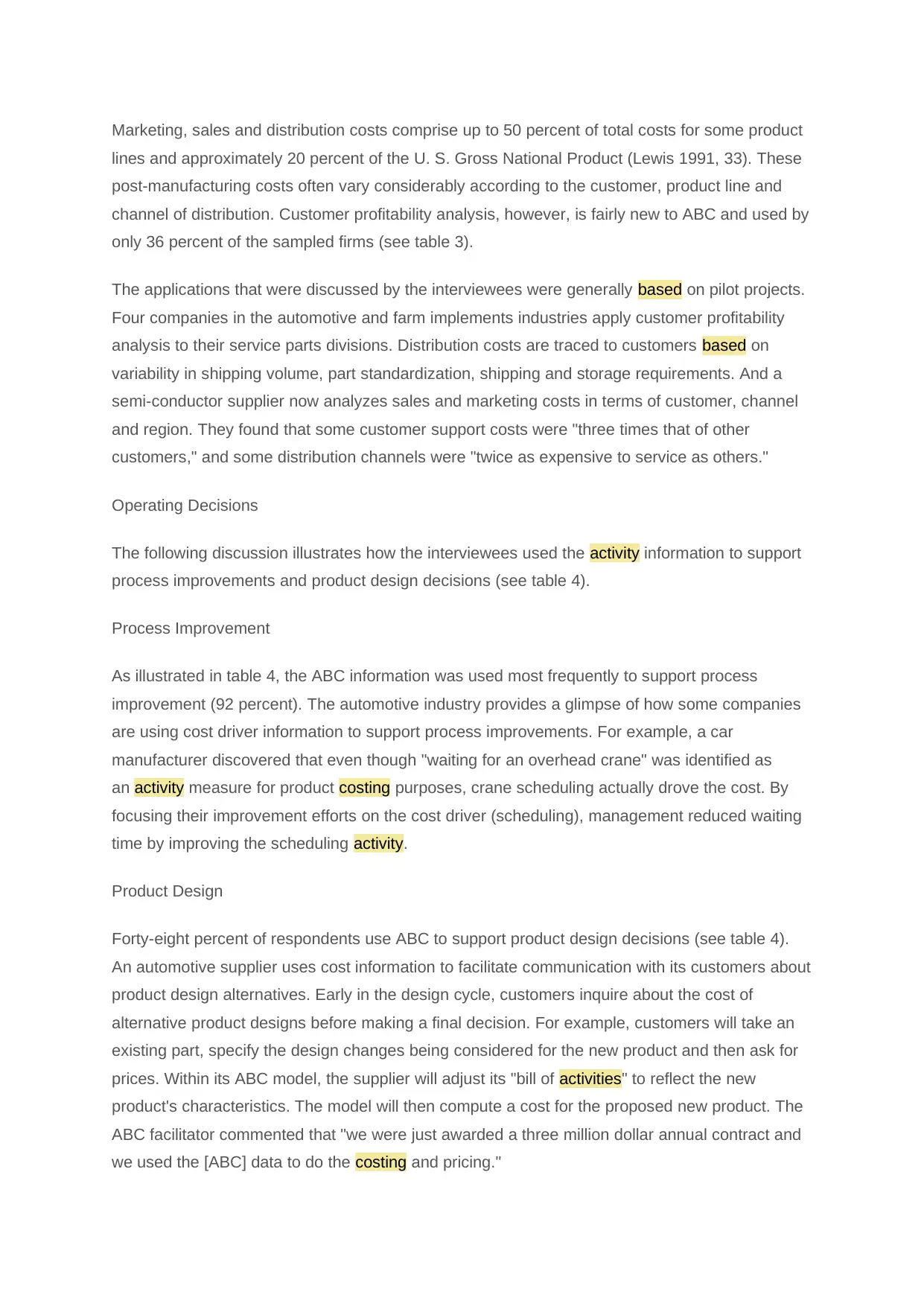
Marketing, sales and distribution costs comprise up to 50 percent of total costs for some product
lines and approximately 20 percent of the U. S. Gross National Product (Lewis 1991, 33). These
post-manufacturing costs often vary considerably according to the customer, product line and
channel of distribution. Customer profitability analysis, however, is fairly new to ABC and used by
only 36 percent of the sampled firms (see table 3).
The applications that were discussed by the interviewees were generally based on pilot projects.
Four companies in the automotive and farm implements industries apply customer profitability
analysis to their service parts divisions. Distribution costs are traced to customers based on
variability in shipping volume, part standardization, shipping and storage requirements. And a
semi-conductor supplier now analyzes sales and marketing costs in terms of customer, channel
and region. They found that some customer support costs were "three times that of other
customers," and some distribution channels were "twice as expensive to service as others."
Operating Decisions
The following discussion illustrates how the interviewees used the activity information to support
process improvements and product design decisions (see table 4).
Process Improvement
As illustrated in table 4, the ABC information was used most frequently to support process
improvement (92 percent). The automotive industry provides a glimpse of how some companies
are using cost driver information to support process improvements. For example, a car
manufacturer discovered that even though "waiting for an overhead crane" was identified as
an activity measure for product costing purposes, crane scheduling actually drove the cost. By
focusing their improvement efforts on the cost driver (scheduling), management reduced waiting
time by improving the scheduling activity.
Product Design
Forty-eight percent of respondents use ABC to support product design decisions (see table 4).
An automotive supplier uses cost information to facilitate communication with its customers about
product design alternatives. Early in the design cycle, customers inquire about the cost of
alternative product designs before making a final decision. For example, customers will take an
existing part, specify the design changes being considered for the new product and then ask for
prices. Within its ABC model, the supplier will adjust its "bill of activities" to reflect the new
product's characteristics. The model will then compute a cost for the proposed new product. The
ABC facilitator commented that "we were just awarded a three million dollar annual contract and
we used the [ABC] data to do the costing and pricing."
lines and approximately 20 percent of the U. S. Gross National Product (Lewis 1991, 33). These
post-manufacturing costs often vary considerably according to the customer, product line and
channel of distribution. Customer profitability analysis, however, is fairly new to ABC and used by
only 36 percent of the sampled firms (see table 3).
The applications that were discussed by the interviewees were generally based on pilot projects.
Four companies in the automotive and farm implements industries apply customer profitability
analysis to their service parts divisions. Distribution costs are traced to customers based on
variability in shipping volume, part standardization, shipping and storage requirements. And a
semi-conductor supplier now analyzes sales and marketing costs in terms of customer, channel
and region. They found that some customer support costs were "three times that of other
customers," and some distribution channels were "twice as expensive to service as others."
Operating Decisions
The following discussion illustrates how the interviewees used the activity information to support
process improvements and product design decisions (see table 4).
Process Improvement
As illustrated in table 4, the ABC information was used most frequently to support process
improvement (92 percent). The automotive industry provides a glimpse of how some companies
are using cost driver information to support process improvements. For example, a car
manufacturer discovered that even though "waiting for an overhead crane" was identified as
an activity measure for product costing purposes, crane scheduling actually drove the cost. By
focusing their improvement efforts on the cost driver (scheduling), management reduced waiting
time by improving the scheduling activity.
Product Design
Forty-eight percent of respondents use ABC to support product design decisions (see table 4).
An automotive supplier uses cost information to facilitate communication with its customers about
product design alternatives. Early in the design cycle, customers inquire about the cost of
alternative product designs before making a final decision. For example, customers will take an
existing part, specify the design changes being considered for the new product and then ask for
prices. Within its ABC model, the supplier will adjust its "bill of activities" to reflect the new
product's characteristics. The model will then compute a cost for the proposed new product. The
ABC facilitator commented that "we were just awarded a three million dollar annual contract and
we used the [ABC] data to do the costing and pricing."
Secure Best Marks with AI Grader
Need help grading? Try our AI Grader for instant feedback on your assignments.

Performance Measurement
Only seven of the 25 sampled firms had incorporated ABC into their performance measurement
systems at the time of the interviews. Yet many respondents view performance measurement as
the "final output" of their ABC implementation efforts.
Activity-based costs were used at a beverage producer to measure the performance of some
corporate initiatives, such as just-in-time (JIT) inventory practices. Through an activity analysis,
the cost of storing and handling high levels of raw materials inventory were found to exceed the
cost of smaller and more frequent JIT deliveries. Management also used ABC to develop quality
costs, and a vendor rating scale helped measure vendor performance. This company's future
plans are to use ABC to support the incorporation of benchmarking into its plants' formal
performance measurement systems. ABC will help establish benchmarks for important cost-
driving activities.
SUMMARY AND CONCLUSIONS
This study found broad support for activity-based cost management systems among the sampled
firms. The applications of ABC techniques were quite varied, and the participants represented a
wide variety of industries, yet each firm appeared to benefit from at least one dimension of its
ABC system.
The interviewees provided certain evidence to support this perception. Following the
implementation of ABC, they reported higher levels of satisfaction with their cost management
systems. The participants also provided specific examples of how they used the activity-
based cost information to support decision making.
Future studies should include firms which have attempted to implement ABC but failed. These
studies can then look for differences in firm characteristics, or other factors such as management
support or commitment, to explain success or failure with activity-basedcosting.
[1] See, for example, the work of Kaplan (1984) and Johnson (1987).
[2] For this paper an ABC system is defined as an information system that assists with decision
making, essentially a decision support system.
[3] Some researchers (and practitioners) prefer to use the term activity-based management
(ABM) when they describe how the activity information is used to support operating decisions.
This study, however, defines activity-based costing very broadly to include ABM applications.
Only seven of the 25 sampled firms had incorporated ABC into their performance measurement
systems at the time of the interviews. Yet many respondents view performance measurement as
the "final output" of their ABC implementation efforts.
Activity-based costs were used at a beverage producer to measure the performance of some
corporate initiatives, such as just-in-time (JIT) inventory practices. Through an activity analysis,
the cost of storing and handling high levels of raw materials inventory were found to exceed the
cost of smaller and more frequent JIT deliveries. Management also used ABC to develop quality
costs, and a vendor rating scale helped measure vendor performance. This company's future
plans are to use ABC to support the incorporation of benchmarking into its plants' formal
performance measurement systems. ABC will help establish benchmarks for important cost-
driving activities.
SUMMARY AND CONCLUSIONS
This study found broad support for activity-based cost management systems among the sampled
firms. The applications of ABC techniques were quite varied, and the participants represented a
wide variety of industries, yet each firm appeared to benefit from at least one dimension of its
ABC system.
The interviewees provided certain evidence to support this perception. Following the
implementation of ABC, they reported higher levels of satisfaction with their cost management
systems. The participants also provided specific examples of how they used the activity-
based cost information to support decision making.
Future studies should include firms which have attempted to implement ABC but failed. These
studies can then look for differences in firm characteristics, or other factors such as management
support or commitment, to explain success or failure with activity-basedcosting.
[1] See, for example, the work of Kaplan (1984) and Johnson (1987).
[2] For this paper an ABC system is defined as an information system that assists with decision
making, essentially a decision support system.
[3] Some researchers (and practitioners) prefer to use the term activity-based management
(ABM) when they describe how the activity information is used to support operating decisions.
This study, however, defines activity-based costing very broadly to include ABM applications.
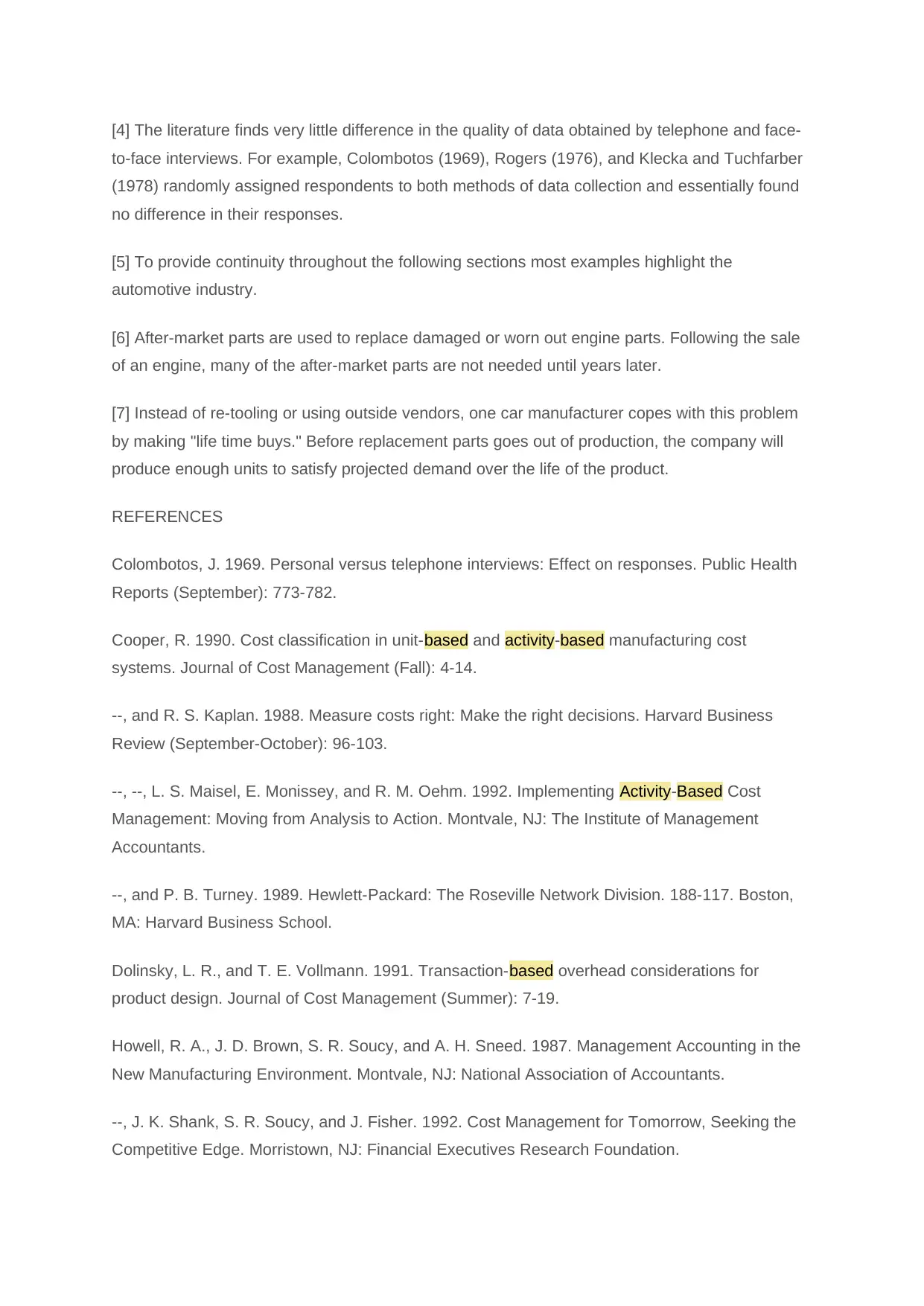
[4] The literature finds very little difference in the quality of data obtained by telephone and face-
to-face interviews. For example, Colombotos (1969), Rogers (1976), and Klecka and Tuchfarber
(1978) randomly assigned respondents to both methods of data collection and essentially found
no difference in their responses.
[5] To provide continuity throughout the following sections most examples highlight the
automotive industry.
[6] After-market parts are used to replace damaged or worn out engine parts. Following the sale
of an engine, many of the after-market parts are not needed until years later.
[7] Instead of re-tooling or using outside vendors, one car manufacturer copes with this problem
by making "life time buys." Before replacement parts goes out of production, the company will
produce enough units to satisfy projected demand over the life of the product.
REFERENCES
Colombotos, J. 1969. Personal versus telephone interviews: Effect on responses. Public Health
Reports (September): 773-782.
Cooper, R. 1990. Cost classification in unit-based and activity-based manufacturing cost
systems. Journal of Cost Management (Fall): 4-14.
--, and R. S. Kaplan. 1988. Measure costs right: Make the right decisions. Harvard Business
Review (September-October): 96-103.
--, --, L. S. Maisel, E. Monissey, and R. M. Oehm. 1992. Implementing Activity-Based Cost
Management: Moving from Analysis to Action. Montvale, NJ: The Institute of Management
Accountants.
--, and P. B. Turney. 1989. Hewlett-Packard: The Roseville Network Division. 188-117. Boston,
MA: Harvard Business School.
Dolinsky, L. R., and T. E. Vollmann. 1991. Transaction-based overhead considerations for
product design. Journal of Cost Management (Summer): 7-19.
Howell, R. A., J. D. Brown, S. R. Soucy, and A. H. Sneed. 1987. Management Accounting in the
New Manufacturing Environment. Montvale, NJ: National Association of Accountants.
--, J. K. Shank, S. R. Soucy, and J. Fisher. 1992. Cost Management for Tomorrow, Seeking the
Competitive Edge. Morristown, NJ: Financial Executives Research Foundation.
to-face interviews. For example, Colombotos (1969), Rogers (1976), and Klecka and Tuchfarber
(1978) randomly assigned respondents to both methods of data collection and essentially found
no difference in their responses.
[5] To provide continuity throughout the following sections most examples highlight the
automotive industry.
[6] After-market parts are used to replace damaged or worn out engine parts. Following the sale
of an engine, many of the after-market parts are not needed until years later.
[7] Instead of re-tooling or using outside vendors, one car manufacturer copes with this problem
by making "life time buys." Before replacement parts goes out of production, the company will
produce enough units to satisfy projected demand over the life of the product.
REFERENCES
Colombotos, J. 1969. Personal versus telephone interviews: Effect on responses. Public Health
Reports (September): 773-782.
Cooper, R. 1990. Cost classification in unit-based and activity-based manufacturing cost
systems. Journal of Cost Management (Fall): 4-14.
--, and R. S. Kaplan. 1988. Measure costs right: Make the right decisions. Harvard Business
Review (September-October): 96-103.
--, --, L. S. Maisel, E. Monissey, and R. M. Oehm. 1992. Implementing Activity-Based Cost
Management: Moving from Analysis to Action. Montvale, NJ: The Institute of Management
Accountants.
--, and P. B. Turney. 1989. Hewlett-Packard: The Roseville Network Division. 188-117. Boston,
MA: Harvard Business School.
Dolinsky, L. R., and T. E. Vollmann. 1991. Transaction-based overhead considerations for
product design. Journal of Cost Management (Summer): 7-19.
Howell, R. A., J. D. Brown, S. R. Soucy, and A. H. Sneed. 1987. Management Accounting in the
New Manufacturing Environment. Montvale, NJ: National Association of Accountants.
--, J. K. Shank, S. R. Soucy, and J. Fisher. 1992. Cost Management for Tomorrow, Seeking the
Competitive Edge. Morristown, NJ: Financial Executives Research Foundation.

Johnson, H. T. 1987. The decline of cost management: A reinterpretation of 20th-century cost
accounting history. Journal of Cost Management (Spring): 5-12.
--. 1992. It's time to stop overselling activity-based concepts. Management Accounting
(September): 26-35.
Jones, L. F. 1991. Product costing at caterpillar. Management Accounting (February): 34-42.
Kaplan, R. S. 1984. The evolution of management accounting. The Accounting Review (July):
390-418.
King, A. M. 1991. The development of cost management. Journal of Cost Management (Spring):
3.
Klecka, W. R., and A. J. Tuchfarber. 1978. Random digit dialing: A comparison to personal
surveys. Public Opinion Quarterly 42: 105-114.
Lewis, R. J. 1991. Activity-based costing for marketing. Management Accounting (November):
33-38.
Rogers, T. F. 1976. Interviews by telephone and in person: Quality of responses and field
performance. Public Opinion Quarterly 40: 51-65.
Schonberger, R. J. 199 1. Lurking issues in cost management. Journal of Cost Management
(Summer): 3-6.
Srinidhi, B. 1992. The hidden costs of specialty products. Journal of Management Accounting
Research (Fall): 198-208.
Turney, P. B. 1991. How activity-based costing helps reduce cost. Journal of Cost Management
(Winter): 29-35.
The author would like to thank the many participants from industry who were interviewed for this
study, and Dale Flesher, Teresa Gordon, Mario Reyes, Mike Shields, Morris Stocks and the
reviewers for the 1994 Management Accounting Research Conference for their contributions to
the paper. And finally, the author appreciates the comments from participants at the AAA
meeting in New York, and the anonymous reviewer for JMAR.
Word count: 3509
accounting history. Journal of Cost Management (Spring): 5-12.
--. 1992. It's time to stop overselling activity-based concepts. Management Accounting
(September): 26-35.
Jones, L. F. 1991. Product costing at caterpillar. Management Accounting (February): 34-42.
Kaplan, R. S. 1984. The evolution of management accounting. The Accounting Review (July):
390-418.
King, A. M. 1991. The development of cost management. Journal of Cost Management (Spring):
3.
Klecka, W. R., and A. J. Tuchfarber. 1978. Random digit dialing: A comparison to personal
surveys. Public Opinion Quarterly 42: 105-114.
Lewis, R. J. 1991. Activity-based costing for marketing. Management Accounting (November):
33-38.
Rogers, T. F. 1976. Interviews by telephone and in person: Quality of responses and field
performance. Public Opinion Quarterly 40: 51-65.
Schonberger, R. J. 199 1. Lurking issues in cost management. Journal of Cost Management
(Summer): 3-6.
Srinidhi, B. 1992. The hidden costs of specialty products. Journal of Management Accounting
Research (Fall): 198-208.
Turney, P. B. 1991. How activity-based costing helps reduce cost. Journal of Cost Management
(Winter): 29-35.
The author would like to thank the many participants from industry who were interviewed for this
study, and Dale Flesher, Teresa Gordon, Mario Reyes, Mike Shields, Morris Stocks and the
reviewers for the 1994 Management Accounting Research Conference for their contributions to
the paper. And finally, the author appreciates the comments from participants at the AAA
meeting in New York, and the anonymous reviewer for JMAR.
Word count: 3509
Paraphrase This Document
Need a fresh take? Get an instant paraphrase of this document with our AI Paraphraser
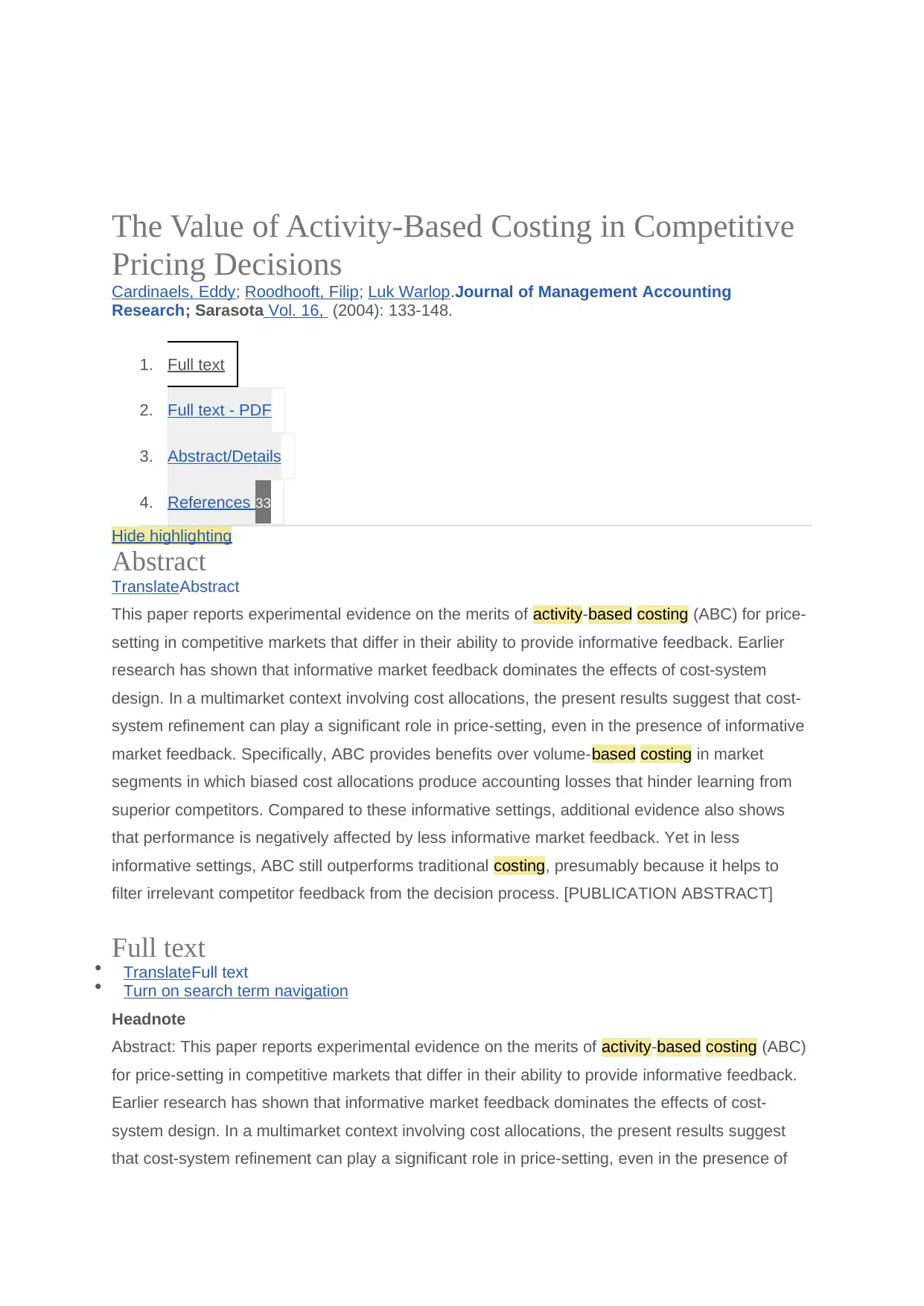
The Value of Activity-Based Costing in Competitive
Pricing Decisions
Cardinaels, Eddy; Roodhooft, Filip; Luk Warlop.Journal of Management Accounting
Research; Sarasota Vol. 16, (2004): 133-148.
1. Full text
2. Full text - PDF
3. Abstract/Details
4. References 33
Hide highlighting
Abstract
TranslateAbstract
This paper reports experimental evidence on the merits of activity-based costing (ABC) for price-
setting in competitive markets that differ in their ability to provide informative feedback. Earlier
research has shown that informative market feedback dominates the effects of cost-system
design. In a multimarket context involving cost allocations, the present results suggest that cost-
system refinement can play a significant role in price-setting, even in the presence of informative
market feedback. Specifically, ABC provides benefits over volume-based costing in market
segments in which biased cost allocations produce accounting losses that hinder learning from
superior competitors. Compared to these informative settings, additional evidence also shows
that performance is negatively affected by less informative market feedback. Yet in less
informative settings, ABC still outperforms traditional costing, presumably because it helps to
filter irrelevant competitor feedback from the decision process. [PUBLICATION ABSTRACT]
Full text
TranslateFull text
Turn on search term navigation
Headnote
Abstract: This paper reports experimental evidence on the merits of activity-based costing (ABC)
for price-setting in competitive markets that differ in their ability to provide informative feedback.
Earlier research has shown that informative market feedback dominates the effects of cost-
system design. In a multimarket context involving cost allocations, the present results suggest
that cost-system refinement can play a significant role in price-setting, even in the presence of
Pricing Decisions
Cardinaels, Eddy; Roodhooft, Filip; Luk Warlop.Journal of Management Accounting
Research; Sarasota Vol. 16, (2004): 133-148.
1. Full text
2. Full text - PDF
3. Abstract/Details
4. References 33
Hide highlighting
Abstract
TranslateAbstract
This paper reports experimental evidence on the merits of activity-based costing (ABC) for price-
setting in competitive markets that differ in their ability to provide informative feedback. Earlier
research has shown that informative market feedback dominates the effects of cost-system
design. In a multimarket context involving cost allocations, the present results suggest that cost-
system refinement can play a significant role in price-setting, even in the presence of informative
market feedback. Specifically, ABC provides benefits over volume-based costing in market
segments in which biased cost allocations produce accounting losses that hinder learning from
superior competitors. Compared to these informative settings, additional evidence also shows
that performance is negatively affected by less informative market feedback. Yet in less
informative settings, ABC still outperforms traditional costing, presumably because it helps to
filter irrelevant competitor feedback from the decision process. [PUBLICATION ABSTRACT]
Full text
TranslateFull text
Turn on search term navigation
Headnote
Abstract: This paper reports experimental evidence on the merits of activity-based costing (ABC)
for price-setting in competitive markets that differ in their ability to provide informative feedback.
Earlier research has shown that informative market feedback dominates the effects of cost-
system design. In a multimarket context involving cost allocations, the present results suggest
that cost-system refinement can play a significant role in price-setting, even in the presence of
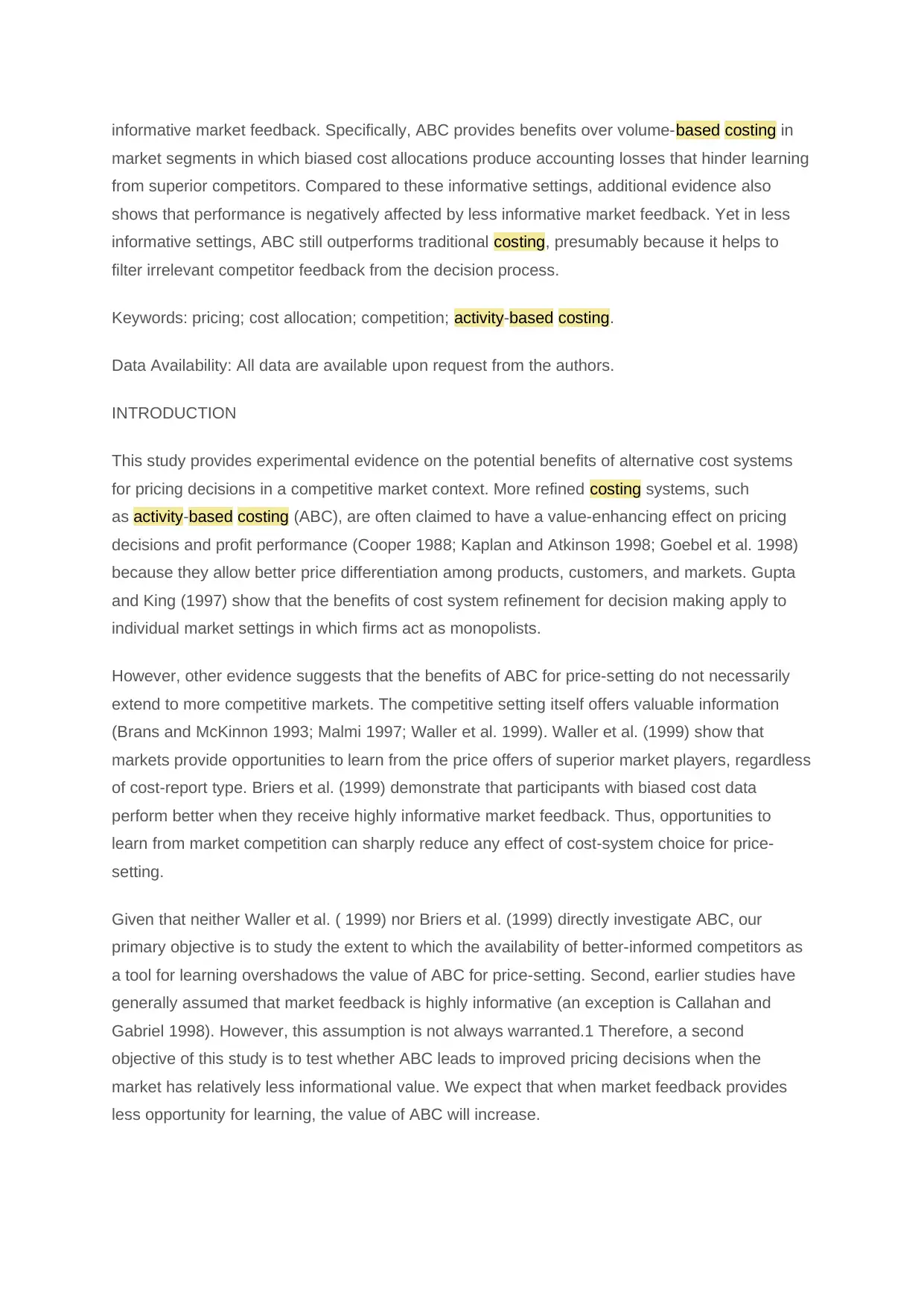
informative market feedback. Specifically, ABC provides benefits over volume-based costing in
market segments in which biased cost allocations produce accounting losses that hinder learning
from superior competitors. Compared to these informative settings, additional evidence also
shows that performance is negatively affected by less informative market feedback. Yet in less
informative settings, ABC still outperforms traditional costing, presumably because it helps to
filter irrelevant competitor feedback from the decision process.
Keywords: pricing; cost allocation; competition; activity-based costing.
Data Availability: All data are available upon request from the authors.
INTRODUCTION
This study provides experimental evidence on the potential benefits of alternative cost systems
for pricing decisions in a competitive market context. More refined costing systems, such
as activity-based costing (ABC), are often claimed to have a value-enhancing effect on pricing
decisions and profit performance (Cooper 1988; Kaplan and Atkinson 1998; Goebel et al. 1998)
because they allow better price differentiation among products, customers, and markets. Gupta
and King (1997) show that the benefits of cost system refinement for decision making apply to
individual market settings in which firms act as monopolists.
However, other evidence suggests that the benefits of ABC for price-setting do not necessarily
extend to more competitive markets. The competitive setting itself offers valuable information
(Brans and McKinnon 1993; Malmi 1997; Waller et al. 1999). Waller et al. (1999) show that
markets provide opportunities to learn from the price offers of superior market players, regardless
of cost-report type. Briers et al. (1999) demonstrate that participants with biased cost data
perform better when they receive highly informative market feedback. Thus, opportunities to
learn from market competition can sharply reduce any effect of cost-system choice for price-
setting.
Given that neither Waller et al. ( 1999) nor Briers et al. (1999) directly investigate ABC, our
primary objective is to study the extent to which the availability of better-informed competitors as
a tool for learning overshadows the value of ABC for price-setting. Second, earlier studies have
generally assumed that market feedback is highly informative (an exception is Callahan and
Gabriel 1998). However, this assumption is not always warranted.1 Therefore, a second
objective of this study is to test whether ABC leads to improved pricing decisions when the
market has relatively less informational value. We expect that when market feedback provides
less opportunity for learning, the value of ABC will increase.
market segments in which biased cost allocations produce accounting losses that hinder learning
from superior competitors. Compared to these informative settings, additional evidence also
shows that performance is negatively affected by less informative market feedback. Yet in less
informative settings, ABC still outperforms traditional costing, presumably because it helps to
filter irrelevant competitor feedback from the decision process.
Keywords: pricing; cost allocation; competition; activity-based costing.
Data Availability: All data are available upon request from the authors.
INTRODUCTION
This study provides experimental evidence on the potential benefits of alternative cost systems
for pricing decisions in a competitive market context. More refined costing systems, such
as activity-based costing (ABC), are often claimed to have a value-enhancing effect on pricing
decisions and profit performance (Cooper 1988; Kaplan and Atkinson 1998; Goebel et al. 1998)
because they allow better price differentiation among products, customers, and markets. Gupta
and King (1997) show that the benefits of cost system refinement for decision making apply to
individual market settings in which firms act as monopolists.
However, other evidence suggests that the benefits of ABC for price-setting do not necessarily
extend to more competitive markets. The competitive setting itself offers valuable information
(Brans and McKinnon 1993; Malmi 1997; Waller et al. 1999). Waller et al. (1999) show that
markets provide opportunities to learn from the price offers of superior market players, regardless
of cost-report type. Briers et al. (1999) demonstrate that participants with biased cost data
perform better when they receive highly informative market feedback. Thus, opportunities to
learn from market competition can sharply reduce any effect of cost-system choice for price-
setting.
Given that neither Waller et al. ( 1999) nor Briers et al. (1999) directly investigate ABC, our
primary objective is to study the extent to which the availability of better-informed competitors as
a tool for learning overshadows the value of ABC for price-setting. Second, earlier studies have
generally assumed that market feedback is highly informative (an exception is Callahan and
Gabriel 1998). However, this assumption is not always warranted.1 Therefore, a second
objective of this study is to test whether ABC leads to improved pricing decisions when the
market has relatively less informational value. We expect that when market feedback provides
less opportunity for learning, the value of ABC will increase.

In this experiment, participants set prices in multiple market segments in a competitive duopoly.
Accounting report type and market feedback are manipulated as between-subjects factors.
Contrary to Callahan and Gabriel's (1998) findings, the present results show that ABC has a
strong benefit when market feedback is not very informative. Second, contrary to our expectation
that highly informative market feedback would dominate cost-system choice, the results suggest
that ABC still outperforms biased cost data when biased cost allocations generate accounting
losses for a particular market segment. In this market segment, participants hesitate to follow the
price choices of a superior competitor, presumably because they are averse to economically
prudent decisions that produce accounting losses (Kachelmeier 1996; Tversky and Kahneman
1991). In this regard, this study qualifies the conclusions of Waller et al. (1999), by showing that
informative markets do not always make cost-system choice redundant for price-setting.
THEORETICAL BACKGROUND AND HYPOTHESES
Price-Setting, Accounting Data, and the Role of Market Feedback
Most studies on the role of accounting data for price-setting study decision makers in individual
settings. Early studies concluded that cost system choice mattered, since decision makers relied
heavily on a given cost system's output (Ashton 1976; Barnes and Webb 1986; Dyckman et al.
1982). Wilner and Birnberg (1986) and Moon (1990) proposed that certain types of feedback
might mitigate such reliance on the cost system. Latter studies documented only small mitigating
effects of outcome feedback (Hilton et al. 1988), financial rewards (Briers et al. 1997), or process
feedback (Gupta and King 1997); most participants still relied on their cost system for
subsequent adjustments of the decision process. Hence, accurate cost systems such as ABC
continued to confer a significant benefit over distorted cost data in individual settings without
other market agents (Gupta and King 1997; Briers et al. 1997).2
Waller et al. (1999) argued that these results would not necessarily extend to a competitive
market context, due to the pressure from market competition to utilize superior market feedback.
They showed that the effects of absorption versus variable costing on price-setting quickly
disappeared in such an environment because decision makers learned from the price offers of
successful sellers in the market. Price offers rapidly converged toward the competitive
equilibrium. They concluded that the contribution of the cost system is limited because market
feedback dominates accounting information. Waller et al. (1999) were only concerned with the
effects of variable costing versus absorption costing, as opposed to the broader issue of whether
alternative full-costing systems such as ABC affect pricing decisions in a competitive context
(Foster and Gupta 1994, 58). Second, Waller et al. (1999) considered only one product in their
design, such that cost allocation was not an issue. However, Waller et al. (1999, 735)
conjectured that learning from informative market feedback would be more difficult in a
Accounting report type and market feedback are manipulated as between-subjects factors.
Contrary to Callahan and Gabriel's (1998) findings, the present results show that ABC has a
strong benefit when market feedback is not very informative. Second, contrary to our expectation
that highly informative market feedback would dominate cost-system choice, the results suggest
that ABC still outperforms biased cost data when biased cost allocations generate accounting
losses for a particular market segment. In this market segment, participants hesitate to follow the
price choices of a superior competitor, presumably because they are averse to economically
prudent decisions that produce accounting losses (Kachelmeier 1996; Tversky and Kahneman
1991). In this regard, this study qualifies the conclusions of Waller et al. (1999), by showing that
informative markets do not always make cost-system choice redundant for price-setting.
THEORETICAL BACKGROUND AND HYPOTHESES
Price-Setting, Accounting Data, and the Role of Market Feedback
Most studies on the role of accounting data for price-setting study decision makers in individual
settings. Early studies concluded that cost system choice mattered, since decision makers relied
heavily on a given cost system's output (Ashton 1976; Barnes and Webb 1986; Dyckman et al.
1982). Wilner and Birnberg (1986) and Moon (1990) proposed that certain types of feedback
might mitigate such reliance on the cost system. Latter studies documented only small mitigating
effects of outcome feedback (Hilton et al. 1988), financial rewards (Briers et al. 1997), or process
feedback (Gupta and King 1997); most participants still relied on their cost system for
subsequent adjustments of the decision process. Hence, accurate cost systems such as ABC
continued to confer a significant benefit over distorted cost data in individual settings without
other market agents (Gupta and King 1997; Briers et al. 1997).2
Waller et al. (1999) argued that these results would not necessarily extend to a competitive
market context, due to the pressure from market competition to utilize superior market feedback.
They showed that the effects of absorption versus variable costing on price-setting quickly
disappeared in such an environment because decision makers learned from the price offers of
successful sellers in the market. Price offers rapidly converged toward the competitive
equilibrium. They concluded that the contribution of the cost system is limited because market
feedback dominates accounting information. Waller et al. (1999) were only concerned with the
effects of variable costing versus absorption costing, as opposed to the broader issue of whether
alternative full-costing systems such as ABC affect pricing decisions in a competitive context
(Foster and Gupta 1994, 58). Second, Waller et al. (1999) considered only one product in their
design, such that cost allocation was not an issue. However, Waller et al. (1999, 735)
conjectured that learning from informative market feedback would be more difficult in a
Secure Best Marks with AI Grader
Need help grading? Try our AI Grader for instant feedback on your assignments.
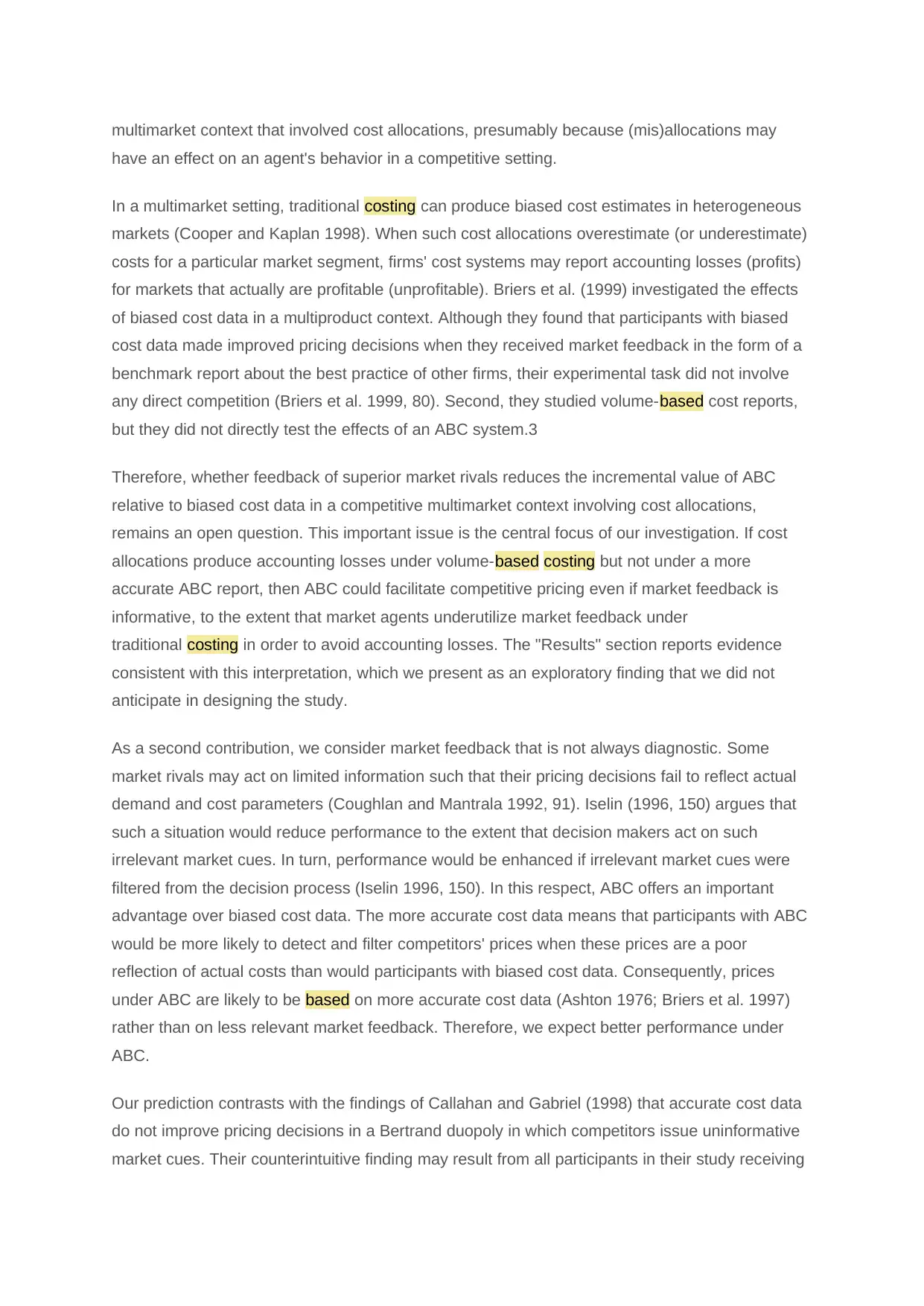
multimarket context that involved cost allocations, presumably because (mis)allocations may
have an effect on an agent's behavior in a competitive setting.
In a multimarket setting, traditional costing can produce biased cost estimates in heterogeneous
markets (Cooper and Kaplan 1998). When such cost allocations overestimate (or underestimate)
costs for a particular market segment, firms' cost systems may report accounting losses (profits)
for markets that actually are profitable (unprofitable). Briers et al. (1999) investigated the effects
of biased cost data in a multiproduct context. Although they found that participants with biased
cost data made improved pricing decisions when they received market feedback in the form of a
benchmark report about the best practice of other firms, their experimental task did not involve
any direct competition (Briers et al. 1999, 80). Second, they studied volume-based cost reports,
but they did not directly test the effects of an ABC system.3
Therefore, whether feedback of superior market rivals reduces the incremental value of ABC
relative to biased cost data in a competitive multimarket context involving cost allocations,
remains an open question. This important issue is the central focus of our investigation. If cost
allocations produce accounting losses under volume-based costing but not under a more
accurate ABC report, then ABC could facilitate competitive pricing even if market feedback is
informative, to the extent that market agents underutilize market feedback under
traditional costing in order to avoid accounting losses. The "Results" section reports evidence
consistent with this interpretation, which we present as an exploratory finding that we did not
anticipate in designing the study.
As a second contribution, we consider market feedback that is not always diagnostic. Some
market rivals may act on limited information such that their pricing decisions fail to reflect actual
demand and cost parameters (Coughlan and Mantrala 1992, 91). Iselin (1996, 150) argues that
such a situation would reduce performance to the extent that decision makers act on such
irrelevant market cues. In turn, performance would be enhanced if irrelevant market cues were
filtered from the decision process (Iselin 1996, 150). In this respect, ABC offers an important
advantage over biased cost data. The more accurate cost data means that participants with ABC
would be more likely to detect and filter competitors' prices when these prices are a poor
reflection of actual costs than would participants with biased cost data. Consequently, prices
under ABC are likely to be based on more accurate cost data (Ashton 1976; Briers et al. 1997)
rather than on less relevant market feedback. Therefore, we expect better performance under
ABC.
Our prediction contrasts with the findings of Callahan and Gabriel (1998) that accurate cost data
do not improve pricing decisions in a Bertrand duopoly in which competitors issue uninformative
market cues. Their counterintuitive finding may result from all participants in their study receiving
have an effect on an agent's behavior in a competitive setting.
In a multimarket setting, traditional costing can produce biased cost estimates in heterogeneous
markets (Cooper and Kaplan 1998). When such cost allocations overestimate (or underestimate)
costs for a particular market segment, firms' cost systems may report accounting losses (profits)
for markets that actually are profitable (unprofitable). Briers et al. (1999) investigated the effects
of biased cost data in a multiproduct context. Although they found that participants with biased
cost data made improved pricing decisions when they received market feedback in the form of a
benchmark report about the best practice of other firms, their experimental task did not involve
any direct competition (Briers et al. 1999, 80). Second, they studied volume-based cost reports,
but they did not directly test the effects of an ABC system.3
Therefore, whether feedback of superior market rivals reduces the incremental value of ABC
relative to biased cost data in a competitive multimarket context involving cost allocations,
remains an open question. This important issue is the central focus of our investigation. If cost
allocations produce accounting losses under volume-based costing but not under a more
accurate ABC report, then ABC could facilitate competitive pricing even if market feedback is
informative, to the extent that market agents underutilize market feedback under
traditional costing in order to avoid accounting losses. The "Results" section reports evidence
consistent with this interpretation, which we present as an exploratory finding that we did not
anticipate in designing the study.
As a second contribution, we consider market feedback that is not always diagnostic. Some
market rivals may act on limited information such that their pricing decisions fail to reflect actual
demand and cost parameters (Coughlan and Mantrala 1992, 91). Iselin (1996, 150) argues that
such a situation would reduce performance to the extent that decision makers act on such
irrelevant market cues. In turn, performance would be enhanced if irrelevant market cues were
filtered from the decision process (Iselin 1996, 150). In this respect, ABC offers an important
advantage over biased cost data. The more accurate cost data means that participants with ABC
would be more likely to detect and filter competitors' prices when these prices are a poor
reflection of actual costs than would participants with biased cost data. Consequently, prices
under ABC are likely to be based on more accurate cost data (Ashton 1976; Briers et al. 1997)
rather than on less relevant market feedback. Therefore, we expect better performance under
ABC.
Our prediction contrasts with the findings of Callahan and Gabriel (1998) that accurate cost data
do not improve pricing decisions in a Bertrand duopoly in which competitors issue uninformative
market cues. Their counterintuitive finding may result from all participants in their study receiving
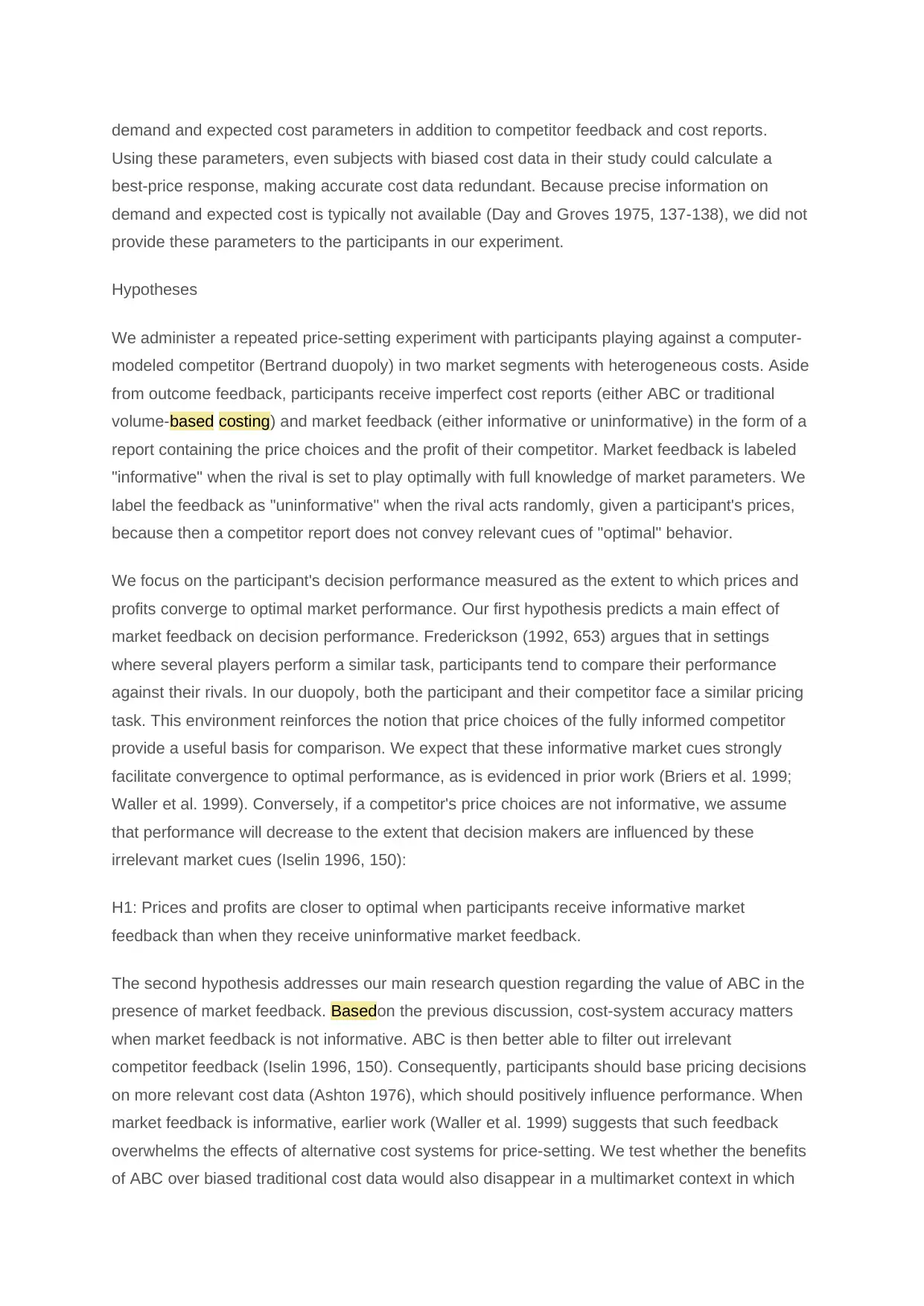
demand and expected cost parameters in addition to competitor feedback and cost reports.
Using these parameters, even subjects with biased cost data in their study could calculate a
best-price response, making accurate cost data redundant. Because precise information on
demand and expected cost is typically not available (Day and Groves 1975, 137-138), we did not
provide these parameters to the participants in our experiment.
Hypotheses
We administer a repeated price-setting experiment with participants playing against a computer-
modeled competitor (Bertrand duopoly) in two market segments with heterogeneous costs. Aside
from outcome feedback, participants receive imperfect cost reports (either ABC or traditional
volume-based costing) and market feedback (either informative or uninformative) in the form of a
report containing the price choices and the profit of their competitor. Market feedback is labeled
"informative" when the rival is set to play optimally with full knowledge of market parameters. We
label the feedback as "uninformative" when the rival acts randomly, given a participant's prices,
because then a competitor report does not convey relevant cues of "optimal" behavior.
We focus on the participant's decision performance measured as the extent to which prices and
profits converge to optimal market performance. Our first hypothesis predicts a main effect of
market feedback on decision performance. Frederickson (1992, 653) argues that in settings
where several players perform a similar task, participants tend to compare their performance
against their rivals. In our duopoly, both the participant and their competitor face a similar pricing
task. This environment reinforces the notion that price choices of the fully informed competitor
provide a useful basis for comparison. We expect that these informative market cues strongly
facilitate convergence to optimal performance, as is evidenced in prior work (Briers et al. 1999;
Waller et al. 1999). Conversely, if a competitor's price choices are not informative, we assume
that performance will decrease to the extent that decision makers are influenced by these
irrelevant market cues (Iselin 1996, 150):
H1: Prices and profits are closer to optimal when participants receive informative market
feedback than when they receive uninformative market feedback.
The second hypothesis addresses our main research question regarding the value of ABC in the
presence of market feedback. Basedon the previous discussion, cost-system accuracy matters
when market feedback is not informative. ABC is then better able to filter out irrelevant
competitor feedback (Iselin 1996, 150). Consequently, participants should base pricing decisions
on more relevant cost data (Ashton 1976), which should positively influence performance. When
market feedback is informative, earlier work (Waller et al. 1999) suggests that such feedback
overwhelms the effects of alternative cost systems for price-setting. We test whether the benefits
of ABC over biased traditional cost data would also disappear in a multimarket context in which
Using these parameters, even subjects with biased cost data in their study could calculate a
best-price response, making accurate cost data redundant. Because precise information on
demand and expected cost is typically not available (Day and Groves 1975, 137-138), we did not
provide these parameters to the participants in our experiment.
Hypotheses
We administer a repeated price-setting experiment with participants playing against a computer-
modeled competitor (Bertrand duopoly) in two market segments with heterogeneous costs. Aside
from outcome feedback, participants receive imperfect cost reports (either ABC or traditional
volume-based costing) and market feedback (either informative or uninformative) in the form of a
report containing the price choices and the profit of their competitor. Market feedback is labeled
"informative" when the rival is set to play optimally with full knowledge of market parameters. We
label the feedback as "uninformative" when the rival acts randomly, given a participant's prices,
because then a competitor report does not convey relevant cues of "optimal" behavior.
We focus on the participant's decision performance measured as the extent to which prices and
profits converge to optimal market performance. Our first hypothesis predicts a main effect of
market feedback on decision performance. Frederickson (1992, 653) argues that in settings
where several players perform a similar task, participants tend to compare their performance
against their rivals. In our duopoly, both the participant and their competitor face a similar pricing
task. This environment reinforces the notion that price choices of the fully informed competitor
provide a useful basis for comparison. We expect that these informative market cues strongly
facilitate convergence to optimal performance, as is evidenced in prior work (Briers et al. 1999;
Waller et al. 1999). Conversely, if a competitor's price choices are not informative, we assume
that performance will decrease to the extent that decision makers are influenced by these
irrelevant market cues (Iselin 1996, 150):
H1: Prices and profits are closer to optimal when participants receive informative market
feedback than when they receive uninformative market feedback.
The second hypothesis addresses our main research question regarding the value of ABC in the
presence of market feedback. Basedon the previous discussion, cost-system accuracy matters
when market feedback is not informative. ABC is then better able to filter out irrelevant
competitor feedback (Iselin 1996, 150). Consequently, participants should base pricing decisions
on more relevant cost data (Ashton 1976), which should positively influence performance. When
market feedback is informative, earlier work (Waller et al. 1999) suggests that such feedback
overwhelms the effects of alternative cost systems for price-setting. We test whether the benefits
of ABC over biased traditional cost data would also disappear in a multimarket context in which
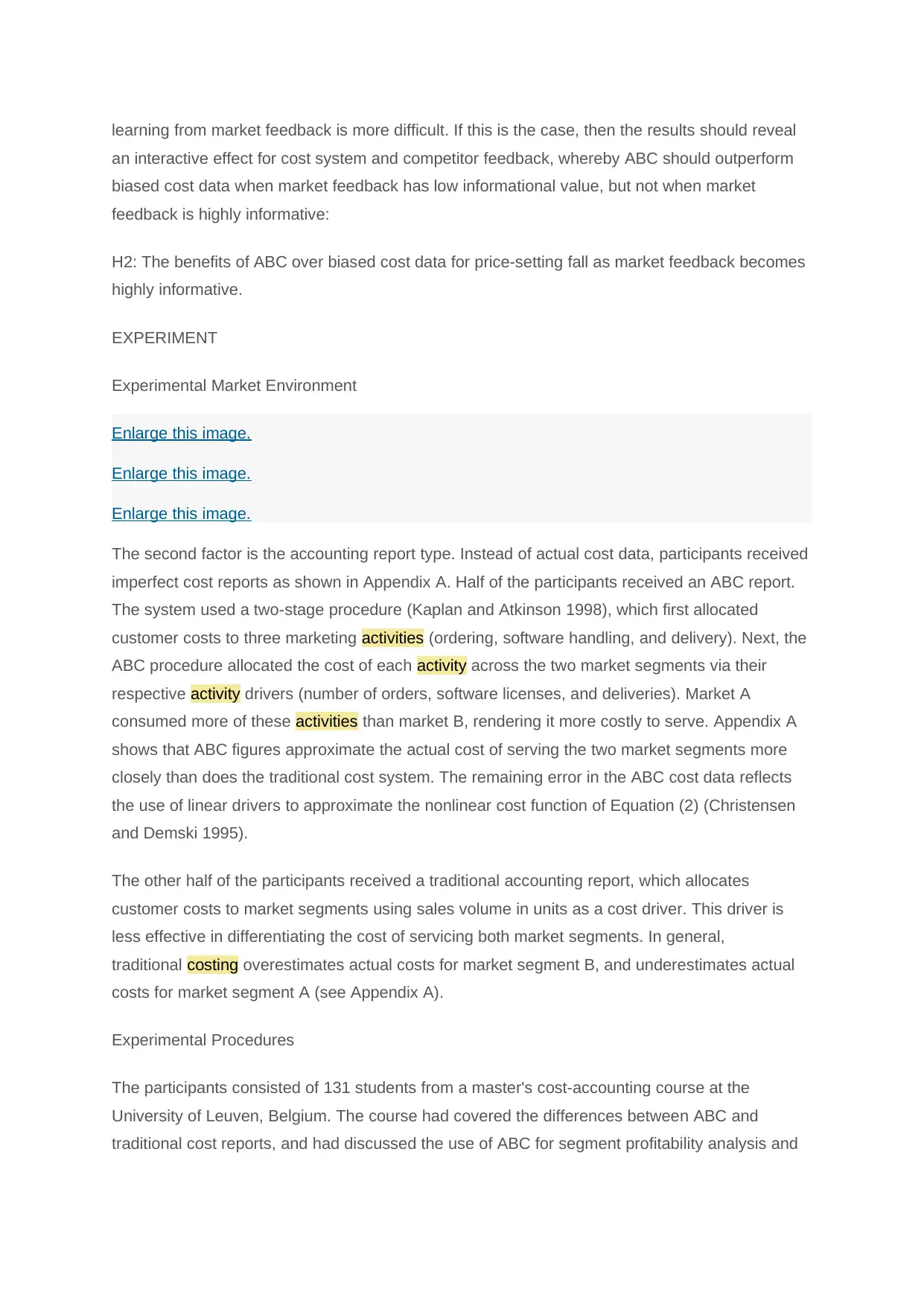
learning from market feedback is more difficult. If this is the case, then the results should reveal
an interactive effect for cost system and competitor feedback, whereby ABC should outperform
biased cost data when market feedback has low informational value, but not when market
feedback is highly informative:
H2: The benefits of ABC over biased cost data for price-setting fall as market feedback becomes
highly informative.
EXPERIMENT
Experimental Market Environment
Enlarge this image.
Enlarge this image.
Enlarge this image.
The second factor is the accounting report type. Instead of actual cost data, participants received
imperfect cost reports as shown in Appendix A. Half of the participants received an ABC report.
The system used a two-stage procedure (Kaplan and Atkinson 1998), which first allocated
customer costs to three marketing activities (ordering, software handling, and delivery). Next, the
ABC procedure allocated the cost of each activity across the two market segments via their
respective activity drivers (number of orders, software licenses, and deliveries). Market A
consumed more of these activities than market B, rendering it more costly to serve. Appendix A
shows that ABC figures approximate the actual cost of serving the two market segments more
closely than does the traditional cost system. The remaining error in the ABC cost data reflects
the use of linear drivers to approximate the nonlinear cost function of Equation (2) (Christensen
and Demski 1995).
The other half of the participants received a traditional accounting report, which allocates
customer costs to market segments using sales volume in units as a cost driver. This driver is
less effective in differentiating the cost of servicing both market segments. In general,
traditional costing overestimates actual costs for market segment B, and underestimates actual
costs for market segment A (see Appendix A).
Experimental Procedures
The participants consisted of 131 students from a master's cost-accounting course at the
University of Leuven, Belgium. The course had covered the differences between ABC and
traditional cost reports, and had discussed the use of ABC for segment profitability analysis and
an interactive effect for cost system and competitor feedback, whereby ABC should outperform
biased cost data when market feedback has low informational value, but not when market
feedback is highly informative:
H2: The benefits of ABC over biased cost data for price-setting fall as market feedback becomes
highly informative.
EXPERIMENT
Experimental Market Environment
Enlarge this image.
Enlarge this image.
Enlarge this image.
The second factor is the accounting report type. Instead of actual cost data, participants received
imperfect cost reports as shown in Appendix A. Half of the participants received an ABC report.
The system used a two-stage procedure (Kaplan and Atkinson 1998), which first allocated
customer costs to three marketing activities (ordering, software handling, and delivery). Next, the
ABC procedure allocated the cost of each activity across the two market segments via their
respective activity drivers (number of orders, software licenses, and deliveries). Market A
consumed more of these activities than market B, rendering it more costly to serve. Appendix A
shows that ABC figures approximate the actual cost of serving the two market segments more
closely than does the traditional cost system. The remaining error in the ABC cost data reflects
the use of linear drivers to approximate the nonlinear cost function of Equation (2) (Christensen
and Demski 1995).
The other half of the participants received a traditional accounting report, which allocates
customer costs to market segments using sales volume in units as a cost driver. This driver is
less effective in differentiating the cost of servicing both market segments. In general,
traditional costing overestimates actual costs for market segment B, and underestimates actual
costs for market segment A (see Appendix A).
Experimental Procedures
The participants consisted of 131 students from a master's cost-accounting course at the
University of Leuven, Belgium. The course had covered the differences between ABC and
traditional cost reports, and had discussed the use of ABC for segment profitability analysis and
Paraphrase This Document
Need a fresh take? Get an instant paraphrase of this document with our AI Paraphraser
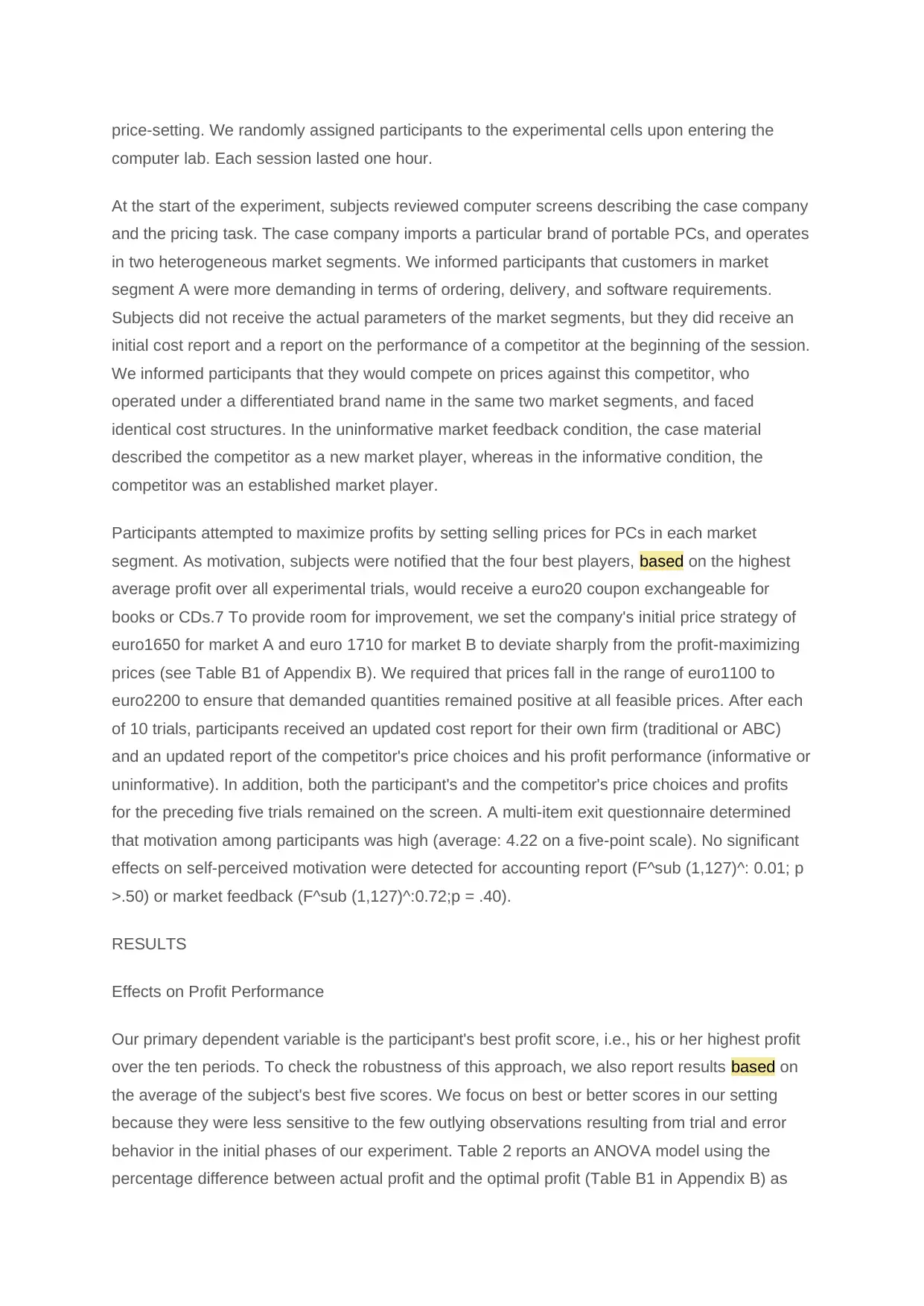
price-setting. We randomly assigned participants to the experimental cells upon entering the
computer lab. Each session lasted one hour.
At the start of the experiment, subjects reviewed computer screens describing the case company
and the pricing task. The case company imports a particular brand of portable PCs, and operates
in two heterogeneous market segments. We informed participants that customers in market
segment A were more demanding in terms of ordering, delivery, and software requirements.
Subjects did not receive the actual parameters of the market segments, but they did receive an
initial cost report and a report on the performance of a competitor at the beginning of the session.
We informed participants that they would compete on prices against this competitor, who
operated under a differentiated brand name in the same two market segments, and faced
identical cost structures. In the uninformative market feedback condition, the case material
described the competitor as a new market player, whereas in the informative condition, the
competitor was an established market player.
Participants attempted to maximize profits by setting selling prices for PCs in each market
segment. As motivation, subjects were notified that the four best players, based on the highest
average profit over all experimental trials, would receive a euro20 coupon exchangeable for
books or CDs.7 To provide room for improvement, we set the company's initial price strategy of
euro1650 for market A and euro 1710 for market B to deviate sharply from the profit-maximizing
prices (see Table B1 of Appendix B). We required that prices fall in the range of euro1100 to
euro2200 to ensure that demanded quantities remained positive at all feasible prices. After each
of 10 trials, participants received an updated cost report for their own firm (traditional or ABC)
and an updated report of the competitor's price choices and his profit performance (informative or
uninformative). In addition, both the participant's and the competitor's price choices and profits
for the preceding five trials remained on the screen. A multi-item exit questionnaire determined
that motivation among participants was high (average: 4.22 on a five-point scale). No significant
effects on self-perceived motivation were detected for accounting report (F^sub (1,127)^: 0.01; p
>.50) or market feedback (F^sub (1,127)^:0.72;p = .40).
RESULTS
Effects on Profit Performance
Our primary dependent variable is the participant's best profit score, i.e., his or her highest profit
over the ten periods. To check the robustness of this approach, we also report results based on
the average of the subject's best five scores. We focus on best or better scores in our setting
because they were less sensitive to the few outlying observations resulting from trial and error
behavior in the initial phases of our experiment. Table 2 reports an ANOVA model using the
percentage difference between actual profit and the optimal profit (Table B1 in Appendix B) as
computer lab. Each session lasted one hour.
At the start of the experiment, subjects reviewed computer screens describing the case company
and the pricing task. The case company imports a particular brand of portable PCs, and operates
in two heterogeneous market segments. We informed participants that customers in market
segment A were more demanding in terms of ordering, delivery, and software requirements.
Subjects did not receive the actual parameters of the market segments, but they did receive an
initial cost report and a report on the performance of a competitor at the beginning of the session.
We informed participants that they would compete on prices against this competitor, who
operated under a differentiated brand name in the same two market segments, and faced
identical cost structures. In the uninformative market feedback condition, the case material
described the competitor as a new market player, whereas in the informative condition, the
competitor was an established market player.
Participants attempted to maximize profits by setting selling prices for PCs in each market
segment. As motivation, subjects were notified that the four best players, based on the highest
average profit over all experimental trials, would receive a euro20 coupon exchangeable for
books or CDs.7 To provide room for improvement, we set the company's initial price strategy of
euro1650 for market A and euro 1710 for market B to deviate sharply from the profit-maximizing
prices (see Table B1 of Appendix B). We required that prices fall in the range of euro1100 to
euro2200 to ensure that demanded quantities remained positive at all feasible prices. After each
of 10 trials, participants received an updated cost report for their own firm (traditional or ABC)
and an updated report of the competitor's price choices and his profit performance (informative or
uninformative). In addition, both the participant's and the competitor's price choices and profits
for the preceding five trials remained on the screen. A multi-item exit questionnaire determined
that motivation among participants was high (average: 4.22 on a five-point scale). No significant
effects on self-perceived motivation were detected for accounting report (F^sub (1,127)^: 0.01; p
>.50) or market feedback (F^sub (1,127)^:0.72;p = .40).
RESULTS
Effects on Profit Performance
Our primary dependent variable is the participant's best profit score, i.e., his or her highest profit
over the ten periods. To check the robustness of this approach, we also report results based on
the average of the subject's best five scores. We focus on best or better scores in our setting
because they were less sensitive to the few outlying observations resulting from trial and error
behavior in the initial phases of our experiment. Table 2 reports an ANOVA model using the
percentage difference between actual profit and the optimal profit (Table B1 in Appendix B) as
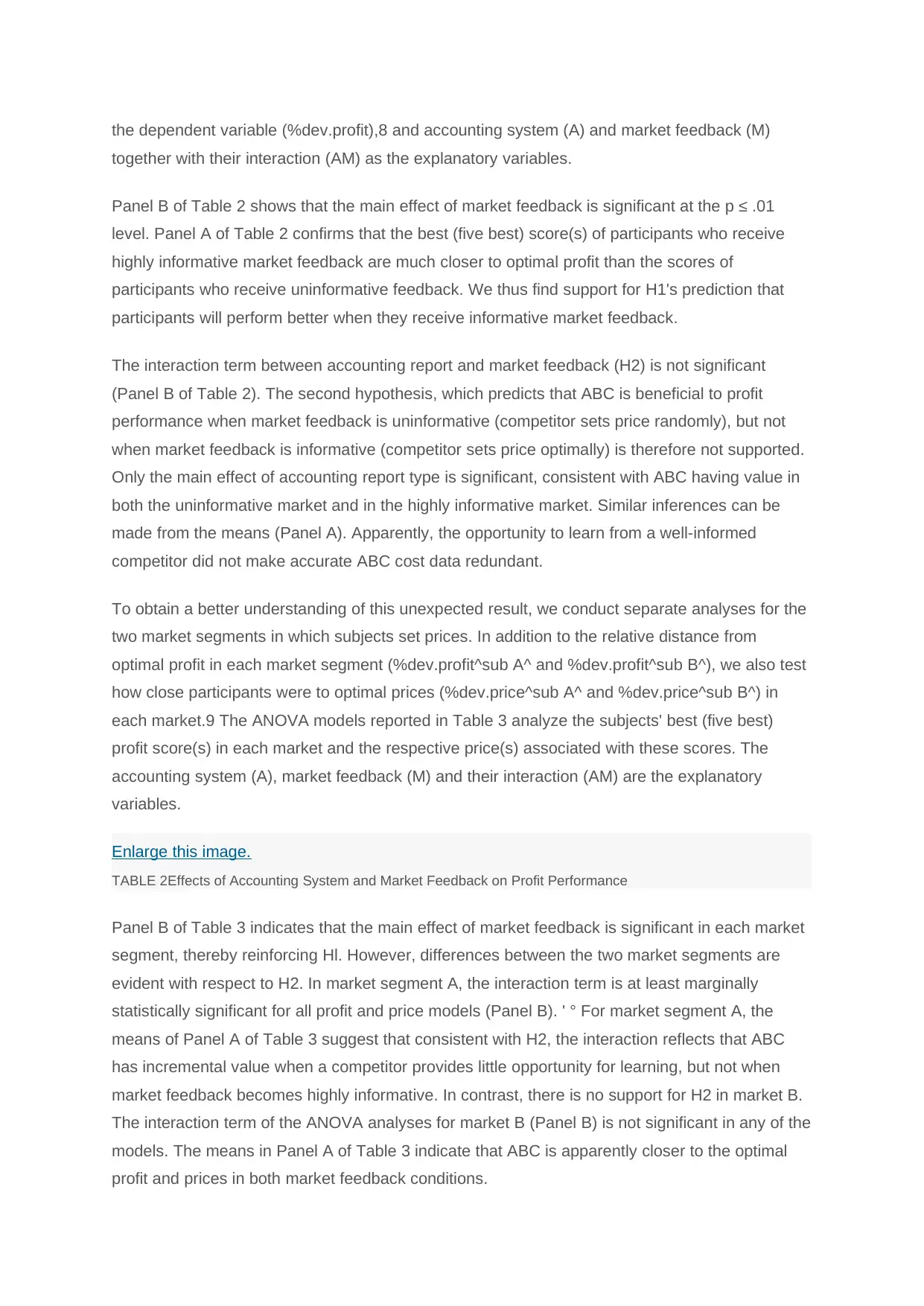
the dependent variable (%dev.profit),8 and accounting system (A) and market feedback (M)
together with their interaction (AM) as the explanatory variables.
Panel B of Table 2 shows that the main effect of market feedback is significant at the p ≤ .01
level. Panel A of Table 2 confirms that the best (five best) score(s) of participants who receive
highly informative market feedback are much closer to optimal profit than the scores of
participants who receive uninformative feedback. We thus find support for H1's prediction that
participants will perform better when they receive informative market feedback.
The interaction term between accounting report and market feedback (H2) is not significant
(Panel B of Table 2). The second hypothesis, which predicts that ABC is beneficial to profit
performance when market feedback is uninformative (competitor sets price randomly), but not
when market feedback is informative (competitor sets price optimally) is therefore not supported.
Only the main effect of accounting report type is significant, consistent with ABC having value in
both the uninformative market and in the highly informative market. Similar inferences can be
made from the means (Panel A). Apparently, the opportunity to learn from a well-informed
competitor did not make accurate ABC cost data redundant.
To obtain a better understanding of this unexpected result, we conduct separate analyses for the
two market segments in which subjects set prices. In addition to the relative distance from
optimal profit in each market segment (%dev.profit^sub A^ and %dev.profit^sub B^), we also test
how close participants were to optimal prices (%dev.price^sub A^ and %dev.price^sub B^) in
each market.9 The ANOVA models reported in Table 3 analyze the subjects' best (five best)
profit score(s) in each market and the respective price(s) associated with these scores. The
accounting system (A), market feedback (M) and their interaction (AM) are the explanatory
variables.
Enlarge this image.
TABLE 2Effects of Accounting System and Market Feedback on Profit Performance
Panel B of Table 3 indicates that the main effect of market feedback is significant in each market
segment, thereby reinforcing Hl. However, differences between the two market segments are
evident with respect to H2. In market segment A, the interaction term is at least marginally
statistically significant for all profit and price models (Panel B). ' ° For market segment A, the
means of Panel A of Table 3 suggest that consistent with H2, the interaction reflects that ABC
has incremental value when a competitor provides little opportunity for learning, but not when
market feedback becomes highly informative. In contrast, there is no support for H2 in market B.
The interaction term of the ANOVA analyses for market B (Panel B) is not significant in any of the
models. The means in Panel A of Table 3 indicate that ABC is apparently closer to the optimal
profit and prices in both market feedback conditions.
together with their interaction (AM) as the explanatory variables.
Panel B of Table 2 shows that the main effect of market feedback is significant at the p ≤ .01
level. Panel A of Table 2 confirms that the best (five best) score(s) of participants who receive
highly informative market feedback are much closer to optimal profit than the scores of
participants who receive uninformative feedback. We thus find support for H1's prediction that
participants will perform better when they receive informative market feedback.
The interaction term between accounting report and market feedback (H2) is not significant
(Panel B of Table 2). The second hypothesis, which predicts that ABC is beneficial to profit
performance when market feedback is uninformative (competitor sets price randomly), but not
when market feedback is informative (competitor sets price optimally) is therefore not supported.
Only the main effect of accounting report type is significant, consistent with ABC having value in
both the uninformative market and in the highly informative market. Similar inferences can be
made from the means (Panel A). Apparently, the opportunity to learn from a well-informed
competitor did not make accurate ABC cost data redundant.
To obtain a better understanding of this unexpected result, we conduct separate analyses for the
two market segments in which subjects set prices. In addition to the relative distance from
optimal profit in each market segment (%dev.profit^sub A^ and %dev.profit^sub B^), we also test
how close participants were to optimal prices (%dev.price^sub A^ and %dev.price^sub B^) in
each market.9 The ANOVA models reported in Table 3 analyze the subjects' best (five best)
profit score(s) in each market and the respective price(s) associated with these scores. The
accounting system (A), market feedback (M) and their interaction (AM) are the explanatory
variables.
Enlarge this image.
TABLE 2Effects of Accounting System and Market Feedback on Profit Performance
Panel B of Table 3 indicates that the main effect of market feedback is significant in each market
segment, thereby reinforcing Hl. However, differences between the two market segments are
evident with respect to H2. In market segment A, the interaction term is at least marginally
statistically significant for all profit and price models (Panel B). ' ° For market segment A, the
means of Panel A of Table 3 suggest that consistent with H2, the interaction reflects that ABC
has incremental value when a competitor provides little opportunity for learning, but not when
market feedback becomes highly informative. In contrast, there is no support for H2 in market B.
The interaction term of the ANOVA analyses for market B (Panel B) is not significant in any of the
models. The means in Panel A of Table 3 indicate that ABC is apparently closer to the optimal
profit and prices in both market feedback conditions.

Enlarge this image.
TABLE 3Effects of Accounting System and Market Feedback by Market Segment
In summary, the results for H2 appear to differ sharply across the two market segments. Contrary
to the conclusions of Waller et al. (1999), we conclude that a well-informed competitor does not
necessarily make cost-system choice completely redundant, because the effect of cost system
still exists in one particular market segment. We next explore a potential explanation for this
unexpected result.
Supplementary Analysis
We speculate that the unexpected result in market segment B may reflect participants with
biased cost data underutilizing informative market feedback and setting prices too high due to
loss aversion (Tversky and Kahneman 1991). By overstating the cost in market segment B,
traditional cost allocations report a unit cost of around euro1400. Therefore, the optimal
competitive price of euro1362 generated accounting losses in market segment B. Tversky and
Kahneman (1991) argue that participants are averse to loss-generating scenarios and try to
adjust their decision process to avoid negative outcomes. According to this scenario, to avoid
accounting losses in market segment B, participants with biased cost data would charge prices
significantly above this cost even in the presence of informative market feedback. They would not
consider that such losses resulted from biased cost allocations. The resulting performance of
participants with traditional reports in segment B was inferior to that for participants with ABC.
This result is consistent with the ABC system not generating accounting losses under an optimal
competitive pricing strategy in market segment B.11
These findings bear some similarity to those in Kachelmeier (1996) where accounting methods
that emphasized sunk (irrelevant) costs led sellers to seek significantly higher prices for their
assets in an attempt to cover costs and avoid accounting losses. While these different market
negotiation dynamics did not materially affect actual trading prices in Kachelmeier (1996),
accounting losses resulting from biased cost allocations did influence actual prices in the current
study.
We note that these effects were not observed in market segment A, apparently because
traditional cost allocations produced accounting profits at optimal price levels in that segment.
We added market segment as a repeated measure to the ANOVA models on profits to test
whether the three-way interaction among accounting system, market feedback, and market
segment is significant. Such a three-way interaction would corroborate our conjecture that
informative market feedback removes the benefits of ABC over biased cost data when optimal
pricing decisions produce a profit (segment A), but not when optimal competitive prices produce
an accounting loss under traditional costing (segment B). The three-way interaction is indeed
TABLE 3Effects of Accounting System and Market Feedback by Market Segment
In summary, the results for H2 appear to differ sharply across the two market segments. Contrary
to the conclusions of Waller et al. (1999), we conclude that a well-informed competitor does not
necessarily make cost-system choice completely redundant, because the effect of cost system
still exists in one particular market segment. We next explore a potential explanation for this
unexpected result.
Supplementary Analysis
We speculate that the unexpected result in market segment B may reflect participants with
biased cost data underutilizing informative market feedback and setting prices too high due to
loss aversion (Tversky and Kahneman 1991). By overstating the cost in market segment B,
traditional cost allocations report a unit cost of around euro1400. Therefore, the optimal
competitive price of euro1362 generated accounting losses in market segment B. Tversky and
Kahneman (1991) argue that participants are averse to loss-generating scenarios and try to
adjust their decision process to avoid negative outcomes. According to this scenario, to avoid
accounting losses in market segment B, participants with biased cost data would charge prices
significantly above this cost even in the presence of informative market feedback. They would not
consider that such losses resulted from biased cost allocations. The resulting performance of
participants with traditional reports in segment B was inferior to that for participants with ABC.
This result is consistent with the ABC system not generating accounting losses under an optimal
competitive pricing strategy in market segment B.11
These findings bear some similarity to those in Kachelmeier (1996) where accounting methods
that emphasized sunk (irrelevant) costs led sellers to seek significantly higher prices for their
assets in an attempt to cover costs and avoid accounting losses. While these different market
negotiation dynamics did not materially affect actual trading prices in Kachelmeier (1996),
accounting losses resulting from biased cost allocations did influence actual prices in the current
study.
We note that these effects were not observed in market segment A, apparently because
traditional cost allocations produced accounting profits at optimal price levels in that segment.
We added market segment as a repeated measure to the ANOVA models on profits to test
whether the three-way interaction among accounting system, market feedback, and market
segment is significant. Such a three-way interaction would corroborate our conjecture that
informative market feedback removes the benefits of ABC over biased cost data when optimal
pricing decisions produce a profit (segment A), but not when optimal competitive prices produce
an accounting loss under traditional costing (segment B). The three-way interaction is indeed
Secure Best Marks with AI Grader
Need help grading? Try our AI Grader for instant feedback on your assignments.
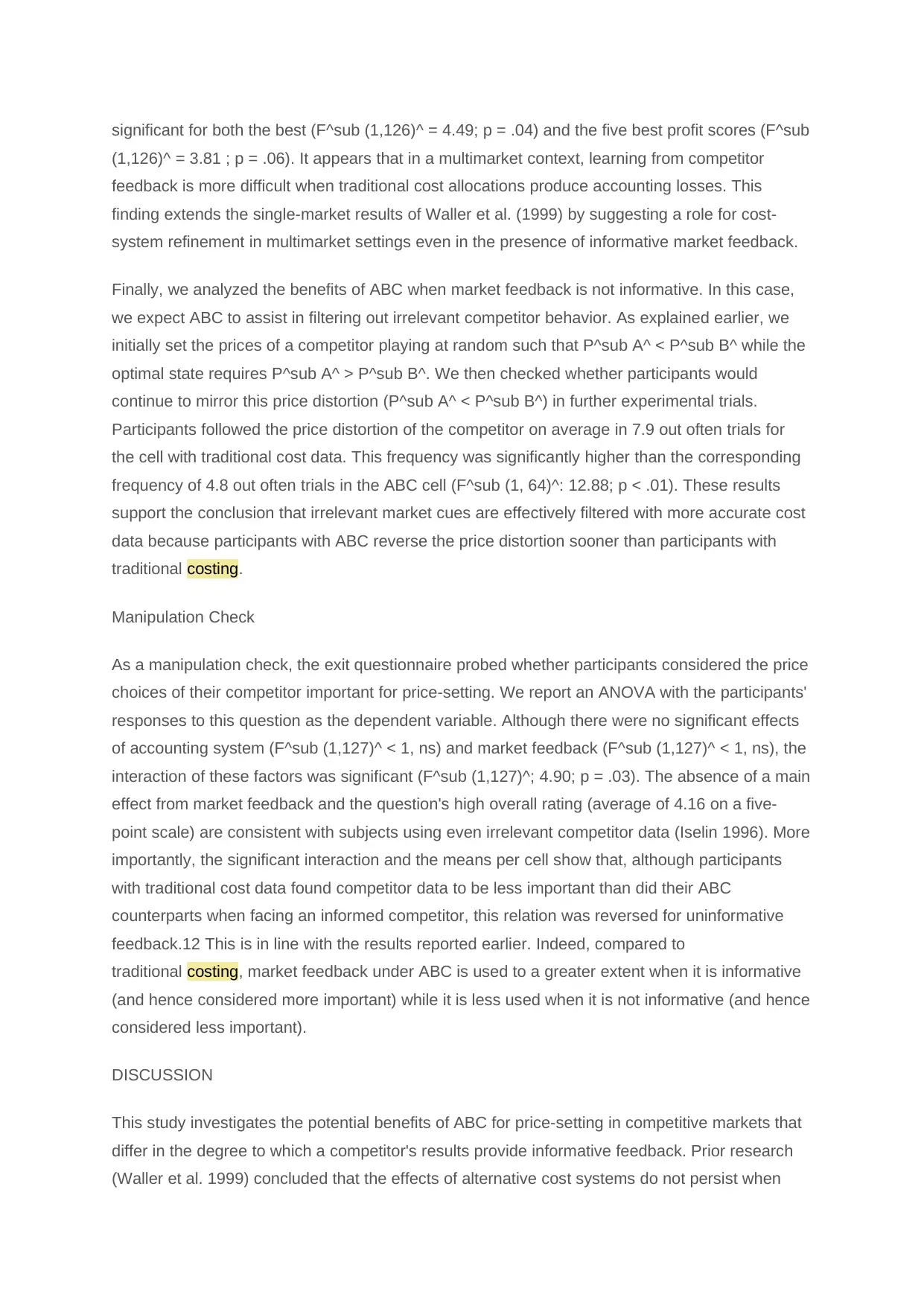
significant for both the best (F^sub (1,126)^ = 4.49; p = .04) and the five best profit scores (F^sub
(1,126)^ = 3.81 ; p = .06). It appears that in a multimarket context, learning from competitor
feedback is more difficult when traditional cost allocations produce accounting losses. This
finding extends the single-market results of Waller et al. (1999) by suggesting a role for cost-
system refinement in multimarket settings even in the presence of informative market feedback.
Finally, we analyzed the benefits of ABC when market feedback is not informative. In this case,
we expect ABC to assist in filtering out irrelevant competitor behavior. As explained earlier, we
initially set the prices of a competitor playing at random such that P^sub A^ < P^sub B^ while the
optimal state requires P^sub A^ > P^sub B^. We then checked whether participants would
continue to mirror this price distortion (P^sub A^ < P^sub B^) in further experimental trials.
Participants followed the price distortion of the competitor on average in 7.9 out often trials for
the cell with traditional cost data. This frequency was significantly higher than the corresponding
frequency of 4.8 out often trials in the ABC cell (F^sub (1, 64)^: 12.88; p < .01). These results
support the conclusion that irrelevant market cues are effectively filtered with more accurate cost
data because participants with ABC reverse the price distortion sooner than participants with
traditional costing.
Manipulation Check
As a manipulation check, the exit questionnaire probed whether participants considered the price
choices of their competitor important for price-setting. We report an ANOVA with the participants'
responses to this question as the dependent variable. Although there were no significant effects
of accounting system (F^sub (1,127)^ < 1, ns) and market feedback (F^sub (1,127)^ < 1, ns), the
interaction of these factors was significant (F^sub (1,127)^; 4.90; p = .03). The absence of a main
effect from market feedback and the question's high overall rating (average of 4.16 on a five-
point scale) are consistent with subjects using even irrelevant competitor data (Iselin 1996). More
importantly, the significant interaction and the means per cell show that, although participants
with traditional cost data found competitor data to be less important than did their ABC
counterparts when facing an informed competitor, this relation was reversed for uninformative
feedback.12 This is in line with the results reported earlier. Indeed, compared to
traditional costing, market feedback under ABC is used to a greater extent when it is informative
(and hence considered more important) while it is less used when it is not informative (and hence
considered less important).
DISCUSSION
This study investigates the potential benefits of ABC for price-setting in competitive markets that
differ in the degree to which a competitor's results provide informative feedback. Prior research
(Waller et al. 1999) concluded that the effects of alternative cost systems do not persist when
(1,126)^ = 3.81 ; p = .06). It appears that in a multimarket context, learning from competitor
feedback is more difficult when traditional cost allocations produce accounting losses. This
finding extends the single-market results of Waller et al. (1999) by suggesting a role for cost-
system refinement in multimarket settings even in the presence of informative market feedback.
Finally, we analyzed the benefits of ABC when market feedback is not informative. In this case,
we expect ABC to assist in filtering out irrelevant competitor behavior. As explained earlier, we
initially set the prices of a competitor playing at random such that P^sub A^ < P^sub B^ while the
optimal state requires P^sub A^ > P^sub B^. We then checked whether participants would
continue to mirror this price distortion (P^sub A^ < P^sub B^) in further experimental trials.
Participants followed the price distortion of the competitor on average in 7.9 out often trials for
the cell with traditional cost data. This frequency was significantly higher than the corresponding
frequency of 4.8 out often trials in the ABC cell (F^sub (1, 64)^: 12.88; p < .01). These results
support the conclusion that irrelevant market cues are effectively filtered with more accurate cost
data because participants with ABC reverse the price distortion sooner than participants with
traditional costing.
Manipulation Check
As a manipulation check, the exit questionnaire probed whether participants considered the price
choices of their competitor important for price-setting. We report an ANOVA with the participants'
responses to this question as the dependent variable. Although there were no significant effects
of accounting system (F^sub (1,127)^ < 1, ns) and market feedback (F^sub (1,127)^ < 1, ns), the
interaction of these factors was significant (F^sub (1,127)^; 4.90; p = .03). The absence of a main
effect from market feedback and the question's high overall rating (average of 4.16 on a five-
point scale) are consistent with subjects using even irrelevant competitor data (Iselin 1996). More
importantly, the significant interaction and the means per cell show that, although participants
with traditional cost data found competitor data to be less important than did their ABC
counterparts when facing an informed competitor, this relation was reversed for uninformative
feedback.12 This is in line with the results reported earlier. Indeed, compared to
traditional costing, market feedback under ABC is used to a greater extent when it is informative
(and hence considered more important) while it is less used when it is not informative (and hence
considered less important).
DISCUSSION
This study investigates the potential benefits of ABC for price-setting in competitive markets that
differ in the degree to which a competitor's results provide informative feedback. Prior research
(Waller et al. 1999) concluded that the effects of alternative cost systems do not persist when
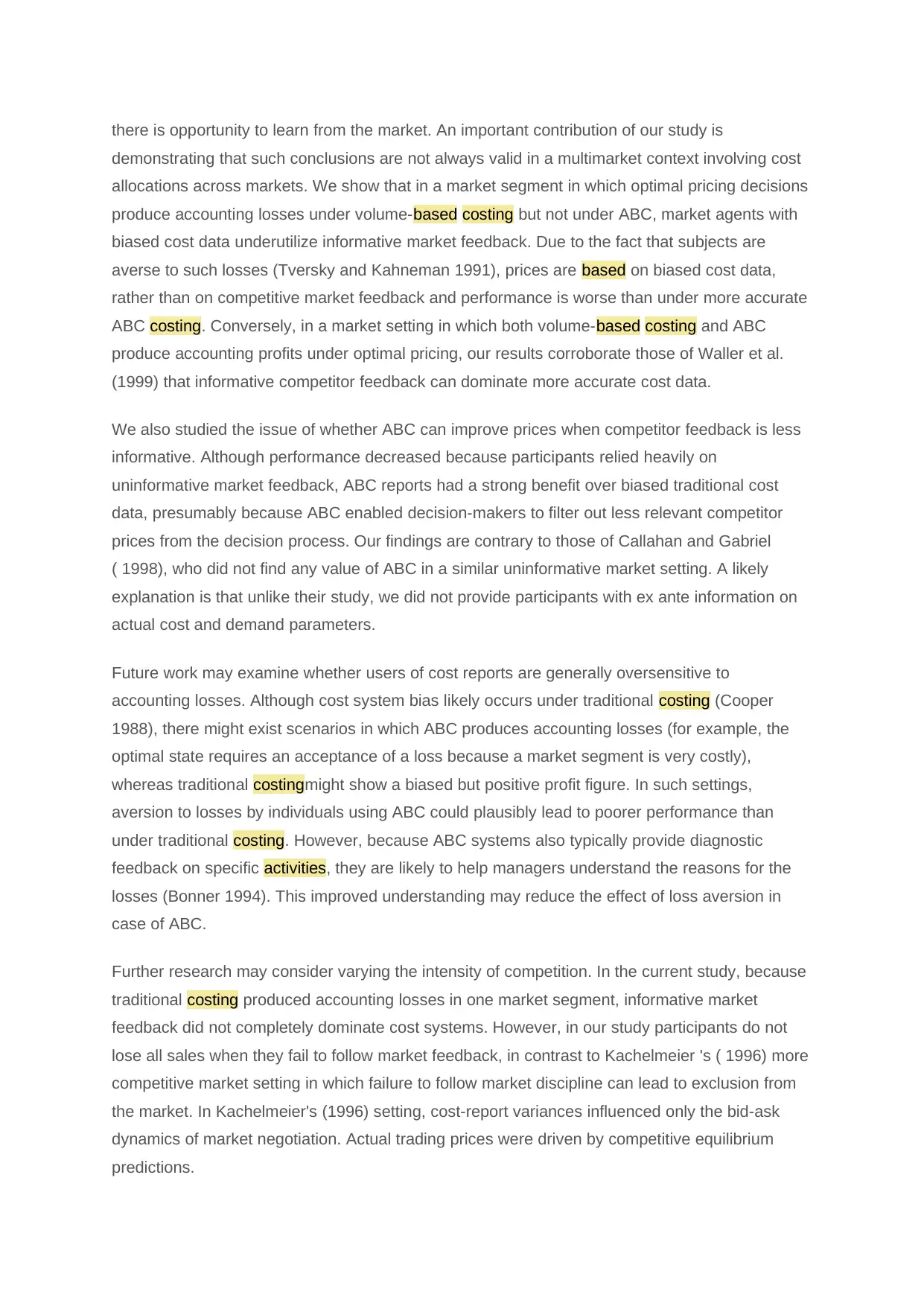
there is opportunity to learn from the market. An important contribution of our study is
demonstrating that such conclusions are not always valid in a multimarket context involving cost
allocations across markets. We show that in a market segment in which optimal pricing decisions
produce accounting losses under volume-based costing but not under ABC, market agents with
biased cost data underutilize informative market feedback. Due to the fact that subjects are
averse to such losses (Tversky and Kahneman 1991), prices are based on biased cost data,
rather than on competitive market feedback and performance is worse than under more accurate
ABC costing. Conversely, in a market setting in which both volume-based costing and ABC
produce accounting profits under optimal pricing, our results corroborate those of Waller et al.
(1999) that informative competitor feedback can dominate more accurate cost data.
We also studied the issue of whether ABC can improve prices when competitor feedback is less
informative. Although performance decreased because participants relied heavily on
uninformative market feedback, ABC reports had a strong benefit over biased traditional cost
data, presumably because ABC enabled decision-makers to filter out less relevant competitor
prices from the decision process. Our findings are contrary to those of Callahan and Gabriel
( 1998), who did not find any value of ABC in a similar uninformative market setting. A likely
explanation is that unlike their study, we did not provide participants with ex ante information on
actual cost and demand parameters.
Future work may examine whether users of cost reports are generally oversensitive to
accounting losses. Although cost system bias likely occurs under traditional costing (Cooper
1988), there might exist scenarios in which ABC produces accounting losses (for example, the
optimal state requires an acceptance of a loss because a market segment is very costly),
whereas traditional costingmight show a biased but positive profit figure. In such settings,
aversion to losses by individuals using ABC could plausibly lead to poorer performance than
under traditional costing. However, because ABC systems also typically provide diagnostic
feedback on specific activities, they are likely to help managers understand the reasons for the
losses (Bonner 1994). This improved understanding may reduce the effect of loss aversion in
case of ABC.
Further research may consider varying the intensity of competition. In the current study, because
traditional costing produced accounting losses in one market segment, informative market
feedback did not completely dominate cost systems. However, in our study participants do not
lose all sales when they fail to follow market feedback, in contrast to Kachelmeier 's ( 1996) more
competitive market setting in which failure to follow market discipline can lead to exclusion from
the market. In Kachelmeier's (1996) setting, cost-report variances influenced only the bid-ask
dynamics of market negotiation. Actual trading prices were driven by competitive equilibrium
predictions.
demonstrating that such conclusions are not always valid in a multimarket context involving cost
allocations across markets. We show that in a market segment in which optimal pricing decisions
produce accounting losses under volume-based costing but not under ABC, market agents with
biased cost data underutilize informative market feedback. Due to the fact that subjects are
averse to such losses (Tversky and Kahneman 1991), prices are based on biased cost data,
rather than on competitive market feedback and performance is worse than under more accurate
ABC costing. Conversely, in a market setting in which both volume-based costing and ABC
produce accounting profits under optimal pricing, our results corroborate those of Waller et al.
(1999) that informative competitor feedback can dominate more accurate cost data.
We also studied the issue of whether ABC can improve prices when competitor feedback is less
informative. Although performance decreased because participants relied heavily on
uninformative market feedback, ABC reports had a strong benefit over biased traditional cost
data, presumably because ABC enabled decision-makers to filter out less relevant competitor
prices from the decision process. Our findings are contrary to those of Callahan and Gabriel
( 1998), who did not find any value of ABC in a similar uninformative market setting. A likely
explanation is that unlike their study, we did not provide participants with ex ante information on
actual cost and demand parameters.
Future work may examine whether users of cost reports are generally oversensitive to
accounting losses. Although cost system bias likely occurs under traditional costing (Cooper
1988), there might exist scenarios in which ABC produces accounting losses (for example, the
optimal state requires an acceptance of a loss because a market segment is very costly),
whereas traditional costingmight show a biased but positive profit figure. In such settings,
aversion to losses by individuals using ABC could plausibly lead to poorer performance than
under traditional costing. However, because ABC systems also typically provide diagnostic
feedback on specific activities, they are likely to help managers understand the reasons for the
losses (Bonner 1994). This improved understanding may reduce the effect of loss aversion in
case of ABC.
Further research may consider varying the intensity of competition. In the current study, because
traditional costing produced accounting losses in one market segment, informative market
feedback did not completely dominate cost systems. However, in our study participants do not
lose all sales when they fail to follow market feedback, in contrast to Kachelmeier 's ( 1996) more
competitive market setting in which failure to follow market discipline can lead to exclusion from
the market. In Kachelmeier's (1996) setting, cost-report variances influenced only the bid-ask
dynamics of market negotiation. Actual trading prices were driven by competitive equilibrium
predictions.
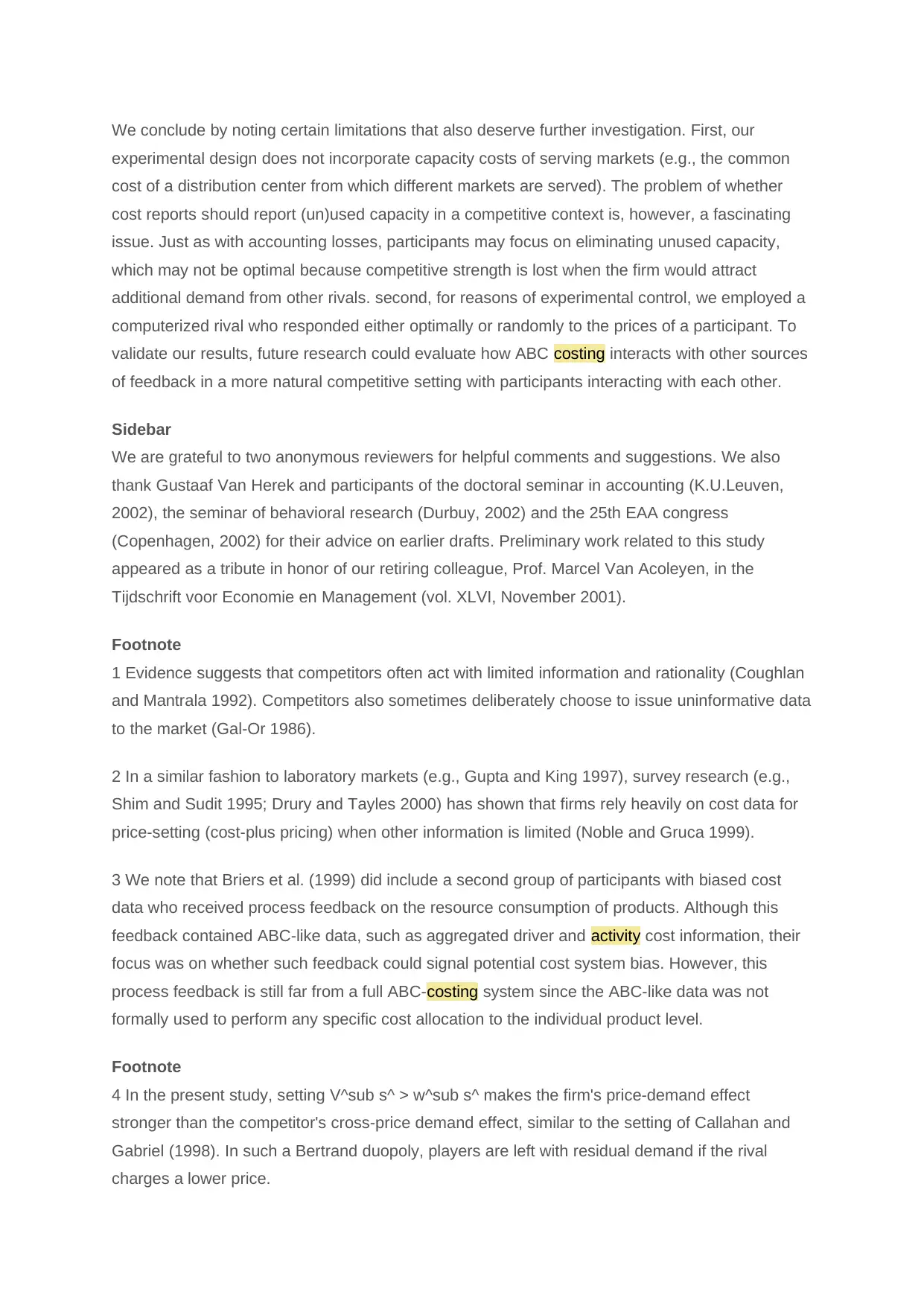
We conclude by noting certain limitations that also deserve further investigation. First, our
experimental design does not incorporate capacity costs of serving markets (e.g., the common
cost of a distribution center from which different markets are served). The problem of whether
cost reports should report (un)used capacity in a competitive context is, however, a fascinating
issue. Just as with accounting losses, participants may focus on eliminating unused capacity,
which may not be optimal because competitive strength is lost when the firm would attract
additional demand from other rivals. second, for reasons of experimental control, we employed a
computerized rival who responded either optimally or randomly to the prices of a participant. To
validate our results, future research could evaluate how ABC costing interacts with other sources
of feedback in a more natural competitive setting with participants interacting with each other.
Sidebar
We are grateful to two anonymous reviewers for helpful comments and suggestions. We also
thank Gustaaf Van Herek and participants of the doctoral seminar in accounting (K.U.Leuven,
2002), the seminar of behavioral research (Durbuy, 2002) and the 25th EAA congress
(Copenhagen, 2002) for their advice on earlier drafts. Preliminary work related to this study
appeared as a tribute in honor of our retiring colleague, Prof. Marcel Van Acoleyen, in the
Tijdschrift voor Economie en Management (vol. XLVI, November 2001).
Footnote
1 Evidence suggests that competitors often act with limited information and rationality (Coughlan
and Mantrala 1992). Competitors also sometimes deliberately choose to issue uninformative data
to the market (Gal-Or 1986).
2 In a similar fashion to laboratory markets (e.g., Gupta and King 1997), survey research (e.g.,
Shim and Sudit 1995; Drury and Tayles 2000) has shown that firms rely heavily on cost data for
price-setting (cost-plus pricing) when other information is limited (Noble and Gruca 1999).
3 We note that Briers et al. (1999) did include a second group of participants with biased cost
data who received process feedback on the resource consumption of products. Although this
feedback contained ABC-like data, such as aggregated driver and activity cost information, their
focus was on whether such feedback could signal potential cost system bias. However, this
process feedback is still far from a full ABC-costing system since the ABC-like data was not
formally used to perform any specific cost allocation to the individual product level.
Footnote
4 In the present study, setting V^sub s^ > w^sub s^ makes the firm's price-demand effect
stronger than the competitor's cross-price demand effect, similar to the setting of Callahan and
Gabriel (1998). In such a Bertrand duopoly, players are left with residual demand if the rival
charges a lower price.
experimental design does not incorporate capacity costs of serving markets (e.g., the common
cost of a distribution center from which different markets are served). The problem of whether
cost reports should report (un)used capacity in a competitive context is, however, a fascinating
issue. Just as with accounting losses, participants may focus on eliminating unused capacity,
which may not be optimal because competitive strength is lost when the firm would attract
additional demand from other rivals. second, for reasons of experimental control, we employed a
computerized rival who responded either optimally or randomly to the prices of a participant. To
validate our results, future research could evaluate how ABC costing interacts with other sources
of feedback in a more natural competitive setting with participants interacting with each other.
Sidebar
We are grateful to two anonymous reviewers for helpful comments and suggestions. We also
thank Gustaaf Van Herek and participants of the doctoral seminar in accounting (K.U.Leuven,
2002), the seminar of behavioral research (Durbuy, 2002) and the 25th EAA congress
(Copenhagen, 2002) for their advice on earlier drafts. Preliminary work related to this study
appeared as a tribute in honor of our retiring colleague, Prof. Marcel Van Acoleyen, in the
Tijdschrift voor Economie en Management (vol. XLVI, November 2001).
Footnote
1 Evidence suggests that competitors often act with limited information and rationality (Coughlan
and Mantrala 1992). Competitors also sometimes deliberately choose to issue uninformative data
to the market (Gal-Or 1986).
2 In a similar fashion to laboratory markets (e.g., Gupta and King 1997), survey research (e.g.,
Shim and Sudit 1995; Drury and Tayles 2000) has shown that firms rely heavily on cost data for
price-setting (cost-plus pricing) when other information is limited (Noble and Gruca 1999).
3 We note that Briers et al. (1999) did include a second group of participants with biased cost
data who received process feedback on the resource consumption of products. Although this
feedback contained ABC-like data, such as aggregated driver and activity cost information, their
focus was on whether such feedback could signal potential cost system bias. However, this
process feedback is still far from a full ABC-costing system since the ABC-like data was not
formally used to perform any specific cost allocation to the individual product level.
Footnote
4 In the present study, setting V^sub s^ > w^sub s^ makes the firm's price-demand effect
stronger than the competitor's cross-price demand effect, similar to the setting of Callahan and
Gabriel (1998). In such a Bertrand duopoly, players are left with residual demand if the rival
charges a lower price.
Paraphrase This Document
Need a fresh take? Get an instant paraphrase of this document with our AI Paraphraser
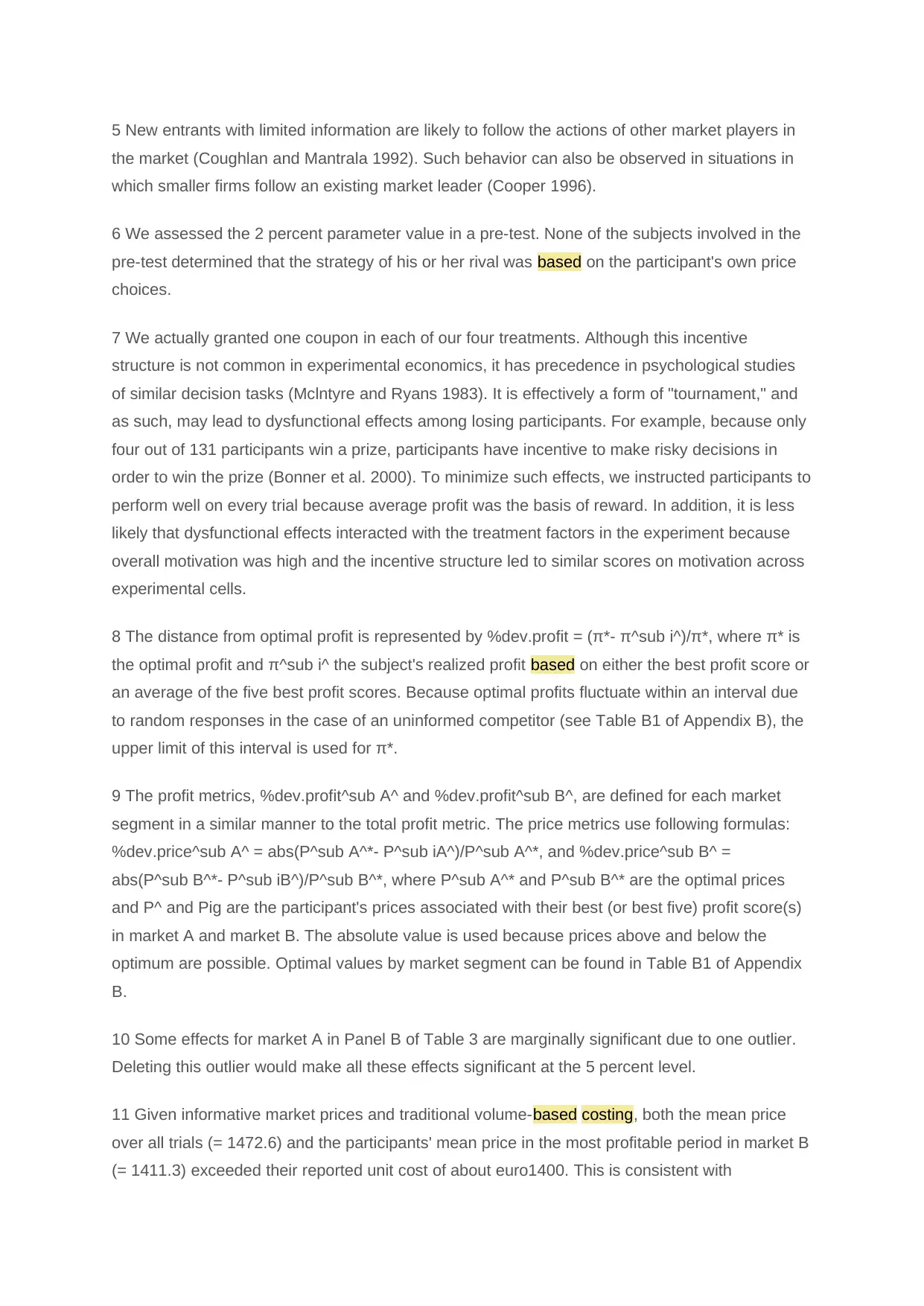
5 New entrants with limited information are likely to follow the actions of other market players in
the market (Coughlan and Mantrala 1992). Such behavior can also be observed in situations in
which smaller firms follow an existing market leader (Cooper 1996).
6 We assessed the 2 percent parameter value in a pre-test. None of the subjects involved in the
pre-test determined that the strategy of his or her rival was based on the participant's own price
choices.
7 We actually granted one coupon in each of our four treatments. Although this incentive
structure is not common in experimental economics, it has precedence in psychological studies
of similar decision tasks (Mclntyre and Ryans 1983). It is effectively a form of "tournament," and
as such, may lead to dysfunctional effects among losing participants. For example, because only
four out of 131 participants win a prize, participants have incentive to make risky decisions in
order to win the prize (Bonner et al. 2000). To minimize such effects, we instructed participants to
perform well on every trial because average profit was the basis of reward. In addition, it is less
likely that dysfunctional effects interacted with the treatment factors in the experiment because
overall motivation was high and the incentive structure led to similar scores on motivation across
experimental cells.
8 The distance from optimal profit is represented by %dev.profit = (π*- π^sub i^)/π*, where π* is
the optimal profit and π^sub i^ the subject's realized profit based on either the best profit score or
an average of the five best profit scores. Because optimal profits fluctuate within an interval due
to random responses in the case of an uninformed competitor (see Table B1 of Appendix B), the
upper limit of this interval is used for π*.
9 The profit metrics, %dev.profit^sub A^ and %dev.profit^sub B^, are defined for each market
segment in a similar manner to the total profit metric. The price metrics use following formulas:
%dev.price^sub A^ = abs(P^sub A^*- P^sub iA^)/P^sub A^*, and %dev.price^sub B^ =
abs(P^sub B^*- P^sub iB^)/P^sub B^*, where P^sub A^* and P^sub B^* are the optimal prices
and P^ and Pig are the participant's prices associated with their best (or best five) profit score(s)
in market A and market B. The absolute value is used because prices above and below the
optimum are possible. Optimal values by market segment can be found in Table B1 of Appendix
B.
10 Some effects for market A in Panel B of Table 3 are marginally significant due to one outlier.
Deleting this outlier would make all these effects significant at the 5 percent level.
11 Given informative market prices and traditional volume-based costing, both the mean price
over all trials (= 1472.6) and the participants' mean price in the most profitable period in market B
(= 1411.3) exceeded their reported unit cost of about euro1400. This is consistent with
the market (Coughlan and Mantrala 1992). Such behavior can also be observed in situations in
which smaller firms follow an existing market leader (Cooper 1996).
6 We assessed the 2 percent parameter value in a pre-test. None of the subjects involved in the
pre-test determined that the strategy of his or her rival was based on the participant's own price
choices.
7 We actually granted one coupon in each of our four treatments. Although this incentive
structure is not common in experimental economics, it has precedence in psychological studies
of similar decision tasks (Mclntyre and Ryans 1983). It is effectively a form of "tournament," and
as such, may lead to dysfunctional effects among losing participants. For example, because only
four out of 131 participants win a prize, participants have incentive to make risky decisions in
order to win the prize (Bonner et al. 2000). To minimize such effects, we instructed participants to
perform well on every trial because average profit was the basis of reward. In addition, it is less
likely that dysfunctional effects interacted with the treatment factors in the experiment because
overall motivation was high and the incentive structure led to similar scores on motivation across
experimental cells.
8 The distance from optimal profit is represented by %dev.profit = (π*- π^sub i^)/π*, where π* is
the optimal profit and π^sub i^ the subject's realized profit based on either the best profit score or
an average of the five best profit scores. Because optimal profits fluctuate within an interval due
to random responses in the case of an uninformed competitor (see Table B1 of Appendix B), the
upper limit of this interval is used for π*.
9 The profit metrics, %dev.profit^sub A^ and %dev.profit^sub B^, are defined for each market
segment in a similar manner to the total profit metric. The price metrics use following formulas:
%dev.price^sub A^ = abs(P^sub A^*- P^sub iA^)/P^sub A^*, and %dev.price^sub B^ =
abs(P^sub B^*- P^sub iB^)/P^sub B^*, where P^sub A^* and P^sub B^* are the optimal prices
and P^ and Pig are the participant's prices associated with their best (or best five) profit score(s)
in market A and market B. The absolute value is used because prices above and below the
optimum are possible. Optimal values by market segment can be found in Table B1 of Appendix
B.
10 Some effects for market A in Panel B of Table 3 are marginally significant due to one outlier.
Deleting this outlier would make all these effects significant at the 5 percent level.
11 Given informative market prices and traditional volume-based costing, both the mean price
over all trials (= 1472.6) and the participants' mean price in the most profitable period in market B
(= 1411.3) exceeded their reported unit cost of about euro1400. This is consistent with
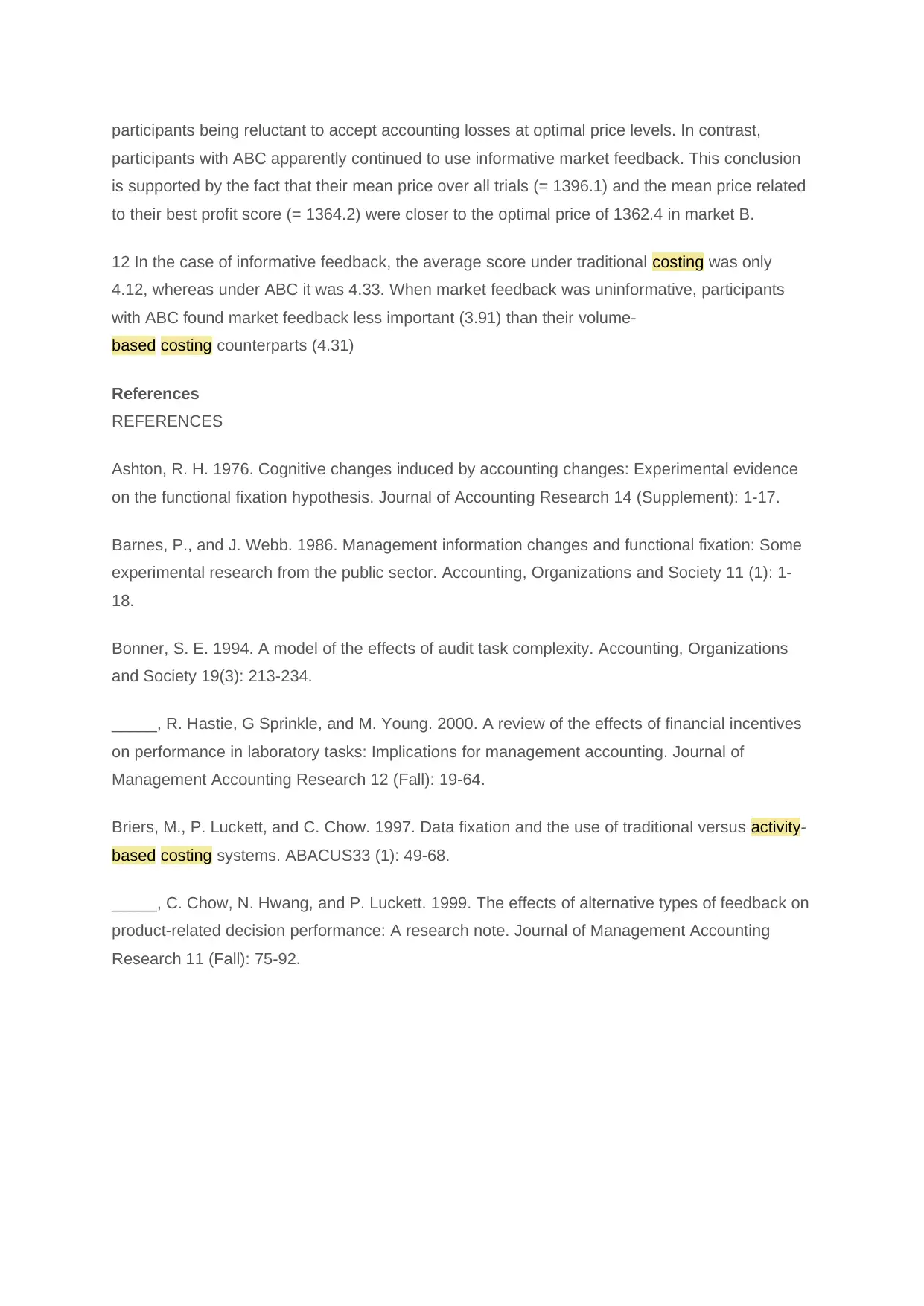
participants being reluctant to accept accounting losses at optimal price levels. In contrast,
participants with ABC apparently continued to use informative market feedback. This conclusion
is supported by the fact that their mean price over all trials (= 1396.1) and the mean price related
to their best profit score (= 1364.2) were closer to the optimal price of 1362.4 in market B.
12 In the case of informative feedback, the average score under traditional costing was only
4.12, whereas under ABC it was 4.33. When market feedback was uninformative, participants
with ABC found market feedback less important (3.91) than their volume-
based costing counterparts (4.31)
References
REFERENCES
Ashton, R. H. 1976. Cognitive changes induced by accounting changes: Experimental evidence
on the functional fixation hypothesis. Journal of Accounting Research 14 (Supplement): 1-17.
Barnes, P., and J. Webb. 1986. Management information changes and functional fixation: Some
experimental research from the public sector. Accounting, Organizations and Society 11 (1): 1-
18.
Bonner, S. E. 1994. A model of the effects of audit task complexity. Accounting, Organizations
and Society 19(3): 213-234.
_____, R. Hastie, G Sprinkle, and M. Young. 2000. A review of the effects of financial incentives
on performance in laboratory tasks: Implications for management accounting. Journal of
Management Accounting Research 12 (Fall): 19-64.
Briers, M., P. Luckett, and C. Chow. 1997. Data fixation and the use of traditional versus activity-
based costing systems. ABACUS33 (1): 49-68.
_____, C. Chow, N. Hwang, and P. Luckett. 1999. The effects of alternative types of feedback on
product-related decision performance: A research note. Journal of Management Accounting
Research 11 (Fall): 75-92.
participants with ABC apparently continued to use informative market feedback. This conclusion
is supported by the fact that their mean price over all trials (= 1396.1) and the mean price related
to their best profit score (= 1364.2) were closer to the optimal price of 1362.4 in market B.
12 In the case of informative feedback, the average score under traditional costing was only
4.12, whereas under ABC it was 4.33. When market feedback was uninformative, participants
with ABC found market feedback less important (3.91) than their volume-
based costing counterparts (4.31)
References
REFERENCES
Ashton, R. H. 1976. Cognitive changes induced by accounting changes: Experimental evidence
on the functional fixation hypothesis. Journal of Accounting Research 14 (Supplement): 1-17.
Barnes, P., and J. Webb. 1986. Management information changes and functional fixation: Some
experimental research from the public sector. Accounting, Organizations and Society 11 (1): 1-
18.
Bonner, S. E. 1994. A model of the effects of audit task complexity. Accounting, Organizations
and Society 19(3): 213-234.
_____, R. Hastie, G Sprinkle, and M. Young. 2000. A review of the effects of financial incentives
on performance in laboratory tasks: Implications for management accounting. Journal of
Management Accounting Research 12 (Fall): 19-64.
Briers, M., P. Luckett, and C. Chow. 1997. Data fixation and the use of traditional versus activity-
based costing systems. ABACUS33 (1): 49-68.
_____, C. Chow, N. Hwang, and P. Luckett. 1999. The effects of alternative types of feedback on
product-related decision performance: A research note. Journal of Management Accounting
Research 11 (Fall): 75-92.
1 out of 75
Related Documents
Your All-in-One AI-Powered Toolkit for Academic Success.
+13062052269
info@desklib.com
Available 24*7 on WhatsApp / Email
![[object Object]](/_next/static/media/star-bottom.7253800d.svg)
Unlock your academic potential
© 2024 | Zucol Services PVT LTD | All rights reserved.



